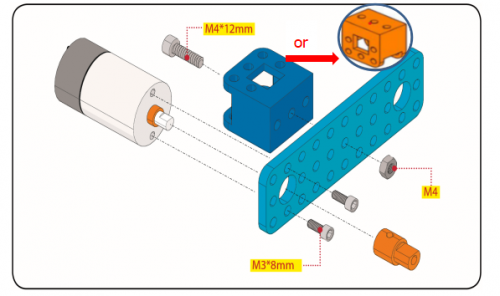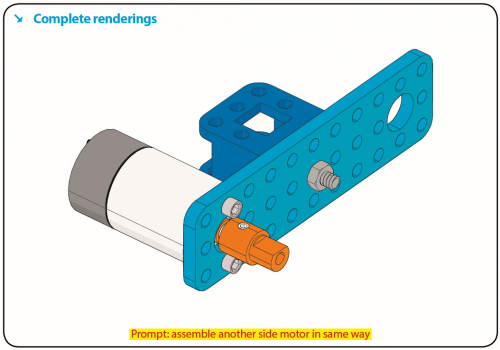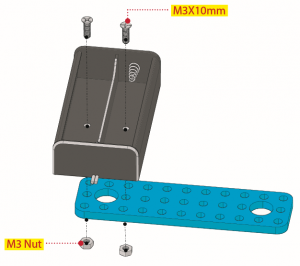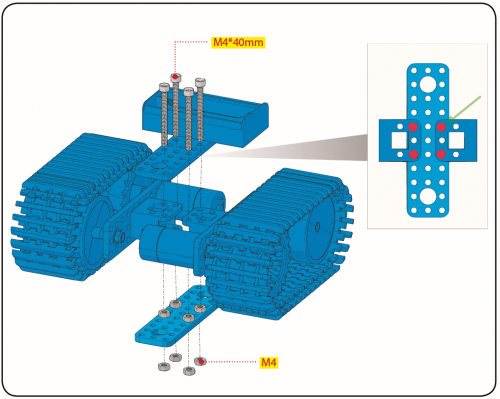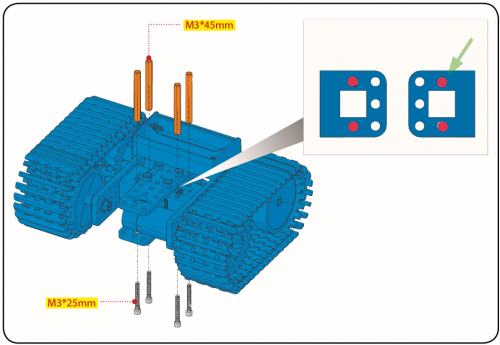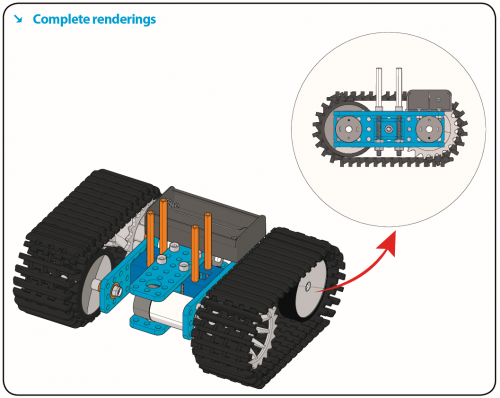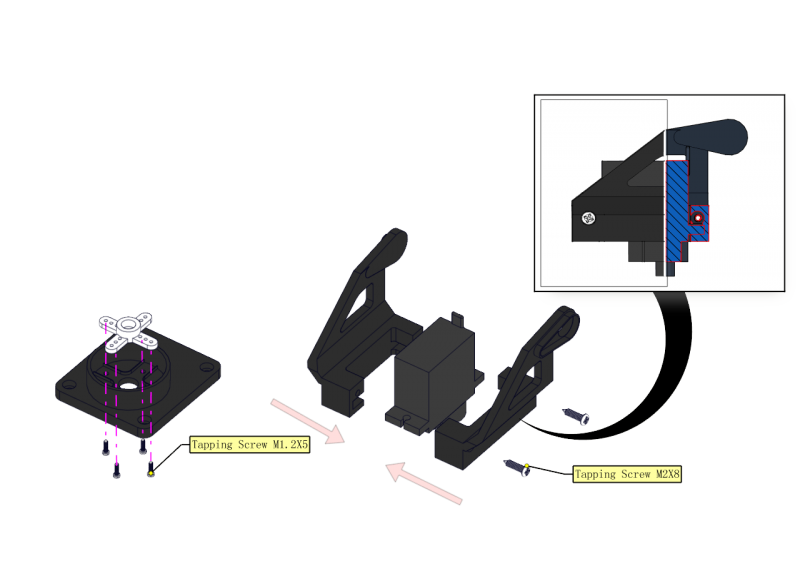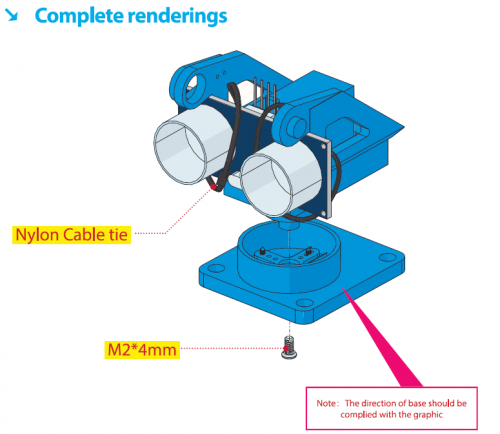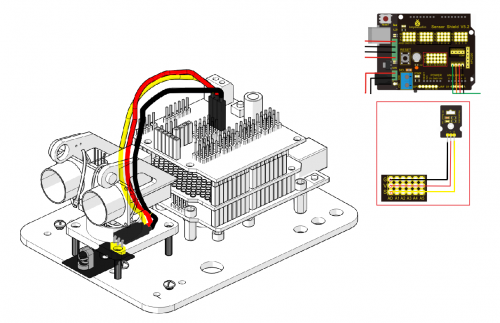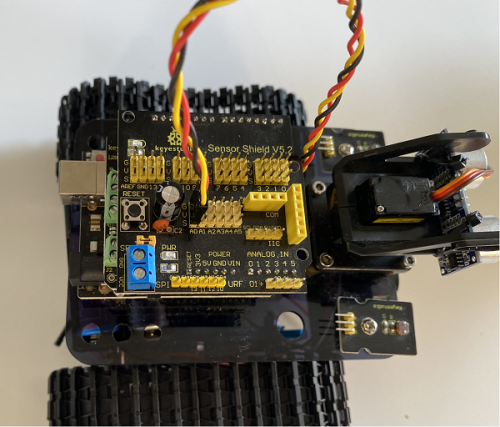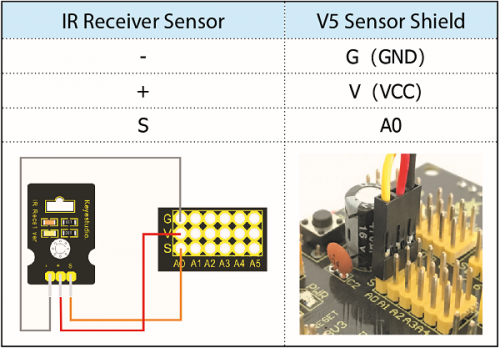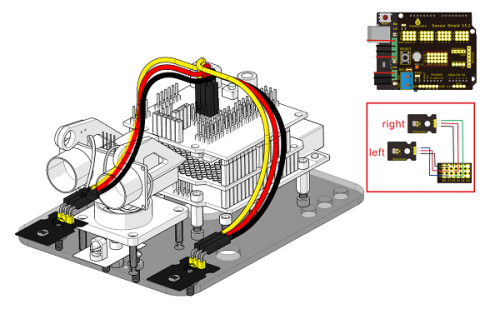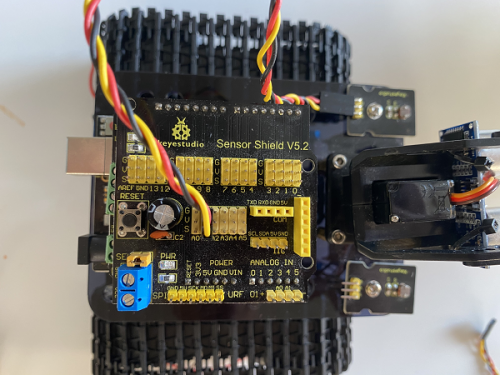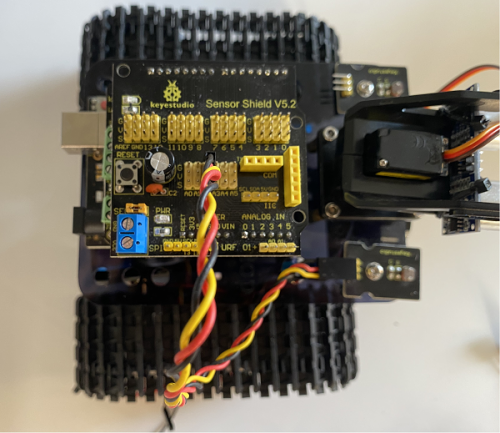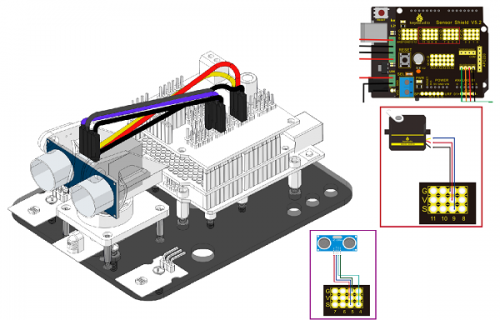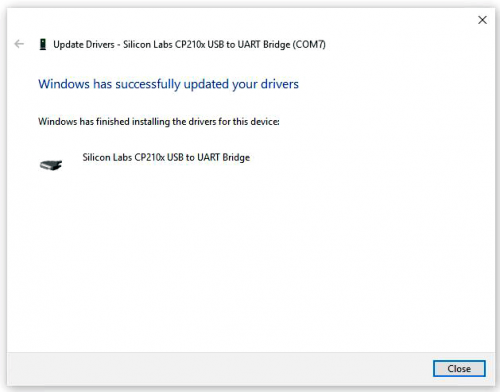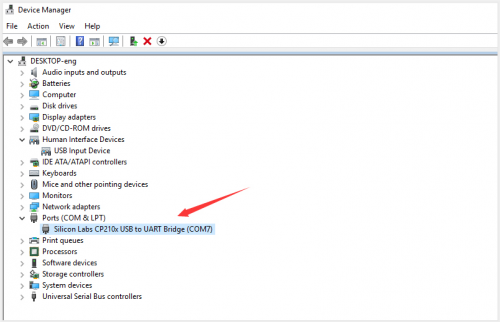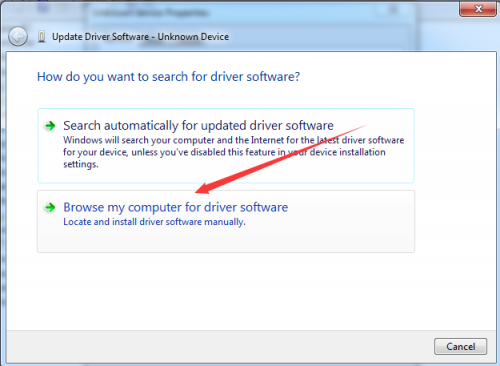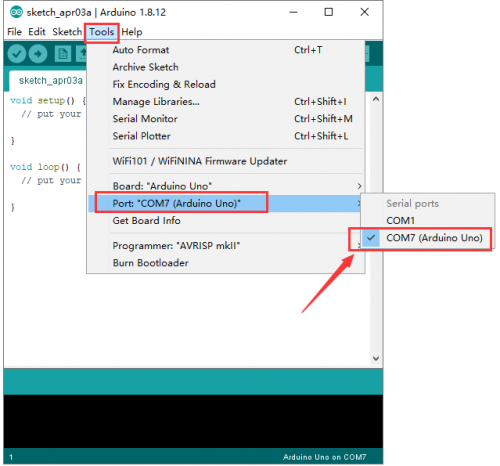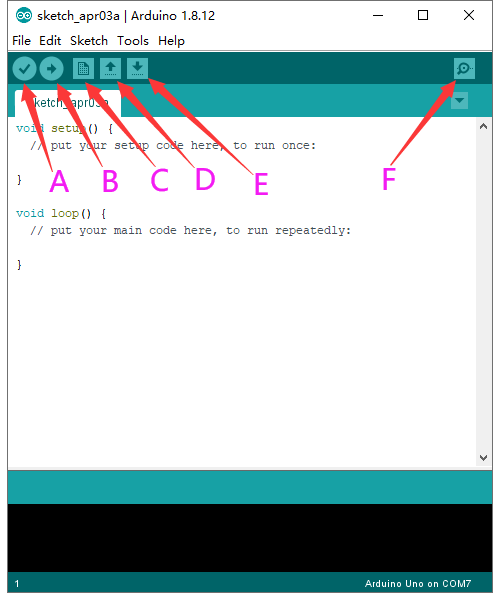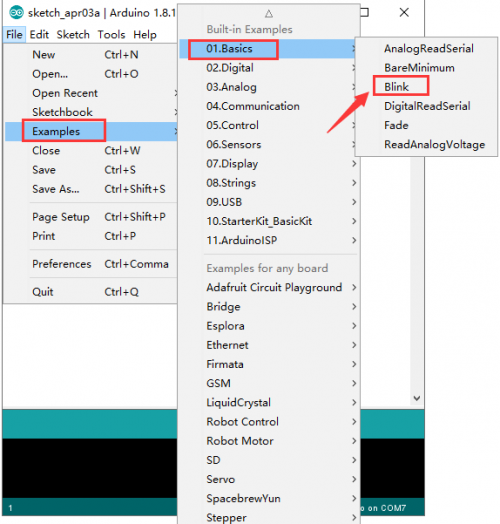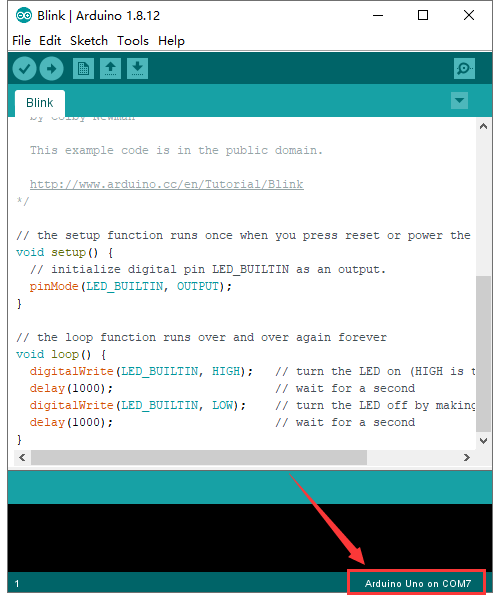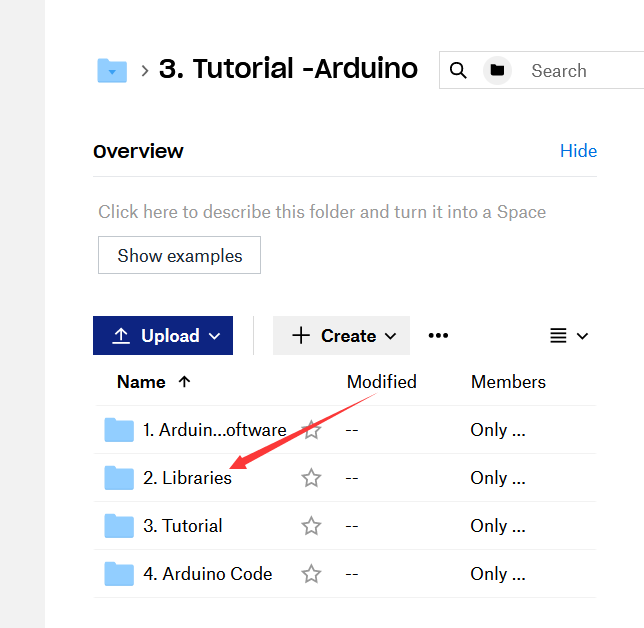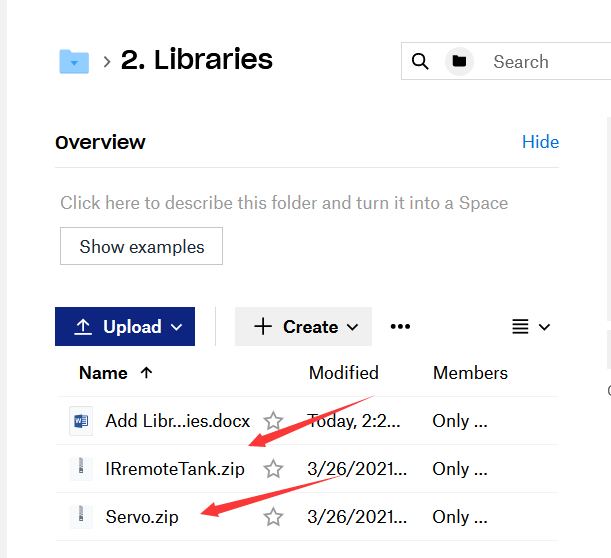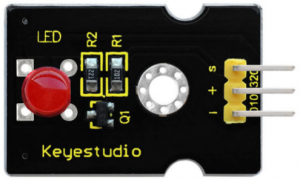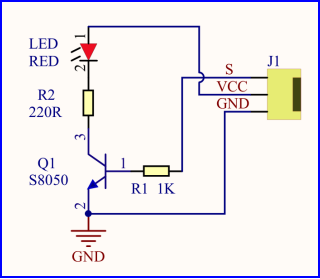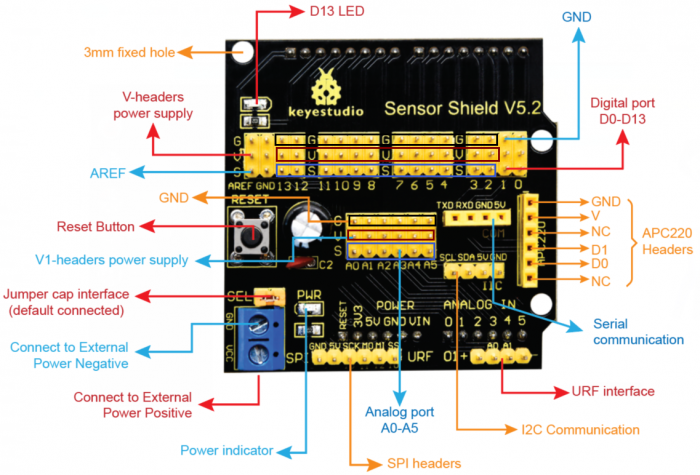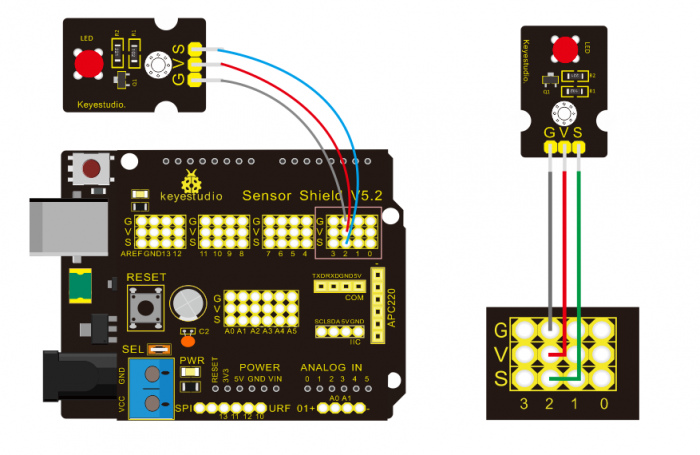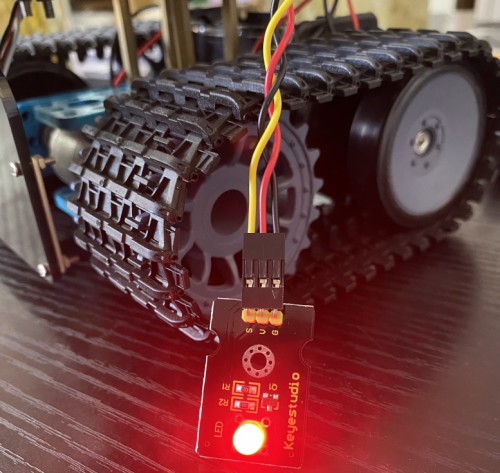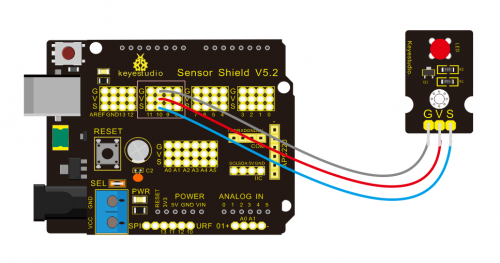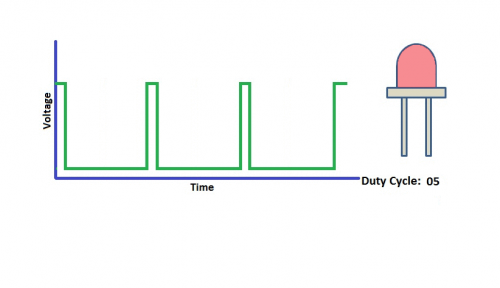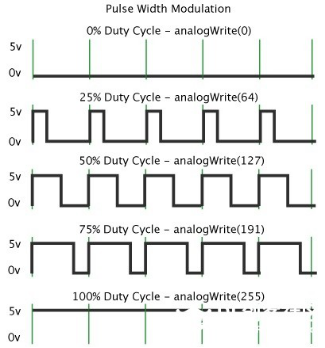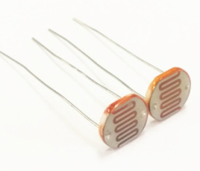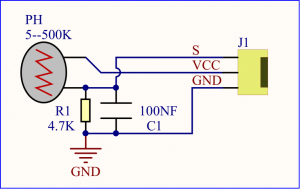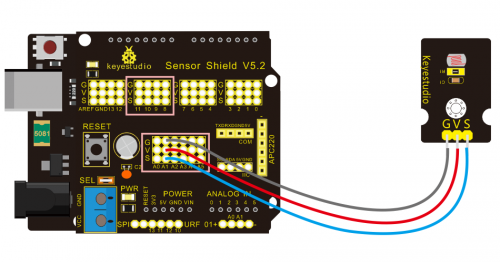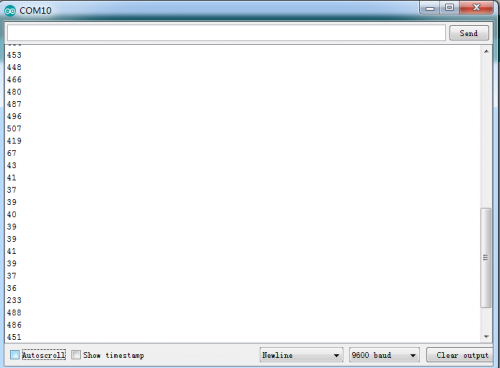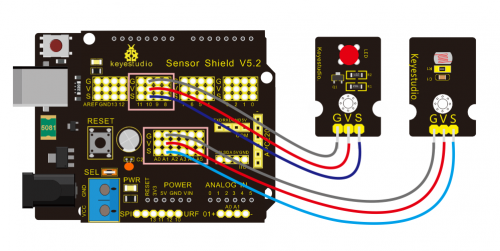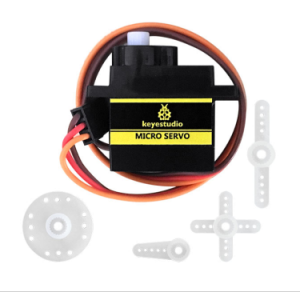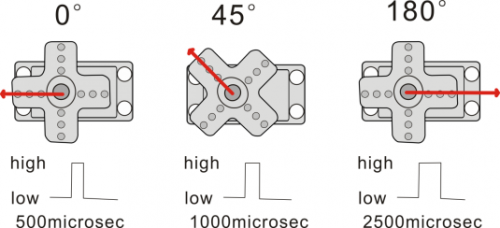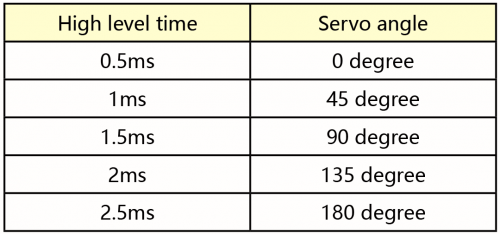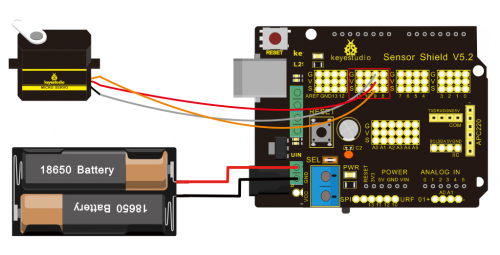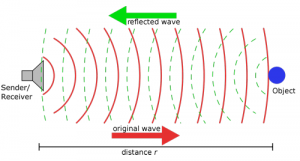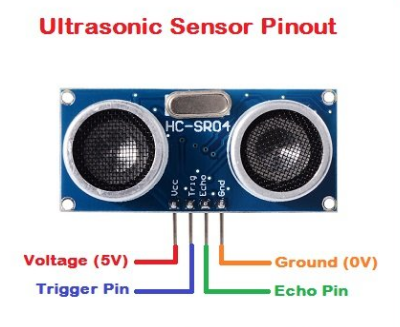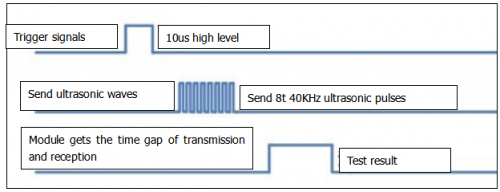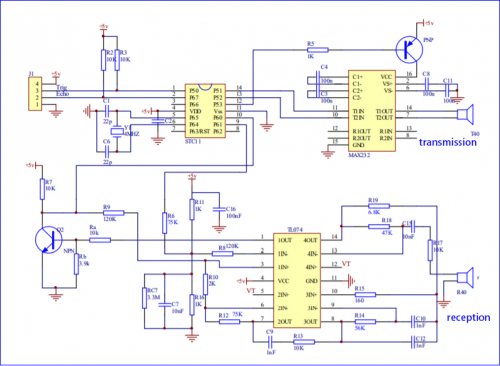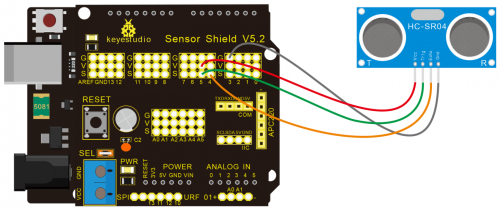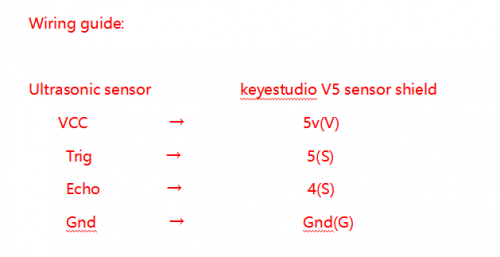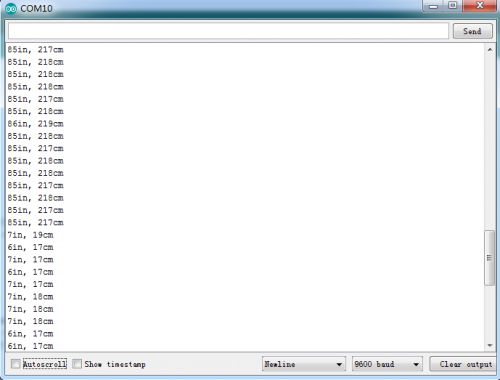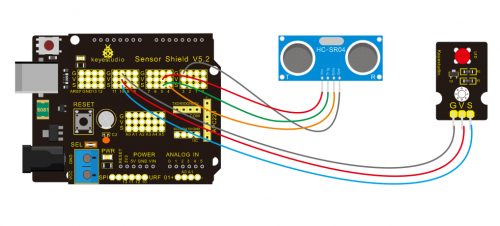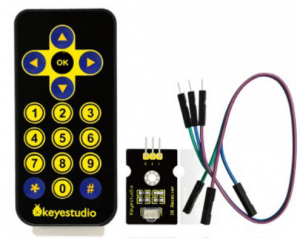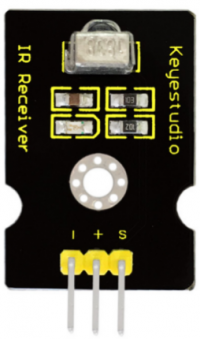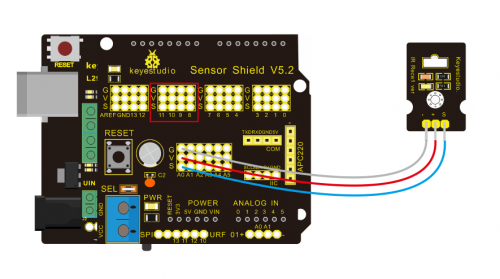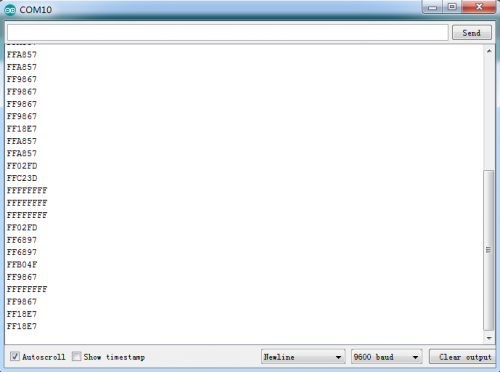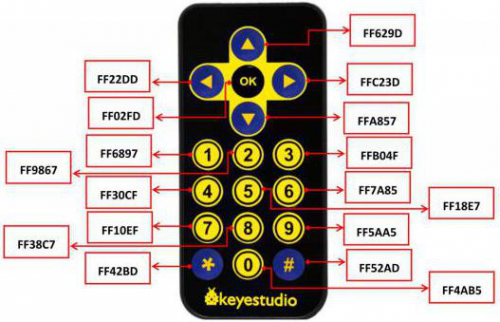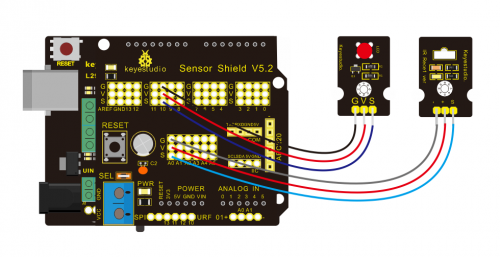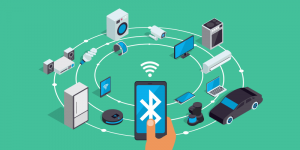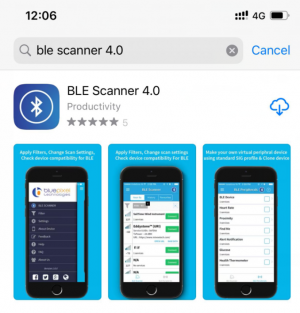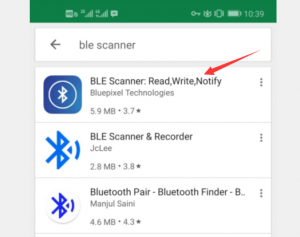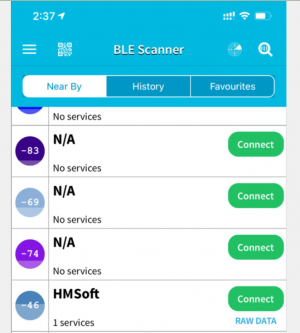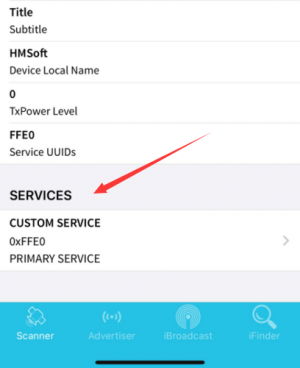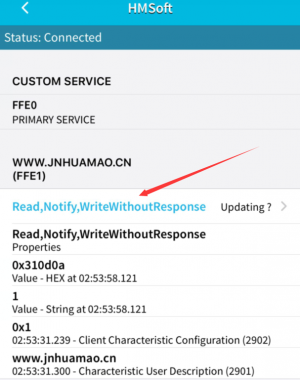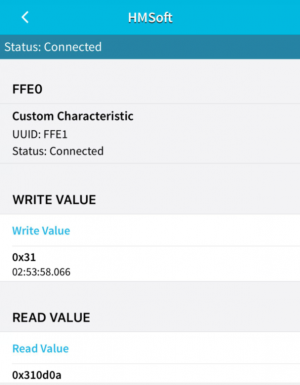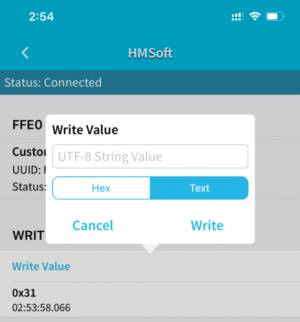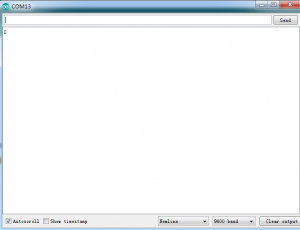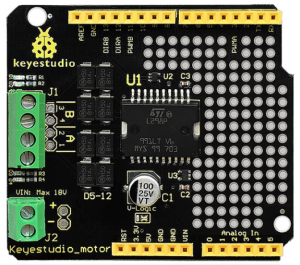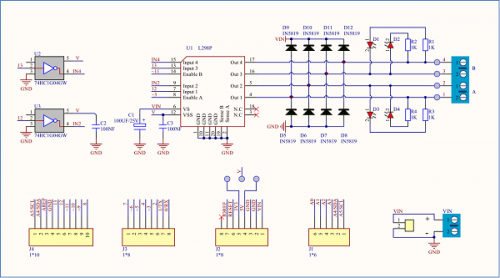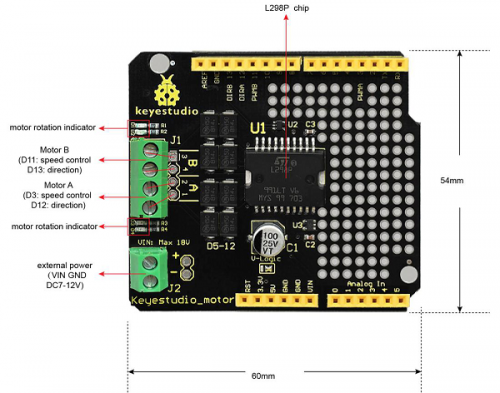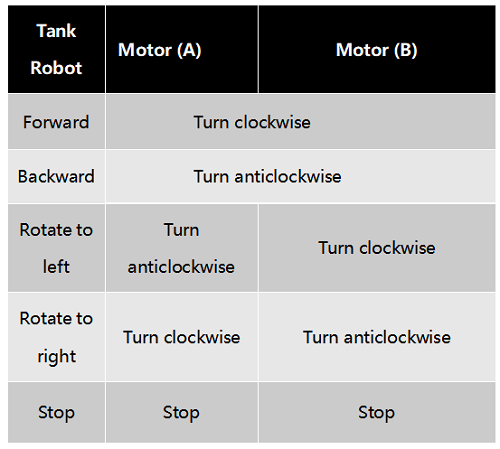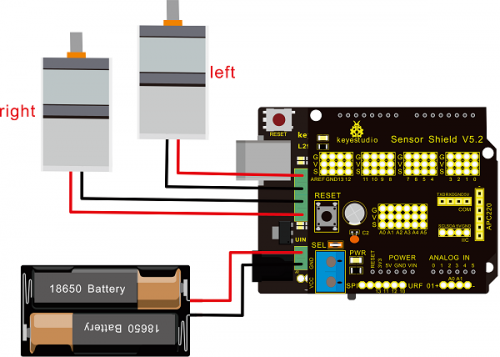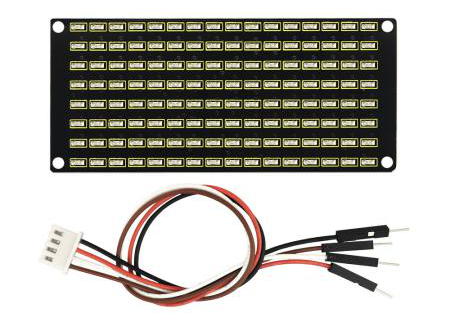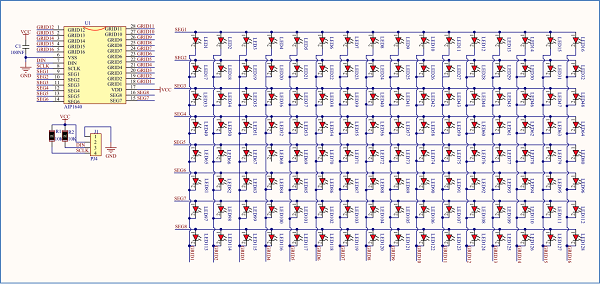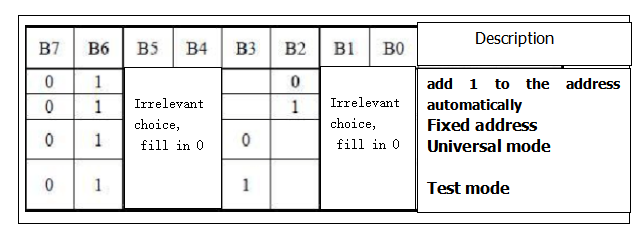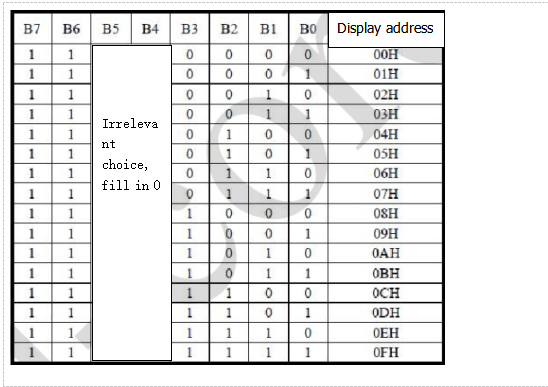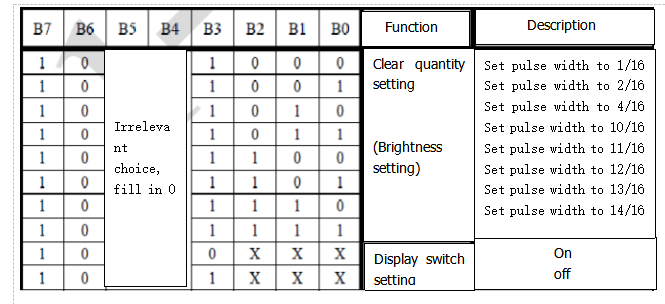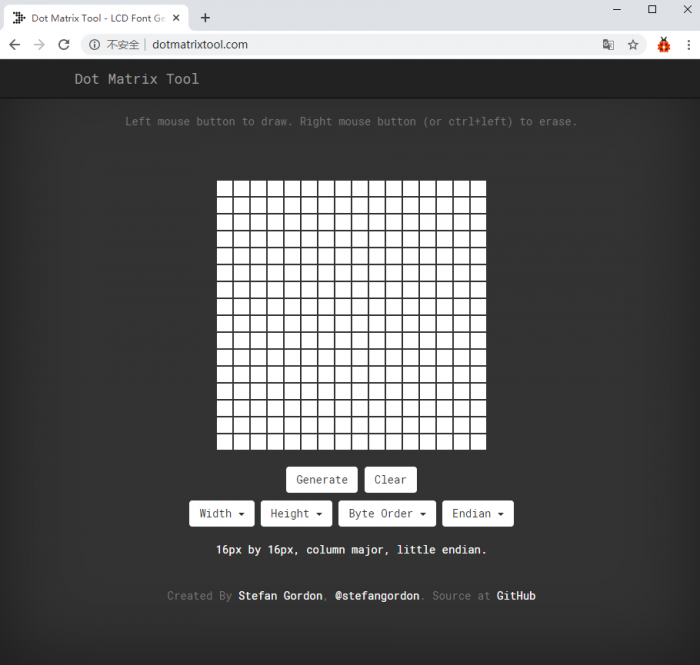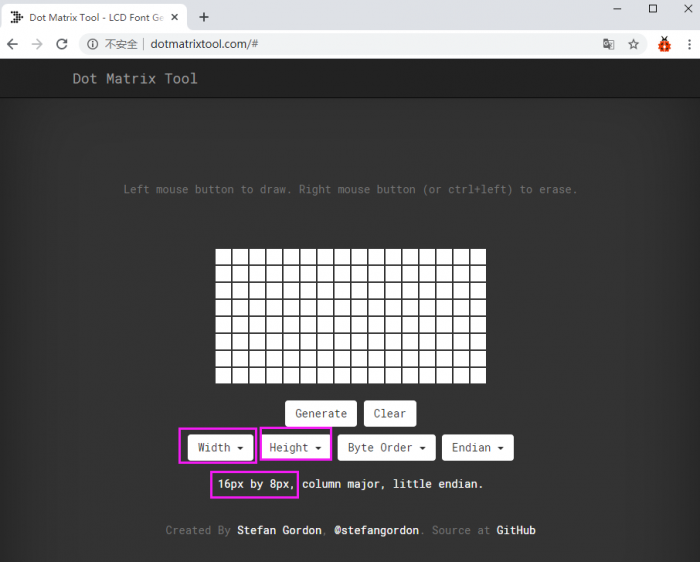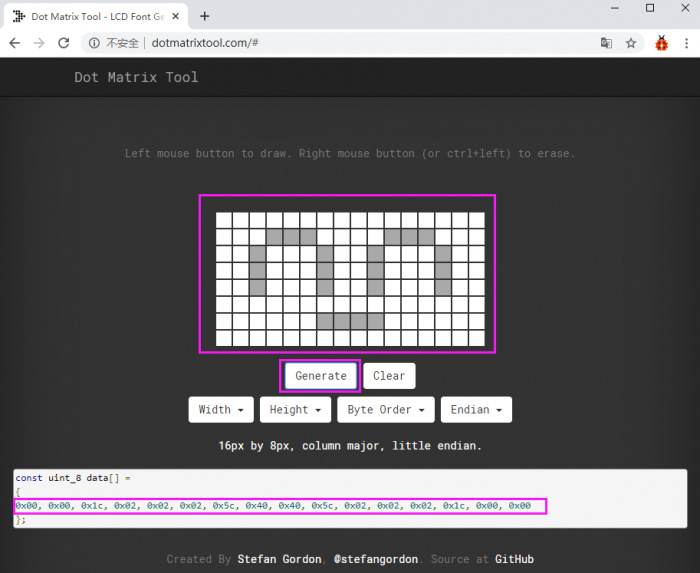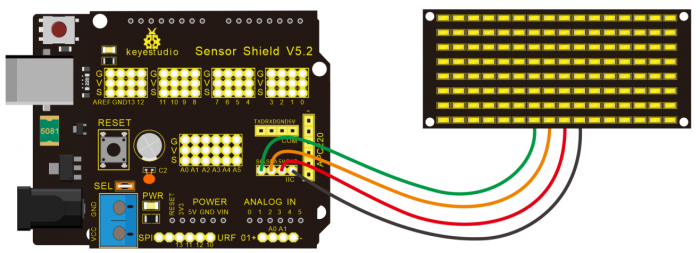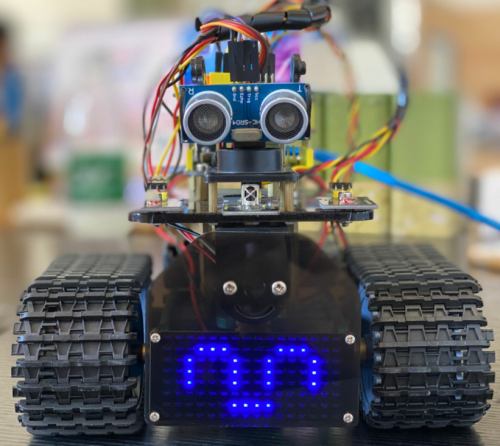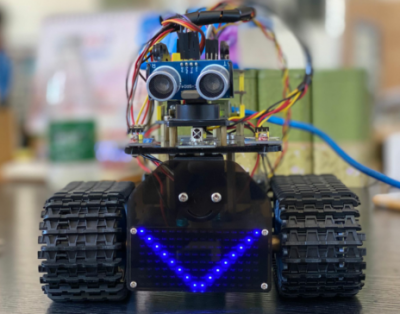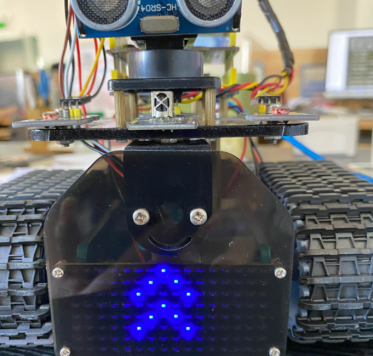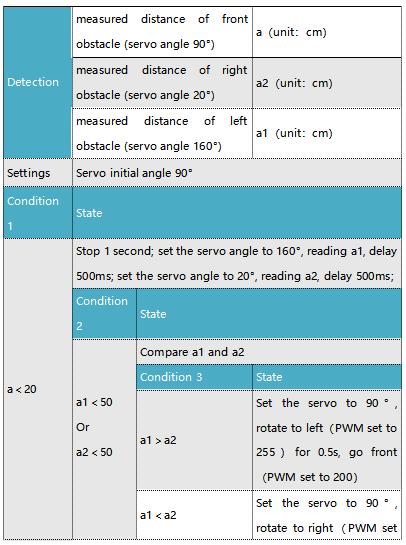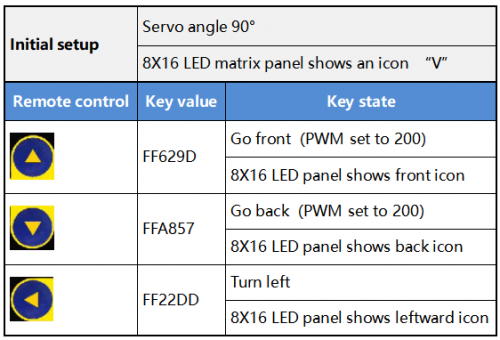Thanks for your support on our products, we will continue to provide you better quality and service!
*About keyestudio
Keyestudio is a best-selling brand owned by KEYES Corporation, our product lines range from controller boards, shields and sensor modules to smart car and complete starter kits for Arduino, Raspberry Pi and BBC micro:bit, which designed for customers of any level to learn electronics and programming knowledge. All of our products comply with international quality standards and are greatly appreciated in a variety of different markets throughout the world.
You can obtain the details and the latest information through visiting the following web sites:http://www.keyestudio.com
*References and After-sales Service
1.Download Profile:https://fs.keyestudio.com/KS0428
2.Feel free to contact us please, if there is missing part or you encounter some troubles. Welcome to send email to us:service@keyestudio.com.
We will update projects and products continuously based on your sincere advice.
*Warning
1.This product contains tiny parts(screws, copper pillars), keep it out of reach of children under 7 years old please.
2. This product contains conductive parts (control board and electronic module). Please operate according to the requirements of this tutorial. Improper operation may cause overheating and damage parts. Do not touch and immediately disconnect the circuit power.
*Copyright
The keyestudio trademark and logo are the copyright of KEYES DIY ROBOT co.,LTD. All products under keyestudio brand can’t be copied, sold and resold without authorization by anyone or company. If you’re interested in our items, please contact to our sales representatives: fennie@keyestudio.com
Introduction
Nowadays, technological education such as VR, kids programming, and artificial intelligence, has become mainstream in educational industry. Thereby, people attach importance to STEAM education. Arduino is pretty notable in Maker education.
So what is Arduino? Arduino is an open-source electronics platform based on easy-to-use hardware and software. Arduino boards are able to read inputs — light on a sensor, a finger on a button, or a Twitter message — and turn it into an output — activating a motor, turning on an LED, publishing something online. Based on this, Keyestudio team has designed a mini tank robot. The tank robot has a processor which is programmable using the Arduino IDE, to mapped its pins to sensors and actuators by a shield that plug in the processor, it reads sensors and controls the actuators and decides how to operate.
15 learning projects, from simple to complex, will guide you how to make a smart tank robot on you own and introduce the detailed knowledge about sensors and modules.
Simultaneously, it is the best choice if you intend to obtain a DIY robot for learning programming, entertainment and competition requirement.
Features
1.Multi-purpose: Obstacle avoidance, follow, IR remote control, Bluetooth control, light following, ultrasonic follow and displayed face emoticons.
2.Simple assembly: No soldering circuit required, complete assembly easily.
3. High Tenacity:Aluminum alloy bracket, metal motors, high quality wheels and tracks.
4. High extension: expand other sensors and modules through motor driver shield and sensor shield
5. Multiple controls: IR remote control, App control(IOS and Android system)
6.Basic programming:C language code of Arduino IDE.
Specification
- Working voltage: 5v
- Input voltage: 7-12V
- Maximum output current: 2A
- Maximum power dissipation: 25W (T=75℃)
- Motor speed: 5V 200 rpm/min
- Motor drive mode: dual H bridge drive (L298P)
- Ultrasonic induction angle: <15 degrees
- Ultrasonic detection distance: 2cm-400cm
- Infrared remote control distance: 10 meters (measured)
- Bluetooth remote control distance: 50 meters (measured)
Product List
Make sure no any parts missing please when you get this robot kit. And if it is, please feel free to contact us.
Please tear off the protective film on the acrylic board before mounting the kit
Assembly Guide
Note: Remove the Bluetooth module before uploading test code, otherwise, you will fail to upload test code
Note: Peel the plastic film off the board first when installing the smart car. To be honest, we never intend to send wood to you.
After making an inventory all the parts in this kit, then we need to mount the tank robot. Let’s install smart car in compliance with the following instructions.
Step 1: Install Bottom Motor
Prepare the parts as follows:
- M4 Nut * 2
- Metal Motor *2
- Metal Holder *2
- Copper Coupler *2
- Blue Supportive Parts *2
- M4*12MM Inner Hex Screw * 2
- M1.5 Hex Key Nickel Plated Allen Wrench *1
- M3 Hex Key Nickel Plated Allen Wrench *1
- M2.5 Hex Key Nickel Plated Allen Wrench *1
- M3*8MM Inner Hex Screw * 4
Step 2: Install Driver Wheel
Prepare the parts as follows:
- M4*12MM Inner Hex Screw * 2
- M4*50MM Inner Hex Screw * 2
- Tank Load-bearing Wheel * 2
- Flange Bearing * 4
- Copper Bush *2
- Caterpillar Band *2
- M4 Self-locking Nut * 2
- M3 Hex Key Nickel Plated Allen Wrench *1
Step 3: Install the Battery Holder
Prepare the parts as follows:
- Battery Holder *1
- M3 Nut * 2
- Blue Metal holder *2
- M4 Nut *8
- M3*10MM Flat Head Screw * 2
- M4*40MM Inner Hex Screw *4
- M2.5 Hex Key Nickel Plated Allen Wrench*1
- M3 Hex Key Nickel Plated Allen Wrench *1
- M3*25MM Inner Hex Screw *4
Finish the mount process. Go to fix the metal holder on the motor wheel with four M4*40MM inner hex screws and four M4 nuts.
Step 4: Mount Acrylic Board and Sensors
- Acrylic Board * 2
- L- type Black Bracket *1
- Photocell Sensor *2
- IR Receiver Module *1
- 8X16 LED Panel *1
- M2 Nut *4
- M3 Nut *10
- M3*6MM Inner Hex Screw * 8
- M2.5 Hex Key Allen Wrench *1
- M3*12MM Round Head Screw *7
- M3*10MM Hexagon Copper Bush *8
- M2*10MM Round Head Screw * 4
Step 5: Install the Servo Platform
Prepare the parts as follows:
- Servo *1
- Black Gimbal *1
- Cable Tie *2
- M2x8 Round Head Cross Tapping Screw *2
- Ultrasonic Sensor *1
- M2*4 Screw *1
- M1.2*5 Screw *4
Note: for convenient debugging, keep the ultrasonic module straight ahead and the angle of servo motor 90°. Therefore, we need to set servo to 90° before installing the servo platform.
You can find M1.2*5 Screws inside the bag of Plastic Platform.
Step 6: Install Sensors and Boards
Prepare the parts as follows:
- M3*6MM Round Head Screw *12
- L298P Shield *1
- V4.0 Board *1
- V5 Sensor Shield *1
- Screwdriver *1
- Bluetooth Module *1
Step 7: Hook-up Guide
Step 8: Wire up LED Panel
Step 9: install all parts of Acrylic plate
Step 10: Final Renderings
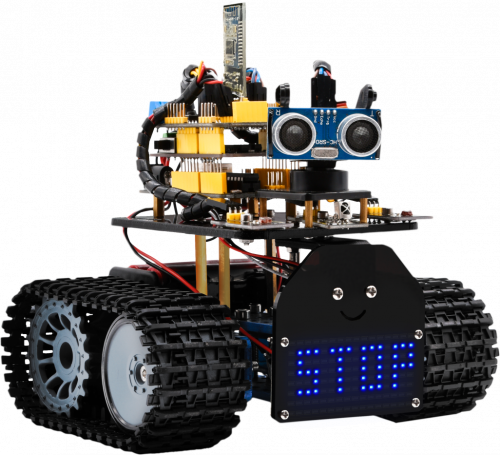
Note: Remove the Bluetooth module before uploading test code, otherwise, you will fail to upload test code.
Install Arduino IDE and Driver
Download software
When we get control board, we need to download Arduino IDE and driver firstly.
You could download Arduino IDE from the official website:
https://www.arduino.cc/, click the SOFTWARE on the browse bar, click “DOWNLOADS” to enter download page, as shown below:
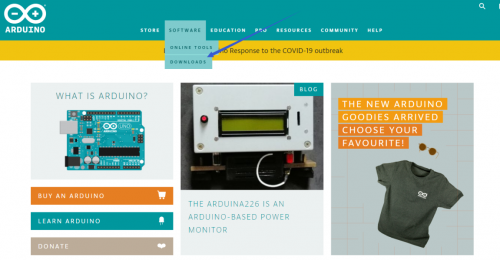
There are various versions for Arduino, just download a suitable version for your system, we will take WINDOWS system as an example to show you how to download and install.
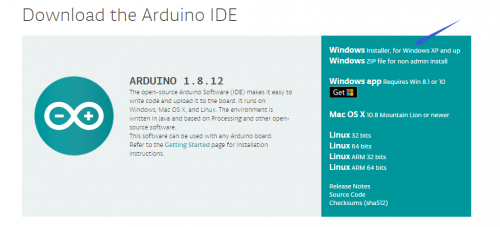
There are two versions for WINDOWS system, one is installed version, another one is download version, you just need to download file to computer directly and unzip it. These two versions can be used normally. Choose one and download on your computer.

You just need to click JUST DOWNLOAD, then click the downloaded file to install it. And when the ZIP file is downloaded, you can directly unzip and start it.
Keyestudio V4.0 Development Board
We need to know keyestudio V4.0 development board, as a core of this smart car.
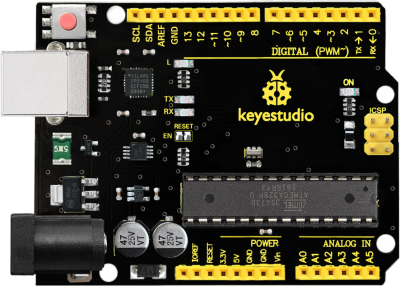
keyestudio V4.0 development board is an Arduino uno-compatible board, which is based on ATmega328P MCU, and with a cp2102 Chip as a UART-to-USB converter.
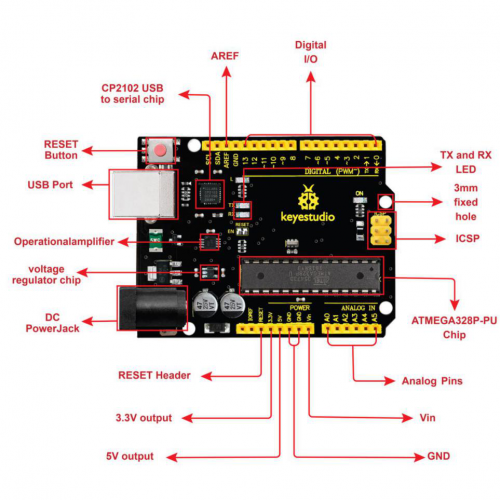
It has 14 digital input/output pins (of which 6 can be used as PWM outputs), 6 analog inputs, a 16 MHz quartz crystal, a USB connection, a power jack, 2 ICSP headers and a reset button.
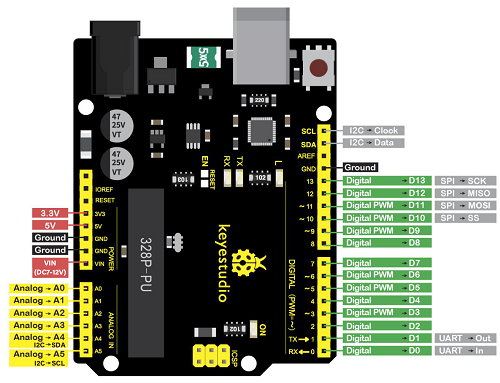
It contains everything needed to support the microcontroller; simply connect it to a computer with a USB cable or power it via an external DC power jack (DC 7-12V) or via female headers Vin/ GND(DC 7-12V) to get started.
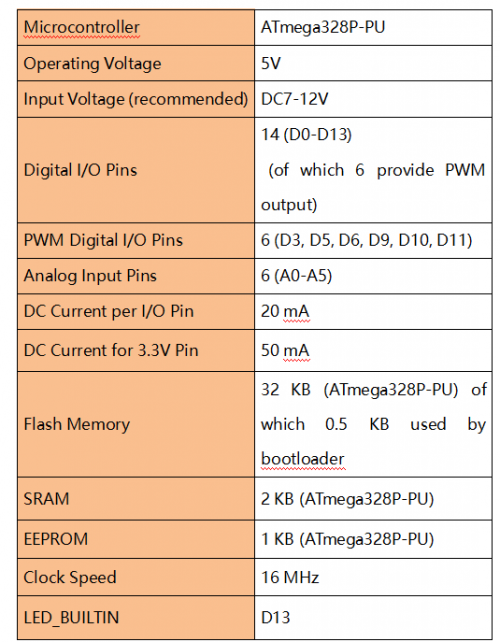
Installing driver
Let’s install the driver of keyestudio PLUS control board. The USB-TTL chip on PLUS board adopts CP2102 serial chip. The driver program of this chip is included in Arduino 1.8 version and above, which is convenient. Plug on USB port of board, the computer can recognize the hardware and automatically install the driver of CP2102.
If install unsuccessfully, or you intend to install manually, open the device manager of computer. Right click Computer—— Properties—— Device Manager.
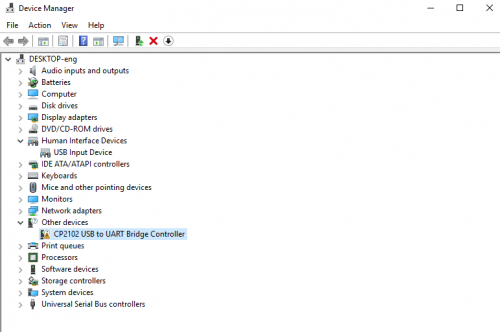
There is a yellow exclamation mark on the page, which implies installing the driver of CP2102 unsuccessfully. Then we double click the hardware and update the driver.
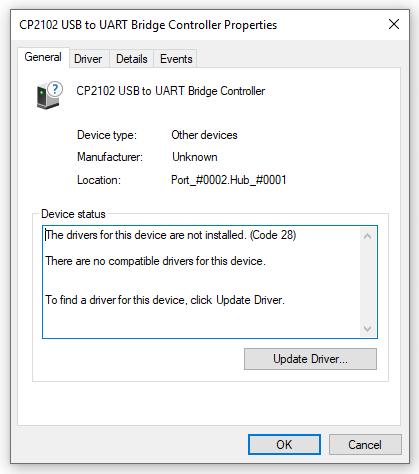
Click “OK” to enter the following page, click “browse my computer for updated driver software”, find out the installed or downloaded ARDUINO software. As shown below:
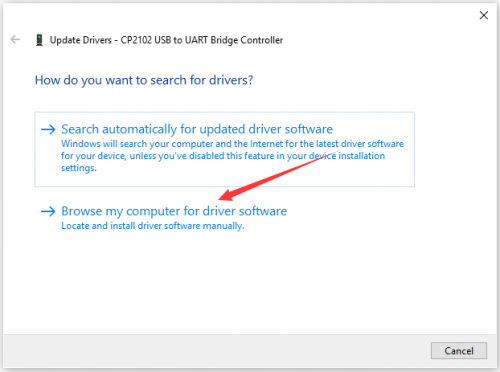
There is a DRIVERS folder in Arduino software installed package(), open driver folder and you can see the driver of CP210X series chips.
We click “Browse”, then find out the driver folder, or you could enter “driver” to search in rectangular box, then click “next”, the driver will be installed successfully. (I place Arduino software folder on the desktop, you could follow my way)
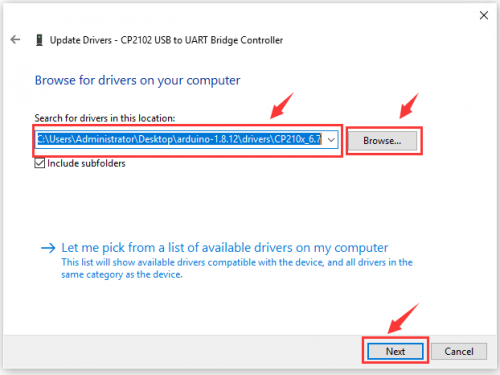
Open device manager, we will find the yellow exclamation mark disappear. The driver of CP2102 is installed successfully.
Install other visions of driver
If your development board is Arduino UNO board, install the driver as follows:
Step 1: Plug in the development board, click Computer—— Properties—— Device Manager, you could see the unknown device is shown.
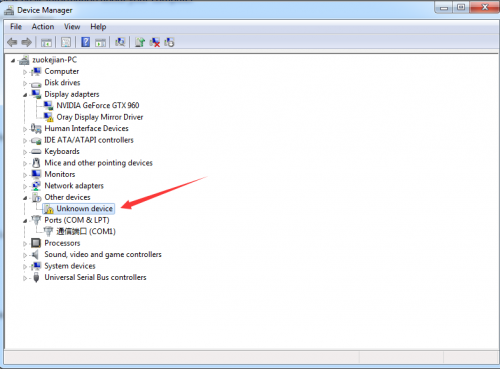
Step 2: Update the driver
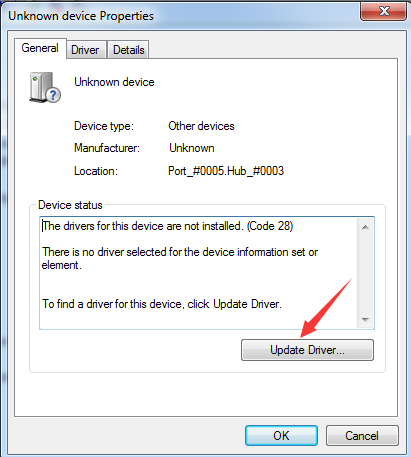
Step 3: click“browse my computer for updated driver software”
Step 4: find out the folder where the ARDUINO software is installed, click drivers folder and tap“Next”
Step 5: the driver is installed successfully.
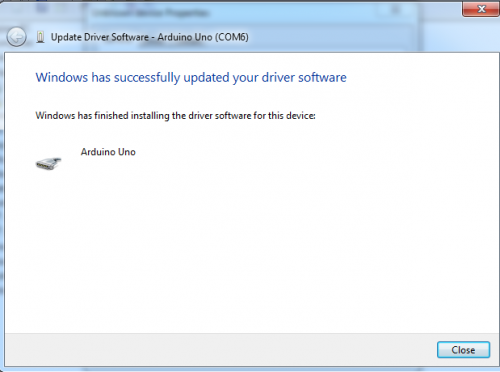
The device manager shows the serial port of Arduino.
Arduino IDE Setting
Click
To avoid the errors when uploading the program to the board, you need to select the correct Arduino board that matches the board connected to your computer.
Then come back to the Arduino software, you should click Tools→Board, select the board. (as shown below)
Then select the correct COM port (you can see the corresponding COM port after the driver is successfully installed)
Before uploading the program to the board, let’s demonstrate the function of each symbol in the Arduino IDE toolbar.
A- Used to verify whether there is any compiling mistakes or not.
B- Used to upload the sketch to your Arduino board.
C- Used to create shortcut window of a new sketch.
D- Used to directly open an example sketch.
E- Used to save the sketch.
F- Used to send the serial data received from board to the serial monitor.
Start your first program
Open the file to select Example, choose BLINK from BASIC, as shown below:
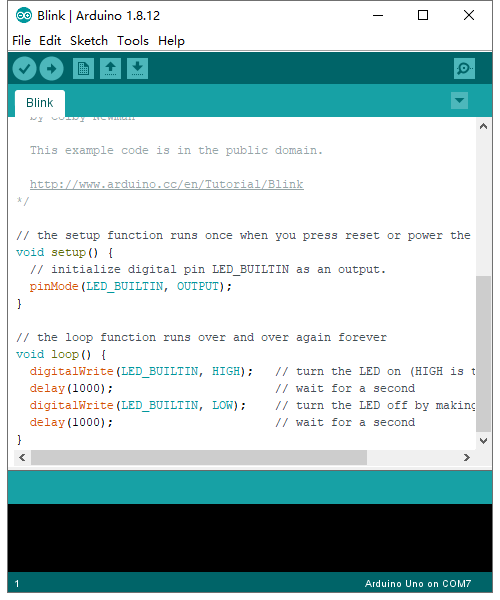
Set board and COM port, the corresponding board and COM port are shown on the lower right of IDE.
Click to start compiling the program, check errors.
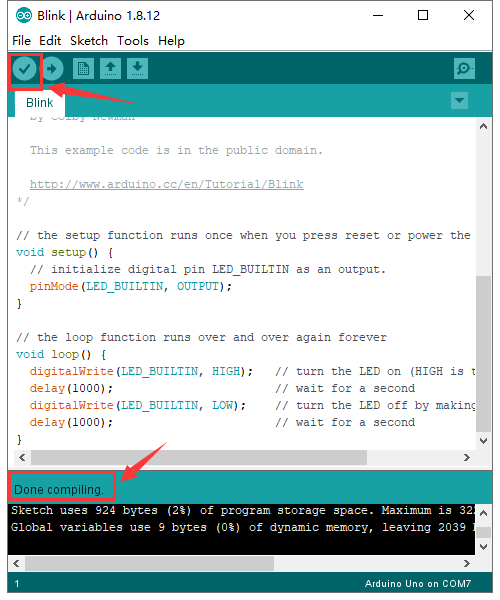
Click to upload the program, upload successfully.
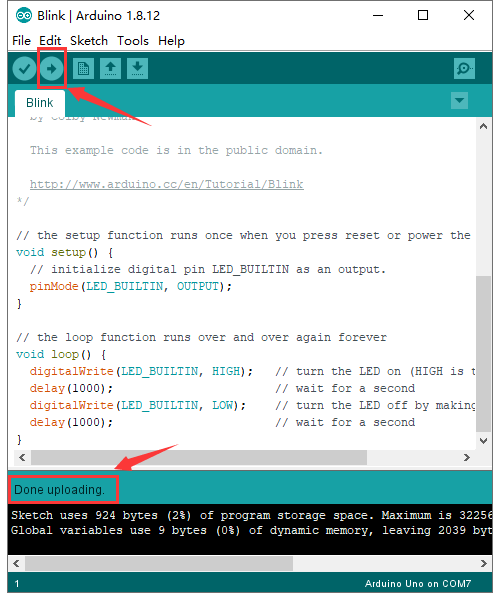
Upload the program successfully, the onboard LED lights on for 1s, lights off for 1s. Congratulation, you finish the first program.
How to Add a Library?
What are Libraries ?
Libraries are a collection of code that makes it easy for you to connect to a sensor,display, module, etc.
For example, the built-in LiquidCrystal library helps talk to LCD displays. There are hundreds of additional libraries available on the Internet for download.
The built-in libraries and some of these additional libraries are listed in the reference.
Here we will introduce the most simple way for you to add libraries .
Step 1:After downloading well the Arduino IDE, you can right-click the icon of Arduino IDE.
Find the option «Open file location» shown as below:
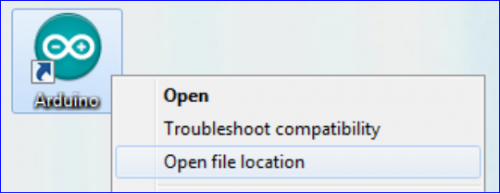
Step 2: Enter it to find out libraries folder which is the library file of Arduino.
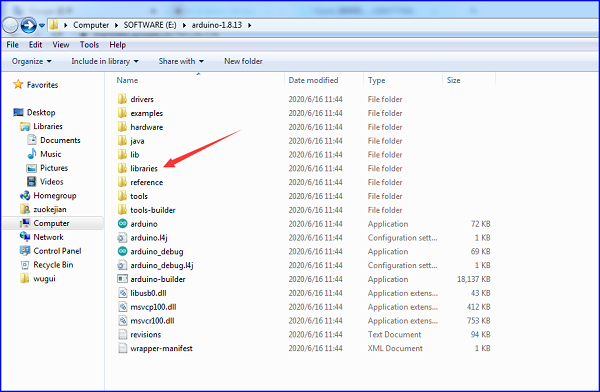
Step 3:Next to find out the“libraries”of tank robot(seen in the link: https://fs.keyestudio.com/KS0428), you just need to replicate and paste into the libraries folder of Arduino IDE.
Then the libraries of tank robot are installed successfully, as shown below:
Projects
Project 1: LED Blink
(1)Description
For the starter and enthusiast, this is a fundamental program—LED Blink.
LED, the abbreviation of light emitting diodes, consist of Ga, As, P, N chemical compound and so on. The LED can flash diverse color by altering the delay time in the test code. When in control, power on GND and VCC, the LED will be on if S end is high level; nevertheless, it will go off.
(2)Specification
- Control interface: digital port
- Working voltage: DC 3.3-5V
- Pin spacing: 2.54mm
- LED display color: red
(3)Equipment
(4) V5 Sensor Shield
There will be troublesome when we combine Arduino development boards with numerous sensors. However, the V5 sensor shield, compatible with Arduino development board, address this problem perfectly. Just stack V5 board on it.
This sensor shield can be inserted into 3pin sensor modules and breaks out some some communication pins, like serial, IIC, and SPI communication as well.
Pins Description
Connection Diagram:
Seen from the above diagram, LED is linked with D2
(5) Test Code
/*
keyestudio Mini Tank Robot V2
lesson 1.1
Blink
http://www.keyestudio.com
*/
void setup()
{
pinMode(2, OUTPUT);// initialize digital pin 2 as an output.
}
void loop() // the loop function runs over and over again forever
{
digitalWrite(2, HIGH); // turn the LED on (HIGH is the voltage level)
delay(1000); // wait for a second
digitalWrite(2, LOW); // turn the LED off by making the voltage LOW
delay(1000); // wait for a second
}
//****************************************************************
(6) Test Result
(There will be contradict about serial communication between code and Bluetooth when uploading code, therefore, don’t link with Bluetooth module before uploading code.)
Upload the program on the development board, LED flicker with the interval of 1s.
(7)Code Explanation
pinMode(2,OUTPUT) — Set pin2 to OUTPUT
digitalWrite(2,HIGH) — When set pin2 to HIGH level(output 5V) or to LOW level(output 0V)
(8)Extension Practice
We succeed to blink LED. Next, let’s observe what LED will change if we modify pins and delay time.
Connection Diagram
We’ve altered pins and connected LED to D10.
Test Code:
/*
keyestudio Mini Tank Robot V2
lesson 1.2
delay
http://www.keyestudio.com
*/
void setup() { // initialize digital pin 10 as an output.
pinMode(10, OUTPUT);
}
// the loop function runs over and over again forever
void loop() {
digitalWrite(10, HIGH); // turn the LED on (HIGH is the voltage level)
delay(100); // wait for 0.1 second
digitalWrite(10, LOW); // turn the LED off by making the voltage LOW
delay(100); // wait for 0.1 second
}
//****************************************************************
The LED flickers faster than before through the test result, therefore, pins and delay time affect flash frequency.
Project 2: Adjust LED Brightness
(1)Description
In previous lesson, we control LED on and off and make it blink.
In this project, we will control LED brightness through PWM to simulate breathing effect. Similarly, you can change the step length and delay time in the code so as to demonstrate different breathing effect.
PWM is a means of controlling the analog output via digital means. Digital control is used to generate square waves with different duty cycles (a signal that constantly switches between high and low levels) to control the analog output.In general, the input voltage of port are 0V and 5V. What if the 3V is required? Or what if switch among 1V, 3V and 3.5V? We can’t change resistor constantly. For this situation, we need to control by PWM.
For the Arduino digital port voltage output, there are only LOW and HIGH, which correspond to the voltage output of 0V and 5V. You can define LOW as 0 and HIGH as 1, and let the Arduino output five hundred 0 or 1 signals within 1 second.
If output five hundred 1, that is 5V; if all of which is 1, that is 0V. If output 010101010101 in this way then the output port is 2.5V, which is like showing movie. The movie we watch are not completely continuous. It actually outputs 25 pictures per second. In this case, the human can’t tell it, neither does PWM. If want different voltage, need to control the ratio of 0 and 1. The more 0,1 signals output per unit time, the more accurately control.
(2) Specification
- Control interface: digital port
- Working voltage: DC 3.3-5V
- Pin spacing: 2.54mm
- Display color: red
(3) Equipment
(4) Connection Diagram
(5) Test Code
/*
keyestudio Mini Tank Robot V2
lesson 2.1
pwm
http://www.keyestudio.com
*/
int ledPin = 10; // Define the LED pin at D10
int value;
void setup ()
{
pinMode (ledPin, OUTPUT); // initialize ledpin as an output.
}
void loop ()
{
for (value = 0; value <255; value = value + 1)
{
analogWrite (ledPin, value); // LED lights gradually light up
delay (5); // delay 5MS
}
for (value = 255; value> 0; value = value-1)
{
analogWrite (ledPin, value); // LED gradually goes out
delay (5); // delay 5MS
}}//**********************************************************
(6)Test Result
Upload test code successfully, LED gradually becomes brighter then darker, like human breath, rather than light on and off immediately.
(7)Code Explanation
When we need to repeat some statements, we could use FOR statement.
FOR statement format is shown below:
FOR cyclic sequence:
Round 1:1 → 2 → 3 → 4
Round 2:2 → 3 → 4
…
Until number 2 is not established, “for”loop is over,
After knowing this order, go back to code:
for (int value = 0; value < 255; value=value+1){
...
}
for (int value = 255; value >0; value=value-1){
...
}
The two“for”statements make value increase from 0 to 255, then reduce from 255 to 0, then increase to 255,….infinitely loop
There is a new function in the following —— analogWrite()
We know that digital port only has two state of 0 and 1. So how to send an analog value to a digital value? Here,this function is needed. Let’s observe the Arduino board and find 6 pins marked“~”which can output PWM signals.
Function format as follows:
analogWrite(pin,value)
analogWrite() is used to write an analog value from 0~255 for PWM port, so the value is in the range of 0~255. Attention that you only write the digital pins with PWM function, such as pin 3, 5, 6, 9, 10, 11.
PWM is a technology to obtain analog quantity through digital method. Digital control forms a square wave, and the square wave signal only has two states of turning on and off (that is, high or low levels). By controlling the ratio of the duration of turning on and off, a voltage varying from 0 to 5V can be simulated. The time turning on(academically referred to as high level) is called pulse width, so PWM is also called pulse width modulation.
Through the following five square waves, let’s acknowledge more about PWM.
In the above figure, the green line represents a period, and value of analogWrite() corresponds to a percentage which is called Duty Cycle as well. Duty cycle implies that high-level duration is divided by low-level duration in a cycle. From top to bottom, the duty cycle of first square wave is 0% and its corresponding value is 0. The LED brightness is lowest, that is, turn off. The more time high level lasts, the brighter the LED.
Therefore, the last duty cycle is 100%, which correspond to 255, LED is brightest. 25% means darker.
PWM mostly is used for adjusting the LED brightness or rotation speed of motor.
It plays vital role in controlling smart robot car. I believe that you can’t wait to enter next project.
(8) Extension Practice:
Let’s modify the value of delay and remain the pin unchanged, then observe how LED changes.
/*
keyestudio Mini Tank Robot V2
lesson 2.2
pwm-slow
http://www.keyestudio.com
*/
int ledPin = 10; // Define the LED pin at D10
int value;
void setup ()
{
pinMode (ledPin, OUTPUT); // initialize ledpin as an output.
}
void loop ()
{
for (value = 0; value <255; value = value + 1)
{
analogWrite (ledPin, value); // LED lights gradually light up
delay (30); // delay 30MS
}
for (value = 255; value> 0; value = value-1)
{
analogWrite (ledPin, value); // LED gradually goes out
delay (30); // delay 30MS
}}//**********************************************************
Upload code on the development board and LED gradually get brighter then darker.
Project 3: Photoresistor Sensor
(1)Description
The photoresistor is a special resistor made of semiconductor materials such as CdS or Selenide septum. The surface is also coated with moisture-proof resin, which has a photoconductive effect. It is sensitive to ambient light. Its resistance varies from different light intensities.
We use the characteristics of the photo-resistor to design the circuit and generate the photo-resistor module.
Connecting the signal pin of photocell module to Analog port, when the stronger the light intensity, the greater the voltage of analog port, the greater the analog value is.
On the contrary, the weaker the light intensity, the smaller the voltage of analog port, the smaller the analog value is.
Based on that, we can use the photocell module to read the analog value, so get the ambient light intensity.
(2)Specification
- Resistance:5K ohm-0.5Mohm
- Interface Type: analog
- Working Voltage: 3.3V-5V
- Easy installation: with screw fixing holes
- Pin spacing: 2.54mm
(3)Equipment
Connection Diagram:
The two photoresistor sensors are linked with A1 and A2, then finish the experiment via photoresistor connected to A1. Then finish the following experiment via photoresistor connected A1. Let’s read its analog value.
(4)Test Code
/*
keyestudio Mini Tank Robot V2
lesson 3.1
photocell
http://www.keyestudio.com
*/
int sensorPin = A1; // select the input pin for the photocell
int sensorValue = 0; // variable to store the value coming from the sensor
void setup() {
Serial.begin(9600);
}
void loop() {
sensorValue = analogRead(sensorPin); // read the value from the sensor:
Serial.println(sensorValue); //Serial port prints the resistance value
delay(500);
}
//******************************************************
(5)Test Result
Upload code on development board, open serial monitor, check if its value diminishes when covering photoresistor. However, the value increases when uncovered.
(6)Code Explanation
analogRead(sensorPin):read the analog value of photoresistor via analog ports.
Serial.begin(9600): Initialize the serial port, baud rate of serial communication is 9600
Serial.println : Serial port prints and word wrap.
(7)Extension Practice
We’ve known how to read the value of photoresistor. Let’s combine photoresistor with LED and view the status of LED.
PWM restrains the brightness, so LED is linked with PWM pins, connect LED to pin 10, keep pin of photoresistor unchanged, then design the code:
/*keyestudio Mini Tank Robot V2
lesson 3.2
photocell-analog output
http://www.keyestudio.com
*/
int analogInPin = A1; // Analog input pin that the photocell is attached to
int analogOutPin = 10; // Analog output pin that the LED is attached to
int sensorValue = 0; // value read from the pot
int outputValue = 0; // value output to the PWM (analog out)
void setup() {
Serial.begin(9600);
}
void loop() {
// read the analog in value:
sensorValue = analogRead(analogInPin);
// map it to the range of the analog out:
outputValue = map(sensorValue, 0, 1023, 0, 255);
// change the analog out value:
analogWrite(analogOutPin, outputValue);
// wait 2 milliseconds before the next loop for the analog-to-digital
// converter to settle after the last reading:
Serial.println(sensorValue); //serial port prints the value of photoresistor
delay(2);
}
//***************************************************************
Upload code, press it by hand and see the the LED brightness.
Project 4: Servo Control
(1)Description
Servo motor is a position control rotary actuator. It mainly consists of housing, circuit board, core-less motor, gear and position sensor. Its working principle is that the servo receives the signal sent by MCU or receiver and produces a reference signal with a period of 20ms and width of 1.5ms, then compares the acquired DC bias voltage to the voltage of the potentiometer and obtain the voltage difference output.
When the motor speed is constant, the potentiometer is driven to rotate through the cascade reduction gear, which leads that the voltage difference is 0, and the motor stops rotating. Generally, the angle range of servo rotation is 0° —180 °
The rotation angle of servo motor is controlled by regulating the duty cycle of PWM (Pulse-Width Modulation) signal. The standard cycle of PWM signal is 20ms (50Hz). Theoretically, the width is distributed between 1ms-2ms, but in fact, it’s between 0.5ms-2.5ms. The width corresponds the rotation angle from 0° to 180°. But note that for different brand motor, the same signal may have different rotation angle.
The corresponding servo angles are shown below:
(2)Specification
- Working voltage: DC 4.8V ~ 6V
- Operating angle range: about 180 ° (at 500 → 2500 μsec)
- Pulse width range: 500 → 2500 μsec
- No-load speed: 0.12 ± 0.01 sec / 60 (DC 4.8V) 0.1 ± 0.01 sec / 60 (DC 6V)
- No-load current: 200 ± 20mA (DC 4.8V) 220 ± 20mA (DC 6V)
- Stopping torque: 1.3 ± 0.01kg · cm (DC 4.8V) 1.5 ± 0.1kg · cm (DC 6V)
- Stop current: ≦ 850mA (DC 4.8V) ≦ 1000mA (DC 6V)
- Standby current: 3 ± 1mA (DC 4.8V) 4 ± 1mA (DC 6V)
(3)Equipment
(4)Connection Diagram:
Wiring note: the brown line of servo is linked with Gnd(G), the red line is connected to 5v(V) and orange line is attached to digital 9.
The servo have to be connected to external power, due to its high demand for driving servo current. Generally, the current of development board is not enough. If without connected power, the development board could be burnt.
(5)Test Code1
/*
keyestudio Mini Tank Robot V2
lesson 4.1
Servo
http://www.keyestudio.com
*/
#define servoPin 9 //servo Pin
int pos; //angle variable of servo
int pulsewidth; // pulse width variable of servo
void setup() {
pinMode(servoPin, OUTPUT); //set servo pin to OUTPUT
procedure(0); //set the angle of servo to 0°
}
void loop() {
for (pos = 0; pos <= 180; pos += 1) { // goes from 0 degrees to 180 degrees
// in steps of 1 degree
procedure(pos); // tell servo to go to position in variable 'pos'
delay(15); //control the rotation speed of servo
}
for (pos = 180; pos >= 0; pos -= 1) { // goes from 180 degrees to 0 degrees
procedure(pos); // tell servo to go to position in variable 'pos'
delay(15);
}
}
// function to control servo
void procedure(int myangle) {
pulsewidth = myangle * 11 + 500; //calculate the value of pulse width
digitalWrite(servoPin,HIGH);
delayMicroseconds(pulsewidth); //The duration of high level is pulse width
digitalWrite(servoPin,LOW);
delay((20 - pulsewidth / 1000)); // the cycle is 20ms, the low level last for the rest of time
}
//********************************************************************
Upload code successfully, servo swings back in the range of 0° to 180°
There is another guide for restraining servo—- servo library file, the following link of official website is for your reference.
https://www.arduino.cc/en/Reference/Servo
Servo library file
(6)Test Code2
/*
keyestudio Mini Tank Robot V2
lesson 4.2
servo
http://www.keyestudio.com
*/
#include <Servo.h>
Servo myservo; // create servo object to control a servo
// twelve servo objects can be created on most boards
int pos = 0; // variable to store the servo position
void setup() {
myservo.attach(9); // attaches the servo on pin 9 to the servo object
}
void loop() {
for (pos = 0; pos <= 180; pos += 1) { // goes from 0 degrees to 180 degrees
// in steps of 1 degree
myservo.write(pos); // tell servo to go to position in variable 'pos'
delay(15); // waits 15ms for the servo to reach the position
}
for (pos = 180; pos >= 0; pos -= 1) { // goes from 180 degrees to 0 degrees
myservo.write(pos); // tell servo to go to position in variable 'pos'
delay(15); // waits 15ms for the servo to reach the position
}
}
//****************************************************************
(7)Test Result
Upload code successfully and power on, servo rotates in the range of 0° to 180°. The result is same. We usually control it by library file.
(8)Code Explanation
Arduino comes with #include <Servo.h> (servo function and statement)
The following are some common statements of the servo function:
1. attach(interface)——Set servo interface, port 9 and 10 are available
3.write(angle)——The statement to set rotation angle of servo, the angle range is from 0° to 180°
3. read()——The statement to read angle of servo, read the command value of “write()”
4. Note: The above written format is “servo variable name, specific statement()”, for instance: myservo.attach(9)
Project 5: Ultrasonic Sensor
(1)Description
The HC-SR04 ultrasonic sensor uses sonar to determine distance to an object like bats do. It offers excellent non-contact range detection with high accuracy and stable readings in an easy-to-use package. It comes complete with ultrasonic transmitter and receiver modules.
The HC-SR04 or the ultrasonic sensor is being used in a wide range of electronics projects for creating obstacle detection and distance measuring application as well as various other applications. Here we have brought the simple method to measure the distance with arduino and ultrasonic sensor and how to use ultrasonic sensor with arduino.
(2)Specification
- Power Supply :+5V DC
- Quiescent Current : <2mA
- Working Current: 15mA
- Effectual Angle: <15°
- Ranging Distance : 2cm – 400 cm
- Resolution : 0.3 cm
- Measuring Angle: 30 degree
- Trigger Input Pulse width: 10uS
(3)Equipment
(4)The principle of ultrasonic sensor
As the above picture shown, it is like two eyes. One is transmitting end, the other is receiving end.
The ultrasonic module will emit the ultrasonic waves after trigger signal. When the ultrasonic waves encounter the object and are reflected back, the module outputs an echo signal, so it can determine the distance of object from the time difference between trigger signal and echo signal.
The t is the time that emitting signal meets obstacle and returns.
and the propagation speed of sound in the air is about 343m/s, therefore, distance = speed * time, because the ultrasonic wave emits and comes back, which is 2 times of distance, so it needs to be divided by 2, the distance measured by ultrasonic wave = (speed * time)/2
1.Use method and timing chart of ultrasonic module:
Setting the delay time of Trig pin of SR04 to 10μs at least, which can trigger it to detect distance.
2. After triggering, the module will automatically send eight 40KHz ultrasonic pulses and detect whether there is a signal return. This step will be completed automatically by the module.
3. If the signal returns, the Echo pin will output a high level, and the duration of the high level is the time from the transmission of the ultrasonic wave to the return.
Circuit diagram of ultrasonic sensor:
(5)Connection Diagram
(6)Test Code
/*
keyestudio Mini Tank Robot V2
lesson 5
Ultrasonic sensor
http://www.keyestudio.com
*/
int trigPin = 5; // Trigger
int echoPin = 4; // Echo
long duration, cm, inches;
void setup() {
//Serial Port begin
Serial.begin (9600);
//Define inputs and outputs
pinMode(trigPin, OUTPUT);
pinMode(echoPin, INPUT);
}
void loop() {
// The sensor is triggered by a HIGH pulse of 10 or more microseconds.
// Give a short LOW pulse beforehand to ensure a clean HIGH pulse:
digitalWrite(trigPin, LOW);
delayMicroseconds(2);
digitalWrite(trigPin, HIGH);
delayMicroseconds(10);
digitalWrite(trigPin, LOW);
// Read the signal from the sensor: a HIGH pulse whose
// duration is the time (in microseconds) from the sending
// of the ping to the reception of its echo off of an object.
duration = pulseIn(echoPin, HIGH);
// Convert the time into a distance
cm = (duration/2) / 29.1; // Divide by 29.1 or multiply by 0.0343
inches = (duration/2) / 74; // Divide by 74 or multiply by 0.0135
Serial.print(inches);
Serial.print("in, ");
Serial.print(cm);
Serial.print("cm");
Serial.println();
delay(250);
}
//****************************************************************
(7)Test Result
Upload test code on the development board, open serial monitor and set baud rate to 9600. The detected distance will be displayed, unit is cm and inch. Hinder the ultrasonic sensor by hand, the displayed distance value is smaller.
(8)Code Explanation
int trigPin = 5; this pin is defined pin to transmit ultrasonic waves, generally output.
int echoPin = 4; this is defined as the pin of reception, generally input
cm = (duration/2) / 29.1; inches = (duration/2) / 74; by 0.0135
We can calculate the distance by using the following formula:
distance = (traveltime/2) x speed of sound
The speed of sound is: 343m/s = 0.0343 cm/uS = 1/29.1 cm/uS
Or in inches: 13503.9in/s = 0.0135in/uS = 1/74in/uS
We need to divide the traveltime by 2 because we have to take into account that the wave was sent, hit the object, and then returned back to the sensor.
(9)Extension Practice:
We have just measured the distance displayed by the ultrasonic. How about controlling the LED with the measured distance? Let’s try it, connect an LED light module to the D10 pin.
/*
keyestudio Mini Tank Robot V2
lesson 5
Ultrasonic LED
http://www.keyestudio.com
*/
int trigPin = 5; // Trigger
int echoPin = 4; // Echo
long duration, cm, inches;
void setup() {
//Serial Port begin
Serial.begin (9600);
//Define inputs and outputs
pinMode(trigPin, OUTPUT);
pinMode(echoPin, INPUT);
}
void loop()
{
// The sensor is triggered by a HIGH pulse of 10 or more microseconds.
// Give a short LOW pulse beforehand to ensure a clean HIGH pulse:
digitalWrite(trigPin, LOW);
delayMicroseconds(2);
digitalWrite(trigPin, HIGH);
delayMicroseconds(10);
digitalWrite(trigPin, LOW);
// Read the signal from the sensor: a HIGH pulse whose
// duration is the time (in microseconds) from the sending
// of the ping to the reception of its echo off of an object.
duration = pulseIn(echoPin, HIGH);
// Convert the time into a distance
cm = (duration/2) / 29.1; // Divide by 29.1 or multiply by 0.0343
inches = (duration/2) / 74; // Divide by 74 or multiply by 0.0135
Serial.print(inches);
Serial.print("in, ");
Serial.print(cm);
Serial.print("cm");
Serial.println();
delay(250);
if (cm>=2 && cm<=10)
digitalWrite(10, HIGH);
delay(1000);
digitalWrite(10, LOW);
delay(1000);
}
//****************************************************************
Upload test code to development board and block ultrasonic sensor by hand, then check if LED is on
Project 6: IR Reception
(1)Description
There is no doubt that infrared remote control is ubiquitous in daily life. It is used to control various household appliances, such as TVs, stereos, video recorders and satellite signal receivers. Infrared remote control is composed of infrared transmitting and infrared receiving systems, that is, an infrared remote control and infrared receiving module and a single-chip microcomputer capable of decoding.
The 38K infrared carrier signal emitted by remote controller is encoded by the encoding chip in the remote controller. It is composed of a section of pilot code, user code, user inverse code, data code, and data inverse code. The time interval of the pulse is used to distinguish whether it is a 0 or 1 signal and the encoding is made up of these 0, 1 signals.
The user code of the same remote control is unchanged. The data code can distinguish the key.
When the remote control button is pressed, the remote control sends out an infrared carrier signal. When the IR receiver receives the signal, the program will decode the carrier signal and determines which key is pressed. The MCU decodes the received 01 signal, thereby judging what key is pressed by the remote control.
Infrared receiver we use is an infrared receiver module. Mainly composed of an infrared receiver head, it is a device that integrates reception, amplification, and demodulation. Its internal IC has completed demodulation, and can achieve from infrared reception to output and be compatible with TTL signals. Additionally, it is suitable for infrared remote control and infrared data transmission. The infrared receiving module made by the receiver has only three pins, signal line, VCC and GND. It is very convenient to communicate with arduino and other microcontrollers.
(2)Specification
- Operating Voltage: 3.3-5V(DC)
- Interface: 3PIN
- Output Signal: Digital signal
- Receiving Angle: 90 degrees
- Frequency: 38khz
- Receiving Distance: 10m
(3)Equipment
(4)Connection Diagram
Respectively link “-”、“+” and S of IR receiver module with G(GND), V(VCC)and A0 of keyestudio development board.
Attention: On the condition that digital ports are not available, analog ports can be regarded as digital ports. A0 equals to D14, A1 is equivalent to digital 15.
(5)Test Code
Firstly import library file of IR receiver module(refer to how to import Arduino library file) before designing code.
/*
keyestudio Mini Tank Robot V2
lesson 6
IRremote
http://www.keyestudio.com
*/
#include <IRremoteTank.h> // IRremote library statement
int RECV_PIN = A0; //define the pins of IR receiver as A0
IRrecv irrecv(RECV_PIN);
decode_results results; // decode results exist in the “result” of “decode results”
void setup()
{
Serial.begin(9600);
irrecv.enableIRIn(); //Enable receiver
}
void loop() {
if (irrecv.decode(&results))//decode successfully, receive a set of infrared signals
{
Serial.println(results.value, HEX);//Wrap word in 16 HEX to output and receive code
irrecv.resume(); // Receive the next value
}
delay(100);
}
//*******************************************************
(6)Test Result
Upload test code, open serial monitor and set baud rate to 9600, point remote control to IR receiver and the corresponding value will be shown, if pressing so long, the error codes will appear.
Below we have listed out each button value of keyestudio remote control. So you can keep it for reference.
(7)Code Explanation
irrecv.enableIRIn(): after enabling IR decoding, the IR signals will be received, then function“decode()”will check continuously if decode successfully.
irrecv.decode(&results): after decoding successfully, this function will come back to “true”, and keep result in “results”. After decoding a IR signals, run the resume()function and receive the next signal
(8)Extension Practice
We decoded the key value of IR remote control. How about restrain LED by the measured value? We could operate an experiment to affirm. Attach a LED to D10. When keep the pin of IR receiver unchanged, LED will be on when pressing the key of remote control; press again, LED will be off.
/* keyestudio Mini Tank Robot V2
lesson 6.2
IRremote
http://www.keyestudio.com
*/
#include <IRremoteTank.h>
int RECV_PIN = A0;//define the pin of IR receiver as A0
int LED_PIN=10;//define the pin of LED
int a=0;
IRrecv irrecv(RECV_PIN);
decode_results results;
void setup()
{
Serial.begin(9600);
irrecv.enableIRIn(); // Initialize the IR receiver
pinMode(LED_PIN,OUTPUT);//set LED_pin to OUTPUT
}
void loop() {
if (irrecv.decode(&results)) {
if(results.value==0xFF02FD &a==0) // according to the above key value, press“OK”on remote control , LED will be controlled
{
digitalWrite(LED_PIN,HIGH);//LED will be on
a=1;
}
else if(results.value==0xFF02FD &a==1) //press again
{
digitalWrite(LED_PIN,LOW);//LED will go off
a=0;
}
irrecv.resume(); //receive the next value
}
}
//*******************************************************
Upload code to development board, press“OK”key on remote control to make LED on and off.
Project 7: Bluetooth Remote Control
(1)Description
Bluetooth, a simple wireless communication module most popular since the last few decades and easy to use are being used in most of the battery-powered devices.
Over the years, there have been many upgrades of Bluetooth standard to keep fulfil the demand of customers and technology according to the need of time and situation.
Over the few years, there are many things changed including data transmission rate, power consumption with wearable and IoT Devices and Security System.
Here we are going to learn about HM-10 BLE 4.0 with Arduino Board. The HM-10 is a readily available Bluetooth 4.0 module. This module is used for establishing wireless data communication. The module is designed by using the Texas Instruments CC2540 or CC2541 Bluetooth low energy (BLE) System on Chip (SoC).
(2)Specification
- Bluetooth protocol: Bluetooth Specification V4.0 BLE
- No byte limit in serial port Transceiving
- In open environment, realize 100m ultra-distance communication with iphone4s
- Working frequency: 2.4GHz ISM band
- Modulation method: GFSK(Gaussian Frequency Shift Keying)
- Transmission power: -23dbm, -6dbm, 0dbm, 6dbm, can be modified by AT command.
- Sensitivity: ≤-84dBm at 0.1% BER
- Transmission rate: Asynchronous: 6K bytes ; Synchronous: 6k Bytes
- Security feature: Authentication and encryption
- Supporting service: Central & Peripheral UUID FFE0, FFE1
- Power consumption: Auto sleep mode, stand by current 400uA~800uA, 8.5mA during transmission.
- Power supply: 5V DC
- Working temperature: –5 to +65 Centigrade
(3)Equipment
(4)Connection Diagram
- 1. STATE: state test pins, connected to internal LED, generally keep it unconnected.
- 2. RXD: serial interface, receiving terminal.
- 3. TXD: serial interface, transmitting terminal.
- 4. GND: Ground.
- 5. VCC: positive pole of the power source.
- 6. EN/BRK: break connect, it means breaking the Bluetooth connection, generally, keep it unconnected.
(5)Test Code
/*
keyestudio Mini Tank Robot v2.0
lesson 7.1
bluetooth
http://www.keyestudio.com
*/
char ble_val; //character variable: save the value of Bluetooth reception
void setup() {
Serial.begin(9600);
}
void loop() {
if(Serial.available() > 0) //Judge if there is data in serial buffer
{
ble_val = Serial.read(); //Read data from serial buffer
Serial.println(ble_val); //Print
}}
//*******************************************
(There will be contradiction between serial communication of code and communication of Bluetooth when uploading code, therefore, don’t link with Bluetooth module before uploading code.)
After uploading code on development board, then insert Bluetooth module, wait for the command from cellphone.
(6)Download APP
Allow APP to access “location” in settings of your cellphone when connecting to Bluetooth module.
The code is reading the received signal, and we also need a stuff to send signal. In this project, we send signal to control robot car via cellphone.
Then we need to download the APP.
1.For iOS system
Enter APP STORE to search BLE Scanner 4.0, then download it.
2.For Android system
Enter Google Play to find out BLE Scanner, then download.
And allow APP to access“location”, you could enable “location”in settings of your cellphone.
- 3.After installation, open App and enable “Location and Bluetooth” permission.
- 4.We take iOS version as example. The operation method of Android version is almost same as it.
- 5.Scan Bluetooth module to get Bluetooth BLE 4.0. Its name is HMSoft.
Then click“connect”to link with Bluetooth and use it.
6. After connecting to HMSoft, click it to get multiple options, such as device information, access permission, general and custom service. Choose “CUSTOM SERVICE”
7.Then pop up the following page
8. Click(Read,Notify,WriteWithoutResponse)to enter the following page
9.Click Write Value, appear the interface to enter HEX or Text.
10.Open the serial monitor on Arduino,enter a 0 or other character at Text interface.
Then click“Write”, open serial monitor to view if there is a “0” signal
(7)Code Explanation
Serial.available() : The current rest characters when return to buffer area. Generally, this function is used to judge if there is data in buffer. When Serial.available()>0, it means that serial receives the data and can be read
Serial.read():Read a data of a Byte in buffer of serial port, for instance, device sends data to Arduino via serial port, then we could read data by “Serial.read()”
(8)Extension Practice
We could send a command via cellphone to turn on and off a LED.
D10 is connected to a LED, as shown below:
/*
keyestudio Mini Tank Robot v2.0
lesson 7.2
Bluetooth
http://www.keyestudio.com
*/
int ledpin=11;
void setup()
{Serial.begin(9600);
pinMode(ledpin,OUTPUT);
}
void loop()
{ int i;
if (Serial.available())
{i=Serial.read();
Serial.println("DATA RECEIVED:");
if(i=='1')
{ digitalWrite(ledpin,1);
Serial.println("led on");
}
if(i=='0')
{ digitalWrite(ledpin,0);
Serial.println("led off");
}}}//*******************************************
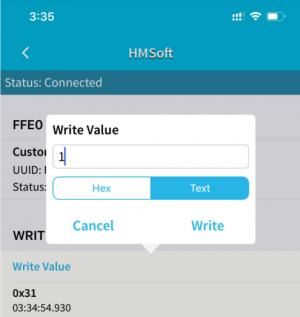
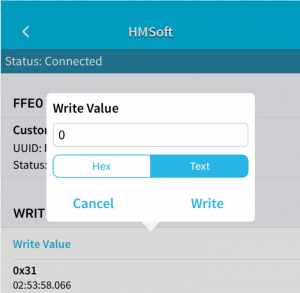
Click “Write” on APP, when you enter 1, LED will be on, when you input 0, LED will be off. (Remember to remove the Bluetooth module after finishing experiment, otherwise, burning code will be affected)
Project 8: Motor Driving and Speed Control
(1) Description
There are many ways to drive the motor. Our tank robot uses the most commonly used L298P solution. L298P is an excellent high-power motor driver IC produced by STMicroelectronics. It can directly drive DC motors, two-phase and four-phase stepping motors. The driving current up to 2A, and output terminal of motor adopts eight high-speed Schottky diodes as protection.
We designed a shield based on the circuit of L298p.
The stacked design reduces the technical difficulty of using and driving the motor.
(2)Specification
Circuit Diagram for L298P Board
- 1)Logic part input voltage: DC5V
- 2)Driving part input voltage: DC 7-12V
- 3)Logic part working current: <36mA
- 4)Driving part working current: <2A
- 5)Maximum power dissipation: 25W (T=75℃)
- 6)Working temperature: -25℃~+130℃
- 7)Control signal input level: high level 2.3V<Vin<5V, low level -0.3V<Vin<1.5V
(3)Drive Robot to Move
Through the above circuit diagram, the direction pin of A motor is D12, and speed pin is D3; D13 is the direction pin of B motor, D11 is speed pin.
We know how to control digital ports according to the following chart.
PWM decides 2 motors to turn so as to drive robot car. The PWM value is in the range of 0-255, the larger the number, the faster the motor rotates.
(4)Equipment
(5)Connection Diagram
Note: the 4Pin terminal block is marked with silkscreen 1234. The red line of right rear motor is connected to terminal 1, black line is linked with end 2. The red line of left front motor is attached to terminal 3, black line is linked with port 4.
(6)Test Code
/*
keyestudio Mini Tank Robot v2.0
lesson 8.1
motor driver
http://www.keyestudio.com
*/
#define ML_Ctrl 13 //define the direction control pin of left motor
#define ML_PWM 11 //define the PWM control pin of left motor
#define MR_Ctrl 12 //define direction control pin of right motor
#define MR_PWM 3 // define the PWM control pin of right motor
void setup()
{
pinMode(ML_Ctrl, OUTPUT);//define direction control pin of left motor as output
pinMode(ML_PWM, OUTPUT);//define PWM control pin of left motor as output
pinMode(MR_Ctrl, OUTPUT);//define direction control pin of right motor as output.
pinMode(MR_PWM, OUTPUT);//define the PWM control pin of right motor as output
}
void loop()
{
digitalWrite(ML_Ctrl,LOW);//set the direction control pin of left motor to LOW
analogWrite(ML_PWM,200);//set the PWM control speed of left motor to 200
digitalWrite(MR_Ctrl,LOW);//set the direction control pin of right motor to LOW
analogWrite(MR_PWM,200);//set the PWM control speed of right motor to 200
//front
delay(2000);//delay in 2s
digitalWrite(ML_Ctrl,HIGH);//set the direction control pin of left motor to HIGH
analogWrite(ML_PWM,200);//set the PWM control speed of left motor to 200
digitalWrite(MR_Ctrl,HIGH);//set the direction control pin of right motor to HIGH
analogWrite(MR_PWM,200);//set the PWM control speed of right motor to 200
//back
delay(2000);//delay in 2s
digitalWrite(ML_Ctrl,HIGH);//set the direction control pin of left motor to HIGH
analogWrite(ML_PWM,200);//set the PWM control speed of left motor to 200
digitalWrite(MR_Ctrl,LOW);//set the direction control pin of right motor to LOW
analogWrite(MR_PWM,200);//set the PWM control speed of right motor to 200
//left
delay(2000);//delay in 2s
digitalWrite(ML_Ctrl,LOW);//set the direction control pin of left motor to LOW
analogWrite(ML_PWM,200);//set the PWM control speed of left motor to 200
digitalWrite(MR_Ctrl,HIGH);//set the direction control pin of right motor to HIGH
analogWrite(MR_PWM,200);//set the PWM control speed of right motor to 200
//right
delay(2000);//delay in 2s
analogWrite(ML_PWM,0);//set the PWM control speed of left motor to 0
analogWrite(MR_PWM,0);//set the PWM control speed of right motor to 0
//stop
delay(2000);//delay in 2s
}//*****************************************
(7)Test Result
Hook up by connection diagram, upload code and power on, smart car goes forward and back for 2s, turns left and right for 2s, stops for 2s and alternately.
(8) Code Explanation
digitalWrite(ML_Ctrl,LOW): the rotation direction of motor is decided by the high/low level and and the pins that decide rotation direction are general pins.
analogWrite(ML_PWM,200): the speed of motor is regulated by PWM, The speed of motor is regulated by PWM, and the pins that decide the speed of motor have to be PWM pins.
(9)Extension Practice
Hook up in same way
/*
keyestudio Mini Tank Robot v2.0
lesson 8.2
motor driver pwm
http://www.keyestudio.com
*/
#define ML_Ctrl 13 //define the direction control pin of left motor
#define ML_PWM 11 //define the PWM control pin of left motor
#define MR_Ctrl 12 //define the control pin of right motor
#define MR_PWM 3 //define the PWM control pin of right motor
void setup()
{ pinMode(ML_Ctrl, OUTPUT);//define the direction control pin of left motor as OUTPUT
pinMode(ML_PWM, OUTPUT);//define the PWM control pin of left motor as OUTPUT
pinMode(MR_Ctrl, OUTPUT);//define the direction control pin of right motor as OUTPUT
pinMode(MR_PWM, OUTPUT);//define the PWM control pin of right motor as OUTPUT
}
void loop()
{ digitalWrite(ML_Ctrl,LOW);//Set direction control pin of left motor to LOW
analogWrite(ML_PWM,100);// Set the PWM control speed of left motor to 100
digitalWrite(MR_Ctrl,LOW);//Set the direction control pin of right motor to LOW
analogWrite(MR_PWM,100);//Set the PWM control speed of right motor to 100
//front
delay(2000);//define 2s
digitalWrite(ML_Ctrl,HIGH);//Set direction control pin of left motor to HIGH level
analogWrite(ML_PWM,100);//Set the PWM control speed of left motor to 100
digitalWrite(MR_Ctrl,HIGH);//Set direction control pin of right motor to HIGH level
analogWrite(MR_PWM,100);//Set the PWM control speed of right motor to 100
//back
delay(2000);//define 2s
digitalWrite(ML_Ctrl,HIGH);//Set direction control pin of left motor to HIGH level
analogWrite(ML_PWM,100);//Set the PWM control speed of left motor to 100
digitalWrite(MR_Ctrl,LOW);//Set direction control pin of right motor to LOW level
analogWrite(MR_PWM,100);//Set the PWM control speed of right motor to 100
//left
delay(2000);//define 2s
digitalWrite(ML_Ctrl,LOW);//set the direction control pin of left motor to LOW
analogWrite(ML_PWM,100);//set the PWM control speed of left motor to 200
digitalWrite(MR_Ctrl,HIGH);//set the direction control pin of right motor to HIGH
analogWrite(MR_PWM,100);//set the PWM control speed of right motor to 100
//right
delay(2000);//define 2s
analogWrite(ML_PWM,0);//set the PWM control speed of left motor to 0
analogWrite(MR_PWM,0);// set the PWM control speed of right motor to 0
//stop
delay(2000);//define 2s
}//******************************************************************
Upload code successfully, the motors rotate faster.
Project 9: LED Expression Panel
(1)Description
If we add an expression panel to the robot, it will be amazing. Keyestudio’s 8*16 dot matrix can meet your requirements. You can create facial expressions, patterns or other interesting displays yourself. 8*16 LED light board comes with 128 LEDs. The data of the microprocessor (arduino) communicates with the AiP1640 through the two-wire bus interface, so as to control the 128 LEDs on the module, which produce the patterns you need on dot matrix. To facilitate wiring, we also provide a HX-2.54 4Pin wiring.
(2)Specification
- Working voltage: DC 3.3-5V
- Power loss: 400mW
- Oscillation frequency: 450KHz
- Drive current: 200mA
- Working temperature: -40~80℃
- Communication method: two-wire bus
(3)Equipment
(4)8*16 Dot Matrix Display
Circuit Graphic
The principle of 8*16 dot matrix:
How to control each led light of 8*16 dot matrix? We know that a byte has 8 bits, each bit is 0 or 1. When a bit is 0, turn off LED and when a bit is 0, turn on LED.
Thereby, one byte can control the LED in a row of dot matrix, so 16 bytes can control 16 columns of led lights, that is, 8*16 dot matrix.
Interface Description and Communication Protocol:
The data of the microprocessor (arduino) communicates with the AiP1640 through the two-wire bus interface.
The communication protocol diagram is shown below:
(SCLK) is SCL, (DIN) is SDA:
①The starting condition for data input: SCL is high level and SDA changes from high to low.
②For data command setting, there are methods as shown in the figure below.
In our sample program, select the way to add 1 to the address automatically, the binary value is 0100 0000 and the corresponding hexadecimal value is 0x40.
③For address command setting, the address can be selected as shown below.
The first 00H is selected in our sample program, and the binary number 1100 0000 corresponds to the hexadecimal 0xc0
- ④The requirement for data input is that SCL is high level when inputting data, the signal on SDA must remain unchanged. Only when the clock signal on SCL is low level, the signal on SDA can be altered. The data input is low-order first, high-order is behind
- ⑤ The condition to end data transmission is that when SCL is low, SDA is low, and when SCL is high, the SDA level also becomes high.
- ⑥ Display control, set different pulse width, the pulse width can be selected as shown below
- In the example, we choose pulse width 4/16, and the hexadecimal corresponds to 1000 1010 is 0x8A
4. Introduction for Modulus Tool
The online version of dot matrix modulus tool:
http://dotmatrixtool.com/#
①Open links to enter the following page.
②The dot matrix is 8*16 in this project, so set the height to 8, width to 16, as shown below.
③ Generate hexadecimal data from the pattern
As shown below, press the left mouse button to select, the right button to cancel, draw the pattern you want, click Generate, and the hexadecimal data we need will be produced.
(5)Connection Diagram
Wiring note: The GND, VCC, SDA, and SCL of the 8×16 LED panel are respectively connected to -(GND), + (VCC), A4 and A5 of the keyestudio sensor expansion board for two-wire serial communication. (Note: This pin is connected to arduino IIC, but this module is not IIC communication, it can be linked with any two pins.)
(6)Test Code
The code that shows smile face
/*
keyestudio Mini Tank Robot v2.0
lesson 9.1
Matrix face
http://www.keyestudio.com
*/
//the data of smiley from modulus tool
unsigned char smile[] = {0x00, 0x00, 0x1c, 0x02, 0x02, 0x02, 0x5c, 0x40, 0x40, 0x5c, 0x02, 0x02, 0x02, 0x1c, 0x00, 0x00};
#define SCL_Pin A5 //Set clock pin to A5
#define SDA_Pin A4 //Set data pin to A4
void setup(){
//Set pin to output
pinMode(SCL_Pin,OUTPUT);
pinMode(SDA_Pin,OUTPUT);
//clear the display
//matrix_display(clear);
}
void loop(){
matrix_display(smile); // display smile face
}
// the function for dot matrix display
void matrix_display(unsigned char matrix_value[])
{
IIC_start(); // use the function of the data transmission start condition
IIC_send(0xc0); //select address
for(int i = 0;i < 16;i++) //pattern data has 16 bits
{
IIC_send(matrix_value[i]); //convey the pattern data
}
IIC_end(); //end the transmission of pattern data
IIC_start();
IIC_send(0x8A); //display control, set pulse width to 4/16 s
IIC_end();
}
//the condition to start conveying data
void IIC_start()
{
digitalWrite(SCL_Pin,HIGH);
delayMicroseconds(3);
digitalWrite(SDA_Pin,HIGH);
delayMicroseconds(3);
digitalWrite(SDA_Pin,LOW);
delayMicroseconds(3);
}
//Convey data
void IIC_send(unsigned char send_data)
{
for(char i = 0;i < 8;i++) //Each byte has 8 bits 8bit for every character
{
digitalWrite(SCL_Pin,LOW); // pull down clock pin SCL_Pin to change the signal of SDA
delayMicroseconds(3);
if(send_data & 0x01) //set high and low level of SDA_Pin according to 1 or 0 of every bit
{
digitalWrite(SDA_Pin,HIGH);
}
else
{
digitalWrite(SDA_Pin,LOW);
}
delayMicroseconds(3);
digitalWrite(SCL_Pin,HIGH); //pull up the clock pin SCL_Pin to stop transmission
delayMicroseconds(3);
send_data = send_data >> 1; // detect bit by bit, shift the data to the right by one
}
}
//The sign of ending data transmission
void IIC_end()
{
digitalWrite(SCL_Pin,LOW);
delayMicroseconds(3);
digitalWrite(SDA_Pin,LOW);
delayMicroseconds(3);
digitalWrite(SCL_Pin,HIGH);
delayMicroseconds(3);
digitalWrite(SDA_Pin,HIGH);
delayMicroseconds(3);
}
//******************************************************
(7)Test Result
Wire according to connection diagram. The DIP switch is dialed to right end and power on, the smile face appears on dot matrix.
(8)Extension Practice
We use the modulo tool (http://dotmatrixtool.com/#)to make the dot matrix alternately display start, go front and stop patterns then clear the patterns, the time interval is 2000 milliseconds.
Get the graphical code to be displayed via modulus tool
- Start:
- 0x01,0x02,0x04,0x08,0x10,0x20,0x40,0x80,0x80,0x40,0x20,0x10,0x08,0x04,0x02,0x01
- Go front:
- 0x00,0x00,0x00,0x00,0x00,0x24,0x12,0x09,0x12,0x24,0x00,0x00,0x00,0x00,0x00,0x00
- Go back:
- 0x00,0x00,0x00,0x00,0x00,0x24,0x48,0x90,0x48,0x24,0x00,0x00,0x00,0x00,0x00,0x00
- Turn left:
- 0x00,0x00,0x00,0x00,0x00,0x00,0x44,0x28,0x10,0x44,0x28,0x10,0x44,0x28,0x10,0x00
- Turn left:
- 0x00,0x10,0x28,0x44,0x10,0x28,0x44,0x10,0x28,0x44,0x00,0x00,0x00,0x00,0x00,0x00
- Stop:
- 0x2E,0x2A,0x3A,0x00,0x02,0x3E,0x02,0x00,0x3E,0x22,0x3E,0x00,0x3E,0x0A,0x0E,0x00
- Clear the displayed code:0x00,0x00,0x00,0x00,0x00,0x00,0x00,0x00,0x00,0x00,0x00,0x00,0x00,0x00,0x00,0x00
The code that the multiple patterns shift:
/* keyestudio Mini Tank Robot v2.0
lesson 9.2
Matrix loop
http://www.keyestudio.com
*/
//Array, used to store the data of the pattern, can be calculated by yourself or obtained from the modulus tool
unsigned char start01[] =
{0x01,0x02,0x04,0x08,0x10,0x20,0x40,0x80,0x80,0x40,0x20,0x10,0x08,0x04,0x02,0x01};
unsigned char front[] =
{0x00,0x00,0x00,0x00,0x00,0x24,0x12,0x09,0x12,0x24,0x00,0x00,0x00,0x00,0x00,0x00};
unsigned char back[] =
{0x00,0x00,0x00,0x00,0x00,0x24,0x48,0x90,0x48,0x24,0x00,0x00,0x00,0x00,0x00,0x00};
unsigned char left[] =
{0x00,0x00,0x00,0x00,0x00,0x00,0x44,0x28,0x10,0x44,0x28,0x10,0x44,0x28,0x10,0x00};
unsigned char right[] =
{0x00,0x10,0x28,0x44,0x10,0x28,0x44,0x10,0x28,0x44,0x00,0x00,0x00,0x00,0x00,0x00};
unsigned char STOP01[] =
{0x2E,0x2A,0x3A,0x00,0x02,0x3E,0x02,0x00,0x3E,0x22,0x3E,0x00,0x3E,0x0A,0x0E,0x00};
unsigned char clear[] =
{0x00,0x00,0x00,0x00,0x00,0x00,0x00,0x00,0x00,0x00,0x00,0x00,0x00,0x00,0x00,0x00};
#define SCL_Pin A5 //Set clock pin to A5
#define SDA_Pin A4 //Set data pin to A4
void setup(){
//Set pins to output
pinMode(SCL_Pin,OUTPUT);
pinMode(SDA_Pin,OUTPUT);
//Clear the display
matrix_display(clear);
}
void loop(){
matrix_display(start01); // Display start pattern
delay(2000);
matrix_display(front); //Front pattern
delay(2000);
matrix_display(STOP01); //Stop pattern
delay(2000);
matrix_display(clear); //Clear the display Clear the screen
delay(2000);
}
// This function is used to display of dot matrix
void matrix_display(unsigned char matrix_value[])
{
IIC_start(); //call the function that data transmission start
IIC_send(0xc0); //Choose address
for(int i = 0;i < 16;i++) //pattern data has 16 bits
{
IIC_send(matrix_value[i]); //data to convey patterns
}
IIC_end(); //end the transmission of pattern dataEnd
IIC_start();
IIC_send(0x8A); //display control, set pulse width to 4/16
IIC_end();
}
//The condition starting to transmit data
void IIC_start()
{
digitalWrite(SCL_Pin,HIGH);
delayMicroseconds(3);
digitalWrite(SDA_Pin,HIGH);
delayMicroseconds(3);
digitalWrite(SDA_Pin,LOW);
delayMicroseconds(3);
}
//Convey data
void IIC_send(unsigned char send_data)
{
for(char i = 0;i < 8;i++) //Each byte has 8 bits
{
digitalWrite(SCL_Pin,LOW); //pull down clock pin SCL Pin to change the signals of SDA
delayMicroseconds(3);
if(send_data & 0x01) //set high and low level of SDA_Pin according to 1 or 0 of every bit
{
digitalWrite(SDA_Pin,HIGH);
}
else
{
digitalWrite(SDA_Pin,LOW);
}
delayMicroseconds(3);
digitalWrite(SCL_Pin,HIGH); //pull up clock pin SCL_Pin to stop transmitting data
delayMicroseconds(3);
send_data = send_data >> 1; //detect bit by bit, so shift the data right by one
}}
//The sign that data transmission ends
void IIC_end()
{
digitalWrite(SCL_Pin,LOW);
delayMicroseconds(3);
digitalWrite(SDA_Pin,LOW);
delayMicroseconds(3);
digitalWrite(SCL_Pin,HIGH);
delayMicroseconds(3);
digitalWrite(SDA_Pin,HIGH);
delayMicroseconds(3);}
//*****************************************************
Upload code on development board, 8*16 dot matrix display go front and back and stop patterns, alternately.
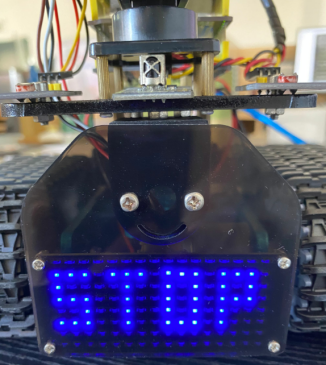
Project 10: Light Follow Robot
(1)Description
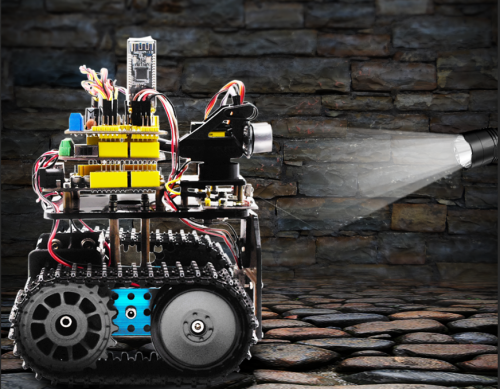
We’ve introduce how to use various sensors, modules.
In this lesson, we combine with hardware knowledge — photoresistor module, motor driving, to build a light-following robot!
Just need to use 2 photoresistor modules to detect the light intensity at the both side of robot. Read the analog value to rotate the 2 motors, thus drive the tank robot run.
The specific logic of light following robot is shown as the table below:
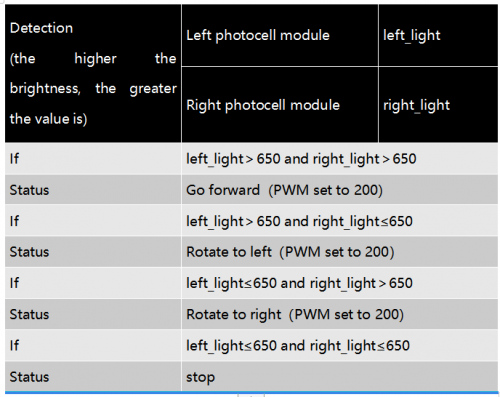
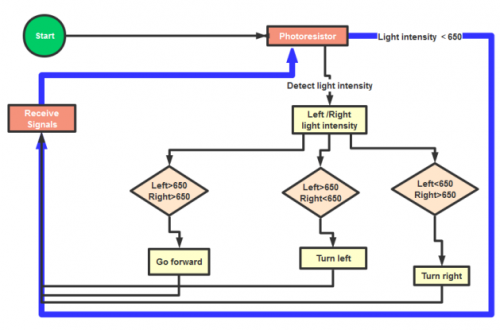
We make a flow chart based on the above logic table, as shown below:
(2)Connection Diagram
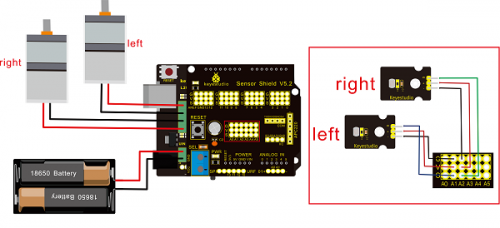
Hook-up Attention:
The 4Pin terminal block is marked with silkscreen 1234. The red line of right rear motor is connected to terminal 1, black line is linked with end 2. The red line of left front motor is attached to terminal 3, black line is linked with port 4.
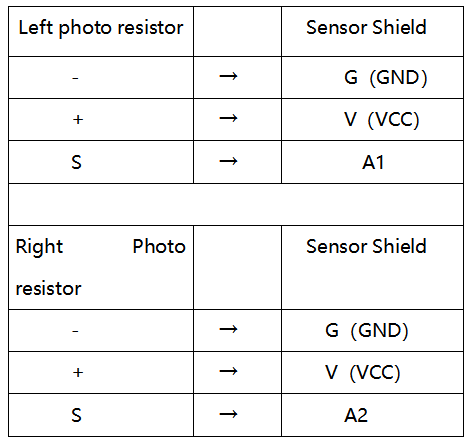
(3)Test Code
/*
keyestudio Mini Tank Robot v2.0
lesson 10
Light-following tank
http://www.keyestudio.com
*/
#define light_L_Pin A1 //define the pin of left photo resistor
#define light_R_Pin A2 //define the pin of right photo resistor
#define ML_Ctrl 13 //define the direction control pin of left motor
#define ML_PWM 11 //define the PWM control pin of left motor
#define MR_Ctrl 12 //define the direction control pin of right motor
#define MR_PWM 3 //define the PWM control pin of right motor
int left_light;
int right_light;
void setup(){
Serial.begin(9600);
pinMode(light_L_Pin, INPUT);
pinMode(light_R_Pin, INPUT);
pinMode(ML_Ctrl, OUTPUT);
pinMode(ML_PWM, OUTPUT);
pinMode(MR_Ctrl, OUTPUT);
pinMode(MR_PWM, OUTPUT);
}
void loop(){
left_light = analogRead(light_L_Pin);
right_light = analogRead(light_R_Pin);
Serial.print("left_light_value = ");
Serial.println(left_light);
Serial.print("right_light_value = ");
Serial.println(right_light);
if (left_light > 650 && right_light > 650) //the value detected photo resistor,go front
{
Car_front();
}
else if (left_light > 650 && right_light <= 650) //the value detected photo resistor,turn left
{
Car_left();
}
else if (left_light <= 650 && right_light > 650) //the value detected photo resistor,turn right
{
Car_right();
}
else //other situations, stop
{
Car_Stop();
}
}
void Car_front()
{
digitalWrite(MR_Ctrl,LOW);
analogWrite(MR_PWM,200);
digitalWrite(ML_Ctrl,LOW);
analogWrite(ML_PWM,200);
}
void Car_left()
{
digitalWrite(MR_Ctrl,LOW);
analogWrite(MR_PWM,200);
digitalWrite(ML_Ctrl,HIGH);
analogWrite(ML_PWM,200);
}
void Car_right()
{
digitalWrite(MR_Ctrl,HIGH);
analogWrite(MR_PWM,200);
digitalWrite(ML_Ctrl,LOW);
analogWrite(ML_PWM,200);
}
void Car_Stop()
{
digitalWrite(MR_Ctrl,LOW);
analogWrite(MR_PWM,0);
digitalWrite(ML_Ctrl,LOW);
analogWrite(ML_PWM,0);
}
//****************************************************************
(4)Test Result
Upload code on keyestudio V4.0 development board, DIP switch is dialed to right end and power on, the smart robot follows light to move.
Project 11: Ultrasonic Avoid Tank
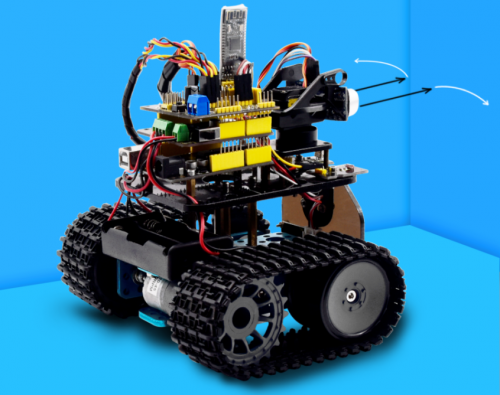
(1)Description
In this program, the ultrasonic sensor detects the distance of obstacle to send signals that control the robot car. Next, let’s show you how to make an obstacle avoidance car.
The specific logic of ultrasonic avoiding robot is as shown below:

(2)Flow chart
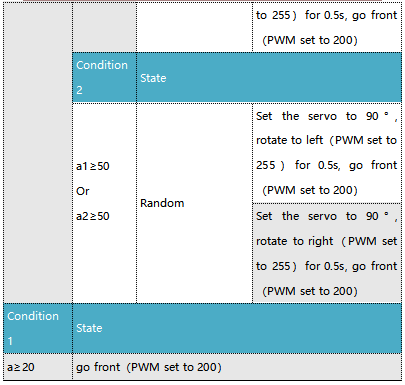
(3)Connection Diagram:
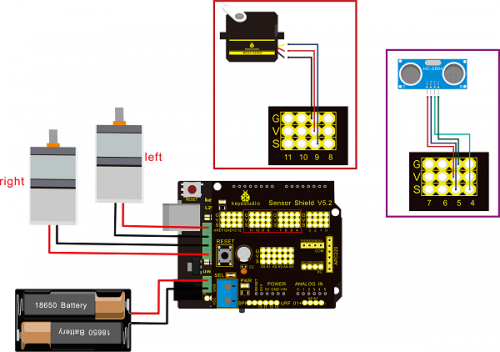
Note: “-”、“+” and “S” pins of servo are respectively attached to G(GND), V(VCC)and D9 of expansion board. The VCC, Trig, Echo and Gnd of ultrasonic sensor are linked with 5v(V), 5(S), Echo and Gnd(G) of expansion board.
(4)Test Code:
/*
keyestudio Mini Tank Robot v2.0
lesson 11
ultrasonic_avoid_tank
http://www.keyestudio.com
*/
int random2;
int a;
int a1;
int a2;
#define ML_Ctrl 13 //define the direction control pin of left motor
#define ML_PWM 11 //define PWM control pin of left motor
#define MR_Ctrl 12 //define the direction control pin of right motor
#define MR_PWM 3 //define PWM control pin of right motor
#define Trig 5 //ultrasonic trig Pin
#define Echo 4 //ultrasonic echo Pin
int distance;
#define servoPin 9 //servo Pin
int pulsewidth;
/************the function to run motor**************/
void Car_front()
{
digitalWrite(MR_Ctrl,LOW);
analogWrite(MR_PWM,200);
digitalWrite(ML_Ctrl,LOW);
analogWrite(ML_PWM,200);
}
void Car_back()
{
digitalWrite(MR_Ctrl,HIGH);
analogWrite(MR_PWM,200);
digitalWrite(ML_Ctrl,HIGH);
analogWrite(ML_PWM,200);
}
void Car_left()
{
digitalWrite(MR_Ctrl,LOW);
analogWrite(MR_PWM,255);
digitalWrite(ML_Ctrl,HIGH);
analogWrite(ML_PWM,255);
}
void Car_right()
{
digitalWrite(MR_Ctrl,HIGH);
analogWrite(MR_PWM,255);
digitalWrite(ML_Ctrl,LOW);
analogWrite(ML_PWM,255);
}
void Car_Stop()
{
digitalWrite(MR_Ctrl,LOW);
analogWrite(MR_PWM,0);
digitalWrite(ML_Ctrl,LOW);
analogWrite(ML_PWM,0);
}
//The function to control servo
void procedure(int myangle) {
for (int i = 0; i <= 50; i = i + (1)) {
pulsewidth = myangle * 11 + 500;
digitalWrite(servoPin,HIGH);
delayMicroseconds(pulsewidth);
digitalWrite(servoPin,LOW);
delay((20 - pulsewidth / 1000));
}
}
//The function to control ultrasonic sensor
float checkdistance() {
digitalWrite(Trig, LOW);
delayMicroseconds(2);
digitalWrite(Trig, HIGH);
delayMicroseconds(10);
digitalWrite(Trig, LOW);
float distance = pulseIn(Echo, HIGH) / 58.00; //58.20, that is, 2*29.1=58.2
delay(10);
return distance;
}
//****************************************************************
void setup(){
pinMode(servoPin, OUTPUT);
procedure(90); //set servo to 90°
pinMode(Trig, OUTPUT);
pinMode(Echo, INPUT);
pinMode(ML_Ctrl, OUTPUT);
pinMode(ML_PWM, OUTPUT);
pinMode(MR_Ctrl, OUTPUT);
pinMode(MR_PWM, OUTPUT);
}
void loop(){
random2 = random(1, 100);
a = checkdistance(); //assign the front distance detected by ultrasonic sensor to variable a
if (a < 20) //when the front distance detected is less than 20
{
Car_Stop(); //robot stops
delay(500); //delay in 500ms
procedure(160); //Ultrasonic platform turns left
for (int j = 1; j <= 10; j = j + (1)) { //for statement, the data will be more accurate if ultrasonic sensor detect a few times.
a1 = checkdistance(); //assign the left distance detected by ultrasonic sensor to variable a1
}
delay(300);
procedure(20); //Ultrasonic platform turns right
for (int k = 1; k <= 10; k = k + (1)) {
a2 = checkdistance(); //assign the right distance detected by ultrasonic sensor to variable a2
}
if (a1 < 50 || a2 < 50) //robot will turn to the longer distance side when left or right distance is less than 50cm.
{
if (a1 > a2) //left distance is greater than right side
{
procedure(90); //Ultrasonic platform turns back to right ahead
Car_left(); //robot turns left
delay(500); //turn left for 500ms
Car_front(); //go front
}
else
{
procedure(90);
Car_right(); //robot turns right
delay(500);
Car_front(); //go front
}
}
else //If both side is greater than or equal to 50cm, turn left or right randomly
{
if ((long) (random2) % (long) (2) == 0) //When the random number is even
{
procedure(90);
Car_left(); //tank robot turns left
delay(500);
Car_front(); //go front
}
else
{
procedure(90);
Car_right(); //robot turns right
delay(500);
Car_front(); //go front
}
}
}
else //If the front distance is greater than or equal to 20cm, robot car will go front
{
Car_front(); //go front
}
}
//****************************************************************
(5)Test Result
Upload code successfully, DIP switch is dialed to right end and power on, tank robot goes forward. It can automatically avoid barrier.
Project 12: Ultrasonic Follow Tank
(1)Description
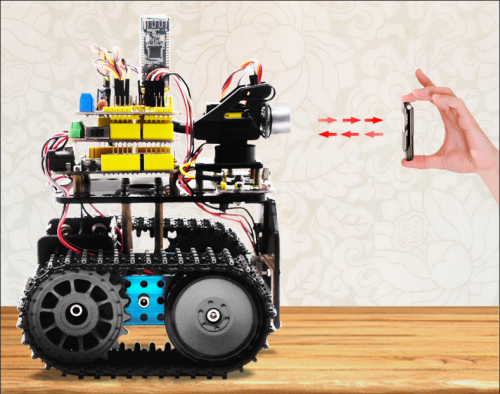
In project 11, we made an obstacle avoidance car. In fact, we only need to alter a test code to transform an obstacle avoidance car into following car. In this lesson, we will make an ultrasonic follow robot. The ultrasonic sensor detects the distance between smart car and the obstacle to drive tank car to move.
The specific logic of ultrasonic follow robot is as shown below:
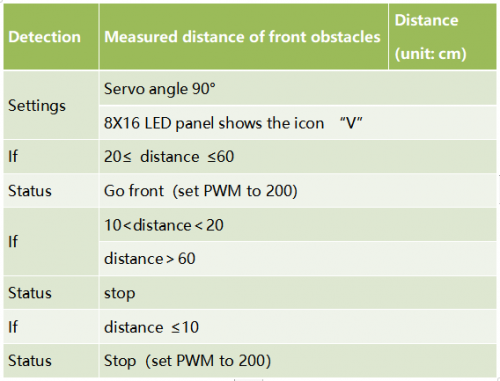
(2)Flow chart
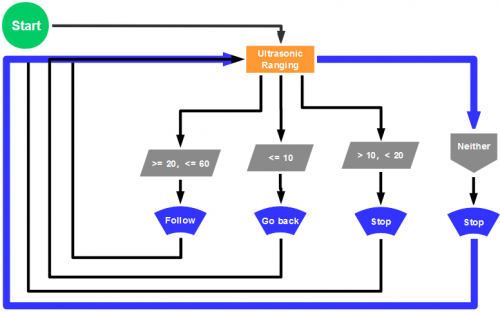
(3)Connection Diagram
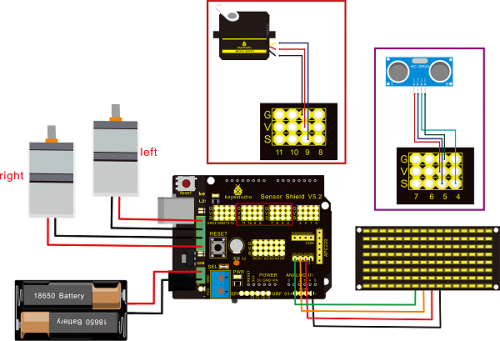
Wire-up note:
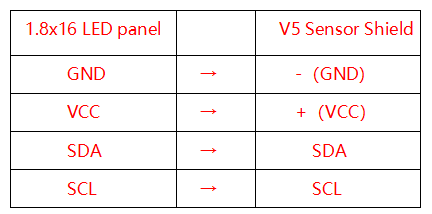
(4)Test Code
/*
keyestudio Mini Tank Robot v2.0
lesson 12
ultrasonic follow tank
http://www.keyestudio.com
*/
//Array, used to store the data of the pattern, can be calculated by yourself or obtained from the modulus tool
unsigned char start01[] = {0x01,0x02,0x04,0x08,0x10,0x20,0x40,0x80,0x80,0x40,0x20,0x10,0x08,0x04,0x02,0x01};
unsigned char front[] = {0x00,0x00,0x00,0x00,0x00,0x24,0x12,0x09,0x12,0x24,0x00,0x00,0x00,0x00,0x00,0x00};
unsigned char back[] = {0x00,0x00,0x00,0x00,0x00,0x24,0x48,0x90,0x48,0x24,0x00,0x00,0x00,0x00,0x00,0x00};
unsigned char left[] = {0x00,0x00,0x00,0x00,0x00,0x00,0x44,0x28,0x10,0x44,0x28,0x10,0x44,0x28,0x10,0x00};
unsigned char right[] = {0x00,0x10,0x28,0x44,0x10,0x28,0x44,0x10,0x28,0x44,0x00,0x00,0x00,0x00,0x00,0x00};
unsigned char STOP01[] = {0x2E,0x2A,0x3A,0x00,0x02,0x3E,0x02,0x00,0x3E,0x22,0x3E,0x00,0x3E,0x0A,0x0E,0x00};
unsigned char clear[] = {0x00,0x00,0x00,0x00,0x00,0x00,0x00,0x00,0x00,0x00,0x00,0x00,0x00,0x00,0x00,0x00};
#define SCL_Pin A5 //Set clock pin to A5
#define SDA_Pin A4 //Set data pin to A4
#define ML_Ctrl 13 //define the direction control pin of left motor
#define ML_PWM 11 //define PWM control pin of left motor
#define MR_Ctrl 12 //define the direction control pin of right motor
#define MR_PWM 3 //define PWM control pin of right motor
#define Trig 5 //ultrasonic trig Pin
#define Echo 4 //ultrasonic echo Pin
int distance;
int pulsewidth;
#define servoPin 9 //servo Pin
void setup(){
Serial.begin(9600);
pinMode(SCL_Pin,OUTPUT);
pinMode(SDA_Pin,OUTPUT);
matrix_display(clear); //Clear the display
matrix_display(start01); //display start pattern
pinMode(servoPin, OUTPUT);
procedure(90); //set servo to 90°
pinMode(Trig, OUTPUT);
pinMode(Echo, INPUT);
pinMode(ML_Ctrl, OUTPUT);
pinMode(ML_PWM, OUTPUT);
pinMode(MR_Ctrl, OUTPUT);
pinMode(MR_PWM, OUTPUT);
}
void loop(){
distance = checkdistance(); //assign the distance detected by ultrasonic sensor to distance
if (distance >= 20 && distance <= 60) //range to go front
{
Car_front();
}
else if (distance > 10 && distance < 20) //range to stop
{
Car_Stop();
}
else if (distance <= 10) //range to go back
{
Car_back();
}
else //other situations, stop
{
Car_Stop();
}
}
/***********the function for motor running****************/
void Car_front()
{
digitalWrite(MR_Ctrl,LOW);
analogWrite(MR_PWM,200);
digitalWrite(ML_Ctrl,LOW);
analogWrite(ML_PWM,200);
}
void Car_back()
{
digitalWrite(MR_Ctrl,HIGH);
analogWrite(MR_PWM,200);
digitalWrite(ML_Ctrl,HIGH);
analogWrite(ML_PWM,200);
}
void Car_left()
{
digitalWrite(MR_Ctrl,LOW);
analogWrite(MR_PWM,200);
digitalWrite(ML_Ctrl,HIGH);
analogWrite(ML_PWM,200);
}
void Car_right()
{
digitalWrite(MR_Ctrl,HIGH);
analogWrite(MR_PWM,200);
digitalWrite(ML_Ctrl,LOW);
analogWrite(ML_PWM,200);
}
void Car_Stop()
{
digitalWrite(MR_Ctrl,LOW);
analogWrite(MR_PWM,0);
digitalWrite(ML_Ctrl,LOW);
analogWrite(ML_PWM,0);
}
/******************dot matrix********************/
// the function for dot matrix display
void matrix_display(unsigned char matrix_value[])
{
IIC_start(); // call the function that data transmission start
IIC_send(0xc0); //Choose address
for(int i = 0;i < 16;i++) //pattern data has 16 bits
{
IIC_send(matrix_value[i]); //data to convey patterns
}
IIC_end(); //end to convey data pattern
IIC_start();
IIC_send(0x8A); //select pulse width4/16, control display
IIC_end();
}
//The condition starting to transmit data
void IIC_start()
{
digitalWrite(SCL_Pin,HIGH);
delayMicroseconds(3);
digitalWrite(SDA_Pin,HIGH);
delayMicroseconds(3);
digitalWrite(SDA_Pin,LOW);
delayMicroseconds(3);
}
// transmit data
void IIC_send(unsigned char send_data)
{
for(char i = 0;i < 8;i++) //Each byte has 8 bits
{
digitalWrite(SCL_Pin,LOW); //pull down clock pin SCL Pin to change the signals of SDA
delayMicroseconds(3);
if(send_data & 0x01) //set high and low level of SDA_Pin according to 1 or 0 of every bit
{
digitalWrite(SDA_Pin,HIGH);
}
else
{
digitalWrite(SDA_Pin,LOW);
}
delayMicroseconds(3);
digitalWrite(SCL_Pin,HIGH); //pull up clock pin SCL_Pin to stop transmitting data
delayMicroseconds(3);
send_data = send_data >> 1; // detect bit by bit, so move the data right by one
}
}
//The sign that data transmission ends
void IIC_end()
{
digitalWrite(SCL_Pin,LOW);
delayMicroseconds(3);
digitalWrite(SDA_Pin,LOW);
delayMicroseconds(3);
digitalWrite(SCL_Pin,HIGH);
delayMicroseconds(3);
digitalWrite(SDA_Pin,HIGH);
delayMicroseconds(3);
}
/***************end dot matrix display******************/
//The function to control servo
void procedure(int myangle) {
for (int i = 0; i <= 50; i = i + (1)) {
pulsewidth = myangle * 11 + 500;
digitalWrite(servoPin,HIGH);
delayMicroseconds(pulsewidth);
digitalWrite(servoPin,LOW);
delay((20 - pulsewidth / 1000));
}}
//The function to control ultrasonic sensor function controlling ultrasonic
float checkdistance() {
digitalWrite(Trig, LOW);
delayMicroseconds(2);
digitalWrite(Trig, HIGH);
delayMicroseconds(10);
digitalWrite(Trig, LOW);
float distance = pulseIn(Echo, HIGH) / 58.20; //58.20, that is , 2*29.1=58.2
delay(10);
return distance;
}
//****************************************************************
(5)Test Result
Upload code successfully, DIP switch is dialed to right end, the servo rotates to 90°, “V” is shown on 8X16 LED panel and smart car moves as the obstacle moves.
Project 13: IR Remote Robot Tank
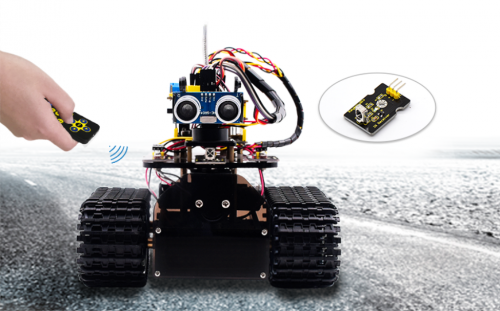
(1)Description
IR remote control is one of most ubiquitous control, applied in TV, electric fan and some household appliances. In this project, we will make an IR remote smart car. And we’ve known every key value on IR remote control. Thus, we could control smart car via and display the patterns on dot matrix via corresponding key value
The specific logic of infrared remote control robot is shown below:
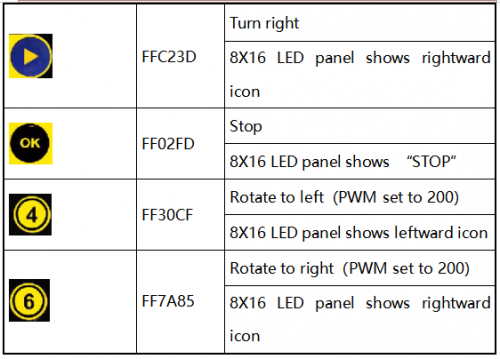
(2)Flow Chart
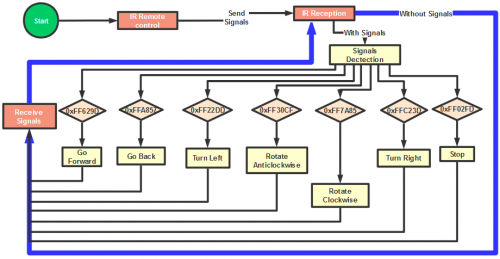
(3)Connection Diagram
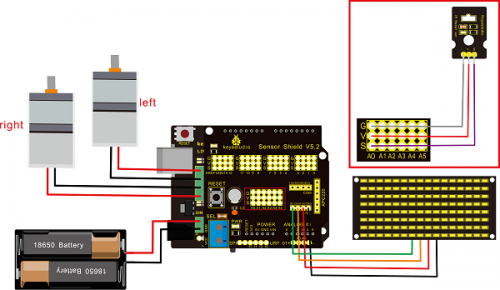
Attention:GND,VCC, SDA, SCL of 8×16 LED panel are respectively linked with -(GND), +(VCC), SDA ,SCL. And “-”、“+” and S of IR receiver module are attached to G(GND), V(VCC) and A0 on sensor shield. On the condition of insufficient digital ports, the analog ports can be treat as digital ports. A0 equals to digital 14, A1 is like digital 15.
(4)Test Code
/*
keyestudio Mini Tank Robot v2.0
lesson 13
IR remote tank
http://www.keyestudio.com
*/
#include <IRremoteTank.h>
IRrecv irrecv(A0); //set IRrecv irrecv to A0
decode_results results;
long ir_rec; //save the IR value received
//Array, used to store the data of the pattern, can be calculated by yourself or obtained from the modulus tool
unsigned char start01[] = {0x01,0x02,0x04,0x08,0x10,0x20,0x40,0x80,0x80,0x40,0x20,0x10,0x08,0x04,0x02,0x01};
unsigned char front[] = {0x00,0x00,0x00,0x00,0x00,0x24,0x12,0x09,0x12,0x24,0x00,0x00,0x00,0x00,0x00,0x00};
unsigned char back[] = {0x00,0x00,0x00,0x00,0x00,0x24,0x48,0x90,0x48,0x24,0x00,0x00,0x00,0x00,0x00,0x00};
unsigned char left[] = {0x00,0x00,0x00,0x00,0x00,0x00,0x44,0x28,0x10,0x44,0x28,0x10,0x44,0x28,0x10,0x00};
unsigned char right[] = {0x00,0x10,0x28,0x44,0x10,0x28,0x44,0x10,0x28,0x44,0x00,0x00,0x00,0x00,0x00,0x00};
unsigned char STOP01[] = {0x2E,0x2A,0x3A,0x00,0x02,0x3E,0x02,0x00,0x3E,0x22,0x3E,0x00,0x3E,0x0A,0x0E,0x00};
unsigned char clear[] = {0x00,0x00,0x00,0x00,0x00,0x00,0x00,0x00,0x00,0x00,0x00,0x00,0x00,0x00,0x00,0x00};
#define SCL_Pin A5 //Set clock pin to A5
#define SDA_Pin A4 //Set data pin to A4
#define ML_Ctrl 13 //define the direction control pin of left motor
#define ML_PWM 11 //define PWM control pin of left motor
#define MR_Ctrl 12 //define the direction control pin of right motor
#define MR_PWM 3 //define PWM control pin of right motor
#define servoPin 9 //pin of servo
int pulsewidth; //save the pulse width value of servo
void setup(){
Serial.begin(9600);
irrecv.enableIRIn(); //Initialize the IR reception library
pinMode(ML_Ctrl, OUTPUT);
pinMode(ML_PWM, OUTPUT);
pinMode(MR_Ctrl, OUTPUT);
pinMode(MR_PWM, OUTPUT);
pinMode(SCL_Pin,OUTPUT);
pinMode(SDA_Pin,OUTPUT);
matrix_display(clear); //Clear Screen
matrix_display(start01); //show start picture
pinMode(servoPin, OUTPUT);
procedure(90); //Servo rotates to 90°
}
void loop(){
if (irrecv.decode(&results)) //receive the IR remote value
{
ir_rec=results.value;
String type="UNKNOWN";
String typelist[14]={"UNKNOWN", "NEC", "SONY", "RC5", "RC6", "DISH", "SHARP", "PANASONIC", "JVC", "SANYO", "MITSUBISHI", "SAMSUNG", "LG", "WHYNTER"};
if(results.decode_type>=1&&results.decode_type<=13){
type=typelist[results.decode_type];
}
Serial.print("IR TYPE:"+type+" ");
Serial.println(ir_rec,HEX);
irrecv.resume();
}
if (ir_rec == 0xFF629D) //Go forward
{
Car_front();
matrix_display(front); //Display front image
}
if (ir_rec == 0xFFA857) //Robot car goes back
{
Car_back();
matrix_display(front); //Go back
}
if (ir_rec == 0xFF22DD) //Robot car turns left
{
Car_T_left();
matrix_display(left); //Display left-turning image
}
if (ir_rec == 0xFFC23D) //Robot car turns right
{
Car_T_right();
matrix_display(right); //Display right-turning image
}
if (ir_rec == 0xFF02FD) //Robot car stops
{
Car_Stop();
matrix_display(STOP01); //show stop image
}
if (ir_rec == 0xFF30CF) //robot car rotates anticlockwise
{
Car_left();
matrix_display(left); //show anticlockwise rotation picture
}
if (ir_rec == 0xFF7A85) //robot car rotates clockwise
{
Car_right();
matrix_display(right); //show clockwise rotation picture
}
}
/******************Control Servo*******************/
void procedure(int myangle) {
for (int i = 0; i <= 50; i = i + (1)) {
pulsewidth = myangle * 11 + 500;
digitalWrite(servoPin,HIGH);
delayMicroseconds(pulsewidth);
digitalWrite(servoPin,LOW);
delay((20 - pulsewidth / 1000));
}
}
/******************Dot Matrix****************/
// this function is used for dot matrix display
void matrix_display(unsigned char matrix_value[])
{
IIC_start();
IIC_send(0xc0); //Choose address
for(int i = 0;i < 16;i++) //The picture has 16 bits
{
IIC_send(matrix_value[i]); //data to convey patterns
}
IIC_end(); //end to convey data pattern
IIC_start();
IIC_send(0x8A); //display control, set pulse width to 4/16
IIC_end();
}
//The condition starting to transmit data
void IIC_start()
{
digitalWrite(SCL_Pin,HIGH);
delayMicroseconds(3);
digitalWrite(SDA_Pin,HIGH);
delayMicroseconds(3);
digitalWrite(SDA_Pin,LOW);
delayMicroseconds(3);
}
//传输数据
void IIC_send(unsigned char send_data)
{
for(char i = 0;i < 8;i++) //Each byte has 8 bits 8bits for every character
{
digitalWrite(SCL_Pin,LOW); //pull down clock pin SCL Pin to change the signals of SDA
delayMicroseconds(3);
if(send_data & 0x01) //set high and low level of SDA_Pin according to 1 or 0 of every bit
{
digitalWrite(SDA_Pin,HIGH);
}
else
{
digitalWrite(SDA_Pin,LOW);
}
delayMicroseconds(3);
digitalWrite(SCL_Pin,HIGH); //pull up clock pin SCL_Pin to stop transmitting data
delayMicroseconds(3);
send_data = send_data >> 1; // detect bit by bit, so move the data right by one
}
}
//The sign that data transmission ends
void IIC_end()
{
digitalWrite(SCL_Pin,LOW);
delayMicroseconds(3);
digitalWrite(SDA_Pin,LOW);
delayMicroseconds(3);
digitalWrite(SCL_Pin,HIGH);
delayMicroseconds(3);
digitalWrite(SDA_Pin,HIGH);
delayMicroseconds(3);
}
/***************the function to run motor***************/
void Car_front()
{
digitalWrite(MR_Ctrl,LOW);
analogWrite(MR_PWM,200);
digitalWrite(ML_Ctrl,LOW);
analogWrite(ML_PWM,200);
}
void Car_back()
{
digitalWrite(MR_Ctrl,HIGH);
analogWrite(MR_PWM,200);
digitalWrite(ML_Ctrl,HIGH);
analogWrite(ML_PWM,200);
}
void Car_left()
{
digitalWrite(MR_Ctrl,LOW);
analogWrite(MR_PWM,255);
digitalWrite(ML_Ctrl,HIGH);
analogWrite(ML_PWM,255);
}
void Car_right()
{
digitalWrite(MR_Ctrl,HIGH);
analogWrite(MR_PWM,255);
digitalWrite(ML_Ctrl,LOW);
analogWrite(ML_PWM,255);
}
void Car_Stop()
{
digitalWrite(MR_Ctrl,LOW);
analogWrite(MR_PWM,0);
digitalWrite(ML_Ctrl,LOW);
analogWrite(ML_PWM,0);
}
void Car_T_left()
{
digitalWrite(MR_Ctrl,LOW);
analogWrite(MR_PWM,255);
digitalWrite(ML_Ctrl,LOW);
analogWrite(ML_PWM,180);
}
void Car_T_right()
{
digitalWrite(MR_Ctrl,LOW);
analogWrite(MR_PWM,180);
digitalWrite(ML_Ctrl,LOW);
analogWrite(ML_PWM,255);
}
//****************************************************************
(5)Test Result
Upload code successfully and power on, the smart robot can be controlled by IR remote, at same time, the corresponding pattern is shown on 8X16 LED panel.
Project 14: Bluetooth Control Robot
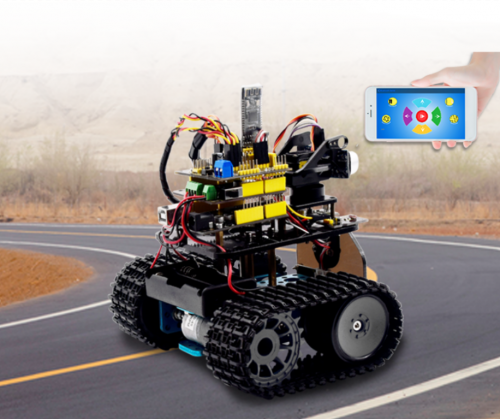
(1)Description
We’ve learned the basic knowledge of Bluetooth, in this lesson, we will make a Bluetooth remote smart car. In the experiment, we default the HM-10 Bluetooth module as a Slave and the cellphone as a Host.
keyes BT car is an APP rolled out by keyestudio team. You could control the robot car by it readily.
There is a guide to how to download and install APP in the document as for your reference. The interface is shown below.
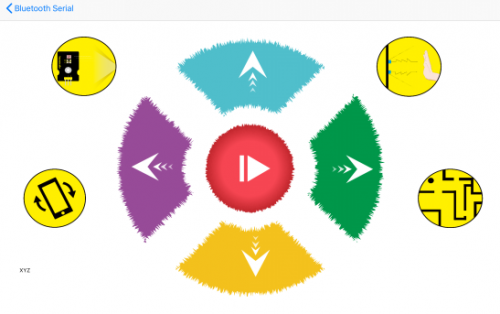
(2)Test Code
/*
keyestudio Mini Tank Robot v2.0
lesson 14.1
bluetooth test
http://www.keyestudio.com
*/
char ble_val; //character variables, used to save the value of Bluetooth reception
void setup() {
Serial.begin(9600);
}
void loop() {
if(Serial.available() > 0) //judge if there is data in buffer area
{ ble_val = Serial.read(); //read the data from serial buffer
Serial.println(ble_val); //print out
}}
Pull off the Bluetooth module, upload test code, reconnect Bluetooth module, open serial monitor and set baud rate to 9600. Point at Bluetooth module and press keys on APP, the corresponding character is shown below.
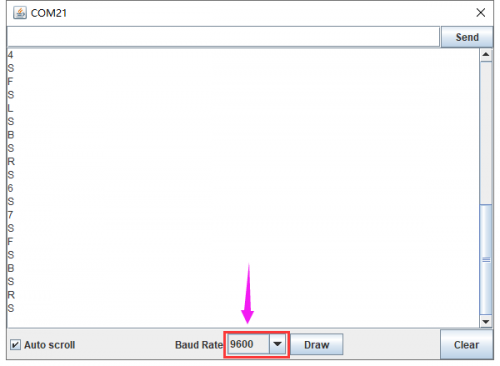
The detected character and corresponding function:
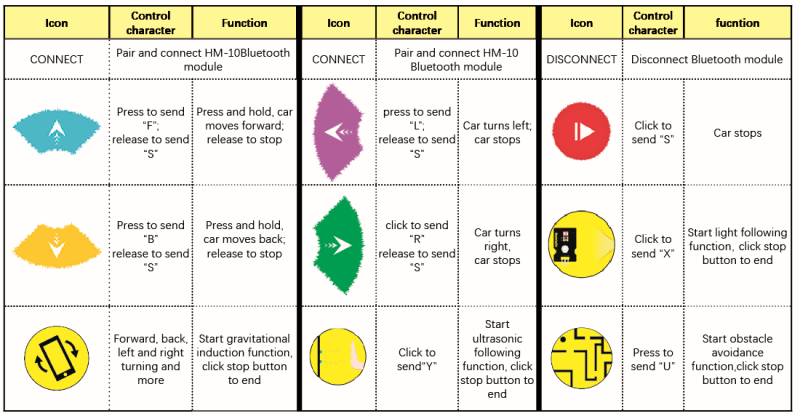
In compliance with the above table, we make a flow chart to assist you to understand well. The flow chart is below:
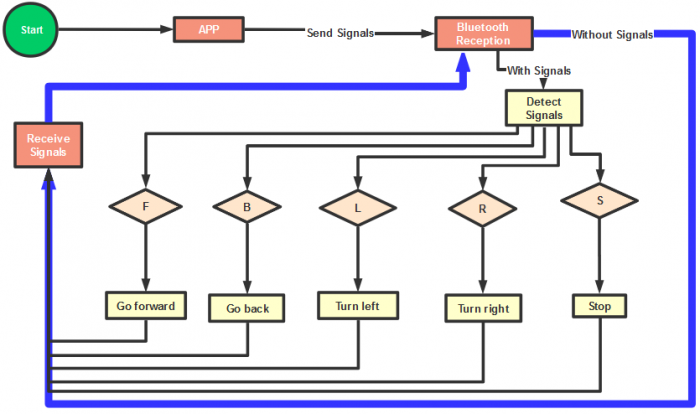
(3)Connection Diagram
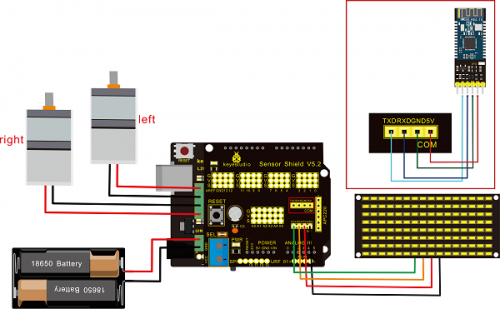
Wiring Attention:
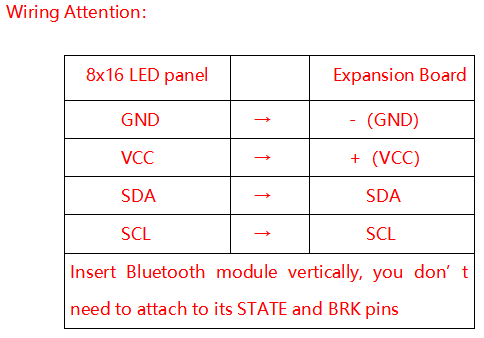
(4)Test Code
Note: Remove the Bluetooth module before uploading test code, otherwise, you will fail to upload test code
/*
keyestudio Robot Car v2.0
lesson 14.2
bluetooth car
http://www.keyestudio.com
*/
//Array, used to store the data of pattern, can be calculated by yourself or obtained from the modulus tool
unsigned char start01[] = {0x01,0x02,0x04,0x08,0x10,0x20,0x40,0x80,0x80,0x40,0x20,0x10,0x08,0x04,0x02,0x01};
unsigned char front[] = {0x00,0x00,0x00,0x00,0x00,0x24,0x12,0x09,0x12,0x24,0x00,0x00,0x00,0x00,0x00,0x00};
unsigned char back[] = {0x00,0x00,0x00,0x00,0x00,0x24,0x48,0x90,0x48,0x24,0x00,0x00,0x00,0x00,0x00,0x00};
unsigned char left[] = {0x00,0x00,0x00,0x00,0x00,0x00,0x44,0x28,0x10,0x44,0x28,0x10,0x44,0x28,0x10,0x00};
unsigned char right[] = {0x00,0x10,0x28,0x44,0x10,0x28,0x44,0x10,0x28,0x44,0x00,0x00,0x00,0x00,0x00,0x00};
unsigned char STOP01[] = {0x2E,0x2A,0x3A,0x00,0x02,0x3E,0x02,0x00,0x3E,0x22,0x3E,0x00,0x3E,0x0A,0x0E,0x00};
unsigned char clear[] = {0x00,0x00,0x00,0x00,0x00,0x00,0x00,0x00,0x00,0x00,0x00,0x00,0x00,0x00,0x00,0x00};
#define SCL_Pin A5 //Set clock pin to A5
#define SDA_Pin A4 //Set data pin to A4
#define ML_Ctrl 13 //define direction control pin of left motor
#define ML_PWM 11 //define PWM control pin of left motor
#define MR_Ctrl 12 //define direction control pin of right motor
#define MR_PWM 3 //define PWM control pin of right motor
char bluetooth_val; //save the value of Bluetooth reception
void setup(){
Serial.begin(9600);
pinMode(SCL_Pin,OUTPUT);
pinMode(SDA_Pin,OUTPUT);
matrix_display(clear); //Clear the display
matrix_display(start01); //display start pattern
pinMode(ML_Ctrl, OUTPUT);
pinMode(ML_PWM, OUTPUT);
pinMode(MR_Ctrl, OUTPUT);
pinMode(MR_PWM, OUTPUT);
}
void loop(){
if (Serial.available())
{
bluetooth_val = Serial.read();
Serial.println(bluetooth_val);
}
switch (bluetooth_val)
{
case 'F': //forward command
Car_front();
matrix_display(front); // show forward design
break;
case 'B': //Back command
Car_back();
matrix_display(back); //show back pattern
break;
case 'L': // left-turning instruction
Car_left();
matrix_display(left); //show “left-turning” sign
break;
case 'R': //right-turning instruction
Car_right();
matrix_display(right); //display right-turning sign
break;
case 'S': //stop command
Car_Stop();
matrix_display(STOP01); //show stop picture
break;
}
}
/**************The function of dot matrix****************/
//this function is used for dot matrix display
void matrix_display(unsigned char matrix_value[])
{
IIC_start();
IIC_send(0xc0); //Choose address
for(int i = 0;i < 16;i++) //pattern data has 16 bits
{
IIC_send(matrix_value[i]); //data to convey patterns
}
IIC_end(); //end to convey data pattern
IIC_start();
IIC_send(0x8A); //display control, set pulse width to 4/16
IIC_end();
}
//The condition starting to transmit data
void IIC_start()
{
digitalWrite(SCL_Pin,HIGH);
delayMicroseconds(3);
digitalWrite(SDA_Pin,HIGH);
delayMicroseconds(3);
digitalWrite(SDA_Pin,LOW);
delayMicroseconds(3);
}
//transmit data
void IIC_send(unsigned char send_data)
{
for(char i = 0;i < 8;i++) //Each byte has 8 bits
{
digitalWrite(SCL_Pin,LOW); //pull down clock pin SCL Pin to change the signals of SDA
delayMicroseconds(3);
if(send_data & 0x01) //set high and low level of SDA_Pin according to 1 or 0 of every bit
{
digitalWrite(SDA_Pin,HIGH);
}
else
{
digitalWrite(SDA_Pin,LOW);
}
delayMicroseconds(3);
digitalWrite(SCL_Pin,HIGH); //pull up clock pin SCL_Pin to stop transmitting data
delayMicroseconds(3);
send_data = send_data >> 1; // Detect bit by bit, so move the data right by one
}
}
//The sign that data transmission ends
void IIC_end()
{
digitalWrite(SCL_Pin,LOW);
delayMicroseconds(3);
digitalWrite(SDA_Pin,LOW);
delayMicroseconds(3);
digitalWrite(SCL_Pin,HIGH);
delayMicroseconds(3);
digitalWrite(SDA_Pin,HIGH);
delayMicroseconds(3);
}
/*************the function to run motor**************/
void Car_front()
{
digitalWrite(MR_Ctrl,LOW);
analogWrite(MR_PWM,200);
digitalWrite(ML_Ctrl,LOW);
analogWrite(ML_PWM,200);
}
void Car_back()
{
digitalWrite(MR_Ctrl,HIGH);
analogWrite(MR_PWM,200);
digitalWrite(ML_Ctrl,HIGH);
analogWrite(ML_PWM,200);
}
void Car_left()
{
digitalWrite(MR_Ctrl,LOW);
analogWrite(MR_PWM,255);
digitalWrite(ML_Ctrl,HIGH);
analogWrite(ML_PWM,255);
}
void Car_right()
{
digitalWrite(MR_Ctrl,HIGH);
analogWrite(MR_PWM,255);
digitalWrite(ML_Ctrl,LOW);
analogWrite(ML_PWM,255);
}
void Car_Stop()
{
digitalWrite(MR_Ctrl,LOW);
analogWrite(MR_PWM,0);
digitalWrite(ML_Ctrl,LOW);
analogWrite(ML_PWM,0);
}
void Car_T_left()
{
digitalWrite(MR_Ctrl,LOW);
analogWrite(MR_PWM,255);
digitalWrite(ML_Ctrl,LOW);
analogWrite(ML_PWM,180);
}
void Car_T_right()
{
digitalWrite(MR_Ctrl,LOW);
analogWrite(MR_PWM,180);
digitalWrite(ML_Ctrl,LOW);
analogWrite(ML_PWM,255);
}
//****************************************************************
(5)Test Result
Upload code successfully, DIP switch is dialed to right end and power on. After connecting Bluetooth, we could drive smart car to move by Bluetooth App.
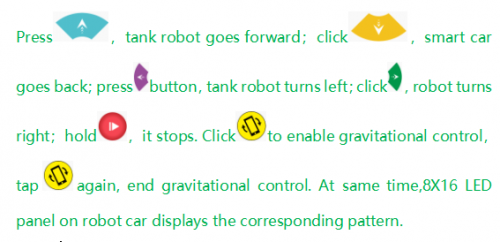
Project 15: Multi-purpose Robot Car
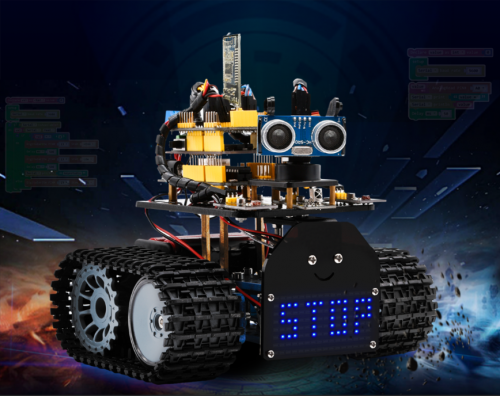
(1)Description
In previous projects, the tank car only performs single function, however, in this lesson, we integrate all of function to control smart car via Bluetooth control.
Here is a simple flow chart of multi-purpose robot car as for your reference.
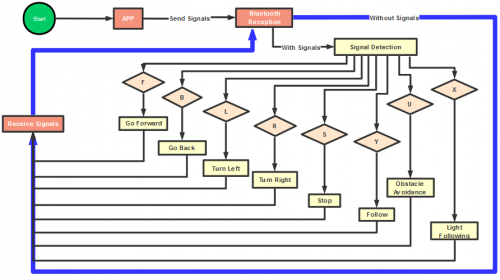
(2)Connection Diagram
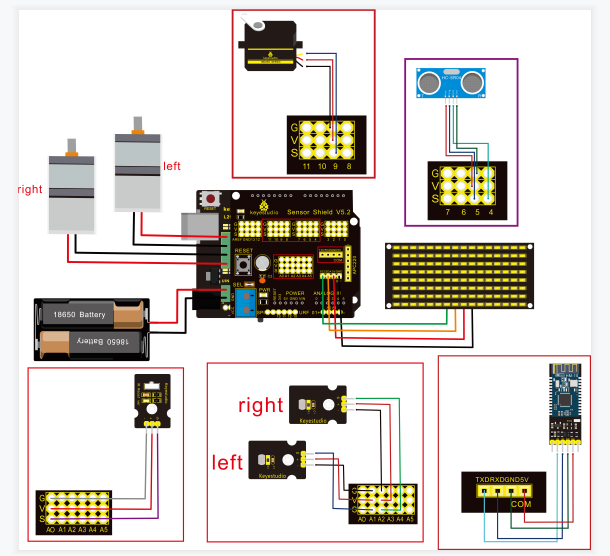
Attention:Confirm that every component is connected.
Wire-up Guide:
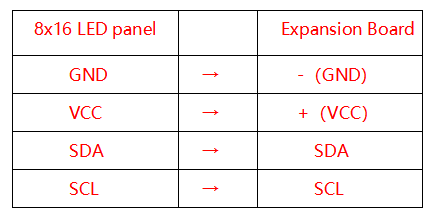
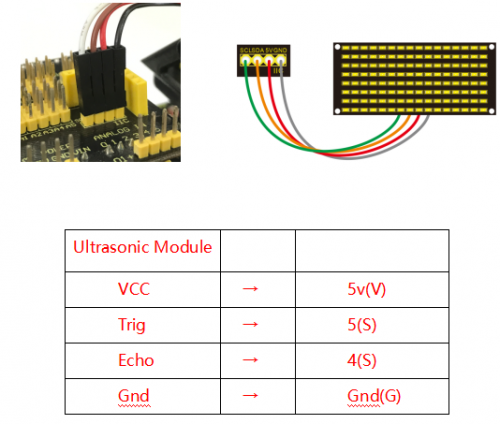
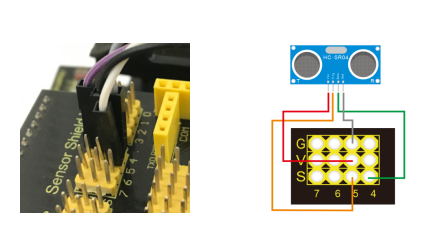
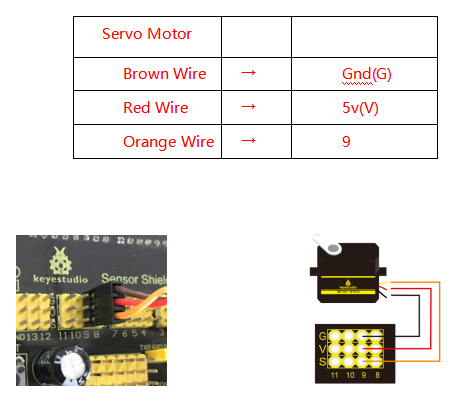
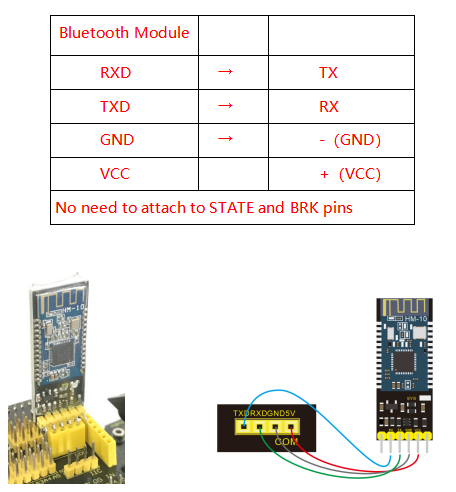
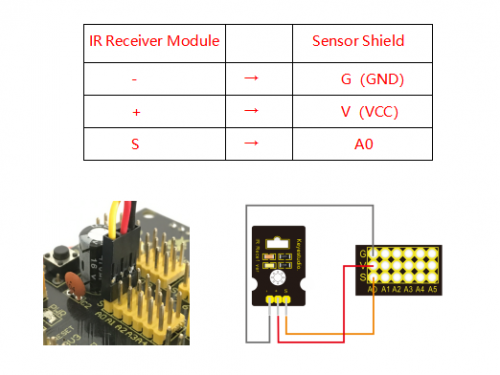
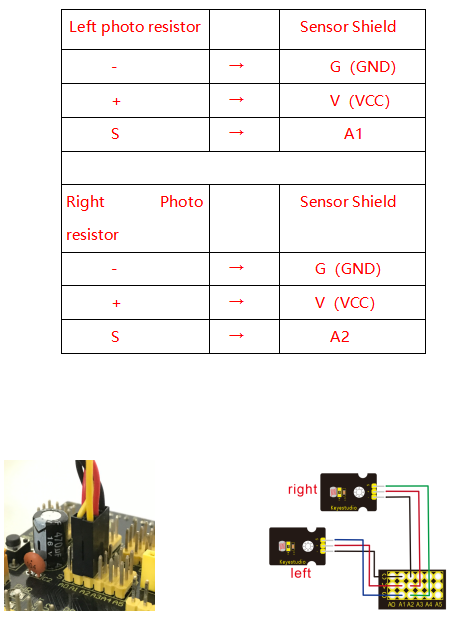
(3)Test Code
/*
keyestudio Mini Tank Robot v2.0
lesson 15
multiple functions
http://www.keyestudio.com
*/
//Array, used to store the data of the pattern, can be calculated by yourself or obtained from the modulus tool
unsigned char start01[] = {0x01,0x02,0x04,0x08,0x10,0x20,0x40,0x80,0x80,0x40,0x20,0x10,0x08,0x04,0x02,0x01};
unsigned char front[] = {0x00,0x00,0x00,0x00,0x00,0x24,0x12,0x09,0x12,0x24,0x00,0x00,0x00,0x00,0x00,0x00};
unsigned char back[] = {0x00,0x00,0x00,0x00,0x00,0x24,0x48,0x90,0x48,0x24,0x00,0x00,0x00,0x00,0x00,0x00};
unsigned char left[] = {0x00,0x00,0x00,0x00,0x00,0x00,0x44,0x28,0x10,0x44,0x28,0x10,0x44,0x28,0x10,0x00};
unsigned char right[] = {0x00,0x10,0x28,0x44,0x10,0x28,0x44,0x10,0x28,0x44,0x00,0x00,0x00,0x00,0x00,0x00};
unsigned char STOP01[] = {0x2E,0x2A,0x3A,0x00,0x02,0x3E,0x02,0x00,0x3E,0x22,0x3E,0x00,0x3E,0x0A,0x0E,0x00};
unsigned char clear[] = {0x00,0x00,0x00,0x00,0x00,0x00,0x00,0x00,0x00,0x00,0x00,0x00,0x00,0x00,0x00,0x00};
#define SCL_Pin A5 //Set clock pin to A5
#define SDA_Pin A4 //Set data pin to A4
#define ML_Ctrl 13 //define direction control pin of left motor
#define ML_PWM 11 //define PWM control pin of left motor
#define MR_Ctrl 12 //define direction control pin of right motor
#define MR_PWM 3 //define PWM control pin of right motor
#define Trig 5 //ultrasonic trig Pin
#define Echo 4 //ultrasonic echo Pin
int distance; //save the distance value detected by ultrasonic, follow function
int random2; //save the variable of random numberssave the variable of random numbers
//save the distance value detected by ultrasonic, obstacle avoidance function
int a;
int a1;
int a2;
#define servoPin 9 //servo Pin
int pulsewidth;
#define light_L_Pin A1 //define the pin of left photo resistor sensor
#define light_R_Pin A2 //define the pin of right photo resistor sensor
int left_light;
int right_light;
char bluetooth_val; //save the value of Bluetooth reception
int flag; //flag variable, it is used to entry and exist function
void setup(){
Serial.begin(9600);
pinMode(Trig, OUTPUT);
pinMode(Echo, INPUT);
pinMode(ML_Ctrl, OUTPUT);
pinMode(ML_PWM, OUTPUT);
pinMode(MR_Ctrl, OUTPUT);
pinMode(MR_PWM, OUTPUT);
pinMode(servoPin, OUTPUT);
procedure(90); //set servo to 90°
pinMode(SCL_Pin,OUTPUT);
pinMode(SDA_Pin,OUTPUT);
matrix_display(clear); //Clear the display
matrix_display(start01); //display start pattern
pinMode(light_L_Pin, INPUT);
pinMode(light_R_Pin, INPUT);
}
void loop(){
if (Serial.available())
{
bluetooth_val = Serial.read();
Serial.println(bluetooth_val);
}
switch (bluetooth_val)
{
case 'F': //Forward instruction
Car_front();
matrix_display(front); //display forward pattern
break;
case 'B': //Back instruction
Car_back();
matrix_display(back); // display back pattern
break;
case 'L': //left-turning instruction
Car_left();
matrix_display(left); //show left-turning pattern
break;
case 'R': //right-turning instruction
Car_right();
matrix_display(right); //show right-turning pattern
break;
case 'S': //stop instruction
Car_Stop();
matrix_display(STOP01); //display stop pattern
break;
case 'Y':
matrix_display(start01); //show start pattern
follow();
break;
case 'U':
matrix_display(start01); //show start pattern
avoid();
break;
case 'X':
matrix_display(start01); //show start pattern
light_track();
break;
}}
/*****************Obstacle Avoidance Function**************/
void avoid()
{
flag = 0; //the design that enter obstacle avoidance function
while (flag == 0)
{
random2 = random(1, 100);
a = checkdistance(); //assign the front distance detected by ultrasonic sensor to variable a
if (a < 20) //when the front distance detected is less than 20cm
{
Car_Stop(); //robot stops
delay(200); //delay in 200ms
procedure(160); //Ultrasonic platform turns left
for (int j = 1; j <= 10; j = j + (1)) { ///for statement, the data will be more accurate if ultrasonic sensor detect a few times.
a1 = checkdistance(); //assign the left distance detected by ultrasonic sensor to variable a1
}
delay(200);
procedure(20); //Ultrasonic platform turns right
for (int k = 1; k <= 10; k = k + (1)) {
a2 = checkdistance(); //assign the right distance detected by ultrasonic sensor to variable a2
}
if (a1 < 50 || a2 < 50) //robot will turn to the longer distance side when left or right distance is less than 50cm.if the left or right distance is less than 50cm, the robot will turn to the greater distance
{
if (a1 > a2) //left distance is greater than right
{
procedure(90); //Ultrasonic platform turns back to right ahead ultrasonic platform turns front
Car_left(); //robot turns left
delay(500); //turn left 500ms
Car_front(); //go forward
}
else
{
procedure(90);
Car_right(); //robot turns right
delay(500);
Car_front(); //go forward
}
}
else //both distance on two side is greater than or equal to 50cm, turn randomly
{
if ((long) (random2) % (long) (2) == 0) //when the random number is even
{
procedure(90);
Car_left(); //robot turns left
delay(500);
Car_front(); //go forward
}
else
{
procedure(90);
Car_right(); //robot turns right
delay(500);
Car_front(); ///go forward
} } }
else //If the front distance is greater than or equal to 20cm, robot car will go front
{
Car_front(); //go forward
}
// receive the Bluetooth value to end the obstacle avoidance function
if (Serial.available())
{
bluetooth_val = Serial.read();
if (bluetooth_val == 'S') //receive S
{
flag = 1; //when assign 1 to flag, end loop
}}}}
/*******************Follow****************/
void follow() {
flag = 0;
while (flag == 0) {
distance = checkdistance(); //assign the distance detected by ultrasonic sensor to distance
if (distance >= 20 && distance <= 60) //the range to go front
{
Car_front();
}
else if (distance > 10 && distance < 20) //the range to stop
{
Car_Stop();
}
else if (distance <= 10) // the range to go back
{
Car_back();
}
else //other situations, stop
{
Car_Stop();
}
if (Serial.available())
{
bluetooth_val = Serial.read();
if (bluetooth_val == 'S')
{
flag = 1; //end loop
}}}}
//The function to control ultrasonic sensor the function controlling ultrasonic sensor
float checkdistance() {
digitalWrite(Trig, LOW);
delayMicroseconds(2);
digitalWrite(Trig, HIGH);
delayMicroseconds(10);
digitalWrite(Trig, LOW);
float distance = pulseIn(Echo, HIGH) / 58.00; //58.20 means 2*29.1=58.2
delay(10);
return distance;
}
//The function to control servo the function controlling servo
void procedure(int myangle) {
for (int i = 0; i <= 50; i = i + (1)) {
pulsewidth = myangle * 11 + 500;
digitalWrite(servoPin,HIGH);
delayMicroseconds(pulsewidth);
digitalWrite(servoPin,LOW);
delay((20 - pulsewidth / 1000));
}}
/****************Light Follow******************/
void light_track() {
flag = 0;
while (flag == 0) {
left_light = analogRead(light_L_Pin);
right_light = analogRead(light_R_Pin);
if (left_light > 650 && right_light > 650) //the value detected by photo resistor, go forward
{
Car_front();
}
else if (left_light > 650 && right_light <= 650) //the value detected by photo resistor, turn left
{
Car_left();
}
else if (left_light <= 650 && right_light > 650) //the value detected by photo resistor, turn right
{
Car_right();
}
else //other situations, stop
{
Car_Stop();
}
if (Serial.available())
{
bluetooth_val = Serial.read();
if (bluetooth_val == 'S') {
flag = 1;
}}}}
/***************Dot Matrix *****************/
// this function is used for dot matrix display
void matrix_display(unsigned char matrix_value[])
{
IIC_start();
IIC_send(0xc0); //Choose address
for(int i = 0;i < 16;i++) //pattern data has 16 bits
{
IIC_send(matrix_value[i]); //convey the pattern data
}
IIC_end(); //end the transmission of pattern data
IIC_start();
IIC_send(0x8A); //display control, set pulse width to 4/16
IIC_end();
}
//The condition starting to transmit data
void IIC_start()
{
digitalWrite(SCL_Pin,HIGH);
delayMicroseconds(3);
digitalWrite(SDA_Pin,HIGH);
delayMicroseconds(3);
digitalWrite(SDA_Pin,LOW);
delayMicroseconds(3);
}
//convey data
void IIC_send(unsigned char send_data)
{
for(char i = 0;i < 8;i++) //each byte has 8 bits
{
digitalWrite(SCL_Pin,LOW); //pull down clock pin SCL Pin to change the signals of SDA
delayMicroseconds(3);
if(send_data & 0x01) //set high and low level of SDA_Pin according to 1 or 0 of every bit
{
digitalWrite(SDA_Pin,HIGH);
}
else
{
digitalWrite(SDA_Pin,LOW);
}
delayMicroseconds(3);
digitalWrite(SCL_Pin,HIGH); //pull up clock pin SCL_Pin to stop transmitting data
delayMicroseconds(3);
send_data = send_data >> 1; // detect bit by bit, so move the data right by one
}}
//The sign that data transmission ends
void IIC_end()
{
digitalWrite(SCL_Pin,LOW);
delayMicroseconds(3);
digitalWrite(SDA_Pin,LOW);
delayMicroseconds(3);
digitalWrite(SCL_Pin,HIGH);
delayMicroseconds(3);
digitalWrite(SDA_Pin,HIGH);
delayMicroseconds(3);
}
/*************the function to run motor*************/
void Car_front()
{
digitalWrite(MR_Ctrl,LOW);
analogWrite(MR_PWM,200);
digitalWrite(ML_Ctrl,LOW);
analogWrite(ML_PWM,200);
}
void Car_back()
{
digitalWrite(MR_Ctrl,HIGH);
analogWrite(MR_PWM,200);
digitalWrite(ML_Ctrl,HIGH);
analogWrite(ML_PWM,200);
}
void Car_left()
{
digitalWrite(MR_Ctrl,LOW);
analogWrite(MR_PWM,255);
digitalWrite(ML_Ctrl,HIGH);
analogWrite(ML_PWM,255);
}
void Car_right()
{
digitalWrite(MR_Ctrl,HIGH);
analogWrite(MR_PWM,255);
digitalWrite(ML_Ctrl,LOW);
analogWrite(ML_PWM,255);
}
void Car_Stop()
{
digitalWrite(MR_Ctrl,LOW);
analogWrite(MR_PWM,0);
digitalWrite(ML_Ctrl,LOW);
analogWrite(ML_PWM,0);
}
void Car_T_left()
{
digitalWrite(MR_Ctrl,LOW);
analogWrite(MR_PWM,255);
digitalWrite(ML_Ctrl,LOW);
analogWrite(ML_PWM,180);
}
void Car_T_right()
{
digitalWrite(MR_Ctrl,LOW);
analogWrite(MR_PWM,180);
digitalWrite(ML_Ctrl,LOW);
analogWrite(ML_PWM,255);
}
(4)Test Result
Note:Remove the Bluetooth module before uploading test code, otherwise, you will fail to upload test code. Reconnect Bluetooth module after uploading test code
Upload test code successfully, insert Bluetooth module, power on, and connect to Bluetooth. The tank robot can show distinct function by App.
Alright, the whole projects are finished. Please feel free to contact us if you confront some problems.
There are some hot-selling items below. You could log in our website to browse them if you’re interested.
9. Resources
Wiki page:https://wiki.keyestudio.com/Ks0428_keyestudio_Mini_Tank_Robot_V2
Official website: https://keyestudio.com/
Assembly Video Link: http://video.keyestudio.com/ks0428/
If you want to try with Mixly software, enter https://fs.keyestudio.com/KS0428.
Read me frist
Download the APP, Code and library from the link: https://fs.keyestudio.com/KS0526
1. Introduction
This STEM educational V3.0 tank robot is newly upgraded, adding an line-tracking and a fire- extinguishing function. It vigorously enhances the relationship between kids and parents, and sparks children’s imagination through programming and coding.
In the course of assembly process, you can see its multiple functions like light following, line tracking, IR and BT remote control, speed adjustment and so on. Additionally, there are some small parts that can help you assemble the robot car.
There are basic sensors and modules, such as a flame sensor, a BT sensor, an obstacle avoidance sensor, an line tracking sensor and an ultrasonic sensor are included.
The two tutorials for C language and Arduino are also suitable for the enthusiasts at different ages.
It is really the best choice for you.
2. Features:
-
Multiple functions:Confinement, line tracking, fire extinguishing, light following, IR and BT remote control, speed control and so on
-
Easy to build: assemble the robot with tiny parts
-
High tenacity: Aluminum alloy brackets, metal motors, high quality wheels
-
High extension: connect many sensors and modules through motor driver shield and sensor shield.
-
Multiple controls: IR remote control, App control(iOS and Android system)
-
Basic programming:C language code of Arduino IDE.
3. Parameters:
Working voltage: 5v
Input voltage: 7-12V
Maximum output current: 2A
Maximum power dissipation: 25W (T=75℃)
Motor speed: 5V 200 rpm/min
Motor drive mode: dual H bridge drive(L298P)
Ultrasonic induction angle: <15 degrees
Ultrasonic detection distance: 2cm-300cm
Infrared remote control distance: 10 meters (measured)
BT remote control distance: 30 meters (measured)
4. Kit List
| # | Picture | Name | QTY |
| 1 |
|
Wrench | 1 |
| 2 |
|
Driving Wheels | 2 |
| 3 |
|
M4*12mm Hexagon Screws | 2 |
| 4 |
|
Caterpillar Band | 2 |
| 5 |
|
Driven Wheel | 2 |
| 6 |
|
M4*35mm Hexagon Screws | 2 |
| 7 |
|
Bottom Parts | 1 |
| 8 |
|
Keyestudio V4.0 Development Board | 1 |
| 9 |
|
L298P Motor Driver Shield | 1 |
| 10 |
|
Keyestudio HM-10 BT-4.0 | 1 |
| 11 |
|
HC-SR04 Ultrasonic Sensor | 1 |
| 12 |
|
Keyestudio 8*16 LED Panel | 1 |
| 13 |
|
Yellow LED Module | 1 |
| 14 |
|
Flame Sensor | 2 |
| 15 |
|
130 Motor Module | 1 |
| 16 |
|
IR Receiver Module | 1 |
| 17 |
|
Photoresistor | 2 |
| 18 |
|
Acrylic Board for 8*16 LED Panel |
1 |
| 19 |
|
Upper Board | 1 |
| 20 |
|
Acrylic Board | 2 |
| 21 |
|
Keyestudio JMFP-4 17-Key Remote Control (Without Batteries) |
1 |
| 22 |
|
Keyestudio 9G 180 °Servo | 1 |
| 23 |
|
USB Cable | 1 |
| 24 |
|
3.0*40MM Screwdriver | 1 |
| 25 |
|
4P M-F PH2.0mm to 2.54 Dupont Wire (Green-Blue-Red-Black) |
1 |
| 26 |
|
4P HX-2.54 Dupont Wire (Black-Red-White-Brown) | 1 |
| 27 |
|
5P JST-PH2.0MM Dupont Wire | 1 |
| 28 |
|
3P-3P XH2.54 to 2.54 Dupont Wire(Yellow-Red-Black) | 1 |
| 29 |
|
3P-3P XH2.54 to PH2.0 Dupont Wire(Yellow-Red-Black) | 3 |
| 30 |
|
4P-3P XH2.54 to PH2.0 Dupont Wire(Yellow-Red-Black) | 2 |
| 31 |
|
4P XH2.54 to PH2.0 Dupont Wire(Green-Blue-Red-Black) |
1 |
| 32 |
|
M1.4*8MM Round-head Screws | 6 |
| 33 |
|
M1.4 Nuts | 6 |
| 34 |
|
M2 Nuts | 8 |
| 35 |
|
M2*8MM Round-head Screws | 8 |
| 36 |
|
M1.2*5MM Round-head Screws | 6 |
| 37 |
|
M3*6MM Round-head Screws | 18 |
| 38 |
|
M3*10MM Round-head Screws | 3 |
| 39 |
|
M3 Nuts | 3 |
| 40 |
|
M3*10MM Dual-pass Copper Pillar | 4 |
| 41 |
|
M3*40MM Dual-pass Copper Pillar | 4 |
| 42 |
|
43093 Blue Technic Axle Pin with Friction Ridges | 13 |
| 43 |
|
4265c Technic Bush | 13 |
| 44 |
|
Winding Pipe | .12 |
| 45 |
|
3*100MM Ties | 5 |
| 46 |
|
L Type M2.5 Wrench | 1 |
| 47 |
|
L Type M3 Wrench | 1 |
| 48 |
|
L Type M1.5 Wrench | 1 |
| 49 |
|
Cardboard | 1 |
5. Install Arduino IDE and Driver
-
Installing Arduino IDE
When you get control board, you need to download Arduino IDE and driver firstly.
You could download Arduino IDE from the official website:https:/www.arduino.cc/, click the SOFTWARE on the browse bar,
click“DOWNLOADS”to enter download page, as shown below:
There are various versions of IDE for Arduino. Just download a version compatible with your system. Here we will show you how to download and install the windows version of Arduino IDE.
There are two versions of IDE for WINDOWS system. You can choose between the installer (.exe) and the Zip file. For installer, it can be directly downloaded, without the need of installing it manually. However, for Zip package, you will need to install the driver manually.
Click JUST DOWNLOAD.
-
Keyestudio V4.0 Development Board
You need to know that keyestudio V4.0 development board is the core of this smart car.
Keyestudio V4.0 development board is based on ATmega328P MCU, and with a CP2102 Chip as a UART-to-USB converter.
It has 14 digital input/output pins (of which 6 can be used as PWM outputs), 6 analog inputs, a 16 MHz quartz crystal, a USB connection, a power jack, 2 ICSP headers and a reset button.
We can power it with a USB cable, the external DC power jack (DC 7-12V) or female headers Vin/ GND(DC 7-12V)
| Micro controller | ATmega328P-PU |
| Operating Voltage | 5V |
| Input Voltage (recommended) | DC7-12V |
| Digital I/O Pins |
14 (D0-D13) (of which 6 provide PWM output) |
| PWM Digital I/O Pins | 6 (D3, D5, D6, D9, D10, D11) |
| Analog Input Pins | 6 (A0-A5) |
| DC Current per I/O Pin | 20 mA |
| DC Current for 3.3V Pin | 50 mA |
| Flash Memory | 32 KB (ATmega328P-PU) of which 0.5 KB used by bootloader |
| SRAM | 2 KB (ATmega328P-PU) |
| EEPROM | 1 KB (ATmega328P-PU) |
| Clock Speed | 16 MHz |
| LED_BUILTIN | D13 |
-
Installing the Driver of the V4.0 Board
Let’s install the driver of keyestudio V4.0 board. The USB-TTL chip on V4.0 board adopts CP2102 serial chip. The driver program media/ddd21c81338ae1f6b7f84de2a3caecf0.png)to start compiling the program, and check errors.
Click
After the program is uploaded successfully, the onboard LED blinks. Congratulation, you finish the first program.
6. How to Add a Library?
(1) What are Libraries ?
Libraries are a collection of code that make it easy for you to connect a sensor,display, module, etc.
For example, the built-in LiquidCrystal library helps talk to LCD displays. There are hundreds of additional libraries available on the Internet for download.
The built-in libraries and some of these additional libraries are listed in the reference.
(2) How to Install a Library ?
Here we will introduce the most simple way to add libraries .
**Step 1:**After downloading well the Arduino IDE, you can right-click the icon of Arduino IDE.
Find the option “Open file location”
Step 2: Click Open file location >libraries
**Step 3:**Next, find out the“libraries”folder of trobot(seen in the link: https:/fs.keyestudio.com/KS0526)
Copy them into libraries of Arduino
7. Projects
Note: (G), marked on each sensor and module, is the negative pole and connected to“G”, ”-”or “GND”on the sensor shield or control board ; (V) is the positive pole and linked with V , VCC, + or 5V on the sensor shield or control board.
Project 1: LED Blinks
(1) Description:
For starters and enthusiasts, LED Blink is a fundamental program. LED, the abbreviation of light emitting diodes, consists of Ga, As, P, N chemical compounds and so on. The LED can flash in diverse colors by altering the delay time in the test code. When in control, power on GND and VCC, the LED will be on if S end is in high level; nevertheless, it will go off.
(2)Parameters:
Control interface: digital port
Working voltage: DC 3.3-5V
Pin spacing: 2.54mm
LED display color: yellow
(3) Components Needed:
|
Keyestudio V4.0 Development Board *1 |
L298P Motor Driver Shield*1 |
Yellow LED Module*1 |
|---|---|---|
|
|
|
|
|
3P-3P XH2.54 to 2.54 Dupont Wire(Yellow-Red-Black) |
USB Cable*1 |
|
|
|
|
(4) Motor Drive Shield V2:
There are many ways to drive a motor. Our robot car uses the most common solution–L298P–which is an excellent high-power motor driver IC produced by STMicroelectronics. It can directly drive DC motors, two-phase and four-phase stepping motors. The driving current is up to 2A, and the output terminal of motor adopts eight high-speed Schottky diodes as protection.
We designed a shield based on the circuit of L298p.
The stacked design reduces the technical difficulty of using and driving the motor.
(5) Connection Diagram:
LED is connected to D3 port, and remember to install jumper caps onto the shield
(6) Test Code:
/* keyestudio Mini Tank Robot V3 lesson 1.1 Blink http://www.keyestudio.com */ int LED = 3; //Define the pin of LED to connect with digital port 3 void setup() { pinMode(LED, OUTPUT); //Initialize the LED pin to output mode } void loop() //Form an infinite loop { digitalWrite(LED, HIGH); //Output high level and turn on the LED delay(1000); //Wait for 1s digitalWrite(LED, LOW); //Output low level and turn on LED delay(1000); //Wait for 1s }
(7) Test Results:
Upload the program, LED blinks at the interval of 1s.
(8) Code Explanation:
pinMode(LED,OUTPUT) — This function can denote that the pin is INPUT or OUTPUT
digitalWrite(LED,HIGH) — When pin is OUTPUT, we can set it to HIGH(output 5V) or LOW(output 0V)
(9)Extension Practice:
We have succeeded in blinking LED. Next, let’s observe what will happen to the LED if we modify pins and delay time.
/* keyestudio Mini Tank Robot V3 lesson 1.2 Blink http://www.keyestudio.com */ int LED = 3; //Define the pin of LED to connect with digital port 3 void setup() { pinMode(LED, OUTPUT); //Initialize the LED pin to output mode } void loop() //Form an infinite loop { digitalWrite(LED, HIGH); //Output high level and turn on LED delay(100); //Wait for 0.1s digitalWrite(LED, LOW); //Output low level and turn on LED delay(100); //Wait for 0.1s }
The test result shows that the LED flashes faster. Therefore, we can draw a conclusion that pins and time delaying affect flash frequency.
Project 2: Adjust LED Brightness
-
Description:
In previous lesson, we control LED on and off and make it blink.
In this project, we will control LED’s brightness through PWM simulating breathing effect. Similarly, you can change the step length and delay time in the code so as to demonstrate different breathing effects.
PWM is a means of controlling the analog output via digital means. Digital control is used to generate square waves with different duty cycles (a signal that constantly switches between high and low levels) to control the analog output.In general, the input voltages of ports are 0V and 5V. What if the 3V is required? Or a switch among 1V, 3V and 3.5V? We cannot change resistors constantly. For this reason, we resort to PWM.
For Arduino digital port voltage outputs, there are only LOW and HIGH levels, which correspond to the voltage outputs of 0V and 5V respectively. You can define LOW as“0”and HIGH as“1’, and let the Arduino output five hundred‘0’or‘1’within 1 second. If output five hundred‘1’, that is 5V; if all of which is‘0’,that is 0V; if output 25001 pattern, that is 2.5V.
This process can be likened to showing a movie. The movie we watch are not completely continuous. Actually, it generates 25 pictures per second, which cannot be told by human eyes. Therefore, we mistake it as a continuous process. PWM works in the same way. To output different voltages, we need to control the ratio of 0 and 1. The more‘0’or‘1’ output per unit time, the more accurate the control.
-
Parameters:
Control interface: Digital port 3
Working voltage: DC 3.3-5V
Pin spacing: 2.54mm
LED display color: yellow
-
Components Needed:
|
Keyestudio V4.0 Development Board *1 |
L298P Motor Driver Shield*1 |
Yellow LED Module*1 |
|---|---|---|
|
|
|
|
|
3P-3P XH2.54 to 2.54 Dupont Wire(Yellow-Red-Black) |
USB Cable*1 |
|
|
|
|
-
Connection Diagram:
-
Test Code:
/* keyestudio Mini Tank Robot V3 lesson 2.1 pwm http://www.keyestudio.com */ int LED = 3; //Define the pin of LED to connect with digital port 3 void setup () { pinMode (LED, OUTPUT); //Initialize the LED pin to output mode } void loop () { for (int value = 0; value < 255; value = value + 1) { analogWrite (LED, value); // LED turns on delay (5); // Delay in 5ms } for (int value = 255; value > 0; value = value - 1) { analogWrite (LED, value); // LED turns off delay (5); // Delay in 5ms } }
-
Test Results:
Upload test code successfully, LED gradually changes from bright to dark, like human’s breath, rather than turning on and off immediately.
-
Code Explanation:
To repeat some certain statements, we could use FOR statement. FOR statement format is shown below:
FOR cyclic sequence:
Round 1:1 → 2 → 3 → 4
Round 2:2 → 3 → 4
…
Until number 2 is not established, “for”loop is over.
After knowing this order, go back to code:
for (int value = 0; value < 255; value=value+1){
…}
for (int value = 255; value >0; value=value-1){
…}
The two “for” statements make value increase from 0 to 255, then reduce from 255 to 0, then increase to 255,….infinitely loop
There is a new function in the following —– analogWrite()
We know that digital port only has two state of 0 and 1. So how to send an analog value to a digital value? Here,this function is needed. Let’s observe the Arduino board and find 6 pins marked“~”which can output PWM signals.
Function format as follows:
analogWrite(pin,value)
analogWrite() is used to write an analog value from 0~255 for PWM port, so the value is in the range of 0~255. Attention that you only write the digital pins with PWM function, such as pin 3, 5, 6, 9, 10, 11.
PWM is a technology to obtain analog quantity through digital method. Digital control forms a square wave, and the square wave signal only has two states of turning on and off (that is, high or low levels). By controlling the ratio of the duration of turning on and off, a voltage varying from 0 to 5V can be simulated. The time turning on(academically referred to as high level) is called pulse width, so PWM is also called pulse width modulation.
Through the following five square waves, let’s acknowledge more about PWM.
In the above figure, the green line represents a period, and value of analogWrite() corresponds to a percentage which is called Duty Cycle as well. Duty cycle implies that high-level duration is divided by low-level duration in a cycle. From top to bottom, the duty cycle of first square wave is 0% and its corresponding value is 0. The LED brightness is lowest, that is, light off. The more time the high level lasts, the brighter the LED. Therefore, the last duty cycle is 100%, which correspond to 255, and LED is the brightest. And 25% means darker.
PWM mostly is used for adjusting the LED’s brightness or the rotation speed of motors.
It plays a vital role in controlling smart robot cars. I believe that you cannot wait to learn next project.
-
Extension Practice:
Let’s modify the value of delay and remain the pin unchanged, then observe how LED changes.
/* keyestudio Mini Tank Robot V3 lesson 2.2 pwm-slow http://www.keyestudio.com */ int LED = 3; //Define the pin of LED to connect with digital port 3 void setup () { pinMode (LED, OUTPUT); //Initialize the LED pin to output mode } void loop () { for (int value = 0; value < 255; value = value + 1) { analogWrite (LED, value); // LED turns on delay (30); // Delay in 30ms } for (int value = 255; value > 0; value = value - 1) { analogWrite (LED, value); // LED turns off delay (30); // Delay in 30ms } }
Upload the code to development board, LED flashes more slowly.
Project 3: Photoresistor
-
Description:
The photosensitive resistor is a special resistor made of a semiconductor material such as a sulfide or selenium, and a
moisture-proof resin is also coated with a photoconductive effect. The photosensitive resistance is most sensitive to the ambient light, different illumination strength, and the resistance of the photosensitive resistance is different. We use the photosensitive
resistance to design the photosensitive resistor module. The module signal is connected to the microcontroller analog port.
When the light intensity is stronger, the larger the analog port voltage, that is, the simulation value of the microcontroller is also large; in turn, when the light intensity is weaker, the smaller the analog port voltage, that is, the simulation value of the microcontroller is also small. . In this way, we can read the corresponding analog value using the photosensitive resistor module, and the intensity of the light in the inductive environment.
-
Parameters:
Photosensitive resistance resistance value: 5K Ou-0.5m
Interface type: simulation port A0, A1
Working voltage: 3.3V-5V
Pin spacing: 2.54mm
-
Components Needed:
|
Keyestudio V4.0 Development Board *1 |
L298P Motor Driver Shield*1 |
Yellow LED Module*1 |
3P-3P XH2.54 to 2.54 Dupont Wire(Yellow-Red-Black)*1 |
|---|---|---|---|
|
|
|
|
|
|
Photoresistor *1 |
3P-3P XH2.54 to PH2.0 Dupont Wire(Yellow-Red-Black)*1 |
USB Cable*1 |
|
|
|
|
|
-
Connection Diagram
We connect a photoresistor to A0 and make an experiment.
Let’s read its analog value first.
-
Test Code:
/* keyestudio Mini Tank Robot V3 lesson 3.1 photocell http://www.keyestudio.com */ int sensorPin = A1; // A1 is the input pin of photoresistor int sensorValue = 0; // save the value of photoresistors void setup() { Serial.begin(9600); //Open the serial port monitor and set the baud rate to 9600 } void loop() { sensorValue = analogRead(sensorPin); //Read the analog value from the photoresistor sensor Serial.println(sensorValue); //The serial port prints the value of the photoresistor delay(500); //Delay in 500ms }
-
Test Results:
When covering it, the value gets smaller; if not, the value gets larger
-
Code Explanation:
analogRead(sensorPin):read the analog value of photoresistors
Serial.begin(9600):initialize serial port and set baud rate to 9600
**Serial.println:**serial prints
-
Extension Practice:
We know the value of the photoresistor. How about controlling the LED’s brightness by it?
The LED’s brightness is controlled by PWM. Therefore, we connect the LED to PMW pin(pin 3) of the shield.
/* keyestudio Mini Tank Robot V3 lesson 3.2 photocell-analog output http://www.keyestudio.com */ int analogInPin = A0; // A1 is the input pin of photoresistor int analogOutPin = 3; // Digital port 3 is the output of PMW int sensorValue = 0; // save the variable of the resistance value of photoresistors int outputValue = 0; // Value output to PMW void setup() { Serial.begin(9600); //Open the serial port monitor and set the baud rate to 9600 } void loop() { sensorValue = analogRead(analogInPin); //Read the analog value from the photoresistor sensor // Map the analog values 0~1023 to the PWM output values 255~0 outputValue = map(sensorValue, 0, 1023, 255, 0); // Change analog output analogWrite(analogOutPin, outputValue); // // Serial.println(sensorValue); //The serial port prints the value of the photoresistor delay(2); }
Upload code to the development board, then cove the photoresistor and
observe the LED’s brightness.
Project 4: Line Tracking Sensor
-
Description:
The tracking sensor is actually an infrared sensor. The component used here is the TCRT5000 infrared tube.
Its working principle is to use different reflectivity of infrared light to colors, then convert the strength of the reflected signal into a current signal.
During the process of detection, black is active at HIGH level while white is active at LOW level. The detection height is 0-3 cm.
Keyestudio 3-channel line tracking module has integrated 3 sets of TCRT5000 infrared tube on a single board, which is more convenient for wiring and control.
By rotating the adjustable potentiometer on the sensor, it can adjust the detection sensitivity of the sensor.
-
Parameters:
Operating Voltage: 3.3-5V (DC)
Interface: 5PIN
Output Signal: Digital signal
Detection Height: 0-3 cm
Special note: before testing,rotate the potentiometer on the sensor to adjust the detection sensitivity. When adjust the LED at the threshold between ON and OFF, the sensitivity is the best.
-
Components Needed:
|
Keyestudio V4.0 Development Board *1 |
L298P Motor Driver Shield |
Yellow LED Module*1 |
3P-3P XH2.54 to 2.54 Dupont Wire(Yellow-Red-Black)*1 |
|---|---|---|---|
|
|
|
|
|
|
Tank Robot Chassis *1 |
5P JST-PH2.0MM Dupont Wire*1 |
USB Cable*1 |
|
|
|
|
|
Note: the line tracking sensor is installed under the bottom of the robot.
-
Connection Diagram:
-
Test Code:
/* keyestudio Mini Tank Robot V3 lesson 4.1 Line Track sensor http://www.keyestudio.com */ //The wiring of line tracking sensors #define L_pin 6 //for the sensor in the left #define M_pin 7 //for the sensor in the middle #define R_pin 8 //for the sensor in the right void setup() { Serial.begin(9600); //Set the baud rate to 9600 pinMode(L_pin, INPUT); //Set all pins of the line tracking sensors to input mode pinMode(M_pin, INPUT); pinMode(R_pin, INPUT); } void loop () { int L_val = digitalRead(L_pin); //Read the value of the left sensor int M_val = digitalRead(M_pin); //Read the value of the middle sensor int R_val = digitalRead(R_pin); //Read the value of the right sensor Serial.print(L_val); Serial.print(" "); Serial.print(M_val); Serial.print(" "); Serial.print(R_val); Serial.println(" "); delay(100); //delay in 100ms }
-
Test Results:
Upload the code on development board, open serial monitor to check line tracking sensors. And the displayed value is 1(high level) when no signals are received. The value shifts into 0 when the sensor is covered with paper.
-
Code Explanation:
Serial.begin(9600)— Initialize serial port, set baud rate to 9600
**pinMode- **Define the pin as input or output mode
**digitalRead-**Read the state of pin, which are generally HIGH and LOW level
-
Extension Practice:
After knowing its working principle, you can connect an LED to D3. so as to control LED by line tracking sensor.
/* keyestudio Mini Tank Robot V3 lesson 4.2 Line Track sensor http://www.keyestudio.com */ //LED pin #define LED 3 //The wiring of line tracking sensors #define L_pin 6 //for the sensor in the left #define M_pin 7 //for the sensor in the middle #define R_pin 8 //for the sensor in the right void setup(){ Serial.begin(9600); //Set the baud rate to 9600 pinMode(LED, OUTPUT); //Set LED to output mode pinMode(L_pin, INPUT); //Set all pins of the line tracking sensors to input mode pinMode(M_pin, INPUT); pinMode(R_pin, INPUT); } void loop (){ int L_val = digitalRead(L_pin); //Read the value of the left sensor int M_val = digitalRead(M_pin); //Read the value of the middle sensor int R_val = digitalRead(R_pin); //Read the value of the right sensor Serial.print(L_val); Serial.print(" "); Serial.print(M_val); Serial.print(" "); Serial.print(R_val); Serial.println(" "); delay(100); //Delay in 100ms if (L_val == 0 || M_val == 0 || R_val == 0) { digitalWrite(LED, HIGH); } else { digitalWrite(LED, LOW); } }
Project 5: Flame Sensor
-
Description:
The flame sensor uses IR receiving tube to detect flames, converts the brightness of the flame into signals with high and low levels, input them into the central processor. The corresponding program processing. In both flames close to and without flames, the voltage value of the analog port is varied.
If there is no flame, the analog port is about 0.3V; when there is a flame, the analog port is 1.0V. The closer the flame is , the more the voltage value is. It can be used to detect the fire source or make a smart robot.
Note the probe of flame sensors only bears the temperature between -25 ℃ and ~85℃
In the process of use, pay attention to keep the flame sensor in certain distance to avoid getting damaged.
-
Parameters:
Working voltage: 3.3V-5V (DC)
Current: 100mA
Maximum power: 0.5W
Work temperature: -10 ° C to +50 degrees Celsius
Sensor size: 31.6mmx23.7mm
Interface: 4pin turn 3PIN interface
Output signal: analog signals A0, A1
-
Components Needed:
|
Keyestudio V4.0 Development Board *1 |
L298P Motor Driver Shield |
Yellow LED Module*1 |
3P-3P XH2.54 to 2.54 Dupont Wire(Yellow-Red-Black)*1 |
|---|---|---|---|
|
|
|
|
|
|
Flame Sensor*1 |
4P-3P XH2.54 to PH2.0 Dupont Wire(Yellow-Red-Black) |
USB Cable*1 |
|
|
|
|
|
-
Connection Diagram:
We can use two flame sensors to make a fire-distinguishing robot car. But in this experiment, we aim to read its analog value
-
Test Code:
/* keyestudio Mini Tank Robot V3 lesson 5.1 flame sensor http://www.keyestudio.com */ int flame = A1; //Define the flame pin as analog pin A1 int val = 0; //Define digital variables void setup() { pinMode(flame, INPUT); //Define the buzzer as an input source Serial.begin(9600); //Set the baud rate to 9600 } void loop() { val = analogRead(flame); //Read the analog value of the flame sensor Serial.println(val);//Output analog value and print it delay(100); //Delay in 100ms }
-
Test Result:
Wire up components, burn the code, open the serial monitor and set the baud rate to 9600.
You can view the simulation value of flame sensor.
The closer the flame, the smaller the simulation value.
Adjust the potentiometer on the module to maintain D1 at the critical point. When the sensor does not detect flame, the D1 will be off, but if the sensor detects flame, the D1 will be on.
-
Extension Practice:
Next, connect an LED to pin 3 and we can control it by a flame sensor, as shown below;
/* keyestudio Mini Tank Robot V3 lesson 5.2 flame sensor http://www.keyestudio.com */ int flame = A0; //Define the flame pin as analog pin A0 int LED = 3; //Define the LED as digital port 3 int val = 0; //Define digital variables void setup() { pinMode(flame, INPUT); //Define the buzzer as an input source pinMode(LED, OUTPUT); //Set LED to output mode Serial.begin(9600); //Set the baud rate to 9600 } void loop() { val = analogRead(flame); //Read the analog value of the flame sensor Serial.println(val);//Output analog value and print it if (val < 300) { //When analog value is less than 300, LED is on digitalWrite(LED, HIGH); //LED is on } else { digitalWrite(LED, LOW); //LED is off } delay(50); //Delay in 50ms }
Project 6: Fan
-
Description:
This fan module uses a HR1124S motor-controlling chip, a single-channel H-bridge driver chip containing a low-conductivity resistance PMOS and NMOS power tubes. The low-conducting resistance can ease the power consumption, contributing to the safe work of the chip for longer time.
In addition, its low standby current and low static working current makes itself apply to toys. We can control the rotation direction and speed of the fan by outputting IN + and IN- signals and PWM signals.
-
Parameters:
Working voltage: 5V
Current: 200mA
Maximum power: 2W
Work temperature: -10 ° C to +50 degrees Celsius
Size: 47.6mm * 23.8mm
-
Components Needed:
|
Keyestudio V4.0 Development Board *1 |
L298P Motor Driver Shield |
130 Motor *1 |
4P XH2.54 to PH2.0Dupont Wire(Green-Blue-Red-Black) *1 |
|---|---|---|---|
|
|
|
|
|
|
Flame Sensor*1 |
4P-3P XH2.54 to PH2.0 Dupont Wire(Yellow-Red-Black) |
USB Cable*1 |
Tank Robot Chassis |
|
|
|
|
|
The fan module needs driving by large current; therefore, we install a battery holder.
-
Connection Diagram:
The pin GND, VCC, IN+ and IN- of the fan module are connected to pin G, V, 12 and 13 of the shield.
-
Test Code:
/* keyestudio Mini Tank Robot V3 lesson 6.1 130 motor http://www.keyestudio.com */ int INA = 12; int INB = 13; void setup() { pinMode(INA, OUTPUT);//Set digital port INA as output pinMode(INB, OUTPUT);//Set digital port INA as output } void loop() { //Set the fan to rotate anticlockwise for 3s digitalWrite(INA, LOW); digitalWrite(INB, HIGH); delay(3000); //Set the fan to stop for 1s digitalWrite(INA, LOW); digitalWrite(INB, LOW); delay(1000); //Set the fan to rotate clockwise for 3s digitalWrite(INA, HIGH); digitalWrite(INB, LOW); delay(3000); }
-
Test Results:
Upload code, wire up components and plug in power. The small fan will turn anticlockwise for 3000ms, stop for 1000ms, and clockwise for 300ms.
-
Extension Practice:
We have understood the working principle of the flame sensor. Next, hook up a flame sensor in the circuit , as shown below. Then control the fan to blew out fire with the flame sensor.
/* keyestudio Mini Tank Robot V3 lesson 6.2 130 motor http://www.keyestudio.com */ int INA = 12; int INB = 13; int flame = A0; //Define the flame pin as analog pin A0 int val = 0; //Define digital variables void setup() { pinMode(INA, OUTPUT);//Set digital port INA as output pinMode(INB, OUTPUT);//Set digital port INA as output pinMode(flame, INPUT); //Define the buzzer as an input source } void loop() { val = analogRead(flame); //Read the analog value of the flame sensor if (val <= 700) { //When analog value is less than 700, LED is on //Turn on the fan when flame is detected digitalWrite(INA, LOW); digitalWrite(INB, HIGH); } else { //Otherwise it stops operating digitalWrite(INA, LOW); digitalWrite(INB, LOW); } }
Project 7: Servo Control
-
Description
Servo motor is a position control rotary actuator. It mainly consists of a housing, a circuit board, a core-less motor, a gear and a position sensor. Its working principle is that the servo receives the signal sent by MCU or receiver and produces a reference signal with a period of 20ms and width of 1.5ms, then compares the acquired DC bias voltage to the voltage of the potentiometer and obtain the voltage difference output.
When the motor speed is constant, the potentiometer is driven to rotate through the cascade reduction gear, which leads that the voltage difference is 0, and the motor stops rotating. Generally, the angle range of servo rotation is 0° –180 °.
The rotation angle of servo motor is controlled by regulating the duty cycle of PWM (Pulse-Width Modulation) signal. The standard cycle of PWM signal is 20ms (50Hz). Theoretically, the width is distributed between 1ms-2ms, but in fact, it’s between 0.5ms-2.5ms. The width corresponds the rotation angle from 0° to 180°. But note that for different brand motors, the same signal may have different rotation angles.
In general, servo has three lines in brown, red and orange. The brown wire is grounded, the red one is a positive pole line and the orange one is a signal line.
The angle of the servo:
-
Parameters:
Working voltage: DC 4.8V ~ 6V
Operating angle range: about 180 ° (at 500 → 2500 μsec)
Pulse width range: 500 → 2500 μsec
No-load speed: 0.12 ± 0.01 sec / 60 (DC 4.8V) 0.1 ± 0.01 sec / 60 (DC 6V)
No-load current: 200 ± 20mA (DC 4.8V) 220 ± 20mA (DC 6V)
Stopping torque: 1.3 ± 0.01kg · cm (DC 4.8V) 1.5 ± 0.1kg · cm (DC 6V)
Stop current: ≦ 850mA (DC 4.8V) ≦ 1000mA (DC 6V)
Standby current: 3 ± 1mA (DC 4.8V) 4 ± 1mA (DC 6V)
-
Components Needed:
|
Keyestudio V4.0 Development Board *1 |
L298P Motor Driver Shield |
Yellow LED Module*1 |
3P-3P XH2.54 to 2.54 Dupont Wire(Yellow-Red-Black)*1 |
|---|---|---|---|
|
|
|
|
|
|
HC-SR04 Ultrasonic Sensor*1 |
4P M-F PH2.0mm to 2.54 Dupont Wire |
USB Cable*1 |
Tank Robot Chassis *1 |
|
|
|
|
|
-
Connection Diagram:
Note: The brown, red and orange wire of the servo are respectively attached to Gnd(G), 5v(V) and 10 of the shield. Remember to connect an external power because of the high current of the servo. If not, the development board will be burnt out.
-
Test Code1:
/* keyestudio Mini Tank Robot V3 lesson 7.1 Servo http://www.keyestudio.com */ #define servoPin 10 //The pin of servo int pos; //The variable of servo’s angle int pulsewidth; //The variable of servo’s pulse width void setup() { pinMode(servoPin, OUTPUT); //Set the pin of servo as output procedure(0); //Set the angle of servo to 0° } void loop() { for (pos = 0; pos <= 180; pos += 1) { // From 1°to 180° // in steps of 1 degree procedure(pos); // Rotate to the angle of 'pos' delay(15); //Control the speed of rotation } for (pos = 180; pos >= 0; pos -= 1) { // From 180° to 1° procedure(pos); // Rotate to the angle of 'pos' delay(15); } } //The function controls the servo void procedure(int myangle) { pulsewidth = myangle * 11 + 500; //Calculate the value of pulse width digitalWrite(servoPin, HIGH); delayMicroseconds(pulsewidth); //The time in high level represents the pulse width digitalWrite(servoPin, LOW); delay((20 - pulsewidth / 1000)); //As the cycle is 20ms, the time left is in low level }
Upload code, we will see the servo move from 0° to 180°. In the further chapters, we will introduce how to drive a servo. Additionally, we can control a servo with a servo library of Arduino.
You can refer to the use of the servo library: https://www.arduino.cc/en/Reference/Servo.
6.Test Code2:
/* keyestudio Mini Tank Robot V3 lesson 7.2 Servo http://www.keyestudio.com */ #include <Servo.h> Servo myservo; // int pos = 0; // Save the variables of angle void setup() { myservo.attach(10); //Connect the servo with digital port 9 } void loop() { for (pos = 0; pos <= 180; pos += 1) { //From 0°to 180° //step length is 1 myservo.write(pos); // Rotate to the angle of 'pos' delay(15); // Wait for 15ms to control speed } for (pos = 180; pos >= 0; pos -= 1) { //From 180° to 0° myservo.write(pos); // Rotate to the angle of 'pos' delay(15); // Wait for 15ms to control speed } }
-
Test Results:
Upload code, plug in power and servo moves in the range of 0° and 180°.
-
Code Explanation
Arduino comes with #include <Servo.h> (servo function and statement)
The following are some common statements of the servo function:
1. attach(interface)——Set servo interface, port 9 and 10 are available
2. write(angle)——The statement to set rotation angle of servo, the angle range is from 0° to 180°
3. read()——The statement to read angle of servo, read the command value of “write()”
4. attached()——Judge if the parameter of servo is sent to its interface
Note: The above written format is“servo variable name, specific statement()”, for instance: myservo.attach(9)
Project 8: Ultrasonic Sensor
(1) Description:
The HC-SR04 ultrasonic sensor uses sonar to determine distance to an object like what bats do. It offers excellent non-contact range detection with high accuracy and stable readings in an easy-to-use package. It comes complete with ultrasonic transmitter and receiver modules.
The HC-SR04 or the ultrasonic sensor is being used in a wide range of electronics projects for creating obstacle detection and distance measuring application as well as various other applications. Here we have brought the simple method to measure the distance with arduino and ultrasonic sensor and how to use ultrasonic sensor with arduino.
(2)Parameters:
Power Supply :+5V DC
Quiescent Current : <2mA
Working Current: 15mA
Effectual Angle: <15°
Ranging Distance : 2cm – 400 cm
Resolution : 0.3 cm
Measuring Angle: 30 degree
Trigger Input Pulse width: 10uS
(3) Components Needed:
|
Keyestudio V4.0 Development Board *1 |
L298P Motor Driver Shield |
Yellow LED Module*1 |
3P-3P XH2.54 to 2.54 Dupont Wire(Yellow-Red-Black)*1 |
|---|---|---|---|
|
|
|
|
|
|
HC-SR04 Ultrasonic Sensor*1 |
4P M-F PH2.0mm to 2.54 Dupont Wire |
USB Cable*1 |
Tank Robot Chassis *1 |
|
|
|
|
|
(4) The principle of ultrasonic sensor
As the above picture shown, it is like two eyes. One is transmitting end, the other is receiving end.
The ultrasonic module will emit the ultrasonic waves after triggering a signal. When the ultrasonic waves encounter the object and are reflected back, the module outputs an echo signal, so it can determine the distance of the object from the time difference between the trigger signal and echo signal.
The t is the time that emitting signal meets obstacle and returns. And the propagation speed of sound in the air is about 343m/s, and distance= speed * time. However, the ultrasonic wave emits and comes back, which is 2 times of distance. Therefore, it needs to be divided by 2, the distance measured by ultrasonic wave = (speed * time)/2
Use method and timing chart of ultrasonic module
-
Setting the delay time of Trig pin of SR04 to 10μs at least, which can trigger it to detect distance.
-
After triggering, the module will automatically send eight 40KHz ultrasonic pulses and detect whether there is a signal return. This step will be completed automatically by the module.
-
If the signal returns, the Echo pin will output a high level, and the duration of the high level is the time from the transmission
of the ultrasonic wave to the return.
Circuit diagram of ultrasonic sensor:
(5) Connection Diagram:
Note: The pin VCC, Trig, Echo and Gnd of the ultrasonic sensor are respectively connected to 5v(V), 12(S), 13(S) and Gnd(G) of the shield
(6) Test Code:
/* keyestudio Mini Tank Robot V3 lesson 8.1 Ultrasonic sensor http://www.keyestudio.com */ int trigPin = 12; // Pin Trig attach to 12 int echoPin = 13; // Pin Echo attach to 13 long duration, cm, inches; void setup() { //Serial Port begin Serial.begin (9600);//Set the baud rate to 9600 //Define input and output pinMode(trigPin, OUTPUT); pinMode(echoPin, INPUT); } void loop() { // digitalWrite(trigPin, LOW); delayMicroseconds(2); digitalWrite(trigPin, HIGH);//At least give 10us high level trigger delayMicroseconds(10); digitalWrite(trigPin, LOW); // The time in high level equals the time gap between the transmission and the return of the ultrasonic sound duration = pulseIn(echoPin, HIGH); // Translate into distance cm = (duration / 2) / 29.1; // Convert to inch inches = (duration / 2) / 74; // Convert to inch //Serial port print it Serial.print(inches); Serial.print("in, "); Serial.print(cm); Serial.print("cm"); Serial.println(); delay(50); }
(7) Test Results:
Upload test code on the development board, open serial monitor and set baud rate to 9600. The detected distance will be displayed, and the unit is cm and inch. Hinder the ultrasonic sensor by hand, the displayed distance value gets smaller.
(8) Code Explanation:
int trigPin- this pin is defined to transmit ultrasonic waves, generally output.
int echoPin — this is defined as the pin of reception, generally input
cm = (duration/2) / 29.1-unit is cm
inches = (duration/2) / 74-unit is inch
We can calculate the distance by using the following formula:
distance = (traveltime/2) x speed of sound
The speed of sound is: 343m/s = 0.0343 cm/uS = 1/29.1 cm/uS
Or in inches: 13503.9in/s = 0.0135in/uS = 1/74in/uS
We need to divide the traveltime by 2 because we have to take into account that the wave was sent, hit the object, and then returned back to the sensor.
(9) Extension Practice:
We have just measured the distance displayed by the ultrasonic. How about controlling the LED with the measured distance? Let’s try it and connect an LED light module to the D3 pin.
/* keyestudio Mini Tank Robot V3 lesson 8.2 Ultrasonic LED http://www.keyestudio.com */ int trigPin = 12; // Pin Trig attach to 12 int echoPin = 13; // Pin Echo attach to 13 int LED = 3; long duration, cm, inches; void setup() { //enable the serial port Serial.begin (9600);//Set the baud rate to 9600 //Define input and output pinMode(trigPin, OUTPUT); pinMode(echoPin, INPUT); pinMode(LED, OUTPUT); } void loop() { // digitalWrite(trigPin, LOW); delayMicroseconds(2); digitalWrite(trigPin, HIGH);//At least give 10us high level trigger delayMicroseconds(10); digitalWrite(trigPin, LOW); // The time in high level equals the time gap between the transmission and the return of the ultrasonic sound duration = pulseIn(echoPin, HIGH); //Translate into distance cm = (duration / 2) / 29.1; // Convert to centimetre inches = (duration / 2) / 74; // Convert to inch //Serial port print it Serial.print(inches); Serial.print("in, "); Serial.print(cm); Serial.print("cm"); Serial.println(); if (cm >= 2 && cm <= 10) { digitalWrite(LED, HIGH);//LED is on } else { digitalWrite(LED, LOW); //LED is off } delay(50); }
Upload test code to development board and block ultrasonic sensor by hand, then check if LED is on.
Project 9: IR Reception
-
Description:
There is no doubt that infrared remote control is ubiquitous in daily life. It is used to control various household appliances, such as TVs, stereos, video recorders and satellite signal receivers. Infrared remote control is composed of infrared transmitting and infrared receiving systems, that is, an infrared remote control and infrared receiving module and a single-chip microcomputer capable of decoding.
The 38K infrared carrier signal emitted by remote controller is encoded by the encoding chip in the remote controller. It is composed of a section of pilot code, user code, user inverse code, data code, and data inverse code. The time interval of the pulse is used to distinguish whether it is a 0 or 1 signal and the encoding is made up of these 0, 1 signals.
The user code of the same remote control is unchanged while the data code can distinguish the key.
When the remote control button is pressed, the remote control sends out an infrared carrier signal. When the IR receiver receives the signal, the program will decode the carrier signal and determines which key is pressed. The MCU decodes the received 01 signal, thereby judging what key is pressed by the remote control.
Infrared receiver we use is an infrared receiver module. Mainly composed of an infrared receiver head, which is a device that integrates reception, amplification, and demodulation. Its internal IC has completed demodulation, and can achieve from infrared reception to output and be compatible with TTL signals. Additionally, it is suitable for infrared remote control and infrared data transmission. The infrared receiving module made by the receiver has only three pins, signal line, VCC and GND. It is very convenient to communicate with Arduino and other microcontrollers.
-
Parameters:
Operating Voltage: 3.3-5V(DC)
Interface: 3PIN
Output Signal: Digital signal
Receiving Angle: 90 degrees
Frequency: 38khz
Receiving Distance: 10m
-
Components Needed:
|
Keyestudio V4.0 Development Board *1 |
L298P Motor Driver Shield*1 |
Yellow LED Module*1 |
3P-3P XH2.54 to 2.54 Dupont Wire(Yellow-Red-Black)*1 |
|---|---|---|---|
|
|
|
|
|
|
IR Receiver Module *1 |
3P-3P XH2.54 to PH2.0 Dupont Wire(Yellow-Red-Black) |
USB Cable |
Tank Robot Chassis *1 |
|
|
|
|
|
-
Connection Diagram:
Note: the pin “-”,“+”and S of the IR receiver are respectively connected to pin G(GND), V(VCC)and A2 of the sensor expansion board. On the condition that digital ports are not enough, the analog ports also can be served as digital ports. A0 is equal to the digital port 14, A1 means the digital port15.
-
Test Code:
Before uploading the following code, import the library of IR receiver module.
/* keyestudio Mini Tank Robot V3 lesson 9.1 IRremote http://www.keyestudio.com */ #include <IRremote.h> //IRremote library statement int RECV_PIN = A2; //define the pin of IR receiver as A2 IRrecv irrecv(RECV_PIN); decode_results results; //decoding results are saved in the result void setup() { Serial.begin(9600); irrecv.enableIRIn(); //enable the IR receiver } void loop() { if (irrecv.decode(&results))//decode successfully, and receive a group of IR signals { Serial.println(results.value, HEX);//output and receive code in 16 hexadecimal irrecv.resume(); //receive next value } delay(100); }
-
Test Results:
Upload test code, open serial monitor and set baud rate to 9600, point remote control to IR receiver. Then the corresponding value will be shown. If holding down keys for a while, the error codes will appear.
Below we have listed out each key value of keyestudio remote control. So you can keep it for reference.
-
Code Explanation:
irrecv.enableIRIn(): after enabling IR decoding, the IR signals will be received, then function“decode()”will check continuously if decode successfully.
irrecv.decode(&results): after decoding successfully, this function will come back to “true”, and keep result in “results”. After decoding a IR signals, run the resume()function and receive the next signal.
-
Extension Practice:
We decoded the key value of IR remote control. How about controlling LED by the measured value? We could design an experiment.
Attach an LED to D3, then press the keys of remote control to make LED light on and off.
/* keyestudio Mini Tank Robot V3 lesson 9.2 IRremote http://www.keyestudio.com */ #include <IRremote.h> //IRremote library statement int RECV_PIN = A2; //define the pin of the IR receiver as A2 int LED = 3; bool flag = 0; IRrecv irrecv(RECV_PIN); decode_results results; // void setup() { Serial.begin(9600); pinMode(LED, OUTPUT);// set pins of LED as OUTPUT irrecv.enableIRIn(); //enable the receiver } void loop() { if (irrecv.decode(&results)) { if (results.value == 0xFF02FD & flag == 0) //if OK key is pressed { digitalWrite(LED, HIGH); //LED is off flag = 1; } else if (results.value == 0xFF02FD & flag == 1) //press again { digitalWrite(LED, LOW); //LED is off flag = 0; } irrecv.resume(); // receive next value } }
Upload code to development board, press the“OK”key on remote control to make LED on and off.
Project 10: Bluetooth Remote Control
1.Description:
In the last several decades, Bluetooth has become the most popular wireless communication module for it is easy to use and has found wide applications in most devices powered by batteries.
In order to adjust with the time and reality and need the needs of customers, Bluetooth has been upgraded several times. In recent years, it embraces lots of transformations in terms of data transfer rate, power consumption of wearable devices and IoT devices, and security systems and others. Here, we plan to learn about HM-10 BLE 4.0 with Arduino board.
HM-10,a 4.0 Bluetooth module, can serves as a platform for wireless data communication at any time. This module is designed using Texas Instruments (TI) CC2540 or CC2541 Bluetooth Low Energy (BLE) System-on-Chip (SoC).
2.Parameters:
1. Bluetooth protocol: Bluetooth Specification V4.0 BLE
2. No byte limit in serial port Transceiving
3. In open environment, realize 100m ultra-distance communication with iphone4s
4. USB protocol: USB V2.0
5. Working frequency: 2.4GHz ISM band
6. Modulation method: GFSK(Gaussian Frequency Shift Keying)
7. Transmission power: -23dbm, -6dbm, 0dbm, 6dbm, can be modified by AT command.
8. Sensitivity: ≤-84dBm at 0.1% BER
9. Transmission rate: Asynchronous: 6K bytes Synchronous: 6k Bytes
10. Security feature: Authentication and encryption
11. Supporting service: Central & Peripheral UUID FFE0, FFE1
12. Power consumption: Auto sleep mode, stand by current 400uA~800uA, 8.5mA during transmission.
13. Power supply: 5V DC
14. Working temperature: –5 ~ +65 Centigrade
3.Components Needed:
|
Keyestudio V4.0 Development Board *1 |
Keyestudio L298P Motor Driver Shield |
Yellow LED Module*1 |
3P-3P XH2.54 to 2.54 Dupont Wire(Yellow-Red-Black) |
|---|---|---|---|
|
|
|
|
|
|
Keyestudio HM-10 BT-4.0 Module*1 |
USB Cable*1 |
||
|
|
|
4.Connection Diagram:
1.STATE is the status test pin connected to the internal light-emitting diode and usually remains unconnected.
2.RXD is the serial port interface for receiving terminal.
3.TXD is the serial port interface for sending terminal.
4.GND is for ground.
5.VCC is the positive pole.
6.EN/BRK: the disconnection of it represents the disconnection of the Bluetooth and it usually remains unconnected.
(Note: here the Bluetooth is directly linked with the V2 shield and please pay attention to the direction)
5.Test Code
/* keyestudio Mini Tank Robot V3 lesson 10.1 Bluetooth http://www.keyestudio.com */ char ble_val; //Character variable(used to store the value received by Bluetooth) void setup() { Serial.begin(9600); } void loop() { if (Serial.available() > 0) //Determine whether there is data in the serial port buffer { ble_val = Serial.read(); //Read the data in the serial port buffer Serial.println(ble_val); //Print in out } }
(Note: Do not connect the Bluetooth module before uploading the code, because the uploading of the code also uses serial communication, and there may be conflicts with the serial communication of the Bluetooth, which can cause the uploading of the code to fail.)
Upload the code to the development board, then plug in the Bluetooth module, and then wait for the instructions from the mobile phone.
6.Download Bluetooth APP:
The above code is for reading the signals received by the serial port. Then a device used to send out signals is required. In this project, this device is a smart phone. The phone transmits signals and the Bluetooth receives these signals and prints them on the serial port of the development board. And we also need to download an App on our phones.
(1)Download instructions for Apple system:
Go to APP STORE→search for BLE Scanner 4.0→download it to your phone.
(2)Download instructions for Android system:
Go to Google Play→search for BLE Scanner 4.0→download it to your phone.
(3)After the installation is complete, open the app and enable the “Location and Bluetooth” permission
(4)The usage of this App is almost the same for Apple system and Android system. And here we intend to take Apple system as an example to explain how to use it properly.
(5)Scan for Bluetooth devices and the name of Bluetooth BLE 4.0 is HMSoft which does not have a pairing password. Therefore, click connect to connect to HMSoft and then you can start using it.
(6)After the pairing, click it, and you will get many options, such as device information, general access rights, general attributes, custom services and others. Among all these options, select “Customize Service”.
(7)Then the following page pops up.
(8)Click words(Read,Notify,WriteWithoutResponse) in blue to enter the following page.
(9)Tap Write Value and the page HEX or Tex appears as shown in the figure below.
(10)Open the serial port monitor of Arduino and input a 0 or other character.
(11)Click Write and open serial port monitor to confirm whether it the signal 0 or other character is received.
7.Code Explanation
Serial.available() represents the number of characters currently remaining in the serial port buffer. This function is generally used to determine whether there is data in this area. When Serial.available()>0, it means that the serial port has received data and can be read.
Serial.read() refers to taking out and reading a Byte of data from the serial port buffer. For example, if a device sends data to the Arduino through the serial port, we can use Serial.read() to read the sent data.
8.Expansion Project
In the above project, we have explained that the Bluetooth receives the signal sent by the mobile phone and displayed it on the serial port of the development board. Now let’s think about a question that can we use the received signal to do something else? The answer is positive. Here we plans to use the command sent by the mobile phone to turn on or off an LED. From the wiring diagram, we can find that an LED is connected to pin D3.
/* keyestudio Mini Tank Robot V3 lesson 10.2 Bluetooth http://www.keyestudio.com */ int LED = 3; int ble_val; //Integer variable(used to store the value received by Bluetooth) void setup() { Serial.begin(9600); pinMode(LED, OUTPUT); } void loop() { if (Serial.available() > 0) //Determine whether there is data in the serial port buffer { ble_val = Serial.read(); //Read the data in the serial port buffer Serial.println("DATA RECEIVED:"); Serial.println(ble_val); if (ble_val == '1') { digitalWrite(LED, HIGH); Serial.println("led on"); } if (ble_val == '0') { digitalWrite(LED, LOW); Serial.println("led off"); } } }
Click Write on the mobile APP and send 1 or 0 to control the LED. When you send “1”, the LED is on, and when you send“0”, the LED is off.(After the Bluetooth project is completed, unplug it from the development board, so as not to affect the subsequent code burning process)
Project 11: Motor Driving and Speed Control
(1)Description:
There are many ways to drive motors. Our smart car uses the most common solution called L298P. L298P, produced by STMicroelectronics, is an excellent driving chip specially designed for driving high-power motors. It can directly drive DC motors, two-phase and four-phase motors with the driving current reaching 2A. And the motor’s output terminal adopts 8 high-speed Schottky diodes as protection. We have designed an expansion board based on the L298P circuit of which the laminated design
can be directly plugged into the UNO R3 board for use reducing the technical difficulties for users in using and driving the motor.
Stack the expansion board on the board, power the BAT , turn the DIP switch to the ON end, and power the expansion board and the UNO R3 board at the same time via external power supply. In order to facilitate wiring, the expansion board is equipped with anti-reverse interface(PH2.0 -2P -3P -4P -5P) and thus it can be directly plug with motors, power supply, and sensors /modules. The Bluetooth interface of the drive expansion board is fully compatible with the Keyestudio HM-10 Bluetooth module.
Therefore, we only need to insert the HM-10 Bluetooth module into the corresponding interface when connecting. At the same time, the drive extension board also uses 2.54 pin headers to extend out some available digital ports and analog ports, so that you can continue to add other sensors and carry out expansion experiments.
The expansion board can be connected to 4 DC motors. In the default jumper cap connection mode, the A and A1, B and B1 interface motors are connected in parallel, and their motion pattern is the same. 8 jumper caps can be used to control the rotation direction of the 4 motor interfaces. For example, when the two jumper caps in front of the motor A interface are changed from a horizontal connection to a vertical connection, the rotation direction of the motor A now is opposite to the original rotation direction.
(2)Circuit
(3)Parameters:
-
Logic part input voltage: DC 5V
-
Driving part input voltage: DC 7-12V
-
Logic part working current: ≤36mA
-
Driving part working current: ≤ 2A
-
Maximum dissipation power: 25W (T=75℃)
-
Control signal input level:
High level: 2.3V ≤ Vin ≤ 5V
Low level: 0V ≤ Vin ≤ 1.5V
-
Working temperature: -25℃~+130℃
(4)Drive the robot to move
From the circuit above, it is known that for motor A D4 is its direction pin and D5 the speed pin while for motor B D2 is its direction pin and D9 the speed pin.
According to the table below, we can know how to control the movement of the robot by controlling the rotation of two motors through the digital ports and PWM ports . Among them, the range of PWM value is 0-255. The larger the value is, the faster the motor rotates.
|
Movements |
D4 |
D5(PWM) |
Motor(on the left) |
D2 |
D9(PWM) |
Motor(on the right) |
|---|---|---|---|---|---|---|
|
Move Forward |
LOW |
200 |
Rotate Clockwise |
LOW |
200 |
Rotate Clockwise |
|
Go Back |
HIGH |
200 |
Rotate Anticlockwise |
HIGH |
200 |
Rotate Anticlockwise |
|
Rotate Left |
HIGH |
200 |
Rotate Anticlockwise |
LOW |
200 |
Rotate Clockwise |
|
Rotate Right |
LOW |
200 |
Rotate Clockwise |
HIGH |
200 |
Rotate Anticlockwise |
|
Stop |
/ |
0 |
Stop |
/ |
0 |
Stop |
(5)Components Needed:
|
Keyestudio V4.0 Development Board *1 |
Keyestudio L298P Motor Driver Shield |
Tank Robot Chassis |
USB Cable*1 |
|---|---|---|---|
|
|
|
|
|
(6)Connection Diagram:
Note:
There is a silk screen 1234 on the front of the 4pin connector. One of the two motors should be connected with pin A (marked as the right one)and the other with pin B(marked as the left one).
(7)Test Code
/* keyestudio Mini Tank Robot V3 lesson 11.1 motor driver http://www.keyestudio.com */ #define ML_Ctrl 4 //Define the direction control pin of the left motor #define ML_PWM 5 //Define the PWM control pin of the left motor #define MR_Ctrl 2 //Define the direction control pin of the right motor #define MR_PWM 9 //Define the PWM control pin of the right motor void setup() { pinMode(ML_Ctrl, OUTPUT);//Define the direction control pin of the left motor as output pinMode(ML_PWM, OUTPUT);//Define the PWM control pin of the left motor as output pinMode(MR_Ctrl, OUTPUT);//Define the direction control pin of the right motor as output pinMode(MR_PWM, OUTPUT);//Define the PWM control pin of the right motor as output } void loop() { digitalWrite(ML_Ctrl, LOW); //The left motor direction control pin is in low level analogWrite(ML_PWM, 200); //The PWM control speed of the left motor is 200 digitalWrite(MR_Ctrl, LOW); //The right motor direction control pin is in low level analogWrite(MR_PWM, 200); //The PWM control speed of the right motor is 200 //front delay(2000);//Delay in 2s digitalWrite(ML_Ctrl, HIGH); //The left motor direction control pin is in high level analogWrite(ML_PWM, 200); //The PWM control speed of the left motor is 200 digitalWrite(MR_Ctrl, HIGH); //The right motor direction control pin is in high level analogWrite(MR_PWM, 200); //The PWM control speed of the right motor is 200 //back delay(2000);//Delay in 2s digitalWrite(ML_Ctrl, HIGH); //The left motor direction control pin is in high level analogWrite(ML_PWM, 200); //The PWM control speed of the left motor is 200 digitalWrite(MR_Ctrl, LOW); //The right motor direction control pin is in low level analogWrite(MR_PWM, 200); //The PWM control speed of the right motor is 200 //left delay(2000);//Delay in 2s digitalWrite(ML_Ctrl, LOW); //The left motor direction control pin is in low level analogWrite(ML_PWM, 200); //The PWM control speed of the left motor is 200 digitalWrite(MR_Ctrl, HIGH); //The right motor direction control pin is in high level analogWrite(MR_PWM, 200); //The PWM control speed of the right motor is 200 //right delay(2000);//Delay in 2s analogWrite(ML_PWM, 0); //The PWM control speed of the left motor is 0 analogWrite(MR_PWM, 0); //The PWM control speed of the right motor is 0 //stop delay(2000);//Delay in 2s }
(8)Test Results:
After wiring according to the diagram, uploading the test code and powering it up, the smart car moves forward for 2s, steps back for 2s, turns left for 2s, turns right for 2s and stops for 2s and repeats this sequence.
(9)Code Explanation
digitalWrite(ML_Ctrl,LOW);
The change between high and low levels can makes motors to rotate clockwise or anticlockwise. General digital pins can be used to control these movements.
analogWrite(ML_PWM,200);
The speed adjustment of the motor is realized by PWM, and the pin that controls the speed of the motor must be the PWM pin of Arduino.
(10)Expansion Project:
/* keyestudio Mini Tank Robot V3 lesson 11.2 motor driver pwm http://www.keyestudio.com */ #define ML_Ctrl 4 //Define the direction control pin of the left motor #define ML_PWM 5 //Define the PWM control pin of the left motor #define MR_Ctrl 2 //Define the direction control pin of the right motor #define MR_PWM 9 //Define the PWM control pin of the right motor void setup() { pinMode(ML_Ctrl, OUTPUT);//Define the direction control pin of the left motor as output pinMode(ML_PWM, OUTPUT);//Define the PWM control pin of the left motor as output pinMode(MR_Ctrl, OUTPUT);//Define the direction control pin of the right motor as output pinMode(MR_PWM, OUTPUT);//Define the PWM control pin of the right motor as output } void loop() { digitalWrite(ML_Ctrl, LOW); //The left motor direction control pin is in low level analogWrite(ML_PWM, 100); //The PWM control speed of the left motor is 100 digitalWrite(MR_Ctrl, LOW); //The right motor direction control pin is in low level analogWrite(MR_PWM, 100); //The PWM control speed of the right motor is 100 //front delay(2000);//Delay in 2s digitalWrite(ML_Ctrl, HIGH); //The left motor direction control pin is in high level analogWrite(ML_PWM, 100); //The PWM control speed of the left motor is 100 digitalWrite(MR_Ctrl, HIGH); //The right motor direction control pin is in high level analogWrite(MR_PWM, 100); //The PWM control speed of the right motor is 100 //back delay(2000);//Delay in 2s digitalWrite(ML_Ctrl, HIGH); //The left motor direction control pin is in high level analogWrite(ML_PWM, 100); //The PWM control speed of the left motor is 100 digitalWrite(MR_Ctrl, LOW); //The right motor direction control pin is in low level analogWrite(MR_PWM, 100); //The PWM control speed of the right motor is 100 //left delay(2000);//Delay in 2s digitalWrite(ML_Ctrl, LOW); //The left motor direction control pin is in low level analogWrite(ML_PWM, 100); //The PWM control speed of the left motor is 100 digitalWrite(MR_Ctrl, HIGH); //The right motor direction control pin is in high level analogWrite(MR_PWM, 100); //The PWM control speed of the right motor is 100 //right delay(2000);//Delay in 2s analogWrite(ML_PWM, 0); //The PWM control speed of the left motor is 0 analogWrite(MR_PWM, 0); //The PWM control speed of the right motor is 0 //stop delay(2000);//Delay in 2s }
Note: if the battery power is too low, the motors could move in a low speed and fail to turn around.
Project 12: 8*16 Facial Expression LED Dot Matrix
(1)Description:
Won’t it be fun if a expression board is added to the robot? And the Keyestudio 8*16 LED dot matrix can do the trick. With the help of it, you could design facial expressions, images, patterns and other displays by yourselves.
The 8*16 LED board comes with 128 LEDs. The data of the microprocessor(Arduino) communicates with the AiP1640 through a two-wire bus interface. Therefore, it can control the on and off of 128 LEDs on the module, so as to make the dot matrix on the module to display the pattern you need. A HX-2.54 4Pin cable is provided for your convenience of wiring.
(2)Parameters:
-
Working voltage: DC 3.3-5V
-
Power loss: 400mW
-
Oscillation frequency: 450KHz
-
Drive current: 200mA
-
Working temperature: -40~80℃
-
Communication mode: two-wire bus
(3)Components Needed:
|
Keyestudio V4.0 Development Board *1 |
Keyestudio L298P Motor Driver Shield*1 |
keyestudio 8×16 LED Dot Matrix*1 |
4P HX-2.54 Dupont Wire (Black-Red-White-Brown) |
|---|---|---|---|
|
|
|
|
|
|
USB cable*1 |
|||
|
|
(4)About the 8*16 Dot Matrix
Circuit of the 8*16 LED dot matrix
Principle of the 8*16 LED dot matrix
How to control each LED of the 8*16 dot matrix? It is known that each byte has 8 bits and each bit is 0 or 1. when it is 0, LED is off while when it is 1 LED is on. One byte can control one column of the LED,and naturally 16 bytes can control 16 columns of LEDs, that’s the 8*16 dot matrix.
Pins description and communication protocol
The data of the microprocessor (Arduino) communicates with the AiP1640 through a two-wire bus cable.
The communication protocol diagram is as follows (SCLK) is SCL, (DIN) is SDA
①The starting condition for data input: SCL is high level and SDA changes from high to low.
②For data command setting, there are methods as shown in the figure below
In our sample program, select the way to add 1 to the address automatically, the binary value is 0100 0000 and the corresponding hexadecimal value is 0x40.
|
|
|---|
③For address command setting, the address can be selected as shown below.
The first 00H is selected in our sample program, and the binary number 1100 0000 corresponds to the hexadecimal 0xc0.
|
|
④The requirement for data input is that when SCL is at high level when inputting data, the signal on SDA must remain unchanged. Only when the clock signal on SCL is at low level, can the signal on SDA be changed. The input of data is the low bit first, and the high bit later.
⑤The condition for the end of data transmission is that when SCL is at low level, SDA at low level and SCL at high level, the level of SDA becomes high.
⑥Display control, set different pulse width, pulse width can be selected as shown in the figure below
In the example, the pulse width is 4/16, and the hexadecimal corresponding to 1000 1010 is 0x8A.
4. Instructions for the use of modulus tool
The dot matrix tool uses the online version, and the link is : http:/dotmatrixtool.com/#
①Enter the link and the page appears as shown below
②The dot matrix is 8*16, so adjust the height to 8 and width to 16, as shown in the figure below
③Generate hexadecimal data from the pattern
As shown in the figure below, press the left mouse button to select, right click to cancel; draw the pattern you want, click Generate, and the hexadecimal data we need will be generated.
(5)Connection Diagram:
The GND, VCC, SDA, and SCL of the 8×16 LED light board are respectively connected to the keyestudio sensor expansion board-(GND), + (VCC), A4, A5 for two-wire serial communication.
(Note: though it is connected with the IIC pin of Arduino, this module is not for IIC communication. And the IO port here is to simulate I2C communication and can be connected with any two pins )
(6)Test Code
/*
keyestudio Mini Tank Robot V3
lesson 12.1
Matrix face
http://www.keyestudio.com
*/
//get the data of smile image from a modulus tool
unsigned char smile[] = {0x00, 0x00, 0x1c, 0x02, 0x02, 0x02, 0x5c, 0x40, 0x40, 0x5c, 0x02, 0x02, 0x02, 0x1c, 0x00, 0x00};
#define SCL_Pin A5 //set a pin of clock to A5
#define SDA_Pin A4 //set a data pin to A4
void setup() {
//set the pin to OUTPUT
pinMode(SCL_Pin, OUTPUT);
pinMode(SDA_Pin, OUTPUT);
//clear screen
//matrix_display(clear);
}
void loop() {
matrix_display(smile); //display the smile image
}
//this function is used for the display of dot matrix
void matrix_display(unsigned char matrix_value[])
{
IIC_start(); //use the function to start transmitting data
IIC_send(0xc0); //select an address
for (int i = 0; i < 16; i++) //image data have 16 characters
{
IIC_send(matrix_value[i]); //data to transmit pictures
}
IIC_end(); //end the data transmission of pictures
IIC_start();
IIC_send(0x8A); //show control and select pulse width 4/16
IIC_end();
}
//the condition that data starts transmitting
void IIC_start()
{
digitalWrite(SDA_Pin, HIGH);
digitalWrite(SCL_Pin, HIGH);
delayMicroseconds(3);
digitalWrite(SDA_Pin, LOW);
delayMicroseconds(3);
digitalWrite(SCL_Pin, LOW);
}
//the sign that transmission of data ends
void IIC_end()
{
digitalWrite(SCL_Pin, LOW);
digitalWrite(SDA_Pin, LOW);
delayMicroseconds(3);
digitalWrite(SCL_Pin, HIGH);
delayMicroseconds(3);
digitalWrite(SDA_Pin, HIGH);
delayMicroseconds(3);
}
//transmit data
void IIC_send(unsigned char send_data)
{
for (byte mask = 0x01; mask != 0; mask <<= 1) //each character has 8 digits, which is detected one by one
{
if (send_data & mask) { // set high or low levels in light of each bit(0 or 1)
digitalWrite(SDA_Pin, HIGH);
} else {
digitalWrite(SDA_Pin, LOW);
}
delayMicroseconds(3);
digitalWrite(SCL_Pin, HIGH); //pull up the clock pin SCL_Pin to end the transmission of data
delayMicroseconds(3);
digitalWrite(SCL_Pin, LOW); //pull down the clock pin SCL_Pin to change signals of SDA
}
}((
(7 )Test Results:
After uploading the test code successfully, connecting according to the wiring diagram, dialing the DIP switch to the right end and powering it on, a smile-shaped pattern shows on the dot matrix.
(8)Expansion Project:
We use the modulus tool we just learned, http:/dotmatrixtool.com/#, to make the dot matrix display the pattern start , going forward, and stop and then clear the pattern. The time interval is 2000 ms.
Code obtained from the module tool:
Code for the pattern start:
0x01,0x02,0x04,0x08,0x10,0x20,0x40,0x80,0x80,0x40,0x20,0x10,0x08,0x04,0x02,0x01
Code for the pattern going forward:
0x00,0x00,0x00,0x00,0x00,0x24,0x12,0x09,0x12,0x24,0x00,0x00,0x00,0x00,0x00,0x00
Code for the pattern stepping back:
0x00,0x00,0x00,0x00,0x00,0x24,0x48,0x90,0x48,0x24,0x00,0x00,0x00,0x00,0x00,0x00
Code for the pattern turning left:
0x00,0x00,0x00,0x00,0x00,0x00,0x44,0x28,0x10,0x44,0x28,0x10,0x44,0x28,0x10,0x00
Code for the pattern turning right:
0x00,0x10,0x28,0x44,0x10,0x28,0x44,0x10,0x28,0x44,0x00,0x00,0x00,0x00,0x00,0x00
Code for the pattern stop:
0x2E,0x2A,0x3A,0x00,0x02,0x3E,0x02,0x00,0x3E,0x22,0x3E,0x00,0x3E,0x0A,0x0E,0x00
Code to clear screen:
0x00,0x00,0x00,0x00,0x00,0x00,0x00,0x00,0x00,0x00,0x00,0x00,0x00,0x00,0x00,0x00
Complete code:
/* keyestudio Mini Tank Robot V3 lesson 12.2 Matrix face http://www.keyestudio.com */ //Array, used to save data of images, can be calculated by yourself or gotten from modulus tool unsigned char start01[] = {0x01, 0x02, 0x04, 0x08, 0x10, 0x20, 0x40, 0x80, 0x80, 0x40, 0x20, 0x10, 0x08, 0x04, 0x02, 0x01}; unsigned char front[] = {0x00, 0x00, 0x00, 0x00, 0x00, 0x24, 0x12, 0x09, 0x12, 0x24, 0x00, 0x00, 0x00, 0x00, 0x00, 0x00}; unsigned char back[] = {0x00, 0x00, 0x00, 0x00, 0x00, 0x24, 0x48, 0x90, 0x48, 0x24, 0x00, 0x00, 0x00, 0x00, 0x00, 0x00}; unsigned char left[] = {0x00, 0x00, 0x00, 0x00, 0x00, 0x00, 0x44, 0x28, 0x10, 0x44, 0x28, 0x10, 0x44, 0x28, 0x10, 0x00}; unsigned char right[] = {0x00, 0x10, 0x28, 0x44, 0x10, 0x28, 0x44, 0x10, 0x28, 0x44, 0x00, 0x00, 0x00, 0x00, 0x00, 0x00}; unsigned char STOP01[] = {0x2E, 0x2A, 0x3A, 0x00, 0x02, 0x3E, 0x02, 0x00, 0x3E, 0x22, 0x3E, 0x00, 0x3E, 0x0A, 0x0E, 0x00}; unsigned char clear[] = {0x00, 0x00, 0x00, 0x00, 0x00, 0x00, 0x00, 0x00, 0x00, 0x00, 0x00, 0x00, 0x00, 0x00, 0x00, 0x00}; #define SCL_Pin A5 //set a pin of clock to A5 #define SDA_Pin A4 //set a data pin to A4 void setup() { //set the pin to OUTPUT pinMode(SCL_Pin, OUTPUT); pinMode(SDA_Pin, OUTPUT); //clear screen matrix_display(clear); } void loop() { matrix_display(start01); //show "Start" image delay(2000); matrix_display(front); //show "front" image delay(2000); matrix_display(STOP01); //show "STOP01" image delay(2000); matrix_display(clear); //show "clear" image delay(2000); } //this function is used for the display of dot matrix void matrix_display(unsigned char matrix_value[]) { IIC_start(); //use the function to start transmitting data IIC_send(0xc0); //select an address for (int i = 0; i < 16; i++) //image data have 16 characters { IIC_send(matrix_value[i]); //data to transmit pictures } IIC_end(); //end the data transmission of pictures IIC_start(); IIC_send(0x8A); //show control and select pulse width 4/16 IIC_end(); } //the condition that data starts transmitting void IIC_start() { digitalWrite(SDA_Pin, HIGH); digitalWrite(SCL_Pin, HIGH); delayMicroseconds(3); digitalWrite(SDA_Pin, LOW); delayMicroseconds(3); digitalWrite(SCL_Pin, LOW); } //the sign that transmission of data ends void IIC_end() { digitalWrite(SCL_Pin, LOW); digitalWrite(SDA_Pin, LOW); delayMicroseconds(3); digitalWrite(SCL_Pin, HIGH); delayMicroseconds(3); digitalWrite(SDA_Pin, HIGH); delayMicroseconds(3); } //transmit data void IIC_send(unsigned char send_data) { for (byte mask = 0x01; mask != 0; mask <<= 1) //each character has 8 digits, which is detected one by one { if (send_data & mask) { //set high or low levels in light of each bit(0 or 1) digitalWrite(SDA_Pin, HIGH); } else { digitalWrite(SDA_Pin, LOW); } delayMicroseconds(3); digitalWrite(SCL_Pin, HIGH); //pull up the clock pin SCL_Pin to end the transmission of data delayMicroseconds(3); digitalWrite(SCL_Pin, LOW); //pull down the clock pin SCL_Pin to change signals of SDA } }
After uploading test code,the facial expression board shows these
patterns orderly and repeats this sequence.
Project 13: Light-following Tank
(1)Description:
In previous projects, we introduced in detail the use of various sensors, modules, and expansion boards on the smart car. Now let’s move to the projects of the smart car . The light-following smart cars, as the name suggests, is a smart car that can follow the light.
We can combine the knowledge from projects photoresistor and motor drive to make a light-seeking smart car. In the project, we use two photoresistor modules to detect the light intensity on the left and right sides of the smart car, read the corresponding analog values, and then control the rotation of the two motors based on these two data so as,to control the movements of the smart car.
The specific logic of the light-following smart car is shown as below.
(2)Flow chart
(3)Connection Diagram:
Note: The “-”, “+” and S pins of the photoresistor module on the left are connected to G (GND), V (VCC), A0 respectively;
the “-”, “+” and S pins of the photoresistor module on the right are connected to the G (GND), V (VCC), and A1 respectively.
There is a silk screen 1234 on the front of the 4pin cable. The red wire of the rear right motor is connected to 1, the black wire is connected to 2, the black wire of the front left motor is connected to 4, and the red wire is connected to 3.
(4)Test Code
/* keyestudio Mini Tank Robot V3 lesson 13 light follow tank http://www.keyestudio.com */ #define light_L_Pin A0 //Define the pin of the photosensitive sensor on the left #define light_R_Pin A1 //Define the pin of the photosensitive sensor on the right #define ML_Ctrl 4 //Define the direction control pin of the left motor #define ML_PWM 5 //Define the PWM control pin of the left motor #define MR_Ctrl 2 //Define the direction control pin of the right motor #define MR_PWM 9 //Define the PWM control pin of the right motor int left_light; int right_light; void setup() { Serial.begin(9600); pinMode(light_L_Pin, INPUT); pinMode(light_R_Pin, INPUT); pinMode(ML_Ctrl, OUTPUT); pinMode(ML_PWM, OUTPUT); pinMode(MR_Ctrl, OUTPUT); pinMode(MR_PWM, OUTPUT); } void loop() { left_light = analogRead(light_L_Pin); right_light = analogRead(light_R_Pin); Serial.print("left_light_value = "); Serial.println(left_light); Serial.print("right_light_value = "); Serial.println(right_light); if (left_light > 650 && right_light > 650) //Range value detected by the photosensitive sensor,move forward { Car_front(); } else if (left_light > 650 && right_light <= 650) //Range value detected by the photosensitive sensor,turn left { Car_left(); } else if (left_light <= 650 && right_light > 650) //Range value detected by the photosensitive sensor,turn right { Car_right(); } else //In other conditions stop { Car_Stop(); } } void Car_front() { digitalWrite(MR_Ctrl, LOW); analogWrite(MR_PWM, 200); digitalWrite(ML_Ctrl, LOW); analogWrite(ML_PWM, 200); } void Car_left() { digitalWrite(MR_Ctrl, LOW); analogWrite(MR_PWM, 200); digitalWrite(ML_Ctrl, HIGH); analogWrite(ML_PWM, 200); } void Car_right() { digitalWrite(MR_Ctrl, HIGH); analogWrite(MR_PWM, 200); digitalWrite(ML_Ctrl, LOW); analogWrite(ML_PWM, 200); } void Car_Stop() { digitalWrite(MR_Ctrl, LOW); analogWrite(MR_PWM, 0); digitalWrite(ML_Ctrl, LOW); analogWrite(ML_PWM, 0); }
(5 )Test Results:
After uploading the test code successfully, connecting according to the wiring diagram, dialing the DIP switch to the right end and powering it on, the smart car follows the light to move.
Project 14: Ultrasonic Sound-following Tank
(1)Description:
In the previous lesson, we learned about the light-following smart car. And in this lesson, we can combine the knowledge to make an ultrasonic sound-following car. In the project, we use ultrasonic sensors to detect the distance between the car and the obstacle in front, and then control the rotation of the two motors based on this data so as to control the movements of the smart car.
The specific logic of the ultrasonic sound- following smart car is shown in the table below:
(2)Flow chart
(3)Connection Diagram:
(4)Test Code
/* keyestudio Mini Tank Robot V3 lesson 14 Ultrasonic follow tank http://www.keyestudio.com */ #define servoPin 10 //The pin of servo #define ML_Ctrl 4 //Define the direction control pin of the left motor #define ML_PWM 5 //Define the PWM control pin of the left motor #define MR_Ctrl 2 //Define the direction control pin of the right motor #define MR_PWM 9 //Define the PWM control pin of the right motor #define Trig 12 #define Echo 13 float distance; void setup() { pinMode(servoPin, OUTPUT); pinMode(Trig, OUTPUT); pinMode(Echo, INPUT); pinMode(ML_Ctrl, OUTPUT); pinMode(ML_PWM, OUTPUT); pinMode(MR_Ctrl, OUTPUT); pinMode(MR_PWM, OUTPUT); procedure(90); //Set the angle of the servo to 90° delay(500); //Delay in 500ms } void loop() { distance = checkdistance(); //Assign the distance measured by ultrasonic sound to distance if (distance >= 20 && distance <= 60) //The distance range to go upward { Car_front(); } else if (distance > 10 && distance < 20) //The distance range to stop { Car_Stop(); } else if (distance <= 10) //The distance range to Move forward { Car_back(); } else //In other conditions, it stops { Car_Stop(); } } void Car_front() { digitalWrite(MR_Ctrl, LOW); analogWrite(MR_PWM, 200); digitalWrite(ML_Ctrl, LOW); analogWrite(ML_PWM, 200); } void Car_back() { digitalWrite(MR_Ctrl,HIGH); analogWrite(MR_PWM,200); digitalWrite(ML_Ctrl,HIGH); analogWrite(ML_PWM,200); } void Car_left() { digitalWrite(MR_Ctrl, LOW); analogWrite(MR_PWM, 200); digitalWrite(ML_Ctrl, HIGH); analogWrite(ML_PWM, 200); } void Car_right() { digitalWrite(MR_Ctrl, HIGH); analogWrite(MR_PWM, 200); digitalWrite(ML_Ctrl, LOW); analogWrite(ML_PWM, 200); } void Car_Stop() { digitalWrite(MR_Ctrl, LOW); analogWrite(MR_PWM, 0); digitalWrite(ML_Ctrl, LOW); analogWrite(ML_PWM, 0); } //The function controls servos void procedure(byte myangle) { int pulsewidth; for (int i = 0; i < 5; i++) { pulsewidth = myangle * 11 + 500; //Calculate the value of pulse width digitalWrite(servoPin, HIGH); delayMicroseconds(pulsewidth); //The time in high level represents the pulse width digitalWrite(servoPin, LOW); delay((20 - pulsewidth / 1000)); //As the cycle is 20ms, the time left is in low level } } //The function controls ultrasonic sound float checkdistance() { static float distance; digitalWrite(Trig, LOW); delayMicroseconds(2); digitalWrite(Trig, HIGH); delayMicroseconds(10); digitalWrite(Trig, LOW); distance = pulseIn(Echo, HIGH) / 58.20; //The 58.20 here comes from 2*29.1=58.2 delay(10); return distance; }
(5)Test Results:
After uploading the test code successfully, connecting according to the wiring diagram, dialing the DIP switch to the right end, powering it on, and setting the servo to 9°,the smart car moves with the obstacle.
Project 15: Ultrasonic Obstacle Avoidance Tank
(1)Description:
In the previous project, we made an ultrasonic sound-following smart car. In fact, using the same components and the same wiring method, we only need to change the test code to turn it into an ultrasonic obstacle avoidance smart car. This smart car can move with the movement of the human hands. We use ultrasonic sensors to detect the distance between the smart car and the obstacle in front, and then control the rotation of the two motors based on this data so as to control the movements of the smart car.
The specific logic of the ultrasonic obstacle avoidance smart car is shown in the table below:
(2)Flow chart
(3)Connection Diagram:
(Note: the “-”, “+” and S pins of the servo are respectively connected to G (GND), V (VCC) and D10 of the expansion board;and for the ultrasonic sensor,the VCC pin is connected to the 5v (V) ,the Trig pin to digital 12 (S), the Echo pin to digital 13 (S), and the Gnd pin to Gnd (G); the same as last project.)
(4)Test Code
/* keyestudio Mini Tank Robot V3 lesson 15 Ultrasonic avoid tank http://www.keyestudio.com */ #define servoPin 10 //The pin of servo int a, a1, a2; #define ML_Ctrl 4 //Define the direction control pin of the left motor #define ML_PWM 5 //Define the PWM control pin of the left motor #define MR_Ctrl 2 //Define the direction control pin of the right motor #define MR_PWM 9 //Define the PWM control pin of the right motor #define Trig 12 #define Echo 13 float distance; void setup() { Serial.begin(9600); pinMode(servoPin, OUTPUT); pinMode(Trig, OUTPUT); pinMode(Echo, INPUT); pinMode(ML_Ctrl, OUTPUT); pinMode(ML_PWM, OUTPUT); pinMode(MR_Ctrl, OUTPUT); pinMode(MR_PWM, OUTPUT); procedure(90); //Set the angle of the servo to 90° delay(500); //Delay in 500ms } void loop() { a = checkdistance(); //Assign the distance to the front detected by ultrasonic sensor to the variable a if (a < 20) {//When the distance to the front is less than 20cm Car_Stop(); //The robot stops delay(500); //Delay in 500ms procedure(180); //Ultrasonic pan-tilt turns left delay(500); //Delay in 500ms a1 = checkdistance(); //Assign the distance to the left detected by ultrasonic sensor to the variable a1 delay(100); // procedure(0); //Ultrasonic pan-tilt turns right delay(500); //Delay in 500ms a2 = checkdistance(); //Assign the distance to the right detected by ultrasonic sensor to the variable a2 delay(100); // procedure(90); //Back to 90° delay(500); if (a1 > a2) { //When the distance to the left is bigger than to the right Car_left(); //The robot turns left delay(700); //It turns left for 700ms } else { Car_right(); //The robot turns right delay(700); } } else { //When the distance to the front is >=20c,the robot moves forward Car_front(); //Move forward } } void Car_front() { digitalWrite(MR_Ctrl, LOW); analogWrite(MR_PWM, 200); digitalWrite(ML_Ctrl, LOW); analogWrite(ML_PWM, 200); } void Car_back() { digitalWrite(MR_Ctrl, HIGH); analogWrite(MR_PWM, 200); digitalWrite(ML_Ctrl, HIGH); analogWrite(ML_PWM, 200); } void Car_left() { digitalWrite(MR_Ctrl, LOW); analogWrite(MR_PWM, 200); digitalWrite(ML_Ctrl, HIGH); analogWrite(ML_PWM, 200); } void Car_right() { digitalWrite(MR_Ctrl, HIGH); analogWrite(MR_PWM, 200); digitalWrite(ML_Ctrl, LOW); analogWrite(ML_PWM, 200); } void Car_Stop() { digitalWrite(MR_Ctrl, LOW); analogWrite(MR_PWM, 0); digitalWrite(ML_Ctrl, LOW); analogWrite(ML_PWM, 0); } //The function controls servos void procedure(byte myangle) { int pulsewidth; for (int i = 0; i < 5; i++) { pulsewidth = myangle * 11 + 500; //Calculate the value of pulse width digitalWrite(servoPin, HIGH); delayMicroseconds(pulsewidth); //The time in high level represents the pulse width digitalWrite(servoPin, LOW); delay((20 - pulsewidth / 1000)); //As the cycle is 20ms, the time left is in low level } } //The function controls ultrasonic sound float checkdistance() { float distance; digitalWrite(Trig, LOW); delayMicroseconds(2); digitalWrite(Trig, HIGH); delayMicroseconds(10); digitalWrite(Trig, LOW); distance = pulseIn(Echo, HIGH) / 58.20; //The 58.20 here comes from 2*29.1=58.2 delay(10); return distance; }
(5)Test Results:
After upload the test code successfully, wire up, turn the DIP switch to the ON end, and power up, the smart car moves forward and automatically avoids obstacles.
Project 16: Move-in-Confined-Space Tank
(1)Description:
We have introduced ultrasonic following and obstacle avoidance in detail before. According to the previous courses, we now create a smart car that follows its own track.
In the experiment, the tracking sensor detects whether there is a black line at the bottom of the smart car to control the rotation of the two motors, thereby locking the smart car in the black-line circle.
The specific logic of tracking is as follows:
(2)Flow chart
(3)Connection Diagram:
(4)Test Code
/* keyestudio Mini Tank Robot V3 lesson 16 draw a circle for tank http://www.keyestudio.com */ //The wiring of line tracking sensor #define L_pin 6 //On the left#define M_pin 7 //In the middle #define R_pin 8 //On the right #define ML_Ctrl 4 //Define the direction control pin of the left motor #define ML_PWM 5 //Define the PWM control pin of the left motor #define MR_Ctrl 2 //Define the direction control pin of the right motor #define MR_PWM 9 //Define the PWM control pin of the right motor int L_val, M_val, R_val; void setup() { Serial.begin(9600); //Set the baud rate to 9600 pinMode(L_pin, INPUT); //Set all pins of the line tracking sensor as input mode pinMode(M_pin, INPUT); pinMode(R_pin, INPUT); pinMode(ML_Ctrl, OUTPUT); pinMode(ML_PWM, OUTPUT); pinMode(MR_Ctrl, OUTPUT); pinMode(MR_PWM, OUTPUT); } void loop () { L_val = digitalRead(L_pin); //Read the value of the left sensor M_val = digitalRead(M_pin); //Read the value of the middle sensor R_val = digitalRead(R_pin); //Read the value of the right sensor if ( L_val == 0 && M_val == 0 && R_val == 0 ) { //When no black lines detected,it moves forward Car_front(); } else { //Otherwise,if any line-following sensor detects the black line it turns back and then turns left Car_back(); delay(700); Car_left(); delay(800); } } void Car_front() { digitalWrite(MR_Ctrl, LOW); analogWrite(MR_PWM, 200); digitalWrite(ML_Ctrl, LOW); analogWrite(ML_PWM, 200); } void Car_back() { digitalWrite(MR_Ctrl, HIGH); analogWrite(MR_PWM, 200); digitalWrite(ML_Ctrl, HIGH); analogWrite(ML_PWM, 200); } void Car_left() { digitalWrite(MR_Ctrl, LOW); analogWrite(MR_PWM, 200); digitalWrite(ML_Ctrl, HIGH); analogWrite(ML_PWM, 200); } void Car_right() { digitalWrite(MR_Ctrl, HIGH); analogWrite(MR_PWM, 200); digitalWrite(ML_Ctrl, LOW); analogWrite(ML_PWM, 200); } void Car_Stop() { digitalWrite(MR_Ctrl, LOW); analogWrite(MR_PWM, 0); digitalWrite(ML_Ctrl, LOW); analogWrite(ML_PWM, 0); }
(5 )Test Results:
After uploading the test code successfully and powering it up, the smart car moves in a confined space, the circle drawn in black line.
Project 17: Line-tracking Tank
(1)Description:
The previous project has introduced how to confine the smart car to move in a certain space. In this project, we could use the knowledge learned before to make it a line-tracking smart car. In the experiment, we use the line-tracking sensor to detect whether there is a black line around the smart car, and then control the rotation of the two motors according to the detection results, so as to make the smart car to move along the black line.
The specific logic of the line-tracking smart car is shown in the table blow:
(2)Flow chart
(3)Connection Diagram:
Note: it is the same as last project.
(4)Test Code
/* keyestudio Mini Tank Robot V3 lesson 17 Line track tank http://www.keyestudio.com */ //The wiring of line tracking sensor #define L_pin 6 //On the left #define M_pin 7 //In the middle #define R_pin 8 //On the right #define ML_Ctrl 4 //Define the direction control pin of the left motor #define ML_PWM 5 //Define the PWM control pin of the left motor #define MR_Ctrl 2 //Define the direction control pin of the right motor #define MR_PWM 9 //Define the PWM control pin of the right motor int L_val, M_val, R_val; void setup() { Serial.begin(9600); //Set the baud rate to 9600 pinMode(L_pin, INPUT); //Set all pins of the line tracking sensor as input mode pinMode(M_pin, INPUT); pinMode(R_pin, INPUT); pinMode(ML_Ctrl, OUTPUT); pinMode(ML_PWM, OUTPUT); pinMode(MR_Ctrl, OUTPUT); pinMode(MR_PWM, OUTPUT); } void loop () { L_val = digitalRead(L_pin); //Read the value of the left sensor M_val = digitalRead(M_pin); //Read the value of the middle sensor R_val = digitalRead(R_pin); //Read the value of the right sensor if (M_val == 1) { //Black line is detected in the middle if (L_val == 1 && R_val == 0) { //If a black line is detected on the left and not on the right, it turns left Car_left(); } else if (L_val == 0 && R_val == 1) { //If a black line is detected on the right while no lines on the left, it turns right Car_right(); } else { //Or it moves forward Car_front(); } } else { //No lines detected in the middle if (L_val == 1 && R_val == 0) { //If a black line is detected on the left and not on the right, it turns left Car_left(); } else if (L_val == 0 && R_val == 1) { //If a black line is detected on the right while no lines on the left, it urns right Car_right(); } else { //Otherwise, it stops Car_Stop(); } } } //Move forward void Car_front() { digitalWrite(MR_Ctrl, LOW); analogWrite(MR_PWM, 150); digitalWrite(ML_Ctrl, LOW); analogWrite(ML_PWM, 150); } //Turn back void Car_back() { digitalWrite(MR_Ctrl, HIGH); analogWrite(MR_PWM, 150); digitalWrite(ML_Ctrl, HIGH); analogWrite(ML_PWM, 150); } //Turn left void Car_left() { digitalWrite(MR_Ctrl, LOW); analogWrite(MR_PWM, 250); digitalWrite(ML_Ctrl, HIGH); analogWrite(ML_PWM, 100); } //Turn right void Car_right() { digitalWrite(MR_Ctrl, HIGH); analogWrite(MR_PWM, 100); digitalWrite(ML_Ctrl, LOW); analogWrite(ML_PWM, 250); } //Stop void Car_Stop() { digitalWrite(MR_Ctrl, LOW); analogWrite(MR_PWM, 0); digitalWrite(ML_Ctrl, LOW); analogWrite(ML_PWM, 0); }
(5)Test Results:
After uploading the test code successfully and powering it up, the smart car moves along the black line.
Project 18: Fire Extinguishing Tank
(1)Description:
The line-tracking function of the smart tank has been explained in the previous project. And in this project we use the flame sensor to make a fire extinguishing robot. When the car encounters flames, the motor of the fan will rotate to blow out the fire. Of course, we need to replace the ultrasonic sensor and two photoresistors with a fan module and flame sensors first.
The specific logic of the line-tracking smart car is shown in the table blow:
(2)Flow chart
(3)Connection Diagram:
Note: the GND, VCC, SDA, and SCL of the 8×16 LED dot matrix are respectively connected to-(GND), + (VCC), SDA, SCL on the expansion board of V5 ;
The “-”, “+” and S pins of the infrared receiving sensor are respectively connected to the G (GND), V (VCC), A0 of the expansion
board with wires. When the digital port is not enough, the analog port can be used as a digital port, and analog port A0 is equivalent to digital port 14, A1 is equivalent to digital port 15, and so on.
(4)Test Code
/* keyestudio Mini Tank Robot V3 lesson 18 Fire extinguishing tank http://www.keyestudio.com */ /* keyestudio Mini Tank Robot V3 lesson 18 Fire extinguishing tank http://www.keyestudio.com */ int flame_L = A0; //Define the flame interface on the left as the analog pin A0 int flame_R = A1; //Define the flame interface on the right as the analog pin A1 //The wiring of line tracking sensor #define L_pin 6 //On the left #define M_pin 7 //In the middle #define R_pin 8 //On the right //The pin of the servo 130 int INA = 12; int INB = 13; #define ML_Ctrl 4 //Define the direction control pin of the left motor #define ML_PWM 5 //Define the PWM control pin of the left motor #define MR_Ctrl 2 //Define the direction control pin of the right motor #define MR_PWM 9 //Define the PWM control pin of the right motor int L_val, M_val, R_val, flame_valL, flame_valR; void setup() { Serial.begin(9600); //Set all pins of the line tracking sensor as input mode pinMode(L_pin, INPUT); pinMode(M_pin, INPUT); pinMode(R_pin, INPUT); //Define the flame as INPUT pinMode(flame_L, INPUT); pinMode(flame_R, INPUT); //Define the motor as OUTPUT pinMode(ML_Ctrl, OUTPUT); pinMode(ML_PWM, OUTPUT); pinMode(MR_Ctrl, OUTPUT); pinMode(MR_PWM, OUTPUT); pinMode(INA, OUTPUT);//Set digital port INA as OUTPUT pinMode(INB, OUTPUT);//Set digital port INB as OUTPUT } void loop () { //Read the analog value of the flame sensors flame_valL = analogRead(flame_L); flame_valR = analogRead(flame_R); // Serial.print(flame_valL); // Serial.print(" "); // Serial.print(flame_valR); // Serial.println(" "); // delay(500); if (flame_valL <= 700 || flame_valR <= 700) { Car_Stop(); fan_begin(); } else { fan_stop(); L_val = digitalRead(L_pin); //Read the value of the left sensor M_val = digitalRead(M_pin); //Read the value of the middle sensor R_val = digitalRead(R_pin); //Read the value of the right sensor if (M_val == 1) { //the middle one detects the black line if (L_val == 1 && R_val == 0) { //If a black line is detected on the left and not on the right, it turns left Car_left(); } else if (L_val == 0 && R_val == 1) { //If a black line is detected on the right while no lines on the left, it urns right Car_right(); } else { //Or it moves forward Car_front(); } } else { //No lines detected in the middle if (L_val == 1 && R_val == 0) { //If a black line is detected on the left and not on the right, it turns left Car_left(); } else if (L_val == 0 && R_val == 1) { //If a black line is detected on the right while no lines on the left, it urns right Car_right(); } else { //Otherwise, it stops Car_Stop(); } } } } void fan_stop() { //Otherwise, it stops digitalWrite(INA, LOW); digitalWrite(INB, LOW); } void fan_begin() { //The fan operates digitalWrite(INA, LOW); digitalWrite(INB, HIGH); } void Car_front() { digitalWrite(MR_Ctrl, LOW); analogWrite(MR_PWM, 150); digitalWrite(ML_Ctrl, LOW); analogWrite(ML_PWM, 150); } void Car_back() { digitalWrite(MR_Ctrl, HIGH); analogWrite(MR_PWM, 200); digitalWrite(ML_Ctrl, HIGH); analogWrite(ML_PWM, 200); } void Car_left() { digitalWrite(MR_Ctrl, LOW); analogWrite(MR_PWM, 200); digitalWrite(ML_Ctrl, HIGH); analogWrite(ML_PWM, 100); } void Car_right() { digitalWrite(MR_Ctrl, HIGH); analogWrite(MR_PWM, 100); digitalWrite(ML_Ctrl, LOW); analogWrite(ML_PWM, 200); } void Car_Stop() { digitalWrite(MR_Ctrl, HIGH); analogWrite(MR_PWM, 200); digitalWrite(ML_Ctrl, HIGH); analogWrite(ML_PWM, 200); digitalWrite(MR_Ctrl, LOW); analogWrite(MR_PWM, 0); digitalWrite(ML_Ctrl, LOW); analogWrite(ML_PWM, 0); }
(5)Test Results:
After uploading the test code successfully and powering it up, the smart car puts out the fire when it detects flame and continues moving along the black line.5PUYPUTS
Project 19: IR Remote Control Tank
(1)Description:
Infrared remote control is one of the most common remote control found applications in electric motors, electric fans, and many other household appliances. In this project,we use the knowledge we learned before to make an infrared remote control smart car.
In the 9th lesson, we have tested the corresponding key value of each key of the infrared remote control. In the project, we can set the code(key value) to make the corresponding button to control the movements of the smart car, and display the movement patterns on the 8X16 LED dot matrix.
The specific logic of the line-tracking smart car is shown in the table blow:
(2)Flow chart
(3)Connection Diagram:
Note: The GND, VCC, SDA, and SCL of the 8×16 LED dot matrix are respectively connected to-(GND), + (VCC), SDA, SCL on the sensor expansion board of V5.
The pins “-”, “+” and S of the infrared receiving sensor module are respectively connected to G (GND), V (VCC), and A0 of the Keyestudio expansion board. When the digital port is not enough, the analog port can be used as a digital port. And analog port A0 is equivalent to digital port 14, A1 is equivalent to digital port 15, and so on.
(4)Test Code
/* keyestudio Mini Tank Robot V3 lesson 19 IR remote tank http://www.keyestudio.com */ #include <IRremote.h> IRrecv irrecv(A2); // decode_results results; long ir_rec; //Used to store the received infrared values //Array, used to save data of images, can be calculated by yourself or gotten from modulus tool unsigned char start01[] = {0x01, 0x02, 0x04, 0x08, 0x10, 0x20, 0x40, 0x80, 0x80, 0x40, 0x20, 0x10, 0x08, 0x04, 0x02, 0x01}; unsigned char front[] = {0x00, 0x00, 0x00, 0x00, 0x00, 0x24, 0x12, 0x09, 0x12, 0x24, 0x00, 0x00, 0x00, 0x00, 0x00, 0x00}; unsigned char back[] = {0x00, 0x00, 0x00, 0x00, 0x00, 0x24, 0x48, 0x90, 0x48, 0x24, 0x00, 0x00, 0x00, 0x00, 0x00, 0x00}; unsigned char left[] = {0x00, 0x00, 0x00, 0x00, 0x00, 0x00, 0x44, 0x28, 0x10, 0x44, 0x28, 0x10, 0x44, 0x28, 0x10, 0x00}; unsigned char right[] = {0x00, 0x10, 0x28, 0x44, 0x10, 0x28, 0x44, 0x10, 0x28, 0x44, 0x00, 0x00, 0x00, 0x00, 0x00, 0x00}; unsigned char STOP01[] = {0x2E, 0x2A, 0x3A, 0x00, 0x02, 0x3E, 0x02, 0x00, 0x3E, 0x22, 0x3E, 0x00, 0x3E, 0x0A, 0x0E, 0x00}; unsigned char clear[] = {0x00, 0x00, 0x00, 0x00, 0x00, 0x00, 0x00, 0x00, 0x00, 0x00, 0x00, 0x00, 0x00, 0x00, 0x00, 0x00}; #define SCL_Pin A5 //Set the clock pin as A5 #define SDA_Pin A4 //Set the data pin as A4 #define ML_Ctrl 4 //Define the direction control pin of the left motor #define ML_PWM 5 //Define the PWM control pin of the left motor #define MR_Ctrl 2 //Define the direction control pin of the right motor #define MR_PWM 9 //Define the PWM control pin of the right motor void setup() { Serial.begin(9600); irrecv.enableIRIn(); //Initialize infrared receiver library pinMode(ML_Ctrl, OUTPUT); pinMode(ML_PWM, OUTPUT); pinMode(MR_Ctrl, OUTPUT); pinMode(MR_PWM, OUTPUT); pinMode(SCL_Pin, OUTPUT); pinMode(SDA_Pin, OUTPUT); matrix_display(clear); //Clear screen matrix_display(start01); //Display the pattern start } void loop() { if (irrecv.decode(&results)) { //Receive the value of infrared remote control ir_rec = results.value; String type = "UNKNOWN"; String typelist[14] = {"UNKNOWN", "NEC", "SONY", "RC5", "RC6", "DISH", "SHARP", "PANASONIC", "JVC", "SANYO", "MITSUBISHI", "SAMSUNG", "LG", "WHYNTER"}; if (results.decode_type >= 1 && results.decode_type <= 13) { type = typelist[results.decode_type]; } Serial.print("IR TYPE:" + type + " "); Serial.println(ir_rec, HEX); irrecv.resume(); } switch (ir_rec) { case 0xFF629D: Car_front(); break; //Order the robot to move forward case 0xFFA857: Car_back(); break; //Order the robot to step back case 0xFF22DD: Car_T_left(); break; //Order the robot to turn left case 0xFFC23D: Car_T_right(); break; //Order the robot to turn right case 0xFF02FD: Car_Stop(); break; //Order the robot to stop case 0xFF30CF: Car_left(); break; //Command the robot to rotate left case 0xFF7A85: Car_right(); break; //Command the robot to rotate right default: break; } } /************The function controls the rotation of the servo***************/ void Car_front() { digitalWrite(MR_Ctrl, LOW); analogWrite(MR_PWM, 200); digitalWrite(ML_Ctrl, LOW); analogWrite(ML_PWM, 200); matrix_display(front); //Display the pattern going forward } void Car_back() { digitalWrite(MR_Ctrl, HIGH); analogWrite(MR_PWM, 200); digitalWrite(ML_Ctrl, HIGH); analogWrite(ML_PWM, 200); matrix_display(back); //Display the pattern stepping back } void Car_left() { digitalWrite(MR_Ctrl, LOW); analogWrite(MR_PWM, 200); digitalWrite(ML_Ctrl, HIGH); analogWrite(ML_PWM, 200); matrix_display(left); //Display the pattern rotate left } void Car_right() { digitalWrite(MR_Ctrl, HIGH); analogWrite(MR_PWM, 200); digitalWrite(ML_Ctrl, LOW); analogWrite(ML_PWM, 200); matrix_display(right); //Display the pattern rotate right } void Car_Stop() { digitalWrite(MR_Ctrl, LOW); analogWrite(MR_PWM, 0); digitalWrite(ML_Ctrl, LOW); analogWrite(ML_PWM, 0); matrix_display(STOP01); //Display the pattern stop } void Car_T_left() { digitalWrite(MR_Ctrl, LOW); analogWrite(MR_PWM, 255); digitalWrite(ML_Ctrl, LOW); analogWrite(ML_PWM, 150); matrix_display(left); //Display the pattern turn left } void Car_T_right() { digitalWrite(MR_Ctrl, LOW); analogWrite(MR_PWM, 150); digitalWrite(ML_Ctrl, LOW); analogWrite(ML_PWM, 255); matrix_display(right); //Display the pattern turn right } //This function is used for dot matrix display void matrix_display(unsigned char matrix_value[]) { IIC_start(); //Use the function to start transmitting data IIC_send(0xc0); //Choose address for (int i = 0; i < 16; i++) //Pattern data has 16 bytes { IIC_send(matrix_value[i]); //Transmission pattern data } IIC_end(); //End the transmission of pattern data IIC_start(); IIC_send(0x8A); //Display control, choose 4/16 pulse width IIC_end(); } //Conditions for the start of data transmission void IIC_start() { digitalWrite(SDA_Pin, HIGH); digitalWrite(SCL_Pin, HIGH); delayMicroseconds(3); digitalWrite(SDA_Pin, LOW); delayMicroseconds(3); digitalWrite(SCL_Pin, LOW); } //The signal of the end of data transmission void IIC_end() { digitalWrite(SCL_Pin, LOW); digitalWrite(SDA_Pin, LOW); delayMicroseconds(3); digitalWrite(SCL_Pin, HIGH); delayMicroseconds(3); digitalWrite(SDA_Pin, HIGH); delayMicroseconds(3); } //Transmit data void IIC_send(unsigned char send_data) { for (byte mask = 0x01; mask != 0; mask <<= 1) //Each byte has 8 bits, and the detection starts from the low bit one bit by bit { if (send_data & mask) { //Set the high or low level of SDA_Pin based on whether each bit of the byte is 1 or 0 digitalWrite(SDA_Pin, HIGH); } else { digitalWrite(SDA_Pin, LOW); } delayMicroseconds(3); digitalWrite(SCL_Pin, HIGH); //Pull up the clock pin SCL_Pin to end the transmission of data delayMicroseconds(3); digitalWrite(SCL_Pin, LOW); //Pull down the clock pin SCL_Pin to change signals of SDA } }
(5)Test Results:
After uploading the test code successfully and powering it up, the smart car can be controlled to move by IR remote control and the 8*16 shows the corresponding patterns of its movements.
Project 20: Bluetooth Control Tank
1.Description:
We have learned the basic knowledge of Bluetooth in the previous project . In this lesson, we will use Bluetooth to control the smart car. Since it involves Bluetooth, a sending end and a receiving end are needed. In the project, we use the mobile phone as the sender(master), and the smart car connected with the HM-10 Bluetooth module (slave) as the receiver.
We have learned earlier that sending a bit can control LEDs. And the principle of controlling this robot car is the same.
In order to better control the intelligent tank robot, we specially made an APP. In this lesson, we will read all the key value on this APP through code, and then introduce the exclusive APP of our tank robot.
2. About the APP KeyesRobot
Download instructions for Apple System
Open App Store→search for KeyesRobot→download it to your phone.
Open the APP Motorhome →the following page pops up→select Tank Robot.
Turn on the Bluetooth on mobile phone → click the Bluetooth button in the upper right corner of this APP →search and pair them.
(Note: we need to turn on the location permission when we pair Bluetooth.)
Select TANK ROBOT and the following page appears:
The usage of this App is almost the same for Apple system and Android system. And here we intend to take Android system as an example to explain how to use it properly.
Download instructions for Android System
Search KeyesRobot in Google Play or click following link:
https:/play.google.com/store/apps/details?id=com.keyestudio.keyestudio
Click Sign in to download the APP
The following icon implies a successful installation.
Click the icon to enter the APP and choose TANK ROBOT;
Enable “location and Bluetooth” permission, then connect and pair Bluetooth;
Scan for Bluetooth devices and the name of Bluetooth BLE 4.0 is HMSoft which does not have a pairing password.
After uploading the test code successfully, powering it up and connecting it with Bluetooth, the LED on the Bluetooth module flashed;
Click icon 
Click connect and the pairing is done and the LED remains on.
Connect the Bluetooth module and open the serial monitor to set the baud rate to 9600;
Press the button of the Bluetooth APP, and the corresponding characters are displayed in the serial monitor as shown in the picture below:
3. Test Code 1
Now let’s move to test code.
(Note:When uploading the code, the Bluetooth module must be unplugged, and the Bluetooth can be reconnected after the uploading process. Otherwise the code may not be burned, and we also need to turn on the GPS when it is connected to the Bluetooth.)
/* keyestudio Mini Tank Robot v3.0 lesson 20.1 bluetooth test http://www.keyestudio.com */ char ble_val; //Character variable(used to store the value received by Bluetooth) void setup() { Serial.begin(9600); } void loop() { if(Serial.available() > 0) //Determine whether there is data in the serial port buffer { ble_val = Serial.read(); //Read the data in the serial port buffer Serial.println(ble_val); //Print in out } }
First remove the Bluetooth module and upload the test code;
Then reconnect the Bluetooth module and open the serial monitor to set the baud rate to 9600;
Press the button of the Bluetooth APP, and the corresponding characters are displayed in the serial monitor as shown in the picture below:
The following table illustrates the functions of corresponding keys:
| Keys | Functions | |
|
|
Pair and connect HM-10 Bluetooth module;click again to disconnect | |
|
|
select the robot to operate | |
|
|
to control the movements of the robot by buttons | |
|
|
To control the movements of the robot by joystick | |
|
|
To control the movements of the robot by gravity | |
|
|
Send “F”when pressed and “S”when released | The car moves forward when it is pressed and stops when released |
|
|
Send “L”when pressed and “S”when released | The car turns left when it is pressed tight and stops when released |
|
|
Send “R”when pressed and “S”when released | The car turns right when it is pressed tight and stops when released |
|
|
Send “B”when pressed and “S”when released | The car turns back when it is pressed tight and stops when released |
|
|
Send “u”+digit+“#”when dragged | Drag to change the speed of the left motor |
|
|
Send “v”+digit+“#”when dragged | Drag to change the speed of the right motor |
|
|
Select to enter Function page | |
|
|
Send “G”when pressed and “S”when pressed again | Enter obstacle avoidance mode when pressed and exit when pressed again |
|
|
Send “h”when pressed and “S”when pressed again | Enter following mode when pressed and exit when pressed again |
|
|
Send “e”when pressed and “S”when pressed again | Enter line-tracking mode when pressed and exit when pressed again |
|
|
Send “f”when pressed and “S”when pressed again | Enter move-in-confined-space mode when pressed and exit when pressed again |
|
|
Send “i”when pressed and “S”when pressed again | Enter light following mode when pressed and exit when pressed again |
|
|
Send “j”when pressed and “S”when pressed again | Enter fire extinguishing mode when pressed and exit when pressed again |
|
|
Select to enter facial expression display mode | |
|
|
Send “k”when pressed and “z”when pressed again | Show smiling pattern when clicked and clear expression when clicked again |
|
|
Send “l”when pressed and “z”when pressed again | Show disgusting pattern when clicked and clear expression when clicked again |
|
|
Send “m”when pressed and “z”when pressed again | Show happy face when clicked and clear expression when clicked again |
|
|
Send “n”when pressed and “z”when pressed again | Show sad pattern when clicked and clear expression when clicked again |
|
|
Send “o”when pressed and “z”when pressed again | Show disparaging pattern when clicked and clear expression when clicked again |
|
|
Send “p”when pressed and “z”when pressed again | Show heart-shaped pattern when clicked and clear expression when clicked again |
|
|
Choose to enter the custom function interface; there are six keys 1,2,3,4,5,6; with these keys, you can expand some functions by yourself | |
|
|
Click to send “w” | Click to display the analog value detected by the photoresistor on the left |
|
|
Click to send“y” | Click to display the analog value detected by the photoresistor on the right |
|
|
Click to send“x” | Click to show the distance detected by ultrasonic sensor (unit: cm) |
|
|
Click to send“c” Click again to send“d” |
Press to turn on the fan and press again to turn off it |
**(4)Flow chart**
(5)Connection Diagram:
The GND, VCC, SDA, and SCL of the 8×16 LED dot matrix are respectively connected to-(GND), + (VCC), SDA, SCL of the expansion board;
The Bluetooth module is directly plugged into the expansion board. Please pay attention to the direction of the pin. The STATE and BRK pins of the Bluetooth module do not need to be connected.
(6)Test Code 2
(Note:When uploading the code, the Bluetooth module must be unplugged, and the Bluetooth can be reconnected after the uploading process. Otherwise the code may not be burned.)
/* keyestudio Mini Tank Robot V3 lesson 20.2 bluetooth tank http://www.keyestudio.com */ //Array, used to save data of images, can be calculated by yourself or gotten from modulus tool unsigned char start01[] = {0x01, 0x02, 0x04, 0x08, 0x10, 0x20, 0x40, 0x80, 0x80, 0x40, 0x20, 0x10, 0x08, 0x04, 0x02, 0x01}; unsigned char front[] = {0x00, 0x00, 0x00, 0x00, 0x00, 0x24, 0x12, 0x09, 0x12, 0x24, 0x00, 0x00, 0x00, 0x00, 0x00, 0x00}; unsigned char back[] = {0x00, 0x00, 0x00, 0x00, 0x00, 0x24, 0x48, 0x90, 0x48, 0x24, 0x00, 0x00, 0x00, 0x00, 0x00, 0x00}; unsigned char left[] = {0x00, 0x00, 0x00, 0x00, 0x00, 0x00, 0x44, 0x28, 0x10, 0x44, 0x28, 0x10, 0x44, 0x28, 0x10, 0x00}; unsigned char right[] = {0x00, 0x10, 0x28, 0x44, 0x10, 0x28, 0x44, 0x10, 0x28, 0x44, 0x00, 0x00, 0x00, 0x00, 0x00, 0x00}; unsigned char STOP01[] = {0x2E, 0x2A, 0x3A, 0x00, 0x02, 0x3E, 0x02, 0x00, 0x3E, 0x22, 0x3E, 0x00, 0x3E, 0x0A, 0x0E, 0x00}; unsigned char clear[] = {0x00, 0x00, 0x00, 0x00, 0x00, 0x00, 0x00, 0x00, 0x00, 0x00, 0x00, 0x00, 0x00, 0x00, 0x00, 0x00}; #define SCL_Pin A5 //Set the clock pin as A5 #define SDA_Pin A4 //Set the data pin as A4 #define ML_Ctrl 4 //Define the direction control pin of the left motor #define ML_PWM 5 //Define the PWM control pin of the left motor #define MR_Ctrl 2 //Define the direction control pin of the right motor #define MR_PWM 9 //Define the PWM control pin of the right motor char ble_val; //Used to store the value obtained by Bluetooth void setup() { Serial.begin(9600); pinMode(ML_Ctrl, OUTPUT); pinMode(ML_PWM, OUTPUT); pinMode(MR_Ctrl, OUTPUT); pinMode(MR_PWM, OUTPUT); pinMode(SCL_Pin, OUTPUT); pinMode(SDA_Pin, OUTPUT); matrix_display(clear); //Clear screen matrix_display(start01); //Display the pattern start } void loop() { if (Serial.available()) { ble_val = Serial.read(); Serial.println(ble_val); } switch (ble_val) { case 'F': //Order the robot to move forward Car_front(); break; case 'B': //Order the robot to step back Car_back(); break; case 'L': //Order the robot to turn left Car_left(); break; case 'R': //Order the robot to turn right Car_right(); break; case 'S': //Order the robot to stop Car_Stop(); break; } } /**********The function controls the rotation of the servo***************/ void Car_front() { digitalWrite(MR_Ctrl, LOW); analogWrite(MR_PWM, 200); digitalWrite(ML_Ctrl, LOW); analogWrite(ML_PWM, 200); matrix_display(front); //Display the pattern going forward } void Car_back() { digitalWrite(MR_Ctrl, HIGH); analogWrite(MR_PWM, 200); digitalWrite(ML_Ctrl, HIGH); analogWrite(ML_PWM, 200); matrix_display(back); //Display the pattern stepping back } void Car_left() { digitalWrite(MR_Ctrl, LOW); analogWrite(MR_PWM, 200); digitalWrite(ML_Ctrl, HIGH); analogWrite(ML_PWM, 200); matrix_display(left); //Display the pattern rotate left } void Car_right() { digitalWrite(MR_Ctrl, HIGH); analogWrite(MR_PWM, 200); digitalWrite(ML_Ctrl, LOW); analogWrite(ML_PWM, 200); matrix_display(right); //Display the pattern rotate right } void Car_Stop() { digitalWrite(MR_Ctrl, LOW); analogWrite(MR_PWM, 0); digitalWrite(ML_Ctrl, LOW); analogWrite(ML_PWM, 0); matrix_display(STOP01); //Display the pattern stop } //This function is used for dot matrix display void matrix_display(unsigned char matrix_value[]) { IIC_start(); //Use the function to start transmitting data IIC_send(0xc0); //Choose address for (int i = 0; i < 16; i++) //Pattern data has 16 bytes { IIC_send(matrix_value[i]); //Transmission pattern data } IIC_end(); //End the transmission of pattern data IIC_start(); IIC_send(0x8A); //Display control, choose 4/16 pulse width IIC_end(); } //Conditions for the start of data transmission void IIC_start() { digitalWrite(SDA_Pin, HIGH); digitalWrite(SCL_Pin, HIGH); delayMicroseconds(3); digitalWrite(SDA_Pin, LOW); delayMicroseconds(3); digitalWrite(SCL_Pin, LOW); } //The signal of the end of data transmission void IIC_end() { digitalWrite(SCL_Pin, LOW); digitalWrite(SDA_Pin, LOW); delayMicroseconds(3); digitalWrite(SCL_Pin, HIGH); delayMicroseconds(3); digitalWrite(SDA_Pin, HIGH); delayMicroseconds(3); } //Transmit data void IIC_send(unsigned char send_data) { for (byte mask = 0x01; mask != 0; mask <<= 1) //Each byte has 8 bits, and the detection starts from the low bit one bit by bit { if (send_data & mask) { //Set the high or low level of SDA_Pin based on whether each bit of the byte is 1 or 0 digitalWrite(SDA_Pin, HIGH); } else { digitalWrite(SDA_Pin, LOW); } delayMicroseconds(3); digitalWrite(SCL_Pin, HIGH); //Pull up the clock pin SCL_Pin to end the transmission of data delayMicroseconds(3); digitalWrite(SCL_Pin, LOW); //Pull down the clock pin SCL_Pin to change signals of SDA } }
(7)Test Results:
After uploading the test code successfully, dialing the DIP switch to the right end, powering it on, and pairing the APP with Bluetooth, the smart car can be controlled to move by the APP.)
Project 21: Speed-Controlled-by-Bluetooth Tank
(1)Description:
In the previous project, we have learned how to control a smart tank with Bluetooth. The PWM value of the motor we used before is 200 (speed is 200). In this lesson, we will use Bluetooth to adjust the speed of the smart car, but the fixed speed of 200 cannot be changed. We should define a variable speeds to store the speed value. Through the previous study, we have known that the range of this value is from 0 to 255.
(2)Flow chart
(3)Connection Diagram:
The GND, VCC, SDA, and SCL of the 8×16 LED dot matrix are respectively connected to-(GND), + (VCC), SDA, SCL of the expansion board;
The Bluetooth module is directly plugged into the expansion board. Please pay attention to the direction of the pin. The STATE and BRK pins of the Bluetooth module do not need to be connected.
(4)Test Code
(Note:When uploading the code, the Bluetooth module must be unplugged, and the Bluetooth can be reconnected after the uploading process. Otherwise the code may not be burned.)
/* keyestudio Mini Tank Robot V3 lesson 21 bluetooth control speed tank http://www.keyestudio.com */ //Array, used to save data of images, can be calculated by yourself or gotten from modulus tool unsigned char start01[] = {0x01, 0x02, 0x04, 0x08, 0x10, 0x20, 0x40, 0x80, 0x80, 0x40, 0x20, 0x10, 0x08, 0x04, 0x02, 0x01}; unsigned char front[] = {0x00, 0x00, 0x00, 0x00, 0x00, 0x24, 0x12, 0x09, 0x12, 0x24, 0x00, 0x00, 0x00, 0x00, 0x00, 0x00}; unsigned char back[] = {0x00, 0x00, 0x00, 0x00, 0x00, 0x24, 0x48, 0x90, 0x48, 0x24, 0x00, 0x00, 0x00, 0x00, 0x00, 0x00}; unsigned char left[] = {0x00, 0x00, 0x00, 0x00, 0x00, 0x00, 0x44, 0x28, 0x10, 0x44, 0x28, 0x10, 0x44, 0x28, 0x10, 0x00}; unsigned char right[] = {0x00, 0x10, 0x28, 0x44, 0x10, 0x28, 0x44, 0x10, 0x28, 0x44, 0x00, 0x00, 0x00, 0x00, 0x00, 0x00}; unsigned char STOP01[] = {0x2E, 0x2A, 0x3A, 0x00, 0x02, 0x3E, 0x02, 0x00, 0x3E, 0x22, 0x3E, 0x00, 0x3E, 0x0A, 0x0E, 0x00}; unsigned char clear[] = {0x00, 0x00, 0x00, 0x00, 0x00, 0x00, 0x00, 0x00, 0x00, 0x00, 0x00, 0x00, 0x00, 0x00, 0x00, 0x00}; unsigned char speed_a[] = {0x00, 0x00, 0x00, 0x20, 0x10, 0x08, 0x04, 0x02, 0xff, 0x02, 0x04, 0x08, 0x10, 0x20, 0x00, 0x00}; unsigned char speed_d[] = {0x00, 0x00, 0x00, 0x04, 0x08, 0x10, 0x20, 0x40, 0xff, 0x40, 0x20, 0x10, 0x08, 0x04, 0x00, 0x00}; #define SCL_Pin A5 //set the pin of clock to A5 #define SDA_Pin A4 //A4 set data pin to A4 #define ML_Ctrl 4 //define the direction control pin of the left motor #define ML_PWM 5 //define the PWM control pins of the left motor #define MR_Ctrl 2 //define the direction control pin of the right motor #define MR_PWM 9 //define the PWM control pin of the right motor char ble_val; //used to save the value from Bluetooth byte speeds = 200;;//the initial speed is 200 void setup() { Serial.begin(9600); pinMode(ML_Ctrl, OUTPUT); pinMode(ML_PWM, OUTPUT); pinMode(MR_Ctrl, OUTPUT); pinMode(MR_PWM, OUTPUT); pinMode(SCL_Pin, OUTPUT); pinMode(SDA_Pin, OUTPUT); matrix_display(clear); //clear screens matrix_display(start01); //show start image } void loop() { if (Serial.available() > 0) { ble_val = Serial.read(); Serial.println(ble_val); } switch (ble_val) { case 'F': //the command to go front Car_front(); break; case 'B': //the command to go back Car_back(); break; case 'L': //the command to turn left Car_left(); break; case 'R': //the command to turn right Car_right(); break; case 'S': //the command to stop Car_Stop(); break; case 'Z': //speed up speeds_a(); break; case 'X': //speed down speeds_d(); break; } } /***************motor runs***************/ void Car_front() { digitalWrite(MR_Ctrl, LOW); analogWrite(MR_PWM, speeds); digitalWrite(ML_Ctrl, LOW); analogWrite(ML_PWM, speeds); matrix_display(front); //show the image of going front } void Car_back() { digitalWrite(MR_Ctrl, HIGH); analogWrite(MR_PWM, speeds); digitalWrite(ML_Ctrl, HIGH); analogWrite(ML_PWM, speeds); matrix_display(back); //show the image of going back } void Car_left() { digitalWrite(MR_Ctrl, LOW); analogWrite(MR_PWM, speeds); digitalWrite(ML_Ctrl, HIGH); analogWrite(ML_PWM, speeds); matrix_display(left); //show the image of anticlockwise rotation } void Car_right() { digitalWrite(MR_Ctrl, HIGH); analogWrite(MR_PWM, speeds); digitalWrite(ML_Ctrl, LOW); analogWrite(ML_PWM, speeds); matrix_display(right); //show the image of clockwise rotation } void Car_Stop() { digitalWrite(MR_Ctrl, LOW); analogWrite(MR_PWM, 0); digitalWrite(ML_Ctrl, LOW); analogWrite(ML_PWM, 0); matrix_display(STOP01); //show the image of stopping } void Car_T_left() { digitalWrite(MR_Ctrl, LOW); analogWrite(MR_PWM, 255); digitalWrite(ML_Ctrl, LOW); analogWrite(ML_PWM, 150); matrix_display(left); //show the image of turning left } void Car_T_right() { digitalWrite(MR_Ctrl, LOW); analogWrite(MR_PWM, 150); digitalWrite(ML_Ctrl, LOW); analogWrite(ML_PWM, 255); matrix_display(right); //show the image of turning right } void speeds_a() { //Deceleration function matrix_display(speed_a); //show the image of speeding up while (1) { Serial.println(speeds); //show the speed if (speeds < 255) { //increase to 255 speeds++; delay(10); //regulate speed } ble_val = Serial.read(); if (ble_val == 'S')break; //receive ‘S’ to stop speeding up } } void speeds_d() { //Deceleration function matrix_display(speed_d); //show the image of speeding down while (1) { Serial.println(speeds); //show the speed if (speeds > 0) { //reduce to 0 speeds--; delay(10); //adjust the speed } ble_val = Serial.read(); if (ble_val == 'S')break; //receive ‘S’ and stop accelaration } } //this function is used for the display of dot matrix void matrix_display(unsigned char matrix_value[]) { IIC_start(); //use the function to start transmitting data IIC_send(0xc0); //select an address for (int i = 0; i < 16; i++) //image data have 16 characters { IIC_send(matrix_value[i]); //data to transmit pictures } IIC_end(); //end the data transmission of pictures IIC_start(); IIC_send(0x8A); //show control and select pulse width 4/16 IIC_end(); } //the condition that data starts transmitting void IIC_start() { digitalWrite(SDA_Pin, HIGH); digitalWrite(SCL_Pin, HIGH); delayMicroseconds(3); digitalWrite(SDA_Pin, LOW); delayMicroseconds(3); digitalWrite(SCL_Pin, LOW); } //the sign that transmission of data ends void IIC_end() { digitalWrite(SCL_Pin, LOW); digitalWrite(SDA_Pin, LOW); delayMicroseconds(3); digitalWrite(SCL_Pin, HIGH); delayMicroseconds(3); digitalWrite(SDA_Pin, HIGH); delayMicroseconds(3); } //transmit data void IIC_send(unsigned char send_data) { for (byte mask = 0x01; mask != 0; mask <<= 1) //each character has 8 digits, which is detected one by one { if (send_data & mask) { //set high or low levels in light of each bit(0 or 1) digitalWrite(SDA_Pin, HIGH); } else { digitalWrite(SDA_Pin, LOW); } delayMicroseconds(3); digitalWrite(SCL_Pin, HIGH); //pull up the clock pin SCL_Pin to end the transmission of data delayMicroseconds(3); digitalWrite(SCL_Pin, LOW); //pull down the clock pin SCL_Pin to change signals of SDA } }
(5)Test Results:
After uploading the test code successfully, dialing the DIP switch to the right end, powering it on, and pairing the APP with Bluetooth, the smart car can be controlled to move by the APP. And the speed of the car can be regulated by pulling the speed dials of the left and right motors.
(You can refer to function table in project 20 for help)
Project 22: Multifunctional Tank
(1)Description:
The smart car has performed a single function in every previous project. Can it display multiply functions at a time ? Positive. In this last big project, we intend to use a complete code to control the smart car to show off all functions mentioned in previous projects. We use the keys on the Bluetooth APP to automatically switch various functions, quite simple and convenient.
(2)Flow chart
(3)Connection Diagram:
Please carefully check the wiring.When we want to show the fire extinguishing function of this car, we need to detach the ultrasonic sensor, servo, and photosensitive from it, and replace them with the fan module and flame sensor;
-
The GND, VCC, SDA, and SCL of the 1.8×16 LED dot matrix are respectively connected to-(GND), + (VCC), SDA, SCL of the expansion board;
-
The VCC pin of the ultrasonic sensor (fan module) is connected to 5v(V), Trig pin to digital 12(S), Echo pin to digital 13(S), and Gnd pin to Gnd(G);
-
The servo is connected to G, V, and 10. The brown wire of the servo is connected to Gnd (G), the red wire is connected to 5v (V), and the orange wire is connected to 10;
-
The RXD, TXD, GND, and VCC of the Bluetooth module are respectively connected to TX, RX,-(GND), + (VCC), and the STATE and BRK pins of the Bluetooth module do not need to be connected;
-
The “-”, “+” and S pins of the infrared receiving sensor module are respectively connected to the sensor expansion board G (GND), V (VCC), A2 with wires;
-
The pins “-” “+” and S of the left photoresistor (flame sensor) module are respectively connected to the G (GND), V (VCC), A0 of the expansion board and for the right photoresistor (flame sensor) module they are connected to G (GND), V (VCC), A1.
-
Line-tracking sensor is connected to digital pins 6,7 and 8.
(4)Test Code
/* keyestudio Mini Tank Robot V3 lesson 22 multiple functions http://www.keyestudio.com */ #include <IRremote.h> IRrecv irrecv(A2); // decode_results results; long ir_rec; //used to save the IR value //Array, used to save data of images, can be calculated by yourself or gotten from modulus tool unsigned char start01[] = {0x01, 0x02, 0x04, 0x08, 0x10, 0x20, 0x40, 0x80, 0x80, 0x40, 0x20, 0x10, 0x08, 0x04, 0x02, 0x01}; unsigned char STOP01[] = {0x2E, 0x2A, 0x3A, 0x00, 0x02, 0x3E, 0x02, 0x00, 0x3E, 0x22, 0x3E, 0x00, 0x3E, 0x0A, 0x0E, 0x00}; unsigned char front[] = {0x00, 0x00, 0x00, 0x00, 0x00, 0x24, 0x12, 0x09, 0x12, 0x24, 0x00, 0x00, 0x00, 0x00, 0x00, 0x00}; unsigned char back[] = {0x00, 0x00, 0x00, 0x00, 0x00, 0x24, 0x48, 0x90, 0x48, 0x24, 0x00, 0x00, 0x00, 0x00, 0x00, 0x00}; unsigned char left[] = {0x00, 0x00, 0x00, 0x00, 0x00, 0x00, 0x44, 0x28, 0x10, 0x44, 0x28, 0x10, 0x44, 0x28, 0x10, 0x00}; unsigned char right[] = {0x00, 0x10, 0x28, 0x44, 0x10, 0x28, 0x44, 0x10, 0x28, 0x44, 0x00, 0x00, 0x00, 0x00, 0x00, 0x00}; unsigned char Smile[] = {0x00, 0x00, 0x1c, 0x02, 0x02, 0x02, 0x5c, 0x40, 0x40, 0x5c, 0x02, 0x02, 0x02, 0x1c, 0x00, 0x00}; unsigned char Disgust[] = {0x00, 0x00, 0x02, 0x02, 0x02, 0x12, 0x08, 0x04, 0x08, 0x12, 0x22, 0x02, 0x02, 0x00, 0x00, 0x00}; unsigned char Happy[] = {0x02, 0x02, 0x02, 0x02, 0x08, 0x18, 0x28, 0x48, 0x28, 0x18, 0x08, 0x02, 0x02, 0x02, 0x02, 0x00}; unsigned char Squint[] = {0x00, 0x00, 0x00, 0x41, 0x22, 0x14, 0x48, 0x40, 0x40, 0x48, 0x14, 0x22, 0x41, 0x00, 0x00, 0x00}; unsigned char Despise[] = {0x00, 0x00, 0x06, 0x04, 0x04, 0x04, 0x24, 0x20, 0x20, 0x26, 0x04, 0x04, 0x04, 0x04, 0x00, 0x00}; unsigned char Heart[] = {0x00, 0x00, 0x0C, 0x1E, 0x3F, 0x7F, 0xFE, 0xFC, 0xFE, 0x7F, 0x3F, 0x1E, 0x0C, 0x00, 0x00, 0x00}; unsigned char clear[] = {0x00, 0x00, 0x00, 0x00, 0x00, 0x00, 0x00, 0x00, 0x00, 0x00, 0x00, 0x00, 0x00, 0x00, 0x00, 0x00}; #define SCL_Pin A5 //set the pin of clock to A5 #define SDA_Pin A4 //set the data pin to A4 #define ML_Ctrl 4 //define the direction control pin of the left motor as 4 #define ML_PWM 5 //define the PWM control pin of the left motor as 5 #define MR_Ctrl 2 //define the direction control pin of the right sensor as 2 #define MR_PWM 9 //define the PWM control pin of the right motor as 9 char ble_val; //used to save the Bluetooth value byte speeds_L = 200; //the initial speed of the left motor is 200 byte speeds_R = 200; // the initial speed of the right motor is 200 String speeds_l, speeds_r; //receive PWM characters and convert them into PWM value //#define light_L_Pin A0 //define the pin of the left photoresistor //#define light_R_Pin A1 //define the pin of the right photoresistor int left_light; int right_light; int flame_L = A0; //define the analog port of the left flame sensor to A0 int flame_R = A1; //define the analog port of the right flame sensor to A1 //wire up the line tracking sensor #define L_pin 6 //left #define M_pin 7 //middle #define R_pin 8 //right int L_val, M_val, R_val, flame_valL, flame_valR; //the pin of 130 motor int INA = 12; int INB = 13; //#define Trig 12 //#define Echo 13 float distance;//Store the distance values detected by ultrasonic for following //Store the distance values detected by ultrasonic for obstacle avoidance int a; int a1; int a2; #define servoPin 10 //servo Pin bool flag; // flag invariable used to enter and exit a mode void setup() { Serial.begin(9600); irrecv.enableIRIn(); //Initialize the library of the IR remote // pinMode(light_L_Pin, INPUT); // pinMode(light_R_Pin, INPUT); //define the pins of sensors to INPUT pinMode(flame_L, INPUT); pinMode(flame_R, INPUT); // pinMode(Trig, OUTPUT); // pinMode(Echo, INPUT); pinMode(ML_Ctrl, OUTPUT); pinMode(ML_PWM, OUTPUT); pinMode(MR_Ctrl, OUTPUT); pinMode(MR_PWM, OUTPUT); pinMode(L_pin, INPUT); //set pins of the line tracking sensor to INPUT pinMode(M_pin, INPUT); pinMode(R_pin, INPUT); pinMode(servoPin, OUTPUT); pinMode(SCL_Pin, OUTPUT); pinMode(SDA_Pin, OUTPUT); pinMode(INA, OUTPUT);//set INA to OUTPUT pinMode(INB, OUTPUT);//set INB to OUTPUT matrix_display(clear); //clear screens matrix_display(start01); //show start procedure(90); //set the angle of the servo to 90° } void loop() { if (Serial.available()) //if there is data in the serial buffer { ble_val = Serial.read(); Serial.println(ble_val); switch (ble_val) { case 'F': Car_front(); break; //the command to go front case 'B': Car_back(); break; //the command to go back case 'L': Car_left(); break; //the command to turn left case 'R': Car_right(); break; //the command to turn right case 'S': Car_Stop(); break; //the command to stop case 'e': Tracking(); break; //enter the line tracking mode case 'f': Confinement(); break; //enter the confinement mode // case 'g': Avoid(); break; //enter the obstacle avoidance mode // case 'h': Follow(); break; //enter the line tracking mode // case 'i': Light_following(); break; //enter light following mode case 'j': Fire(); break; //enter the mode to put out fire case 'c': fan_begin(); break; //start the fan case 'd': fan_stop(); break; //turn off the fan case 'u': speeds_l = Serial.readStringUntil('#'); speeds_L = String(speeds_l).toInt(); break; //start by receiving u, end by receiving characters # and convert into the integer case 'v': speeds_r = Serial.readStringUntil('#'); speeds_R = String(speeds_r).toInt(); break; //start by receiving u, end by receiving characters # and convert into the integer case 'k': matrix_display(Smile); break; //show "smile" face case 'l': matrix_display(Disgust); break; //show "disgust" face case 'm': matrix_display(Happy); break; //show "happy" face case 'n': matrix_display(Squint); break; //show "Sad" face case 'o': matrix_display(Despise); break; //show "despise" face case 'p': matrix_display(Heart); break; //show the hearbeat image case 'z': matrix_display(clear); break; //clear images default: break; } } //the following signals are used to print out /*if(ble_val == 'x'){ distance = checkdistance(); Serial.println(distance); delay(50); }else if(ble_val == 'w'){ left_light = analogRead(light_L_Pin); Serial.println(left_light); delay(50); }else if(ble_val == 'y'){ right_light = analogRead(light_R_Pin); Serial.println(right_light); delay(50); }*/ if (irrecv.decode(&results)) { //receive the value detected by IR remote ir_rec = results.value; Serial.println(ir_rec, HEX); switch (ir_rec) { case 0xFF629D: Car_front(); break; //the command to go front case 0xFFA857: Car_back(); break; //the command to go back case 0xFF22DD: Car_left(); break; //the command to rotate to left case 0xFFC23D: Car_right(); break; //the command to rotate to right case 0xFF02FD: Car_Stop(); break; //the command to stop default: break; } irrecv.resume(); } } /*****************obstacle avoidance******************/ /*void Avoid() { flag = 0; while (flag == 0) { a = checkdistance(); //set the front distance detected by the ultrasonic sensor to a if (a < 20) {//when the front distance is less than 20cm Car_Stop(); //robot stops delay(500); //delay in 500ms procedure(180); //servo platform turns left delay(500); //delay in 500ms a1 = checkdistance(); //set the left distance detected by the ultrasonic sensor to a1 delay(100); //read value procedure(0); //servo platform turns right delay(500); //delay in 500ms a2 = checkdistance(); //set the right distance detected by the ultrasonic sensor to a2 delay(100); //read value procedure(90); //back to 90° delay(500); if (a1 > a2) { //the left distance is larger than the right Car_left(); //robots turn left delay(700); //turn left for 700ms } else { Car_right(); //robot turns right delay(700); } } else { //if the front distance ≥20cm,robot goes front Car_front(); //go front } // receive the Bluetooth value to exit the loop if (Serial.available()) { ble_val = Serial.read(); if (ble_val == 'S') //receive S { flag = 1; //set flag to 1,exit the loop Car_Stop(); } } } }*/ /*******************line tracking****************/ /*void Follow() { flag = 0; while (flag == 0) { distance = checkdistance(); //set the distance value to distance if (distance >= 20 && distance <= 60) //20≤ distance ≤60,go front { Car_front(); } else if (distance > 10 && distance < 20) //10< distance < 20, stop { Car_Stop(); } else if (distance <= 10) //distance≤ 10, go back { Car_back(); } else //or else, stop { Car_Stop(); } if (Serial.available()) { ble_val = Serial.read(); if (ble_val == 'S') { flag = 1; //exit the loop Car_Stop(); } } } }*/ /****************light following******************/ /*void Light_following() { flag = 0; while (flag == 0) { left_light = analogRead(light_L_Pin); right_light = analogRead(light_R_Pin); if (left_light > 650 && right_light > 650) //go front { Car_front(); } else if (left_light > 650 && right_light <= 650) //turn left { Car_left(); } else if (left_light <= 650 && right_light > 650) //turn right { Car_right(); } else //or else, stop { Car_Stop(); } if (Serial.available()) { ble_val = Serial.read(); if (ble_val == 'S') { flag = 1; Car_Stop(); } } } }*/ /***************put out fire*****************/ void Fire() { flag = 0; while (flag == 0) { //read the analog value of the flame sensor flame_valL = analogRead(flame_L); flame_valR = analogRead(flame_R); if (flame_valL <= 700 || flame_valR <= 700) { Car_Stop(); fan_begin(); } else { fan_stop(); L_val = digitalRead(L_pin); //read the value of the left sensor M_val = digitalRead(M_pin); //read the value of the middle sensor R_val = digitalRead(R_pin); //read the value of the right one if (M_val == 1) { //the middle one detects black lines if (L_val == 1 && R_val == 0) { //if only the left one detects black lines, turn left Car_left(); } else if (L_val == 0 && R_val == 1) { //if only the right one detects black lines, turn right Car_right(); } else { //go front otherwise Car_front(); } } else { //the middle one doesn't detect black lines if (L_val == 1 && R_val == 0) { //if only the left one detects black lines, turn left Car_left(); } else if (L_val == 0 && R_val == 1) { //if only the right one detects black lines, turn right Car_right(); } else { //stop otherwise Car_Stop(); } } } if (Serial.available()) { ble_val = Serial.read(); if (ble_val == 'S') { flag = 1; Car_Stop(); } } } } /***************line tracking*****************/ void Tracking() { flag = 0; while (flag == 0) { L_val = digitalRead(L_pin); //read the value of the left sensor M_val = digitalRead(M_pin); //read the value of the middle one R_val = digitalRead(R_pin); //read the value of the right one if (M_val == 1) { //the middle one detects black lines if (L_val == 1 && R_val == 0) { //if only the left one detects black lines, turn left Car_left(); } else if (L_val == 0 && R_val == 1) { //if only the right one detects black lines, turn right Car_right(); } else { //or else, go front Car_front(); } } else { //the middle one doesn't detect the black line if (L_val == 1 && R_val == 0) { //if only the left one detect the black line,turn left Car_left(); } else if (L_val == 0 && R_val == 1) { //if only the right one detects black lines, turn right Car_right(); } else { //or else, stop Car_Stop(); } } if (Serial.available()) { ble_val = Serial.read(); if (ble_val == 'S') { flag = 1; Car_Stop(); } } } } /***************confinement*****************/ void Confinement() { flag = 0; while (flag == 0) { L_val = digitalRead(L_pin); //read the value of the left sensor M_val = digitalRead(M_pin); //read the value of the middle one R_val = digitalRead(R_pin); //read the value of the right one if ( L_val == 0 && M_val == 0 && R_val == 0 ) { //if no sensor detects black lines, go front Car_front(); } else { //or else, any the line tracking sensor can go back and turn left Car_back(); delay(700); Car_left(); delay(800); } if (Serial.available()) { ble_val = Serial.read(); if (ble_val == 'S') { flag = 1; Car_Stop(); } } } } //he function to control the ultrasonic /*float checkdistance() { float distance; digitalWrite(Trig, LOW); delayMicroseconds(2); digitalWrite(Trig, HIGH); delayMicroseconds(10); digitalWrite(Trig, LOW); distance = pulseIn(Echo, HIGH) / 58.20; // 2*29.1=58.2 delay(10); return distance; }*/ //the function to control servo void procedure(int myangle) { int pulsewidth; pulsewidth = map(myangle, 0, 180, 500, 2000); //calculate the pulsewith value for (int i = 0; i < 5; i++) { digitalWrite(servoPin, HIGH); delayMicroseconds(pulsewidth); //the time that high level maintains is pulse width digitalWrite(servoPin, LOW); delay((20 - pulsewidth / 1000)); //The cycle is 20ms } } /***************fan rotates*****************/ void fan_begin() { digitalWrite(INA, LOW); digitalWrite(INB, HIGH); } /***************fan stops rotating*****************/ void fan_stop() { digitalWrite(INA, LOW); digitalWrite(INB, LOW); } /***************dot matrix*****************/ ///this function is used for the display of dot matrix void matrix_display(unsigned char matrix_value[]) { IIC_start(); //use the function to start transmitting data IIC_send(0xc0); //select an address for (int i = 0; i < 16; i++) //image data have 16 characters { IIC_send(matrix_value[i]); //data to transmit pictures } IIC_end(); //end the data transmission of pictures IIC_start(); IIC_send(0x8A); //show control and select pulse width 4/16 IIC_end(); } //the condition that data starts transmitting void IIC_start() { digitalWrite(SDA_Pin, HIGH); digitalWrite(SCL_Pin, HIGH); delayMicroseconds(3); digitalWrite(SDA_Pin, LOW); delayMicroseconds(3); digitalWrite(SCL_Pin, LOW); } //transmit data void IIC_send(unsigned char send_data) { for (byte mask = 0x01; mask != 0; mask <<= 1) //each character has 8 digits, which is detected one by one { if (send_data & mask) { //set high or low levels in light of each bit(0 or 1) digitalWrite(SDA_Pin, HIGH); } else { digitalWrite(SDA_Pin, LOW); } delayMicroseconds(3); digitalWrite(SCL_Pin, HIGH); //pull up the clock pin SCL_Pin to end the transmission of data delayMicroseconds(3); digitalWrite(SCL_Pin, LOW); //pull down the clock pin SCL_Pin to change signals of SDA } } //the sign that transmission of data ends void IIC_end() { digitalWrite(SCL_Pin, LOW); digitalWrite(SDA_Pin, LOW); delayMicroseconds(3); digitalWrite(SCL_Pin, HIGH); delayMicroseconds(3); digitalWrite(SDA_Pin, HIGH); delayMicroseconds(3); } /***************motor runs***************/ void Car_front() { digitalWrite(MR_Ctrl, LOW); analogWrite(MR_PWM, speeds_R); digitalWrite(ML_Ctrl, LOW); analogWrite(ML_PWM, speeds_L); matrix_display(front); //show the image of going front } void Car_back() { digitalWrite(MR_Ctrl, HIGH); analogWrite(MR_PWM, speeds_R); digitalWrite(ML_Ctrl, HIGH); analogWrite(ML_PWM, speeds_L); matrix_display(back); //show the image of going back } void Car_left() { digitalWrite(MR_Ctrl, LOW); analogWrite(MR_PWM, speeds_R); digitalWrite(ML_Ctrl, HIGH); analogWrite(ML_PWM, speeds_L); matrix_display(left); //show the image of turning left } void Car_right() { digitalWrite(MR_Ctrl, HIGH); analogWrite(MR_PWM, speeds_R); digitalWrite(ML_Ctrl, LOW); analogWrite(ML_PWM, speeds_L); matrix_display(right); //show the image of turning right } void Car_Stop() { digitalWrite(MR_Ctrl, LOW); analogWrite(MR_PWM, 0); digitalWrite(ML_Ctrl, LOW); analogWrite(ML_PWM, 0); matrix_display(STOP01); //show the stop image }
(5)Test Results:
(Note: before uploading the test code, you need to remove the Bluetooth module. Otherwise the code will fail to upload. When the code uploading process is done, open the GPS on your phone, and then reconnect the Bluetooth module.)
After uploading the test code successfully, powering it on, and pairing the APP with Bluetooth, the smart car can be controlled to perform various functions by the APP.
We can realize the corresponding functions by pressing the corresponding keys to select various modes, and finally end the operation of the smart car with the key Stop. The above wiring diagram does not have a fan module and a flame sensor module. When we show the fire extinguishing function of the car, we need to replace the servo, the ultrasonic sensor and the photoresistor with the fan module and flame module. Of course, at that time we cannot enter the straight-line followingf, ultrasonic obstacle avoidance and light-seeking modes.
However, we use pins to fix sensors and modules, which makes the detachment and assembly very simple. No need worry about it. But we need to block the unused code for some modules using the same IO port. The fan module and the flame sensor module in the above code have been blocked.
All the projects have been completed. Hope you’d obtain some fresh knowledge. If you encounter any problem involves this kit, please feel free to contact our customer service professionals who will help you timely.
Search code, repositories, users, issues, pull requests…
Provide feedback
Saved searches
Use saved searches to filter your results more quickly
Sign up
Thanks for your support on our products, we will continue to provide you better quality and service!
*About keyestudio
Keyestudio is a best-selling brand owned by KEYES Corporation, our product lines range from controller boards, shields and sensor modules to smart car and complete starter kits for Arduino, Raspberry Pi and BBC micro:bit, which designed for customers of any level to learn electronics and programming knowledge. All of our products comply with international quality standards and are greatly appreciated in a variety of different markets throughout the world.
You can obtain the details and the latest information through visiting the following web sites:http://www.keyestudio.com
*References and After-sales Service
1.Download Profile:https://fs.keyestudio.com/KS0428
2.Feel free to contact us please, if there is missing part or you encounter some troubles. Welcome to send email to us:service@keyestudio.com.
We will update projects and products continuously based on your sincere advice.
*Warning
1.This product contains tiny parts(screws, copper pillars), keep it out of reach of children under 7 years old please.
2. This product contains conductive parts (control board and electronic module). Please operate according to the requirements of this tutorial. Improper operation may cause overheating and damage parts. Do not touch and immediately disconnect the circuit power.
*Copyright
The keyestudio trademark and logo are the copyright of KEYES DIY ROBOT co.,LTD. All products under keyestudio brand can’t be copied, sold and resold without authorization by anyone or company. If you’re interested in our items, please contact to our sales representatives: fennie@keyestudio.com
Introduction
Nowadays, technological education such as VR, kids programming, and artificial intelligence, has become mainstream in educational industry. Thereby, people attach importance to STEAM education. Arduino is pretty notable in Maker education.
So what is Arduino? Arduino is an open-source electronics platform based on easy-to-use hardware and software. Arduino boards are able to read inputs — light on a sensor, a finger on a button, or a Twitter message — and turn it into an output — activating a motor, turning on an LED, publishing something online. Based on this, Keyestudio team has designed a mini tank robot. The tank robot has a processor which is programmable using the Arduino IDE, to mapped its pins to sensors and actuators by a shield that plug in the processor, it reads sensors and controls the actuators and decides how to operate.
15 learning projects, from simple to complex, will guide you how to make a smart tank robot on you own and introduce the detailed knowledge about sensors and modules.
Simultaneously, it is the best choice if you intend to obtain a DIY robot for learning programming, entertainment and competition requirement.
Features
1.Multi-purpose: Obstacle avoidance, follow, IR remote control, Bluetooth control, light following, ultrasonic follow and displayed face emoticons.
2.Simple assembly: No soldering circuit required, complete assembly easily.
3. High Tenacity:Aluminum alloy bracket, metal motors, high quality wheels and tracks.
4. High extension: expand other sensors and modules through motor driver shield and sensor shield
5. Multiple controls: IR remote control, App control(IOS and Android system)
6.Basic programming:C language code of Arduino IDE.
Specification
- Working voltage: 5v
- Input voltage: 7-12V
- Maximum output current: 2A
- Maximum power dissipation: 25W (T=75℃)
- Motor speed: 5V 200 rpm/min
- Motor drive mode: dual H bridge drive (L298P)
- Ultrasonic induction angle: <15 degrees
- Ultrasonic detection distance: 2cm-400cm
- Infrared remote control distance: 10 meters (measured)
- Bluetooth remote control distance: 50 meters (measured)
Product List
Make sure no any parts missing please when you get this robot kit. And if it is, please feel free to contact us.
Please tear off the protective film on the acrylic board before mounting the kit
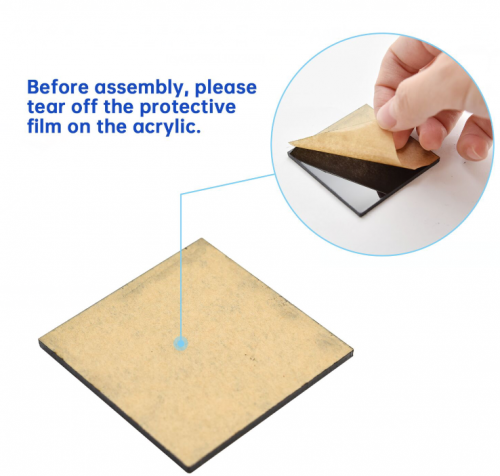
Assembly Guide
Note: Remove the Bluetooth module before uploading test code, otherwise, you will fail to upload test code
Note: Peel the plastic film off the board first when installing the smart car. To be honest, we never intend to send wood to you.
After making an inventory all the parts in this kit, then we need to mount the tank robot. Let’s install smart car in compliance with the following instructions.
Step 1: Install Bottom Motor
Prepare the parts as follows:
- M4 Nut * 2
- Metal Motor *2
- Metal Holder *2
- Copper Coupler *2
- Blue Supportive Parts *2
- M4*12MM Inner Hex Screw * 2
- M1.5 Hex Key Nickel Plated Allen Wrench *1
- M3 Hex Key Nickel Plated Allen Wrench *1
- M2.5 Hex Key Nickel Plated Allen Wrench *1
- M3*8MM Inner Hex Screw * 4
Step 2: Install Driver Wheel
Prepare the parts as follows:
- M4*12MM Inner Hex Screw * 2
- M4*50MM Inner Hex Screw * 2
- Tank Load-bearing Wheel * 2
- Flange Bearing * 4
- Copper Bush *2
- Caterpillar Band *2
- M4 Self-locking Nut * 2
- M3 Hex Key Nickel Plated Allen Wrench *1
Step 3: Install the Battery Holder
Prepare the parts as follows:
- Battery Holder *1
- M3 Nut * 2
- Blue Metal holder *2
- M4 Nut *8
- M3*10MM Flat Head Screw * 2
- M4*40MM Inner Hex Screw *4
- M2.5 Hex Key Nickel Plated Allen Wrench*1
- M3 Hex Key Nickel Plated Allen Wrench *1
- M3*25MM Inner Hex Screw *4
Finish the mount process. Go to fix the metal holder on the motor wheel with four M4*40MM inner hex screws and four M4 nuts.
Step 4: Mount Acrylic Board and Sensors
- Acrylic Board * 2
- L- type Black Bracket *1
- Photocell Sensor *2
- IR Receiver Module *1
- 8X16 LED Panel *1
- M2 Nut *4
- M3 Nut *10
- M3*6MM Inner Hex Screw * 8
- M2.5 Hex Key Allen Wrench *1
- M3*12MM Round Head Screw *7
- M3*10MM Hexagon Copper Bush *8
- M2*10MM Round Head Screw * 4
Step 5: Install the Servo Platform
Prepare the parts as follows:
- Servo *1
- Black Gimbal *1
- Cable Tie *2
- M2x8 Round Head Cross Tapping Screw *2
- Ultrasonic Sensor *1
- M2*4 Screw *1
- M1.2*5 Screw *4
Note: for convenient debugging, keep the ultrasonic module straight ahead and the angle of servo motor 90°. Therefore, we need to set servo to 90° before installing the servo platform.
You can find M1.2*5 Screws inside the bag of Plastic Platform.
Step 6: Install Sensors and Boards
Prepare the parts as follows:
- M3*6MM Round Head Screw *12
- L298P Shield *1
- V4.0 Board *1
- V5 Sensor Shield *1
- Screwdriver *1
- Bluetooth Module *1
Step 7: Hook-up Guide
Step 8: Wire up LED Panel
Step 9: install all parts of Acrylic plate
Step 10: Final Renderings

Note: Remove the Bluetooth module before uploading test code, otherwise, you will fail to upload test code.
Install Arduino IDE and Driver
Download software
When we get control board, we need to download Arduino IDE and driver firstly.
You could download Arduino IDE from the official website:
https://www.arduino.cc/, click the SOFTWARE on the browse bar, click “DOWNLOADS” to enter download page, as shown below:

There are various versions for Arduino, just download a suitable version for your system, we will take WINDOWS system as an example to show you how to download and install.

There are two versions for WINDOWS system, one is installed version, another one is download version, you just need to download file to computer directly and unzip it. These two versions can be used normally. Choose one and download on your computer.

You just need to click JUST DOWNLOAD, then click the downloaded file to install it. And when the ZIP file is downloaded, you can directly unzip and start it.
Keyestudio V4.0 Development Board
We need to know keyestudio V4.0 development board, as a core of this smart car.

keyestudio V4.0 development board is an Arduino uno-compatible board, which is based on ATmega328P MCU, and with a cp2102 Chip as a UART-to-USB converter.

It has 14 digital input/output pins (of which 6 can be used as PWM outputs), 6 analog inputs, a 16 MHz quartz crystal, a USB connection, a power jack, 2 ICSP headers and a reset button.

It contains everything needed to support the microcontroller; simply connect it to a computer with a USB cable or power it via an external DC power jack (DC 7-12V) or via female headers Vin/ GND(DC 7-12V) to get started.

Installing driver
Let’s install the driver of keyestudio PLUS control board. The USB-TTL chip on PLUS board adopts CP2102 serial chip. The driver program of this chip is included in Arduino 1.8 version and above, which is convenient. Plug on USB port of board, the computer can recognize the hardware and automatically install the driver of CP2102.
If install unsuccessfully, or you intend to install manually, open the device manager of computer. Right click Computer—— Properties—— Device Manager.

There is a yellow exclamation mark on the page, which implies installing the driver of CP2102 unsuccessfully. Then we double click the hardware and update the driver.

Click “OK” to enter the following page, click “browse my computer for updated driver software”, find out the installed or downloaded ARDUINO software. As shown below:

There is a DRIVERS folder in Arduino software installed package(), open driver folder and you can see the driver of CP210X series chips.
We click “Browse”, then find out the driver folder, or you could enter “driver” to search in rectangular box, then click “next”, the driver will be installed successfully. (I place Arduino software folder on the desktop, you could follow my way)

Open device manager, we will find the yellow exclamation mark disappear. The driver of CP2102 is installed successfully.
Install other visions of driver
If your development board is Arduino UNO board, install the driver as follows:
Step 1: Plug in the development board, click Computer—— Properties—— Device Manager, you could see the unknown device is shown.

Step 2: Update the driver

Step 3: click“browse my computer for updated driver software”
Step 4: find out the folder where the ARDUINO software is installed, click drivers folder and tap“Next”
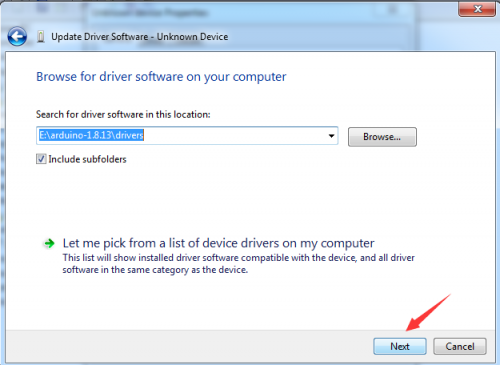
Step 5: the driver is installed successfully.

The device manager shows the serial port of Arduino.
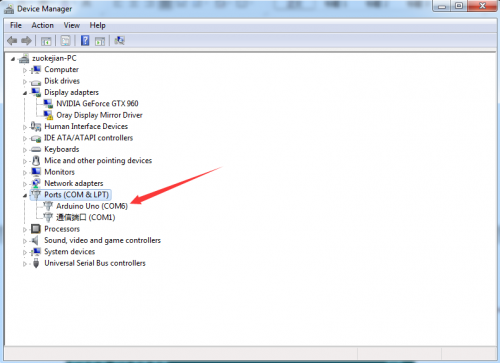
Arduino IDE Setting
Click
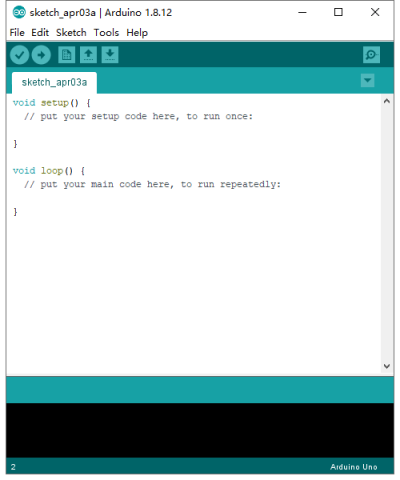
To avoid the errors when uploading the program to the board, you need to select the correct Arduino board that matches the board connected to your computer.
Then come back to the Arduino software, you should click Tools→Board, select the board. (as shown below)
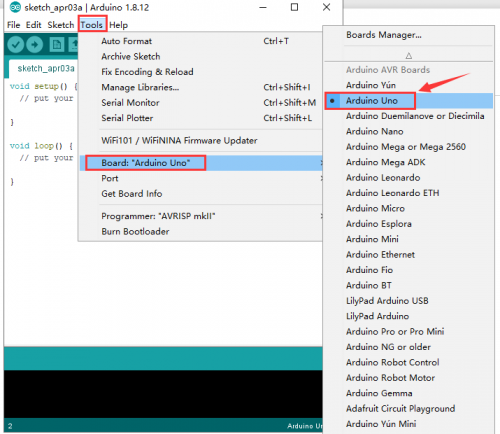
Then select the correct COM port (you can see the corresponding COM port after the driver is successfully installed)
Before uploading the program to the board, let’s demonstrate the function of each symbol in the Arduino IDE toolbar.
A- Used to verify whether there is any compiling mistakes or not.
B- Used to upload the sketch to your Arduino board.
C- Used to create shortcut window of a new sketch.
D- Used to directly open an example sketch.
E- Used to save the sketch.
F- Used to send the serial data received from board to the serial monitor.
Start your first program
Open the file to select Example, choose BLINK from BASIC, as shown below:

Set board and COM port, the corresponding board and COM port are shown on the lower right of IDE.
Click to start compiling the program, check errors.

Click to upload the program, upload successfully.

Upload the program successfully, the onboard LED lights on for 1s, lights off for 1s. Congratulation, you finish the first program.
How to Add a Library?
What are Libraries ?
Libraries are a collection of code that makes it easy for you to connect to a sensor,display, module, etc.
For example, the built-in LiquidCrystal library helps talk to LCD displays. There are hundreds of additional libraries available on the Internet for download.
The built-in libraries and some of these additional libraries are listed in the reference.
Here we will introduce the most simple way for you to add libraries .
Step 1:After downloading well the Arduino IDE, you can right-click the icon of Arduino IDE.
Find the option «Open file location» shown as below:

Step 2: Enter it to find out libraries folder which is the library file of Arduino.

Step 3:Next to find out the“libraries”of tank robot(seen in the link: https://fs.keyestudio.com/KS0428), you just need to replicate and paste into the libraries folder of Arduino IDE.
Then the libraries of tank robot are installed successfully, as shown below:
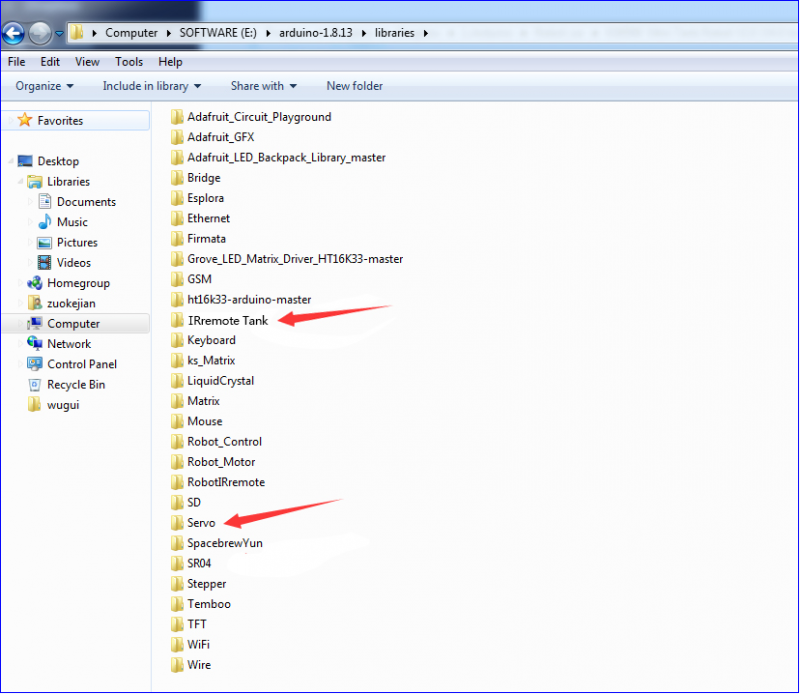
Projects
Project 1: LED Blink
(1)Description
For the starter and enthusiast, this is a fundamental program—LED Blink.
LED, the abbreviation of light emitting diodes, consist of Ga, As, P, N chemical compound and so on. The LED can flash diverse color by altering the delay time in the test code. When in control, power on GND and VCC, the LED will be on if S end is high level; nevertheless, it will go off.
(2)Specification
- Control interface: digital port
- Working voltage: DC 3.3-5V
- Pin spacing: 2.54mm
- LED display color: red
(3)Equipment
(4) V5 Sensor Shield
There will be troublesome when we combine Arduino development boards with numerous sensors. However, the V5 sensor shield, compatible with Arduino development board, address this problem perfectly. Just stack V5 board on it.
This sensor shield can be inserted into 3pin sensor modules and breaks out some some communication pins, like serial, IIC, and SPI communication as well.
Pins Description
Connection Diagram:
Seen from the above diagram, LED is linked with D2
(5) Test Code
/*
keyestudio Mini Tank Robot V2
lesson 1.1
Blink
http://www.keyestudio.com
*/
void setup()
{
pinMode(2, OUTPUT);// initialize digital pin 2 as an output.
}
void loop() // the loop function runs over and over again forever
{
digitalWrite(2, HIGH); // turn the LED on (HIGH is the voltage level)
delay(1000); // wait for a second
digitalWrite(2, LOW); // turn the LED off by making the voltage LOW
delay(1000); // wait for a second
}
//****************************************************************
(6) Test Result
(There will be contradict about serial communication between code and Bluetooth when uploading code, therefore, don’t link with Bluetooth module before uploading code.)
Upload the program on the development board, LED flicker with the interval of 1s.
(7)Code Explanation
pinMode(2,OUTPUT) — Set pin2 to OUTPUT
digitalWrite(2,HIGH) — When set pin2 to HIGH level(output 5V) or to LOW level(output 0V)
(8)Extension Practice
We succeed to blink LED. Next, let’s observe what LED will change if we modify pins and delay time.
Connection Diagram
We’ve altered pins and connected LED to D10.
Test Code:
/*
keyestudio Mini Tank Robot V2
lesson 1.2
delay
http://www.keyestudio.com
*/
void setup() { // initialize digital pin 10 as an output.
pinMode(10, OUTPUT);
}
// the loop function runs over and over again forever
void loop() {
digitalWrite(10, HIGH); // turn the LED on (HIGH is the voltage level)
delay(100); // wait for 0.1 second
digitalWrite(10, LOW); // turn the LED off by making the voltage LOW
delay(100); // wait for 0.1 second
}
//****************************************************************
The LED flickers faster than before through the test result, therefore, pins and delay time affect flash frequency.
Project 2: Adjust LED Brightness
(1)Description
In previous lesson, we control LED on and off and make it blink.
In this project, we will control LED brightness through PWM to simulate breathing effect. Similarly, you can change the step length and delay time in the code so as to demonstrate different breathing effect.
PWM is a means of controlling the analog output via digital means. Digital control is used to generate square waves with different duty cycles (a signal that constantly switches between high and low levels) to control the analog output.In general, the input voltage of port are 0V and 5V. What if the 3V is required? Or what if switch among 1V, 3V and 3.5V? We can’t change resistor constantly. For this situation, we need to control by PWM.
For the Arduino digital port voltage output, there are only LOW and HIGH, which correspond to the voltage output of 0V and 5V. You can define LOW as 0 and HIGH as 1, and let the Arduino output five hundred 0 or 1 signals within 1 second.
If output five hundred 1, that is 5V; if all of which is 1, that is 0V. If output 010101010101 in this way then the output port is 2.5V, which is like showing movie. The movie we watch are not completely continuous. It actually outputs 25 pictures per second. In this case, the human can’t tell it, neither does PWM. If want different voltage, need to control the ratio of 0 and 1. The more 0,1 signals output per unit time, the more accurately control.
(2) Specification
- Control interface: digital port
- Working voltage: DC 3.3-5V
- Pin spacing: 2.54mm
- Display color: red
(3) Equipment
(4) Connection Diagram
(5) Test Code
/*
keyestudio Mini Tank Robot V2
lesson 2.1
pwm
http://www.keyestudio.com
*/
int ledPin = 10; // Define the LED pin at D10
int value;
void setup ()
{
pinMode (ledPin, OUTPUT); // initialize ledpin as an output.
}
void loop ()
{
for (value = 0; value <255; value = value + 1)
{
analogWrite (ledPin, value); // LED lights gradually light up
delay (5); // delay 5MS
}
for (value = 255; value> 0; value = value-1)
{
analogWrite (ledPin, value); // LED gradually goes out
delay (5); // delay 5MS
}}//**********************************************************
(6)Test Result
Upload test code successfully, LED gradually becomes brighter then darker, like human breath, rather than light on and off immediately.
(7)Code Explanation
When we need to repeat some statements, we could use FOR statement.
FOR statement format is shown below:
FOR cyclic sequence:
Round 1:1 → 2 → 3 → 4
Round 2:2 → 3 → 4
…
Until number 2 is not established, “for”loop is over,
After knowing this order, go back to code:
for (int value = 0; value < 255; value=value+1){
...
}
for (int value = 255; value >0; value=value-1){
...
}
The two“for”statements make value increase from 0 to 255, then reduce from 255 to 0, then increase to 255,….infinitely loop
There is a new function in the following —— analogWrite()
We know that digital port only has two state of 0 and 1. So how to send an analog value to a digital value? Here,this function is needed. Let’s observe the Arduino board and find 6 pins marked“~”which can output PWM signals.
Function format as follows:
analogWrite(pin,value)
analogWrite() is used to write an analog value from 0~255 for PWM port, so the value is in the range of 0~255. Attention that you only write the digital pins with PWM function, such as pin 3, 5, 6, 9, 10, 11.
PWM is a technology to obtain analog quantity through digital method. Digital control forms a square wave, and the square wave signal only has two states of turning on and off (that is, high or low levels). By controlling the ratio of the duration of turning on and off, a voltage varying from 0 to 5V can be simulated. The time turning on(academically referred to as high level) is called pulse width, so PWM is also called pulse width modulation.
Through the following five square waves, let’s acknowledge more about PWM.
In the above figure, the green line represents a period, and value of analogWrite() corresponds to a percentage which is called Duty Cycle as well. Duty cycle implies that high-level duration is divided by low-level duration in a cycle. From top to bottom, the duty cycle of first square wave is 0% and its corresponding value is 0. The LED brightness is lowest, that is, turn off. The more time high level lasts, the brighter the LED.
Therefore, the last duty cycle is 100%, which correspond to 255, LED is brightest. 25% means darker.
PWM mostly is used for adjusting the LED brightness or rotation speed of motor.
It plays vital role in controlling smart robot car. I believe that you can’t wait to enter next project.
(8) Extension Practice:
Let’s modify the value of delay and remain the pin unchanged, then observe how LED changes.
/*
keyestudio Mini Tank Robot V2
lesson 2.2
pwm-slow
http://www.keyestudio.com
*/
int ledPin = 10; // Define the LED pin at D10
int value;
void setup ()
{
pinMode (ledPin, OUTPUT); // initialize ledpin as an output.
}
void loop ()
{
for (value = 0; value <255; value = value + 1)
{
analogWrite (ledPin, value); // LED lights gradually light up
delay (30); // delay 30MS
}
for (value = 255; value> 0; value = value-1)
{
analogWrite (ledPin, value); // LED gradually goes out
delay (30); // delay 30MS
}}//**********************************************************
Upload code on the development board and LED gradually get brighter then darker.
Project 3: Photoresistor Sensor
(1)Description
The photoresistor is a special resistor made of semiconductor materials such as CdS or Selenide septum. The surface is also coated with moisture-proof resin, which has a photoconductive effect. It is sensitive to ambient light. Its resistance varies from different light intensities.
We use the characteristics of the photo-resistor to design the circuit and generate the photo-resistor module.
Connecting the signal pin of photocell module to Analog port, when the stronger the light intensity, the greater the voltage of analog port, the greater the analog value is.
On the contrary, the weaker the light intensity, the smaller the voltage of analog port, the smaller the analog value is.
Based on that, we can use the photocell module to read the analog value, so get the ambient light intensity.
(2)Specification
- Resistance:5K ohm-0.5Mohm
- Interface Type: analog
- Working Voltage: 3.3V-5V
- Easy installation: with screw fixing holes
- Pin spacing: 2.54mm
(3)Equipment
Connection Diagram:
The two photoresistor sensors are linked with A1 and A2, then finish the experiment via photoresistor connected to A1. Then finish the following experiment via photoresistor connected A1. Let’s read its analog value.
(4)Test Code
/*
keyestudio Mini Tank Robot V2
lesson 3.1
photocell
http://www.keyestudio.com
*/
int sensorPin = A1; // select the input pin for the photocell
int sensorValue = 0; // variable to store the value coming from the sensor
void setup() {
Serial.begin(9600);
}
void loop() {
sensorValue = analogRead(sensorPin); // read the value from the sensor:
Serial.println(sensorValue); //Serial port prints the resistance value
delay(500);
}
//******************************************************
(5)Test Result
Upload code on development board, open serial monitor, check if its value diminishes when covering photoresistor. However, the value increases when uncovered.
(6)Code Explanation
analogRead(sensorPin):read the analog value of photoresistor via analog ports.
Serial.begin(9600): Initialize the serial port, baud rate of serial communication is 9600
Serial.println : Serial port prints and word wrap.
(7)Extension Practice
We’ve known how to read the value of photoresistor. Let’s combine photoresistor with LED and view the status of LED.
PWM restrains the brightness, so LED is linked with PWM pins, connect LED to pin 10, keep pin of photoresistor unchanged, then design the code:
/*keyestudio Mini Tank Robot V2
lesson 3.2
photocell-analog output
http://www.keyestudio.com
*/
int analogInPin = A1; // Analog input pin that the photocell is attached to
int analogOutPin = 10; // Analog output pin that the LED is attached to
int sensorValue = 0; // value read from the pot
int outputValue = 0; // value output to the PWM (analog out)
void setup() {
Serial.begin(9600);
}
void loop() {
// read the analog in value:
sensorValue = analogRead(analogInPin);
// map it to the range of the analog out:
outputValue = map(sensorValue, 0, 1023, 0, 255);
// change the analog out value:
analogWrite(analogOutPin, outputValue);
// wait 2 milliseconds before the next loop for the analog-to-digital
// converter to settle after the last reading:
Serial.println(sensorValue); //serial port prints the value of photoresistor
delay(2);
}
//***************************************************************
Upload code, press it by hand and see the the LED brightness.
Project 4: Servo Control
(1)Description
Servo motor is a position control rotary actuator. It mainly consists of housing, circuit board, core-less motor, gear and position sensor. Its working principle is that the servo receives the signal sent by MCU or receiver and produces a reference signal with a period of 20ms and width of 1.5ms, then compares the acquired DC bias voltage to the voltage of the potentiometer and obtain the voltage difference output.
When the motor speed is constant, the potentiometer is driven to rotate through the cascade reduction gear, which leads that the voltage difference is 0, and the motor stops rotating. Generally, the angle range of servo rotation is 0° —180 °
The rotation angle of servo motor is controlled by regulating the duty cycle of PWM (Pulse-Width Modulation) signal. The standard cycle of PWM signal is 20ms (50Hz). Theoretically, the width is distributed between 1ms-2ms, but in fact, it’s between 0.5ms-2.5ms. The width corresponds the rotation angle from 0° to 180°. But note that for different brand motor, the same signal may have different rotation angle.
The corresponding servo angles are shown below:
(2)Specification
- Working voltage: DC 4.8V ~ 6V
- Operating angle range: about 180 ° (at 500 → 2500 μsec)
- Pulse width range: 500 → 2500 μsec
- No-load speed: 0.12 ± 0.01 sec / 60 (DC 4.8V) 0.1 ± 0.01 sec / 60 (DC 6V)
- No-load current: 200 ± 20mA (DC 4.8V) 220 ± 20mA (DC 6V)
- Stopping torque: 1.3 ± 0.01kg · cm (DC 4.8V) 1.5 ± 0.1kg · cm (DC 6V)
- Stop current: ≦ 850mA (DC 4.8V) ≦ 1000mA (DC 6V)
- Standby current: 3 ± 1mA (DC 4.8V) 4 ± 1mA (DC 6V)
(3)Equipment
(4)Connection Diagram:
Wiring note: the brown line of servo is linked with Gnd(G), the red line is connected to 5v(V) and orange line is attached to digital 9.
The servo have to be connected to external power, due to its high demand for driving servo current. Generally, the current of development board is not enough. If without connected power, the development board could be burnt.
(5)Test Code1
/*
keyestudio Mini Tank Robot V2
lesson 4.1
Servo
http://www.keyestudio.com
*/
#define servoPin 9 //servo Pin
int pos; //angle variable of servo
int pulsewidth; // pulse width variable of servo
void setup() {
pinMode(servoPin, OUTPUT); //set servo pin to OUTPUT
procedure(0); //set the angle of servo to 0°
}
void loop() {
for (pos = 0; pos <= 180; pos += 1) { // goes from 0 degrees to 180 degrees
// in steps of 1 degree
procedure(pos); // tell servo to go to position in variable 'pos'
delay(15); //control the rotation speed of servo
}
for (pos = 180; pos >= 0; pos -= 1) { // goes from 180 degrees to 0 degrees
procedure(pos); // tell servo to go to position in variable 'pos'
delay(15);
}
}
// function to control servo
void procedure(int myangle) {
pulsewidth = myangle * 11 + 500; //calculate the value of pulse width
digitalWrite(servoPin,HIGH);
delayMicroseconds(pulsewidth); //The duration of high level is pulse width
digitalWrite(servoPin,LOW);
delay((20 - pulsewidth / 1000)); // the cycle is 20ms, the low level last for the rest of time
}
//********************************************************************
Upload code successfully, servo swings back in the range of 0° to 180°
There is another guide for restraining servo—- servo library file, the following link of official website is for your reference.
https://www.arduino.cc/en/Reference/Servo
Servo library file
(6)Test Code2
/*
keyestudio Mini Tank Robot V2
lesson 4.2
servo
http://www.keyestudio.com
*/
#include <Servo.h>
Servo myservo; // create servo object to control a servo
// twelve servo objects can be created on most boards
int pos = 0; // variable to store the servo position
void setup() {
myservo.attach(9); // attaches the servo on pin 9 to the servo object
}
void loop() {
for (pos = 0; pos <= 180; pos += 1) { // goes from 0 degrees to 180 degrees
// in steps of 1 degree
myservo.write(pos); // tell servo to go to position in variable 'pos'
delay(15); // waits 15ms for the servo to reach the position
}
for (pos = 180; pos >= 0; pos -= 1) { // goes from 180 degrees to 0 degrees
myservo.write(pos); // tell servo to go to position in variable 'pos'
delay(15); // waits 15ms for the servo to reach the position
}
}
//****************************************************************
(7)Test Result
Upload code successfully and power on, servo rotates in the range of 0° to 180°. The result is same. We usually control it by library file.
(8)Code Explanation
Arduino comes with #include <Servo.h> (servo function and statement)
The following are some common statements of the servo function:
1. attach(interface)——Set servo interface, port 9 and 10 are available
3.write(angle)——The statement to set rotation angle of servo, the angle range is from 0° to 180°
3. read()——The statement to read angle of servo, read the command value of “write()”
4. Note: The above written format is “servo variable name, specific statement()”, for instance: myservo.attach(9)
Project 5: Ultrasonic Sensor
(1)Description
The HC-SR04 ultrasonic sensor uses sonar to determine distance to an object like bats do. It offers excellent non-contact range detection with high accuracy and stable readings in an easy-to-use package. It comes complete with ultrasonic transmitter and receiver modules.
The HC-SR04 or the ultrasonic sensor is being used in a wide range of electronics projects for creating obstacle detection and distance measuring application as well as various other applications. Here we have brought the simple method to measure the distance with arduino and ultrasonic sensor and how to use ultrasonic sensor with arduino.
(2)Specification
- Power Supply :+5V DC
- Quiescent Current : <2mA
- Working Current: 15mA
- Effectual Angle: <15°
- Ranging Distance : 2cm – 400 cm
- Resolution : 0.3 cm
- Measuring Angle: 30 degree
- Trigger Input Pulse width: 10uS
(3)Equipment
(4)The principle of ultrasonic sensor
As the above picture shown, it is like two eyes. One is transmitting end, the other is receiving end.
The ultrasonic module will emit the ultrasonic waves after trigger signal. When the ultrasonic waves encounter the object and are reflected back, the module outputs an echo signal, so it can determine the distance of object from the time difference between trigger signal and echo signal.
The t is the time that emitting signal meets obstacle and returns.
and the propagation speed of sound in the air is about 343m/s, therefore, distance = speed * time, because the ultrasonic wave emits and comes back, which is 2 times of distance, so it needs to be divided by 2, the distance measured by ultrasonic wave = (speed * time)/2
1.Use method and timing chart of ultrasonic module:
Setting the delay time of Trig pin of SR04 to 10μs at least, which can trigger it to detect distance.
2. After triggering, the module will automatically send eight 40KHz ultrasonic pulses and detect whether there is a signal return. This step will be completed automatically by the module.
3. If the signal returns, the Echo pin will output a high level, and the duration of the high level is the time from the transmission of the ultrasonic wave to the return.
Circuit diagram of ultrasonic sensor:
(5)Connection Diagram
(6)Test Code
/*
keyestudio Mini Tank Robot V2
lesson 5
Ultrasonic sensor
http://www.keyestudio.com
*/
int trigPin = 5; // Trigger
int echoPin = 4; // Echo
long duration, cm, inches;
void setup() {
//Serial Port begin
Serial.begin (9600);
//Define inputs and outputs
pinMode(trigPin, OUTPUT);
pinMode(echoPin, INPUT);
}
void loop() {
// The sensor is triggered by a HIGH pulse of 10 or more microseconds.
// Give a short LOW pulse beforehand to ensure a clean HIGH pulse:
digitalWrite(trigPin, LOW);
delayMicroseconds(2);
digitalWrite(trigPin, HIGH);
delayMicroseconds(10);
digitalWrite(trigPin, LOW);
// Read the signal from the sensor: a HIGH pulse whose
// duration is the time (in microseconds) from the sending
// of the ping to the reception of its echo off of an object.
duration = pulseIn(echoPin, HIGH);
// Convert the time into a distance
cm = (duration/2) / 29.1; // Divide by 29.1 or multiply by 0.0343
inches = (duration/2) / 74; // Divide by 74 or multiply by 0.0135
Serial.print(inches);
Serial.print("in, ");
Serial.print(cm);
Serial.print("cm");
Serial.println();
delay(250);
}
//****************************************************************
(7)Test Result
Upload test code on the development board, open serial monitor and set baud rate to 9600. The detected distance will be displayed, unit is cm and inch. Hinder the ultrasonic sensor by hand, the displayed distance value is smaller.
(8)Code Explanation
int trigPin = 5; this pin is defined pin to transmit ultrasonic waves, generally output.
int echoPin = 4; this is defined as the pin of reception, generally input
cm = (duration/2) / 29.1; inches = (duration/2) / 74; by 0.0135
We can calculate the distance by using the following formula:
distance = (traveltime/2) x speed of sound
The speed of sound is: 343m/s = 0.0343 cm/uS = 1/29.1 cm/uS
Or in inches: 13503.9in/s = 0.0135in/uS = 1/74in/uS
We need to divide the traveltime by 2 because we have to take into account that the wave was sent, hit the object, and then returned back to the sensor.
(9)Extension Practice:
We have just measured the distance displayed by the ultrasonic. How about controlling the LED with the measured distance? Let’s try it, connect an LED light module to the D10 pin.
/*
keyestudio Mini Tank Robot V2
lesson 5
Ultrasonic LED
http://www.keyestudio.com
*/
int trigPin = 5; // Trigger
int echoPin = 4; // Echo
long duration, cm, inches;
void setup() {
//Serial Port begin
Serial.begin (9600);
//Define inputs and outputs
pinMode(trigPin, OUTPUT);
pinMode(echoPin, INPUT);
}
void loop()
{
// The sensor is triggered by a HIGH pulse of 10 or more microseconds.
// Give a short LOW pulse beforehand to ensure a clean HIGH pulse:
digitalWrite(trigPin, LOW);
delayMicroseconds(2);
digitalWrite(trigPin, HIGH);
delayMicroseconds(10);
digitalWrite(trigPin, LOW);
// Read the signal from the sensor: a HIGH pulse whose
// duration is the time (in microseconds) from the sending
// of the ping to the reception of its echo off of an object.
duration = pulseIn(echoPin, HIGH);
// Convert the time into a distance
cm = (duration/2) / 29.1; // Divide by 29.1 or multiply by 0.0343
inches = (duration/2) / 74; // Divide by 74 or multiply by 0.0135
Serial.print(inches);
Serial.print("in, ");
Serial.print(cm);
Serial.print("cm");
Serial.println();
delay(250);
if (cm>=2 && cm<=10)
digitalWrite(10, HIGH);
delay(1000);
digitalWrite(10, LOW);
delay(1000);
}
//****************************************************************
Upload test code to development board and block ultrasonic sensor by hand, then check if LED is on
Project 6: IR Reception
(1)Description
There is no doubt that infrared remote control is ubiquitous in daily life. It is used to control various household appliances, such as TVs, stereos, video recorders and satellite signal receivers. Infrared remote control is composed of infrared transmitting and infrared receiving systems, that is, an infrared remote control and infrared receiving module and a single-chip microcomputer capable of decoding.
The 38K infrared carrier signal emitted by remote controller is encoded by the encoding chip in the remote controller. It is composed of a section of pilot code, user code, user inverse code, data code, and data inverse code. The time interval of the pulse is used to distinguish whether it is a 0 or 1 signal and the encoding is made up of these 0, 1 signals.
The user code of the same remote control is unchanged. The data code can distinguish the key.
When the remote control button is pressed, the remote control sends out an infrared carrier signal. When the IR receiver receives the signal, the program will decode the carrier signal and determines which key is pressed. The MCU decodes the received 01 signal, thereby judging what key is pressed by the remote control.
Infrared receiver we use is an infrared receiver module. Mainly composed of an infrared receiver head, it is a device that integrates reception, amplification, and demodulation. Its internal IC has completed demodulation, and can achieve from infrared reception to output and be compatible with TTL signals. Additionally, it is suitable for infrared remote control and infrared data transmission. The infrared receiving module made by the receiver has only three pins, signal line, VCC and GND. It is very convenient to communicate with arduino and other microcontrollers.
(2)Specification
- Operating Voltage: 3.3-5V(DC)
- Interface: 3PIN
- Output Signal: Digital signal
- Receiving Angle: 90 degrees
- Frequency: 38khz
- Receiving Distance: 10m
(3)Equipment
(4)Connection Diagram
Respectively link “-”、“+” and S of IR receiver module with G(GND), V(VCC)and A0 of keyestudio development board.
Attention: On the condition that digital ports are not available, analog ports can be regarded as digital ports. A0 equals to D14, A1 is equivalent to digital 15.
(5)Test Code
Firstly import library file of IR receiver module(refer to how to import Arduino library file) before designing code.
/*
keyestudio Mini Tank Robot V2
lesson 6
IRremote
http://www.keyestudio.com
*/
#include <IRremoteTank.h> // IRremote library statement
int RECV_PIN = A0; //define the pins of IR receiver as A0
IRrecv irrecv(RECV_PIN);
decode_results results; // decode results exist in the “result” of “decode results”
void setup()
{
Serial.begin(9600);
irrecv.enableIRIn(); //Enable receiver
}
void loop() {
if (irrecv.decode(&results))//decode successfully, receive a set of infrared signals
{
Serial.println(results.value, HEX);//Wrap word in 16 HEX to output and receive code
irrecv.resume(); // Receive the next value
}
delay(100);
}
//*******************************************************
(6)Test Result
Upload test code, open serial monitor and set baud rate to 9600, point remote control to IR receiver and the corresponding value will be shown, if pressing so long, the error codes will appear.
Below we have listed out each button value of keyestudio remote control. So you can keep it for reference.
(7)Code Explanation
irrecv.enableIRIn(): after enabling IR decoding, the IR signals will be received, then function“decode()”will check continuously if decode successfully.
irrecv.decode(&results): after decoding successfully, this function will come back to “true”, and keep result in “results”. After decoding a IR signals, run the resume()function and receive the next signal
(8)Extension Practice
We decoded the key value of IR remote control. How about restrain LED by the measured value? We could operate an experiment to affirm. Attach a LED to D10. When keep the pin of IR receiver unchanged, LED will be on when pressing the key of remote control; press again, LED will be off.
/* keyestudio Mini Tank Robot V2
lesson 6.2
IRremote
http://www.keyestudio.com
*/
#include <IRremoteTank.h>
int RECV_PIN = A0;//define the pin of IR receiver as A0
int LED_PIN=10;//define the pin of LED
int a=0;
IRrecv irrecv(RECV_PIN);
decode_results results;
void setup()
{
Serial.begin(9600);
irrecv.enableIRIn(); // Initialize the IR receiver
pinMode(LED_PIN,OUTPUT);//set LED_pin to OUTPUT
}
void loop() {
if (irrecv.decode(&results)) {
if(results.value==0xFF02FD &a==0) // according to the above key value, press“OK”on remote control , LED will be controlled
{
digitalWrite(LED_PIN,HIGH);//LED will be on
a=1;
}
else if(results.value==0xFF02FD &a==1) //press again
{
digitalWrite(LED_PIN,LOW);//LED will go off
a=0;
}
irrecv.resume(); //receive the next value
}
}
//*******************************************************
Upload code to development board, press“OK”key on remote control to make LED on and off.
Project 7: Bluetooth Remote Control
(1)Description
Bluetooth, a simple wireless communication module most popular since the last few decades and easy to use are being used in most of the battery-powered devices.
Over the years, there have been many upgrades of Bluetooth standard to keep fulfil the demand of customers and technology according to the need of time and situation.
Over the few years, there are many things changed including data transmission rate, power consumption with wearable and IoT Devices and Security System.
Here we are going to learn about HM-10 BLE 4.0 with Arduino Board. The HM-10 is a readily available Bluetooth 4.0 module. This module is used for establishing wireless data communication. The module is designed by using the Texas Instruments CC2540 or CC2541 Bluetooth low energy (BLE) System on Chip (SoC).
(2)Specification
- Bluetooth protocol: Bluetooth Specification V4.0 BLE
- No byte limit in serial port Transceiving
- In open environment, realize 100m ultra-distance communication with iphone4s
- Working frequency: 2.4GHz ISM band
- Modulation method: GFSK(Gaussian Frequency Shift Keying)
- Transmission power: -23dbm, -6dbm, 0dbm, 6dbm, can be modified by AT command.
- Sensitivity: ≤-84dBm at 0.1% BER
- Transmission rate: Asynchronous: 6K bytes ; Synchronous: 6k Bytes
- Security feature: Authentication and encryption
- Supporting service: Central & Peripheral UUID FFE0, FFE1
- Power consumption: Auto sleep mode, stand by current 400uA~800uA, 8.5mA during transmission.
- Power supply: 5V DC
- Working temperature: –5 to +65 Centigrade
(3)Equipment
(4)Connection Diagram
- 1. STATE: state test pins, connected to internal LED, generally keep it unconnected.
- 2. RXD: serial interface, receiving terminal.
- 3. TXD: serial interface, transmitting terminal.
- 4. GND: Ground.
- 5. VCC: positive pole of the power source.
- 6. EN/BRK: break connect, it means breaking the Bluetooth connection, generally, keep it unconnected.
(5)Test Code
/*
keyestudio Mini Tank Robot v2.0
lesson 7.1
bluetooth
http://www.keyestudio.com
*/
char ble_val; //character variable: save the value of Bluetooth reception
void setup() {
Serial.begin(9600);
}
void loop() {
if(Serial.available() > 0) //Judge if there is data in serial buffer
{
ble_val = Serial.read(); //Read data from serial buffer
Serial.println(ble_val); //Print
}}
//*******************************************
(There will be contradiction between serial communication of code and communication of Bluetooth when uploading code, therefore, don’t link with Bluetooth module before uploading code.)
After uploading code on development board, then insert Bluetooth module, wait for the command from cellphone.
(6)Download APP
Allow APP to access “location” in settings of your cellphone when connecting to Bluetooth module.
The code is reading the received signal, and we also need a stuff to send signal. In this project, we send signal to control robot car via cellphone.
Then we need to download the APP.
1.For iOS system
Enter APP STORE to search BLE Scanner 4.0, then download it.
2.For Android system
Enter Google Play to find out BLE Scanner, then download.
And allow APP to access“location”, you could enable “location”in settings of your cellphone.
- 3.After installation, open App and enable “Location and Bluetooth” permission.
- 4.We take iOS version as example. The operation method of Android version is almost same as it.
- 5.Scan Bluetooth module to get Bluetooth BLE 4.0. Its name is HMSoft.
Then click“connect”to link with Bluetooth and use it.
6. After connecting to HMSoft, click it to get multiple options, such as device information, access permission, general and custom service. Choose “CUSTOM SERVICE”
7.Then pop up the following page
8. Click(Read,Notify,WriteWithoutResponse)to enter the following page
9.Click Write Value, appear the interface to enter HEX or Text.
10.Open the serial monitor on Arduino,enter a 0 or other character at Text interface.
Then click“Write”, open serial monitor to view if there is a “0” signal
(7)Code Explanation
Serial.available() : The current rest characters when return to buffer area. Generally, this function is used to judge if there is data in buffer. When Serial.available()>0, it means that serial receives the data and can be read
Serial.read():Read a data of a Byte in buffer of serial port, for instance, device sends data to Arduino via serial port, then we could read data by “Serial.read()”
(8)Extension Practice
We could send a command via cellphone to turn on and off a LED.
D10 is connected to a LED, as shown below:
/*
keyestudio Mini Tank Robot v2.0
lesson 7.2
Bluetooth
http://www.keyestudio.com
*/
int ledpin=11;
void setup()
{Serial.begin(9600);
pinMode(ledpin,OUTPUT);
}
void loop()
{ int i;
if (Serial.available())
{i=Serial.read();
Serial.println("DATA RECEIVED:");
if(i=='1')
{ digitalWrite(ledpin,1);
Serial.println("led on");
}
if(i=='0')
{ digitalWrite(ledpin,0);
Serial.println("led off");
}}}//*******************************************


Click “Write” on APP, when you enter 1, LED will be on, when you input 0, LED will be off. (Remember to remove the Bluetooth module after finishing experiment, otherwise, burning code will be affected)
Project 8: Motor Driving and Speed Control
(1) Description
There are many ways to drive the motor. Our tank robot uses the most commonly used L298P solution. L298P is an excellent high-power motor driver IC produced by STMicroelectronics. It can directly drive DC motors, two-phase and four-phase stepping motors. The driving current up to 2A, and output terminal of motor adopts eight high-speed Schottky diodes as protection.
We designed a shield based on the circuit of L298p.
The stacked design reduces the technical difficulty of using and driving the motor.
(2)Specification
Circuit Diagram for L298P Board
- 1)Logic part input voltage: DC5V
- 2)Driving part input voltage: DC 7-12V
- 3)Logic part working current: <36mA
- 4)Driving part working current: <2A
- 5)Maximum power dissipation: 25W (T=75℃)
- 6)Working temperature: -25℃~+130℃
- 7)Control signal input level: high level 2.3V<Vin<5V, low level -0.3V<Vin<1.5V
(3)Drive Robot to Move
Through the above circuit diagram, the direction pin of A motor is D12, and speed pin is D3; D13 is the direction pin of B motor, D11 is speed pin.
We know how to control digital ports according to the following chart.
PWM decides 2 motors to turn so as to drive robot car. The PWM value is in the range of 0-255, the larger the number, the faster the motor rotates.
(4)Equipment
(5)Connection Diagram
Note: the 4Pin terminal block is marked with silkscreen 1234. The red line of right rear motor is connected to terminal 1, black line is linked with end 2. The red line of left front motor is attached to terminal 3, black line is linked with port 4.
(6)Test Code
/*
keyestudio Mini Tank Robot v2.0
lesson 8.1
motor driver
http://www.keyestudio.com
*/
#define ML_Ctrl 13 //define the direction control pin of left motor
#define ML_PWM 11 //define the PWM control pin of left motor
#define MR_Ctrl 12 //define direction control pin of right motor
#define MR_PWM 3 // define the PWM control pin of right motor
void setup()
{
pinMode(ML_Ctrl, OUTPUT);//define direction control pin of left motor as output
pinMode(ML_PWM, OUTPUT);//define PWM control pin of left motor as output
pinMode(MR_Ctrl, OUTPUT);//define direction control pin of right motor as output.
pinMode(MR_PWM, OUTPUT);//define the PWM control pin of right motor as output
}
void loop()
{
digitalWrite(ML_Ctrl,LOW);//set the direction control pin of left motor to LOW
analogWrite(ML_PWM,200);//set the PWM control speed of left motor to 200
digitalWrite(MR_Ctrl,LOW);//set the direction control pin of right motor to LOW
analogWrite(MR_PWM,200);//set the PWM control speed of right motor to 200
//front
delay(2000);//delay in 2s
digitalWrite(ML_Ctrl,HIGH);//set the direction control pin of left motor to HIGH
analogWrite(ML_PWM,200);//set the PWM control speed of left motor to 200
digitalWrite(MR_Ctrl,HIGH);//set the direction control pin of right motor to HIGH
analogWrite(MR_PWM,200);//set the PWM control speed of right motor to 200
//back
delay(2000);//delay in 2s
digitalWrite(ML_Ctrl,HIGH);//set the direction control pin of left motor to HIGH
analogWrite(ML_PWM,200);//set the PWM control speed of left motor to 200
digitalWrite(MR_Ctrl,LOW);//set the direction control pin of right motor to LOW
analogWrite(MR_PWM,200);//set the PWM control speed of right motor to 200
//left
delay(2000);//delay in 2s
digitalWrite(ML_Ctrl,LOW);//set the direction control pin of left motor to LOW
analogWrite(ML_PWM,200);//set the PWM control speed of left motor to 200
digitalWrite(MR_Ctrl,HIGH);//set the direction control pin of right motor to HIGH
analogWrite(MR_PWM,200);//set the PWM control speed of right motor to 200
//right
delay(2000);//delay in 2s
analogWrite(ML_PWM,0);//set the PWM control speed of left motor to 0
analogWrite(MR_PWM,0);//set the PWM control speed of right motor to 0
//stop
delay(2000);//delay in 2s
}//*****************************************
(7)Test Result
Hook up by connection diagram, upload code and power on, smart car goes forward and back for 2s, turns left and right for 2s, stops for 2s and alternately.
(8) Code Explanation
digitalWrite(ML_Ctrl,LOW): the rotation direction of motor is decided by the high/low level and and the pins that decide rotation direction are general pins.
analogWrite(ML_PWM,200): the speed of motor is regulated by PWM, The speed of motor is regulated by PWM, and the pins that decide the speed of motor have to be PWM pins.
(9)Extension Practice
Hook up in same way
/*
keyestudio Mini Tank Robot v2.0
lesson 8.2
motor driver pwm
http://www.keyestudio.com
*/
#define ML_Ctrl 13 //define the direction control pin of left motor
#define ML_PWM 11 //define the PWM control pin of left motor
#define MR_Ctrl 12 //define the control pin of right motor
#define MR_PWM 3 //define the PWM control pin of right motor
void setup()
{ pinMode(ML_Ctrl, OUTPUT);//define the direction control pin of left motor as OUTPUT
pinMode(ML_PWM, OUTPUT);//define the PWM control pin of left motor as OUTPUT
pinMode(MR_Ctrl, OUTPUT);//define the direction control pin of right motor as OUTPUT
pinMode(MR_PWM, OUTPUT);//define the PWM control pin of right motor as OUTPUT
}
void loop()
{ digitalWrite(ML_Ctrl,LOW);//Set direction control pin of left motor to LOW
analogWrite(ML_PWM,100);// Set the PWM control speed of left motor to 100
digitalWrite(MR_Ctrl,LOW);//Set the direction control pin of right motor to LOW
analogWrite(MR_PWM,100);//Set the PWM control speed of right motor to 100
//front
delay(2000);//define 2s
digitalWrite(ML_Ctrl,HIGH);//Set direction control pin of left motor to HIGH level
analogWrite(ML_PWM,100);//Set the PWM control speed of left motor to 100
digitalWrite(MR_Ctrl,HIGH);//Set direction control pin of right motor to HIGH level
analogWrite(MR_PWM,100);//Set the PWM control speed of right motor to 100
//back
delay(2000);//define 2s
digitalWrite(ML_Ctrl,HIGH);//Set direction control pin of left motor to HIGH level
analogWrite(ML_PWM,100);//Set the PWM control speed of left motor to 100
digitalWrite(MR_Ctrl,LOW);//Set direction control pin of right motor to LOW level
analogWrite(MR_PWM,100);//Set the PWM control speed of right motor to 100
//left
delay(2000);//define 2s
digitalWrite(ML_Ctrl,LOW);//set the direction control pin of left motor to LOW
analogWrite(ML_PWM,100);//set the PWM control speed of left motor to 200
digitalWrite(MR_Ctrl,HIGH);//set the direction control pin of right motor to HIGH
analogWrite(MR_PWM,100);//set the PWM control speed of right motor to 100
//right
delay(2000);//define 2s
analogWrite(ML_PWM,0);//set the PWM control speed of left motor to 0
analogWrite(MR_PWM,0);// set the PWM control speed of right motor to 0
//stop
delay(2000);//define 2s
}//******************************************************************
Upload code successfully, the motors rotate faster.
Project 9: LED Expression Panel
(1)Description
If we add an expression panel to the robot, it will be amazing. Keyestudio’s 8*16 dot matrix can meet your requirements. You can create facial expressions, patterns or other interesting displays yourself. 8*16 LED light board comes with 128 LEDs. The data of the microprocessor (arduino) communicates with the AiP1640 through the two-wire bus interface, so as to control the 128 LEDs on the module, which produce the patterns you need on dot matrix. To facilitate wiring, we also provide a HX-2.54 4Pin wiring.
(2)Specification
- Working voltage: DC 3.3-5V
- Power loss: 400mW
- Oscillation frequency: 450KHz
- Drive current: 200mA
- Working temperature: -40~80℃
- Communication method: two-wire bus
(3)Equipment
(4)8*16 Dot Matrix Display
Circuit Graphic
The principle of 8*16 dot matrix:
How to control each led light of 8*16 dot matrix? We know that a byte has 8 bits, each bit is 0 or 1. When a bit is 0, turn off LED and when a bit is 0, turn on LED.
Thereby, one byte can control the LED in a row of dot matrix, so 16 bytes can control 16 columns of led lights, that is, 8*16 dot matrix.
Interface Description and Communication Protocol:
The data of the microprocessor (arduino) communicates with the AiP1640 through the two-wire bus interface.
The communication protocol diagram is shown below:
(SCLK) is SCL, (DIN) is SDA:
①The starting condition for data input: SCL is high level and SDA changes from high to low.
②For data command setting, there are methods as shown in the figure below.
In our sample program, select the way to add 1 to the address automatically, the binary value is 0100 0000 and the corresponding hexadecimal value is 0x40.
③For address command setting, the address can be selected as shown below.
The first 00H is selected in our sample program, and the binary number 1100 0000 corresponds to the hexadecimal 0xc0
- ④The requirement for data input is that SCL is high level when inputting data, the signal on SDA must remain unchanged. Only when the clock signal on SCL is low level, the signal on SDA can be altered. The data input is low-order first, high-order is behind
- ⑤ The condition to end data transmission is that when SCL is low, SDA is low, and when SCL is high, the SDA level also becomes high.
- ⑥ Display control, set different pulse width, the pulse width can be selected as shown below
- In the example, we choose pulse width 4/16, and the hexadecimal corresponds to 1000 1010 is 0x8A
4. Introduction for Modulus Tool
The online version of dot matrix modulus tool:
http://dotmatrixtool.com/#
①Open links to enter the following page.
②The dot matrix is 8*16 in this project, so set the height to 8, width to 16, as shown below.
③ Generate hexadecimal data from the pattern
As shown below, press the left mouse button to select, the right button to cancel, draw the pattern you want, click Generate, and the hexadecimal data we need will be produced.
(5)Connection Diagram
Wiring note: The GND, VCC, SDA, and SCL of the 8×16 LED panel are respectively connected to -(GND), + (VCC), A4 and A5 of the keyestudio sensor expansion board for two-wire serial communication. (Note: This pin is connected to arduino IIC, but this module is not IIC communication, it can be linked with any two pins.)
(6)Test Code
The code that shows smile face
/*
keyestudio Mini Tank Robot v2.0
lesson 9.1
Matrix face
http://www.keyestudio.com
*/
//the data of smiley from modulus tool
unsigned char smile[] = {0x00, 0x00, 0x1c, 0x02, 0x02, 0x02, 0x5c, 0x40, 0x40, 0x5c, 0x02, 0x02, 0x02, 0x1c, 0x00, 0x00};
#define SCL_Pin A5 //Set clock pin to A5
#define SDA_Pin A4 //Set data pin to A4
void setup(){
//Set pin to output
pinMode(SCL_Pin,OUTPUT);
pinMode(SDA_Pin,OUTPUT);
//clear the display
//matrix_display(clear);
}
void loop(){
matrix_display(smile); // display smile face
}
// the function for dot matrix display
void matrix_display(unsigned char matrix_value[])
{
IIC_start(); // use the function of the data transmission start condition
IIC_send(0xc0); //select address
for(int i = 0;i < 16;i++) //pattern data has 16 bits
{
IIC_send(matrix_value[i]); //convey the pattern data
}
IIC_end(); //end the transmission of pattern data
IIC_start();
IIC_send(0x8A); //display control, set pulse width to 4/16 s
IIC_end();
}
//the condition to start conveying data
void IIC_start()
{
digitalWrite(SCL_Pin,HIGH);
delayMicroseconds(3);
digitalWrite(SDA_Pin,HIGH);
delayMicroseconds(3);
digitalWrite(SDA_Pin,LOW);
delayMicroseconds(3);
}
//Convey data
void IIC_send(unsigned char send_data)
{
for(char i = 0;i < 8;i++) //Each byte has 8 bits 8bit for every character
{
digitalWrite(SCL_Pin,LOW); // pull down clock pin SCL_Pin to change the signal of SDA
delayMicroseconds(3);
if(send_data & 0x01) //set high and low level of SDA_Pin according to 1 or 0 of every bit
{
digitalWrite(SDA_Pin,HIGH);
}
else
{
digitalWrite(SDA_Pin,LOW);
}
delayMicroseconds(3);
digitalWrite(SCL_Pin,HIGH); //pull up the clock pin SCL_Pin to stop transmission
delayMicroseconds(3);
send_data = send_data >> 1; // detect bit by bit, shift the data to the right by one
}
}
//The sign of ending data transmission
void IIC_end()
{
digitalWrite(SCL_Pin,LOW);
delayMicroseconds(3);
digitalWrite(SDA_Pin,LOW);
delayMicroseconds(3);
digitalWrite(SCL_Pin,HIGH);
delayMicroseconds(3);
digitalWrite(SDA_Pin,HIGH);
delayMicroseconds(3);
}
//******************************************************
(7)Test Result
Wire according to connection diagram. The DIP switch is dialed to right end and power on, the smile face appears on dot matrix.
(8)Extension Practice
We use the modulo tool (http://dotmatrixtool.com/#)to make the dot matrix alternately display start, go front and stop patterns then clear the patterns, the time interval is 2000 milliseconds.
Get the graphical code to be displayed via modulus tool
- Start:
- 0x01,0x02,0x04,0x08,0x10,0x20,0x40,0x80,0x80,0x40,0x20,0x10,0x08,0x04,0x02,0x01
- Go front:
- 0x00,0x00,0x00,0x00,0x00,0x24,0x12,0x09,0x12,0x24,0x00,0x00,0x00,0x00,0x00,0x00
- Go back:
- 0x00,0x00,0x00,0x00,0x00,0x24,0x48,0x90,0x48,0x24,0x00,0x00,0x00,0x00,0x00,0x00
- Turn left:
- 0x00,0x00,0x00,0x00,0x00,0x00,0x44,0x28,0x10,0x44,0x28,0x10,0x44,0x28,0x10,0x00
- Turn left:
- 0x00,0x10,0x28,0x44,0x10,0x28,0x44,0x10,0x28,0x44,0x00,0x00,0x00,0x00,0x00,0x00
- Stop:
- 0x2E,0x2A,0x3A,0x00,0x02,0x3E,0x02,0x00,0x3E,0x22,0x3E,0x00,0x3E,0x0A,0x0E,0x00
- Clear the displayed code:0x00,0x00,0x00,0x00,0x00,0x00,0x00,0x00,0x00,0x00,0x00,0x00,0x00,0x00,0x00,0x00
The code that the multiple patterns shift:
/* keyestudio Mini Tank Robot v2.0
lesson 9.2
Matrix loop
http://www.keyestudio.com
*/
//Array, used to store the data of the pattern, can be calculated by yourself or obtained from the modulus tool
unsigned char start01[] =
{0x01,0x02,0x04,0x08,0x10,0x20,0x40,0x80,0x80,0x40,0x20,0x10,0x08,0x04,0x02,0x01};
unsigned char front[] =
{0x00,0x00,0x00,0x00,0x00,0x24,0x12,0x09,0x12,0x24,0x00,0x00,0x00,0x00,0x00,0x00};
unsigned char back[] =
{0x00,0x00,0x00,0x00,0x00,0x24,0x48,0x90,0x48,0x24,0x00,0x00,0x00,0x00,0x00,0x00};
unsigned char left[] =
{0x00,0x00,0x00,0x00,0x00,0x00,0x44,0x28,0x10,0x44,0x28,0x10,0x44,0x28,0x10,0x00};
unsigned char right[] =
{0x00,0x10,0x28,0x44,0x10,0x28,0x44,0x10,0x28,0x44,0x00,0x00,0x00,0x00,0x00,0x00};
unsigned char STOP01[] =
{0x2E,0x2A,0x3A,0x00,0x02,0x3E,0x02,0x00,0x3E,0x22,0x3E,0x00,0x3E,0x0A,0x0E,0x00};
unsigned char clear[] =
{0x00,0x00,0x00,0x00,0x00,0x00,0x00,0x00,0x00,0x00,0x00,0x00,0x00,0x00,0x00,0x00};
#define SCL_Pin A5 //Set clock pin to A5
#define SDA_Pin A4 //Set data pin to A4
void setup(){
//Set pins to output
pinMode(SCL_Pin,OUTPUT);
pinMode(SDA_Pin,OUTPUT);
//Clear the display
matrix_display(clear);
}
void loop(){
matrix_display(start01); // Display start pattern
delay(2000);
matrix_display(front); //Front pattern
delay(2000);
matrix_display(STOP01); //Stop pattern
delay(2000);
matrix_display(clear); //Clear the display Clear the screen
delay(2000);
}
// This function is used to display of dot matrix
void matrix_display(unsigned char matrix_value[])
{
IIC_start(); //call the function that data transmission start
IIC_send(0xc0); //Choose address
for(int i = 0;i < 16;i++) //pattern data has 16 bits
{
IIC_send(matrix_value[i]); //data to convey patterns
}
IIC_end(); //end the transmission of pattern dataEnd
IIC_start();
IIC_send(0x8A); //display control, set pulse width to 4/16
IIC_end();
}
//The condition starting to transmit data
void IIC_start()
{
digitalWrite(SCL_Pin,HIGH);
delayMicroseconds(3);
digitalWrite(SDA_Pin,HIGH);
delayMicroseconds(3);
digitalWrite(SDA_Pin,LOW);
delayMicroseconds(3);
}
//Convey data
void IIC_send(unsigned char send_data)
{
for(char i = 0;i < 8;i++) //Each byte has 8 bits
{
digitalWrite(SCL_Pin,LOW); //pull down clock pin SCL Pin to change the signals of SDA
delayMicroseconds(3);
if(send_data & 0x01) //set high and low level of SDA_Pin according to 1 or 0 of every bit
{
digitalWrite(SDA_Pin,HIGH);
}
else
{
digitalWrite(SDA_Pin,LOW);
}
delayMicroseconds(3);
digitalWrite(SCL_Pin,HIGH); //pull up clock pin SCL_Pin to stop transmitting data
delayMicroseconds(3);
send_data = send_data >> 1; //detect bit by bit, so shift the data right by one
}}
//The sign that data transmission ends
void IIC_end()
{
digitalWrite(SCL_Pin,LOW);
delayMicroseconds(3);
digitalWrite(SDA_Pin,LOW);
delayMicroseconds(3);
digitalWrite(SCL_Pin,HIGH);
delayMicroseconds(3);
digitalWrite(SDA_Pin,HIGH);
delayMicroseconds(3);}
//*****************************************************
Upload code on development board, 8*16 dot matrix display go front and back and stop patterns, alternately.

Project 10: Light Follow Robot
(1)Description

We’ve introduce how to use various sensors, modules.
In this lesson, we combine with hardware knowledge — photoresistor module, motor driving, to build a light-following robot!
Just need to use 2 photoresistor modules to detect the light intensity at the both side of robot. Read the analog value to rotate the 2 motors, thus drive the tank robot run.
The specific logic of light following robot is shown as the table below:


We make a flow chart based on the above logic table, as shown below:
(2)Connection Diagram

Hook-up Attention:
The 4Pin terminal block is marked with silkscreen 1234. The red line of right rear motor is connected to terminal 1, black line is linked with end 2. The red line of left front motor is attached to terminal 3, black line is linked with port 4.

(3)Test Code
/*
keyestudio Mini Tank Robot v2.0
lesson 10
Light-following tank
http://www.keyestudio.com
*/
#define light_L_Pin A1 //define the pin of left photo resistor
#define light_R_Pin A2 //define the pin of right photo resistor
#define ML_Ctrl 13 //define the direction control pin of left motor
#define ML_PWM 11 //define the PWM control pin of left motor
#define MR_Ctrl 12 //define the direction control pin of right motor
#define MR_PWM 3 //define the PWM control pin of right motor
int left_light;
int right_light;
void setup(){
Serial.begin(9600);
pinMode(light_L_Pin, INPUT);
pinMode(light_R_Pin, INPUT);
pinMode(ML_Ctrl, OUTPUT);
pinMode(ML_PWM, OUTPUT);
pinMode(MR_Ctrl, OUTPUT);
pinMode(MR_PWM, OUTPUT);
}
void loop(){
left_light = analogRead(light_L_Pin);
right_light = analogRead(light_R_Pin);
Serial.print("left_light_value = ");
Serial.println(left_light);
Serial.print("right_light_value = ");
Serial.println(right_light);
if (left_light > 650 && right_light > 650) //the value detected photo resistor,go front
{
Car_front();
}
else if (left_light > 650 && right_light <= 650) //the value detected photo resistor,turn left
{
Car_left();
}
else if (left_light <= 650 && right_light > 650) //the value detected photo resistor,turn right
{
Car_right();
}
else //other situations, stop
{
Car_Stop();
}
}
void Car_front()
{
digitalWrite(MR_Ctrl,LOW);
analogWrite(MR_PWM,200);
digitalWrite(ML_Ctrl,LOW);
analogWrite(ML_PWM,200);
}
void Car_left()
{
digitalWrite(MR_Ctrl,LOW);
analogWrite(MR_PWM,200);
digitalWrite(ML_Ctrl,HIGH);
analogWrite(ML_PWM,200);
}
void Car_right()
{
digitalWrite(MR_Ctrl,HIGH);
analogWrite(MR_PWM,200);
digitalWrite(ML_Ctrl,LOW);
analogWrite(ML_PWM,200);
}
void Car_Stop()
{
digitalWrite(MR_Ctrl,LOW);
analogWrite(MR_PWM,0);
digitalWrite(ML_Ctrl,LOW);
analogWrite(ML_PWM,0);
}
//****************************************************************
(4)Test Result
Upload code on keyestudio V4.0 development board, DIP switch is dialed to right end and power on, the smart robot follows light to move.
Project 11: Ultrasonic Avoid Tank

(1)Description
In this program, the ultrasonic sensor detects the distance of obstacle to send signals that control the robot car. Next, let’s show you how to make an obstacle avoidance car.
The specific logic of ultrasonic avoiding robot is as shown below:

(2)Flow chart

(3)Connection Diagram:

Note: “-”、“+” and “S” pins of servo are respectively attached to G(GND), V(VCC)and D9 of expansion board. The VCC, Trig, Echo and Gnd of ultrasonic sensor are linked with 5v(V), 5(S), Echo and Gnd(G) of expansion board.
(4)Test Code:
/*
keyestudio Mini Tank Robot v2.0
lesson 11
ultrasonic_avoid_tank
http://www.keyestudio.com
*/
int random2;
int a;
int a1;
int a2;
#define ML_Ctrl 13 //define the direction control pin of left motor
#define ML_PWM 11 //define PWM control pin of left motor
#define MR_Ctrl 12 //define the direction control pin of right motor
#define MR_PWM 3 //define PWM control pin of right motor
#define Trig 5 //ultrasonic trig Pin
#define Echo 4 //ultrasonic echo Pin
int distance;
#define servoPin 9 //servo Pin
int pulsewidth;
/************the function to run motor**************/
void Car_front()
{
digitalWrite(MR_Ctrl,LOW);
analogWrite(MR_PWM,200);
digitalWrite(ML_Ctrl,LOW);
analogWrite(ML_PWM,200);
}
void Car_back()
{
digitalWrite(MR_Ctrl,HIGH);
analogWrite(MR_PWM,200);
digitalWrite(ML_Ctrl,HIGH);
analogWrite(ML_PWM,200);
}
void Car_left()
{
digitalWrite(MR_Ctrl,LOW);
analogWrite(MR_PWM,255);
digitalWrite(ML_Ctrl,HIGH);
analogWrite(ML_PWM,255);
}
void Car_right()
{
digitalWrite(MR_Ctrl,HIGH);
analogWrite(MR_PWM,255);
digitalWrite(ML_Ctrl,LOW);
analogWrite(ML_PWM,255);
}
void Car_Stop()
{
digitalWrite(MR_Ctrl,LOW);
analogWrite(MR_PWM,0);
digitalWrite(ML_Ctrl,LOW);
analogWrite(ML_PWM,0);
}
//The function to control servo
void procedure(int myangle) {
for (int i = 0; i <= 50; i = i + (1)) {
pulsewidth = myangle * 11 + 500;
digitalWrite(servoPin,HIGH);
delayMicroseconds(pulsewidth);
digitalWrite(servoPin,LOW);
delay((20 - pulsewidth / 1000));
}
}
//The function to control ultrasonic sensor
float checkdistance() {
digitalWrite(Trig, LOW);
delayMicroseconds(2);
digitalWrite(Trig, HIGH);
delayMicroseconds(10);
digitalWrite(Trig, LOW);
float distance = pulseIn(Echo, HIGH) / 58.00; //58.20, that is, 2*29.1=58.2
delay(10);
return distance;
}
//****************************************************************
void setup(){
pinMode(servoPin, OUTPUT);
procedure(90); //set servo to 90°
pinMode(Trig, OUTPUT);
pinMode(Echo, INPUT);
pinMode(ML_Ctrl, OUTPUT);
pinMode(ML_PWM, OUTPUT);
pinMode(MR_Ctrl, OUTPUT);
pinMode(MR_PWM, OUTPUT);
}
void loop(){
random2 = random(1, 100);
a = checkdistance(); //assign the front distance detected by ultrasonic sensor to variable a
if (a < 20) //when the front distance detected is less than 20
{
Car_Stop(); //robot stops
delay(500); //delay in 500ms
procedure(160); //Ultrasonic platform turns left
for (int j = 1; j <= 10; j = j + (1)) { //for statement, the data will be more accurate if ultrasonic sensor detect a few times.
a1 = checkdistance(); //assign the left distance detected by ultrasonic sensor to variable a1
}
delay(300);
procedure(20); //Ultrasonic platform turns right
for (int k = 1; k <= 10; k = k + (1)) {
a2 = checkdistance(); //assign the right distance detected by ultrasonic sensor to variable a2
}
if (a1 < 50 || a2 < 50) //robot will turn to the longer distance side when left or right distance is less than 50cm.
{
if (a1 > a2) //left distance is greater than right side
{
procedure(90); //Ultrasonic platform turns back to right ahead
Car_left(); //robot turns left
delay(500); //turn left for 500ms
Car_front(); //go front
}
else
{
procedure(90);
Car_right(); //robot turns right
delay(500);
Car_front(); //go front
}
}
else //If both side is greater than or equal to 50cm, turn left or right randomly
{
if ((long) (random2) % (long) (2) == 0) //When the random number is even
{
procedure(90);
Car_left(); //tank robot turns left
delay(500);
Car_front(); //go front
}
else
{
procedure(90);
Car_right(); //robot turns right
delay(500);
Car_front(); //go front
}
}
}
else //If the front distance is greater than or equal to 20cm, robot car will go front
{
Car_front(); //go front
}
}
//****************************************************************
(5)Test Result
Upload code successfully, DIP switch is dialed to right end and power on, tank robot goes forward. It can automatically avoid barrier.
Project 12: Ultrasonic Follow Tank
(1)Description

In project 11, we made an obstacle avoidance car. In fact, we only need to alter a test code to transform an obstacle avoidance car into following car. In this lesson, we will make an ultrasonic follow robot. The ultrasonic sensor detects the distance between smart car and the obstacle to drive tank car to move.
The specific logic of ultrasonic follow robot is as shown below:

(2)Flow chart

(3)Connection Diagram

Wire-up note:

(4)Test Code
/*
keyestudio Mini Tank Robot v2.0
lesson 12
ultrasonic follow tank
http://www.keyestudio.com
*/
//Array, used to store the data of the pattern, can be calculated by yourself or obtained from the modulus tool
unsigned char start01[] = {0x01,0x02,0x04,0x08,0x10,0x20,0x40,0x80,0x80,0x40,0x20,0x10,0x08,0x04,0x02,0x01};
unsigned char front[] = {0x00,0x00,0x00,0x00,0x00,0x24,0x12,0x09,0x12,0x24,0x00,0x00,0x00,0x00,0x00,0x00};
unsigned char back[] = {0x00,0x00,0x00,0x00,0x00,0x24,0x48,0x90,0x48,0x24,0x00,0x00,0x00,0x00,0x00,0x00};
unsigned char left[] = {0x00,0x00,0x00,0x00,0x00,0x00,0x44,0x28,0x10,0x44,0x28,0x10,0x44,0x28,0x10,0x00};
unsigned char right[] = {0x00,0x10,0x28,0x44,0x10,0x28,0x44,0x10,0x28,0x44,0x00,0x00,0x00,0x00,0x00,0x00};
unsigned char STOP01[] = {0x2E,0x2A,0x3A,0x00,0x02,0x3E,0x02,0x00,0x3E,0x22,0x3E,0x00,0x3E,0x0A,0x0E,0x00};
unsigned char clear[] = {0x00,0x00,0x00,0x00,0x00,0x00,0x00,0x00,0x00,0x00,0x00,0x00,0x00,0x00,0x00,0x00};
#define SCL_Pin A5 //Set clock pin to A5
#define SDA_Pin A4 //Set data pin to A4
#define ML_Ctrl 13 //define the direction control pin of left motor
#define ML_PWM 11 //define PWM control pin of left motor
#define MR_Ctrl 12 //define the direction control pin of right motor
#define MR_PWM 3 //define PWM control pin of right motor
#define Trig 5 //ultrasonic trig Pin
#define Echo 4 //ultrasonic echo Pin
int distance;
int pulsewidth;
#define servoPin 9 //servo Pin
void setup(){
Serial.begin(9600);
pinMode(SCL_Pin,OUTPUT);
pinMode(SDA_Pin,OUTPUT);
matrix_display(clear); //Clear the display
matrix_display(start01); //display start pattern
pinMode(servoPin, OUTPUT);
procedure(90); //set servo to 90°
pinMode(Trig, OUTPUT);
pinMode(Echo, INPUT);
pinMode(ML_Ctrl, OUTPUT);
pinMode(ML_PWM, OUTPUT);
pinMode(MR_Ctrl, OUTPUT);
pinMode(MR_PWM, OUTPUT);
}
void loop(){
distance = checkdistance(); //assign the distance detected by ultrasonic sensor to distance
if (distance >= 20 && distance <= 60) //range to go front
{
Car_front();
}
else if (distance > 10 && distance < 20) //range to stop
{
Car_Stop();
}
else if (distance <= 10) //range to go back
{
Car_back();
}
else //other situations, stop
{
Car_Stop();
}
}
/***********the function for motor running****************/
void Car_front()
{
digitalWrite(MR_Ctrl,LOW);
analogWrite(MR_PWM,200);
digitalWrite(ML_Ctrl,LOW);
analogWrite(ML_PWM,200);
}
void Car_back()
{
digitalWrite(MR_Ctrl,HIGH);
analogWrite(MR_PWM,200);
digitalWrite(ML_Ctrl,HIGH);
analogWrite(ML_PWM,200);
}
void Car_left()
{
digitalWrite(MR_Ctrl,LOW);
analogWrite(MR_PWM,200);
digitalWrite(ML_Ctrl,HIGH);
analogWrite(ML_PWM,200);
}
void Car_right()
{
digitalWrite(MR_Ctrl,HIGH);
analogWrite(MR_PWM,200);
digitalWrite(ML_Ctrl,LOW);
analogWrite(ML_PWM,200);
}
void Car_Stop()
{
digitalWrite(MR_Ctrl,LOW);
analogWrite(MR_PWM,0);
digitalWrite(ML_Ctrl,LOW);
analogWrite(ML_PWM,0);
}
/******************dot matrix********************/
// the function for dot matrix display
void matrix_display(unsigned char matrix_value[])
{
IIC_start(); // call the function that data transmission start
IIC_send(0xc0); //Choose address
for(int i = 0;i < 16;i++) //pattern data has 16 bits
{
IIC_send(matrix_value[i]); //data to convey patterns
}
IIC_end(); //end to convey data pattern
IIC_start();
IIC_send(0x8A); //select pulse width4/16, control display
IIC_end();
}
//The condition starting to transmit data
void IIC_start()
{
digitalWrite(SCL_Pin,HIGH);
delayMicroseconds(3);
digitalWrite(SDA_Pin,HIGH);
delayMicroseconds(3);
digitalWrite(SDA_Pin,LOW);
delayMicroseconds(3);
}
// transmit data
void IIC_send(unsigned char send_data)
{
for(char i = 0;i < 8;i++) //Each byte has 8 bits
{
digitalWrite(SCL_Pin,LOW); //pull down clock pin SCL Pin to change the signals of SDA
delayMicroseconds(3);
if(send_data & 0x01) //set high and low level of SDA_Pin according to 1 or 0 of every bit
{
digitalWrite(SDA_Pin,HIGH);
}
else
{
digitalWrite(SDA_Pin,LOW);
}
delayMicroseconds(3);
digitalWrite(SCL_Pin,HIGH); //pull up clock pin SCL_Pin to stop transmitting data
delayMicroseconds(3);
send_data = send_data >> 1; // detect bit by bit, so move the data right by one
}
}
//The sign that data transmission ends
void IIC_end()
{
digitalWrite(SCL_Pin,LOW);
delayMicroseconds(3);
digitalWrite(SDA_Pin,LOW);
delayMicroseconds(3);
digitalWrite(SCL_Pin,HIGH);
delayMicroseconds(3);
digitalWrite(SDA_Pin,HIGH);
delayMicroseconds(3);
}
/***************end dot matrix display******************/
//The function to control servo
void procedure(int myangle) {
for (int i = 0; i <= 50; i = i + (1)) {
pulsewidth = myangle * 11 + 500;
digitalWrite(servoPin,HIGH);
delayMicroseconds(pulsewidth);
digitalWrite(servoPin,LOW);
delay((20 - pulsewidth / 1000));
}}
//The function to control ultrasonic sensor function controlling ultrasonic
float checkdistance() {
digitalWrite(Trig, LOW);
delayMicroseconds(2);
digitalWrite(Trig, HIGH);
delayMicroseconds(10);
digitalWrite(Trig, LOW);
float distance = pulseIn(Echo, HIGH) / 58.20; //58.20, that is , 2*29.1=58.2
delay(10);
return distance;
}
//****************************************************************
(5)Test Result
Upload code successfully, DIP switch is dialed to right end, the servo rotates to 90°, “V” is shown on 8X16 LED panel and smart car moves as the obstacle moves.
Project 13: IR Remote Robot Tank

(1)Description
IR remote control is one of most ubiquitous control, applied in TV, electric fan and some household appliances. In this project, we will make an IR remote smart car. And we’ve known every key value on IR remote control. Thus, we could control smart car via and display the patterns on dot matrix via corresponding key value
The specific logic of infrared remote control robot is shown below:

(2)Flow Chart

(3)Connection Diagram

Attention:GND,VCC, SDA, SCL of 8×16 LED panel are respectively linked with -(GND), +(VCC), SDA ,SCL. And “-”、“+” and S of IR receiver module are attached to G(GND), V(VCC) and A0 on sensor shield. On the condition of insufficient digital ports, the analog ports can be treat as digital ports. A0 equals to digital 14, A1 is like digital 15.
(4)Test Code
/*
keyestudio Mini Tank Robot v2.0
lesson 13
IR remote tank
http://www.keyestudio.com
*/
#include <IRremoteTank.h>
IRrecv irrecv(A0); //set IRrecv irrecv to A0
decode_results results;
long ir_rec; //save the IR value received
//Array, used to store the data of the pattern, can be calculated by yourself or obtained from the modulus tool
unsigned char start01[] = {0x01,0x02,0x04,0x08,0x10,0x20,0x40,0x80,0x80,0x40,0x20,0x10,0x08,0x04,0x02,0x01};
unsigned char front[] = {0x00,0x00,0x00,0x00,0x00,0x24,0x12,0x09,0x12,0x24,0x00,0x00,0x00,0x00,0x00,0x00};
unsigned char back[] = {0x00,0x00,0x00,0x00,0x00,0x24,0x48,0x90,0x48,0x24,0x00,0x00,0x00,0x00,0x00,0x00};
unsigned char left[] = {0x00,0x00,0x00,0x00,0x00,0x00,0x44,0x28,0x10,0x44,0x28,0x10,0x44,0x28,0x10,0x00};
unsigned char right[] = {0x00,0x10,0x28,0x44,0x10,0x28,0x44,0x10,0x28,0x44,0x00,0x00,0x00,0x00,0x00,0x00};
unsigned char STOP01[] = {0x2E,0x2A,0x3A,0x00,0x02,0x3E,0x02,0x00,0x3E,0x22,0x3E,0x00,0x3E,0x0A,0x0E,0x00};
unsigned char clear[] = {0x00,0x00,0x00,0x00,0x00,0x00,0x00,0x00,0x00,0x00,0x00,0x00,0x00,0x00,0x00,0x00};
#define SCL_Pin A5 //Set clock pin to A5
#define SDA_Pin A4 //Set data pin to A4
#define ML_Ctrl 13 //define the direction control pin of left motor
#define ML_PWM 11 //define PWM control pin of left motor
#define MR_Ctrl 12 //define the direction control pin of right motor
#define MR_PWM 3 //define PWM control pin of right motor
#define servoPin 9 //pin of servo
int pulsewidth; //save the pulse width value of servo
void setup(){
Serial.begin(9600);
irrecv.enableIRIn(); //Initialize the IR reception library
pinMode(ML_Ctrl, OUTPUT);
pinMode(ML_PWM, OUTPUT);
pinMode(MR_Ctrl, OUTPUT);
pinMode(MR_PWM, OUTPUT);
pinMode(SCL_Pin,OUTPUT);
pinMode(SDA_Pin,OUTPUT);
matrix_display(clear); //Clear Screen
matrix_display(start01); //show start picture
pinMode(servoPin, OUTPUT);
procedure(90); //Servo rotates to 90°
}
void loop(){
if (irrecv.decode(&results)) //receive the IR remote value
{
ir_rec=results.value;
String type="UNKNOWN";
String typelist[14]={"UNKNOWN", "NEC", "SONY", "RC5", "RC6", "DISH", "SHARP", "PANASONIC", "JVC", "SANYO", "MITSUBISHI", "SAMSUNG", "LG", "WHYNTER"};
if(results.decode_type>=1&&results.decode_type<=13){
type=typelist[results.decode_type];
}
Serial.print("IR TYPE:"+type+" ");
Serial.println(ir_rec,HEX);
irrecv.resume();
}
if (ir_rec == 0xFF629D) //Go forward
{
Car_front();
matrix_display(front); //Display front image
}
if (ir_rec == 0xFFA857) //Robot car goes back
{
Car_back();
matrix_display(front); //Go back
}
if (ir_rec == 0xFF22DD) //Robot car turns left
{
Car_T_left();
matrix_display(left); //Display left-turning image
}
if (ir_rec == 0xFFC23D) //Robot car turns right
{
Car_T_right();
matrix_display(right); //Display right-turning image
}
if (ir_rec == 0xFF02FD) //Robot car stops
{
Car_Stop();
matrix_display(STOP01); //show stop image
}
if (ir_rec == 0xFF30CF) //robot car rotates anticlockwise
{
Car_left();
matrix_display(left); //show anticlockwise rotation picture
}
if (ir_rec == 0xFF7A85) //robot car rotates clockwise
{
Car_right();
matrix_display(right); //show clockwise rotation picture
}
}
/******************Control Servo*******************/
void procedure(int myangle) {
for (int i = 0; i <= 50; i = i + (1)) {
pulsewidth = myangle * 11 + 500;
digitalWrite(servoPin,HIGH);
delayMicroseconds(pulsewidth);
digitalWrite(servoPin,LOW);
delay((20 - pulsewidth / 1000));
}
}
/******************Dot Matrix****************/
// this function is used for dot matrix display
void matrix_display(unsigned char matrix_value[])
{
IIC_start();
IIC_send(0xc0); //Choose address
for(int i = 0;i < 16;i++) //The picture has 16 bits
{
IIC_send(matrix_value[i]); //data to convey patterns
}
IIC_end(); //end to convey data pattern
IIC_start();
IIC_send(0x8A); //display control, set pulse width to 4/16
IIC_end();
}
//The condition starting to transmit data
void IIC_start()
{
digitalWrite(SCL_Pin,HIGH);
delayMicroseconds(3);
digitalWrite(SDA_Pin,HIGH);
delayMicroseconds(3);
digitalWrite(SDA_Pin,LOW);
delayMicroseconds(3);
}
//传输数据
void IIC_send(unsigned char send_data)
{
for(char i = 0;i < 8;i++) //Each byte has 8 bits 8bits for every character
{
digitalWrite(SCL_Pin,LOW); //pull down clock pin SCL Pin to change the signals of SDA
delayMicroseconds(3);
if(send_data & 0x01) //set high and low level of SDA_Pin according to 1 or 0 of every bit
{
digitalWrite(SDA_Pin,HIGH);
}
else
{
digitalWrite(SDA_Pin,LOW);
}
delayMicroseconds(3);
digitalWrite(SCL_Pin,HIGH); //pull up clock pin SCL_Pin to stop transmitting data
delayMicroseconds(3);
send_data = send_data >> 1; // detect bit by bit, so move the data right by one
}
}
//The sign that data transmission ends
void IIC_end()
{
digitalWrite(SCL_Pin,LOW);
delayMicroseconds(3);
digitalWrite(SDA_Pin,LOW);
delayMicroseconds(3);
digitalWrite(SCL_Pin,HIGH);
delayMicroseconds(3);
digitalWrite(SDA_Pin,HIGH);
delayMicroseconds(3);
}
/***************the function to run motor***************/
void Car_front()
{
digitalWrite(MR_Ctrl,LOW);
analogWrite(MR_PWM,200);
digitalWrite(ML_Ctrl,LOW);
analogWrite(ML_PWM,200);
}
void Car_back()
{
digitalWrite(MR_Ctrl,HIGH);
analogWrite(MR_PWM,200);
digitalWrite(ML_Ctrl,HIGH);
analogWrite(ML_PWM,200);
}
void Car_left()
{
digitalWrite(MR_Ctrl,LOW);
analogWrite(MR_PWM,255);
digitalWrite(ML_Ctrl,HIGH);
analogWrite(ML_PWM,255);
}
void Car_right()
{
digitalWrite(MR_Ctrl,HIGH);
analogWrite(MR_PWM,255);
digitalWrite(ML_Ctrl,LOW);
analogWrite(ML_PWM,255);
}
void Car_Stop()
{
digitalWrite(MR_Ctrl,LOW);
analogWrite(MR_PWM,0);
digitalWrite(ML_Ctrl,LOW);
analogWrite(ML_PWM,0);
}
void Car_T_left()
{
digitalWrite(MR_Ctrl,LOW);
analogWrite(MR_PWM,255);
digitalWrite(ML_Ctrl,LOW);
analogWrite(ML_PWM,180);
}
void Car_T_right()
{
digitalWrite(MR_Ctrl,LOW);
analogWrite(MR_PWM,180);
digitalWrite(ML_Ctrl,LOW);
analogWrite(ML_PWM,255);
}
//****************************************************************
(5)Test Result
Upload code successfully and power on, the smart robot can be controlled by IR remote, at same time, the corresponding pattern is shown on 8X16 LED panel.
Project 14: Bluetooth Control Robot

(1)Description
We’ve learned the basic knowledge of Bluetooth, in this lesson, we will make a Bluetooth remote smart car. In the experiment, we default the HM-10 Bluetooth module as a Slave and the cellphone as a Host.
keyes BT car is an APP rolled out by keyestudio team. You could control the robot car by it readily.
There is a guide to how to download and install APP in the document as for your reference. The interface is shown below.

(2)Test Code
/*
keyestudio Mini Tank Robot v2.0
lesson 14.1
bluetooth test
http://www.keyestudio.com
*/
char ble_val; //character variables, used to save the value of Bluetooth reception
void setup() {
Serial.begin(9600);
}
void loop() {
if(Serial.available() > 0) //judge if there is data in buffer area
{ ble_val = Serial.read(); //read the data from serial buffer
Serial.println(ble_val); //print out
}}
Pull off the Bluetooth module, upload test code, reconnect Bluetooth module, open serial monitor and set baud rate to 9600. Point at Bluetooth module and press keys on APP, the corresponding character is shown below.

The detected character and corresponding function:

In compliance with the above table, we make a flow chart to assist you to understand well. The flow chart is below:

(3)Connection Diagram

Wiring Attention:

(4)Test Code
Note: Remove the Bluetooth module before uploading test code, otherwise, you will fail to upload test code
/*
keyestudio Robot Car v2.0
lesson 14.2
bluetooth car
http://www.keyestudio.com
*/
//Array, used to store the data of pattern, can be calculated by yourself or obtained from the modulus tool
unsigned char start01[] = {0x01,0x02,0x04,0x08,0x10,0x20,0x40,0x80,0x80,0x40,0x20,0x10,0x08,0x04,0x02,0x01};
unsigned char front[] = {0x00,0x00,0x00,0x00,0x00,0x24,0x12,0x09,0x12,0x24,0x00,0x00,0x00,0x00,0x00,0x00};
unsigned char back[] = {0x00,0x00,0x00,0x00,0x00,0x24,0x48,0x90,0x48,0x24,0x00,0x00,0x00,0x00,0x00,0x00};
unsigned char left[] = {0x00,0x00,0x00,0x00,0x00,0x00,0x44,0x28,0x10,0x44,0x28,0x10,0x44,0x28,0x10,0x00};
unsigned char right[] = {0x00,0x10,0x28,0x44,0x10,0x28,0x44,0x10,0x28,0x44,0x00,0x00,0x00,0x00,0x00,0x00};
unsigned char STOP01[] = {0x2E,0x2A,0x3A,0x00,0x02,0x3E,0x02,0x00,0x3E,0x22,0x3E,0x00,0x3E,0x0A,0x0E,0x00};
unsigned char clear[] = {0x00,0x00,0x00,0x00,0x00,0x00,0x00,0x00,0x00,0x00,0x00,0x00,0x00,0x00,0x00,0x00};
#define SCL_Pin A5 //Set clock pin to A5
#define SDA_Pin A4 //Set data pin to A4
#define ML_Ctrl 13 //define direction control pin of left motor
#define ML_PWM 11 //define PWM control pin of left motor
#define MR_Ctrl 12 //define direction control pin of right motor
#define MR_PWM 3 //define PWM control pin of right motor
char bluetooth_val; //save the value of Bluetooth reception
void setup(){
Serial.begin(9600);
pinMode(SCL_Pin,OUTPUT);
pinMode(SDA_Pin,OUTPUT);
matrix_display(clear); //Clear the display
matrix_display(start01); //display start pattern
pinMode(ML_Ctrl, OUTPUT);
pinMode(ML_PWM, OUTPUT);
pinMode(MR_Ctrl, OUTPUT);
pinMode(MR_PWM, OUTPUT);
}
void loop(){
if (Serial.available())
{
bluetooth_val = Serial.read();
Serial.println(bluetooth_val);
}
switch (bluetooth_val)
{
case 'F': //forward command
Car_front();
matrix_display(front); // show forward design
break;
case 'B': //Back command
Car_back();
matrix_display(back); //show back pattern
break;
case 'L': // left-turning instruction
Car_left();
matrix_display(left); //show “left-turning” sign
break;
case 'R': //right-turning instruction
Car_right();
matrix_display(right); //display right-turning sign
break;
case 'S': //stop command
Car_Stop();
matrix_display(STOP01); //show stop picture
break;
}
}
/**************The function of dot matrix****************/
//this function is used for dot matrix display
void matrix_display(unsigned char matrix_value[])
{
IIC_start();
IIC_send(0xc0); //Choose address
for(int i = 0;i < 16;i++) //pattern data has 16 bits
{
IIC_send(matrix_value[i]); //data to convey patterns
}
IIC_end(); //end to convey data pattern
IIC_start();
IIC_send(0x8A); //display control, set pulse width to 4/16
IIC_end();
}
//The condition starting to transmit data
void IIC_start()
{
digitalWrite(SCL_Pin,HIGH);
delayMicroseconds(3);
digitalWrite(SDA_Pin,HIGH);
delayMicroseconds(3);
digitalWrite(SDA_Pin,LOW);
delayMicroseconds(3);
}
//transmit data
void IIC_send(unsigned char send_data)
{
for(char i = 0;i < 8;i++) //Each byte has 8 bits
{
digitalWrite(SCL_Pin,LOW); //pull down clock pin SCL Pin to change the signals of SDA
delayMicroseconds(3);
if(send_data & 0x01) //set high and low level of SDA_Pin according to 1 or 0 of every bit
{
digitalWrite(SDA_Pin,HIGH);
}
else
{
digitalWrite(SDA_Pin,LOW);
}
delayMicroseconds(3);
digitalWrite(SCL_Pin,HIGH); //pull up clock pin SCL_Pin to stop transmitting data
delayMicroseconds(3);
send_data = send_data >> 1; // Detect bit by bit, so move the data right by one
}
}
//The sign that data transmission ends
void IIC_end()
{
digitalWrite(SCL_Pin,LOW);
delayMicroseconds(3);
digitalWrite(SDA_Pin,LOW);
delayMicroseconds(3);
digitalWrite(SCL_Pin,HIGH);
delayMicroseconds(3);
digitalWrite(SDA_Pin,HIGH);
delayMicroseconds(3);
}
/*************the function to run motor**************/
void Car_front()
{
digitalWrite(MR_Ctrl,LOW);
analogWrite(MR_PWM,200);
digitalWrite(ML_Ctrl,LOW);
analogWrite(ML_PWM,200);
}
void Car_back()
{
digitalWrite(MR_Ctrl,HIGH);
analogWrite(MR_PWM,200);
digitalWrite(ML_Ctrl,HIGH);
analogWrite(ML_PWM,200);
}
void Car_left()
{
digitalWrite(MR_Ctrl,LOW);
analogWrite(MR_PWM,255);
digitalWrite(ML_Ctrl,HIGH);
analogWrite(ML_PWM,255);
}
void Car_right()
{
digitalWrite(MR_Ctrl,HIGH);
analogWrite(MR_PWM,255);
digitalWrite(ML_Ctrl,LOW);
analogWrite(ML_PWM,255);
}
void Car_Stop()
{
digitalWrite(MR_Ctrl,LOW);
analogWrite(MR_PWM,0);
digitalWrite(ML_Ctrl,LOW);
analogWrite(ML_PWM,0);
}
void Car_T_left()
{
digitalWrite(MR_Ctrl,LOW);
analogWrite(MR_PWM,255);
digitalWrite(ML_Ctrl,LOW);
analogWrite(ML_PWM,180);
}
void Car_T_right()
{
digitalWrite(MR_Ctrl,LOW);
analogWrite(MR_PWM,180);
digitalWrite(ML_Ctrl,LOW);
analogWrite(ML_PWM,255);
}
//****************************************************************
(5)Test Result
Upload code successfully, DIP switch is dialed to right end and power on. After connecting Bluetooth, we could drive smart car to move by Bluetooth App.

Project 15: Multi-purpose Robot Car

(1)Description
In previous projects, the tank car only performs single function, however, in this lesson, we integrate all of function to control smart car via Bluetooth control.
Here is a simple flow chart of multi-purpose robot car as for your reference.

(2)Connection Diagram

Attention:Confirm that every component is connected.
Wire-up Guide:







(3)Test Code
/*
keyestudio Mini Tank Robot v2.0
lesson 15
multiple functions
http://www.keyestudio.com
*/
//Array, used to store the data of the pattern, can be calculated by yourself or obtained from the modulus tool
unsigned char start01[] = {0x01,0x02,0x04,0x08,0x10,0x20,0x40,0x80,0x80,0x40,0x20,0x10,0x08,0x04,0x02,0x01};
unsigned char front[] = {0x00,0x00,0x00,0x00,0x00,0x24,0x12,0x09,0x12,0x24,0x00,0x00,0x00,0x00,0x00,0x00};
unsigned char back[] = {0x00,0x00,0x00,0x00,0x00,0x24,0x48,0x90,0x48,0x24,0x00,0x00,0x00,0x00,0x00,0x00};
unsigned char left[] = {0x00,0x00,0x00,0x00,0x00,0x00,0x44,0x28,0x10,0x44,0x28,0x10,0x44,0x28,0x10,0x00};
unsigned char right[] = {0x00,0x10,0x28,0x44,0x10,0x28,0x44,0x10,0x28,0x44,0x00,0x00,0x00,0x00,0x00,0x00};
unsigned char STOP01[] = {0x2E,0x2A,0x3A,0x00,0x02,0x3E,0x02,0x00,0x3E,0x22,0x3E,0x00,0x3E,0x0A,0x0E,0x00};
unsigned char clear[] = {0x00,0x00,0x00,0x00,0x00,0x00,0x00,0x00,0x00,0x00,0x00,0x00,0x00,0x00,0x00,0x00};
#define SCL_Pin A5 //Set clock pin to A5
#define SDA_Pin A4 //Set data pin to A4
#define ML_Ctrl 13 //define direction control pin of left motor
#define ML_PWM 11 //define PWM control pin of left motor
#define MR_Ctrl 12 //define direction control pin of right motor
#define MR_PWM 3 //define PWM control pin of right motor
#define Trig 5 //ultrasonic trig Pin
#define Echo 4 //ultrasonic echo Pin
int distance; //save the distance value detected by ultrasonic, follow function
int random2; //save the variable of random numberssave the variable of random numbers
//save the distance value detected by ultrasonic, obstacle avoidance function
int a;
int a1;
int a2;
#define servoPin 9 //servo Pin
int pulsewidth;
#define light_L_Pin A1 //define the pin of left photo resistor sensor
#define light_R_Pin A2 //define the pin of right photo resistor sensor
int left_light;
int right_light;
char bluetooth_val; //save the value of Bluetooth reception
int flag; //flag variable, it is used to entry and exist function
void setup(){
Serial.begin(9600);
pinMode(Trig, OUTPUT);
pinMode(Echo, INPUT);
pinMode(ML_Ctrl, OUTPUT);
pinMode(ML_PWM, OUTPUT);
pinMode(MR_Ctrl, OUTPUT);
pinMode(MR_PWM, OUTPUT);
pinMode(servoPin, OUTPUT);
procedure(90); //set servo to 90°
pinMode(SCL_Pin,OUTPUT);
pinMode(SDA_Pin,OUTPUT);
matrix_display(clear); //Clear the display
matrix_display(start01); //display start pattern
pinMode(light_L_Pin, INPUT);
pinMode(light_R_Pin, INPUT);
}
void loop(){
if (Serial.available())
{
bluetooth_val = Serial.read();
Serial.println(bluetooth_val);
}
switch (bluetooth_val)
{
case 'F': //Forward instruction
Car_front();
matrix_display(front); //display forward pattern
break;
case 'B': //Back instruction
Car_back();
matrix_display(back); // display back pattern
break;
case 'L': //left-turning instruction
Car_left();
matrix_display(left); //show left-turning pattern
break;
case 'R': //right-turning instruction
Car_right();
matrix_display(right); //show right-turning pattern
break;
case 'S': //stop instruction
Car_Stop();
matrix_display(STOP01); //display stop pattern
break;
case 'Y':
matrix_display(start01); //show start pattern
follow();
break;
case 'U':
matrix_display(start01); //show start pattern
avoid();
break;
case 'X':
matrix_display(start01); //show start pattern
light_track();
break;
}}
/*****************Obstacle Avoidance Function**************/
void avoid()
{
flag = 0; //the design that enter obstacle avoidance function
while (flag == 0)
{
random2 = random(1, 100);
a = checkdistance(); //assign the front distance detected by ultrasonic sensor to variable a
if (a < 20) //when the front distance detected is less than 20cm
{
Car_Stop(); //robot stops
delay(200); //delay in 200ms
procedure(160); //Ultrasonic platform turns left
for (int j = 1; j <= 10; j = j + (1)) { ///for statement, the data will be more accurate if ultrasonic sensor detect a few times.
a1 = checkdistance(); //assign the left distance detected by ultrasonic sensor to variable a1
}
delay(200);
procedure(20); //Ultrasonic platform turns right
for (int k = 1; k <= 10; k = k + (1)) {
a2 = checkdistance(); //assign the right distance detected by ultrasonic sensor to variable a2
}
if (a1 < 50 || a2 < 50) //robot will turn to the longer distance side when left or right distance is less than 50cm.if the left or right distance is less than 50cm, the robot will turn to the greater distance
{
if (a1 > a2) //left distance is greater than right
{
procedure(90); //Ultrasonic platform turns back to right ahead ultrasonic platform turns front
Car_left(); //robot turns left
delay(500); //turn left 500ms
Car_front(); //go forward
}
else
{
procedure(90);
Car_right(); //robot turns right
delay(500);
Car_front(); //go forward
}
}
else //both distance on two side is greater than or equal to 50cm, turn randomly
{
if ((long) (random2) % (long) (2) == 0) //when the random number is even
{
procedure(90);
Car_left(); //robot turns left
delay(500);
Car_front(); //go forward
}
else
{
procedure(90);
Car_right(); //robot turns right
delay(500);
Car_front(); ///go forward
} } }
else //If the front distance is greater than or equal to 20cm, robot car will go front
{
Car_front(); //go forward
}
// receive the Bluetooth value to end the obstacle avoidance function
if (Serial.available())
{
bluetooth_val = Serial.read();
if (bluetooth_val == 'S') //receive S
{
flag = 1; //when assign 1 to flag, end loop
}}}}
/*******************Follow****************/
void follow() {
flag = 0;
while (flag == 0) {
distance = checkdistance(); //assign the distance detected by ultrasonic sensor to distance
if (distance >= 20 && distance <= 60) //the range to go front
{
Car_front();
}
else if (distance > 10 && distance < 20) //the range to stop
{
Car_Stop();
}
else if (distance <= 10) // the range to go back
{
Car_back();
}
else //other situations, stop
{
Car_Stop();
}
if (Serial.available())
{
bluetooth_val = Serial.read();
if (bluetooth_val == 'S')
{
flag = 1; //end loop
}}}}
//The function to control ultrasonic sensor the function controlling ultrasonic sensor
float checkdistance() {
digitalWrite(Trig, LOW);
delayMicroseconds(2);
digitalWrite(Trig, HIGH);
delayMicroseconds(10);
digitalWrite(Trig, LOW);
float distance = pulseIn(Echo, HIGH) / 58.00; //58.20 means 2*29.1=58.2
delay(10);
return distance;
}
//The function to control servo the function controlling servo
void procedure(int myangle) {
for (int i = 0; i <= 50; i = i + (1)) {
pulsewidth = myangle * 11 + 500;
digitalWrite(servoPin,HIGH);
delayMicroseconds(pulsewidth);
digitalWrite(servoPin,LOW);
delay((20 - pulsewidth / 1000));
}}
/****************Light Follow******************/
void light_track() {
flag = 0;
while (flag == 0) {
left_light = analogRead(light_L_Pin);
right_light = analogRead(light_R_Pin);
if (left_light > 650 && right_light > 650) //the value detected by photo resistor, go forward
{
Car_front();
}
else if (left_light > 650 && right_light <= 650) //the value detected by photo resistor, turn left
{
Car_left();
}
else if (left_light <= 650 && right_light > 650) //the value detected by photo resistor, turn right
{
Car_right();
}
else //other situations, stop
{
Car_Stop();
}
if (Serial.available())
{
bluetooth_val = Serial.read();
if (bluetooth_val == 'S') {
flag = 1;
}}}}
/***************Dot Matrix *****************/
// this function is used for dot matrix display
void matrix_display(unsigned char matrix_value[])
{
IIC_start();
IIC_send(0xc0); //Choose address
for(int i = 0;i < 16;i++) //pattern data has 16 bits
{
IIC_send(matrix_value[i]); //convey the pattern data
}
IIC_end(); //end the transmission of pattern data
IIC_start();
IIC_send(0x8A); //display control, set pulse width to 4/16
IIC_end();
}
//The condition starting to transmit data
void IIC_start()
{
digitalWrite(SCL_Pin,HIGH);
delayMicroseconds(3);
digitalWrite(SDA_Pin,HIGH);
delayMicroseconds(3);
digitalWrite(SDA_Pin,LOW);
delayMicroseconds(3);
}
//convey data
void IIC_send(unsigned char send_data)
{
for(char i = 0;i < 8;i++) //each byte has 8 bits
{
digitalWrite(SCL_Pin,LOW); //pull down clock pin SCL Pin to change the signals of SDA
delayMicroseconds(3);
if(send_data & 0x01) //set high and low level of SDA_Pin according to 1 or 0 of every bit
{
digitalWrite(SDA_Pin,HIGH);
}
else
{
digitalWrite(SDA_Pin,LOW);
}
delayMicroseconds(3);
digitalWrite(SCL_Pin,HIGH); //pull up clock pin SCL_Pin to stop transmitting data
delayMicroseconds(3);
send_data = send_data >> 1; // detect bit by bit, so move the data right by one
}}
//The sign that data transmission ends
void IIC_end()
{
digitalWrite(SCL_Pin,LOW);
delayMicroseconds(3);
digitalWrite(SDA_Pin,LOW);
delayMicroseconds(3);
digitalWrite(SCL_Pin,HIGH);
delayMicroseconds(3);
digitalWrite(SDA_Pin,HIGH);
delayMicroseconds(3);
}
/*************the function to run motor*************/
void Car_front()
{
digitalWrite(MR_Ctrl,LOW);
analogWrite(MR_PWM,200);
digitalWrite(ML_Ctrl,LOW);
analogWrite(ML_PWM,200);
}
void Car_back()
{
digitalWrite(MR_Ctrl,HIGH);
analogWrite(MR_PWM,200);
digitalWrite(ML_Ctrl,HIGH);
analogWrite(ML_PWM,200);
}
void Car_left()
{
digitalWrite(MR_Ctrl,LOW);
analogWrite(MR_PWM,255);
digitalWrite(ML_Ctrl,HIGH);
analogWrite(ML_PWM,255);
}
void Car_right()
{
digitalWrite(MR_Ctrl,HIGH);
analogWrite(MR_PWM,255);
digitalWrite(ML_Ctrl,LOW);
analogWrite(ML_PWM,255);
}
void Car_Stop()
{
digitalWrite(MR_Ctrl,LOW);
analogWrite(MR_PWM,0);
digitalWrite(ML_Ctrl,LOW);
analogWrite(ML_PWM,0);
}
void Car_T_left()
{
digitalWrite(MR_Ctrl,LOW);
analogWrite(MR_PWM,255);
digitalWrite(ML_Ctrl,LOW);
analogWrite(ML_PWM,180);
}
void Car_T_right()
{
digitalWrite(MR_Ctrl,LOW);
analogWrite(MR_PWM,180);
digitalWrite(ML_Ctrl,LOW);
analogWrite(ML_PWM,255);
}
(4)Test Result
Note:Remove the Bluetooth module before uploading test code, otherwise, you will fail to upload test code. Reconnect Bluetooth module after uploading test code
Upload test code successfully, insert Bluetooth module, power on, and connect to Bluetooth. The tank robot can show distinct function by App.
Alright, the whole projects are finished. Please feel free to contact us if you confront some problems.
There are some hot-selling items below. You could log in our website to browse them if you’re interested.
9. Resources
Wiki page:https://wiki.keyestudio.com/Ks0428_keyestudio_Mini_Tank_Robot_V2
Official website: https://keyestudio.com/
Assembly Video Link: http://video.keyestudio.com/ks0428/
If you want to try with Mixly software, enter https://fs.keyestudio.com/KS0428.
Инструкция:Https://fs.keyestudio.com/KS0526
Особенности
1. Несколько функций: изоляция, отслеживание линии, огнетушение, следующий светильник, ИК и пульт дистанционного управления BT, контроль скорости и так далее.2. Легко построить: собрать робота с крошечными частями.3. Высокая прочность: скобы из алюминиевого сплава, металлические двигатели, высококачественные колеса.4. Высокое расширение: Подключение многих датчиков и модулей через щит водителя двигателя и датчик.5. Несколько элементов управления: ИК-пульт дистанционного управления, управление приложением (система iOS и Android).6. Основное программирование: C языковой код Arduino IDE и Mixly
Параметры
Рабочее напряжение: 5 ВВходное напряжение: 7-12 ВМаксимальный выходной ток: 2AМаксимальная мощность рассеивания: 25 Вт (T = 75 ℃)Скорость: 5V 200 об./мин.Режим привода двигателя: двойной мост H (L298P)Угол ультразвуковой индукции: Ультразвуковое Расстояние обнаружения: 2-300 смИнфракрасное дистанционное управление расстояние: 10 метров (измерено)Дистанция дистанционного управления BT: 30 метров (измеряется)
Руководство: https://fs.keyestudio.com/KS0526
Особенности
1. Несколько функций: изоляция, отслеживание линии, огнетушение, следующий светильник, ИК и пульт дистанционного управления BT, контроль скорости и так далее.
2. Легко построить: собрать робота с крошечными частями.
3. Высокая прочность: скобы из алюминиевого сплава, металлические двигатели, высококачественные колеса.
4. Высокое расширение: Подключение многих датчиков и модулей через щит водителя двигателя и датчик.
5. Несколько элементов управления: ИК-пульт дистанционного управления, управление приложением (система iOS и Android).
6. Основное программирование: C языковой код Arduino IDE и Mixly
Параметры
Рабочее напряжение: 5 В
Входное напряжение: 7-12 В
Максимальный выходной ток: 2A
Максимальная мощность рассеивания: 25 Вт (T = 75 ℃)
Скорость: 5V 200 об./мин.
Режим привода двигателя: двойной мост H (L298P)
Угол ультразвуковой индукции: <15 градусов
Ультразвуковое Расстояние обнаружения: 2-300 см
Инфракрасное дистанционное управление расстояние: 10 метров (измерено)
Дистанция дистанционного управления BT: 30 метров (измеряется)

